List of Japanese inventions and discoveries
This is a list of Japanese inventions and discoveries. Japanese pioneers have made contributions across a number of scientific, technological and art domains. In particular, the country has played a crucial role in the digital revolution since the 20th century, with many modern revolutionary and widespread technologies in fields such as electronics and robotics introduced by Japanese inventors and entrepreneurs.
Arts


- Kamishibai — Originates from 8th century Buddhist temples where monks used emakimono picture scrolls, an early combination of picture and text, to convey a story.[1]
- Costumed superhero — The kamishibai characters Ōgon Bat (1930) and Prince of Gamma (early 1930s) were the earliest costumed superheroes with superpowers.[2]
- Mecha — Dai Ningen Tanku from the kamishibai Ōgon Bat (1930) was the first piloted humanoid giant mecha robot.[3]
- Superhero secret identity — Prince of Gamma (early 1930s) was the earliest superhero with superpowers and a secret identity.[2]
- Large eyes — Originates from shōjo magazines in the early 20th century, with the illustrations of Yumeji Takehisa, Jun'ichi Nakahara and Kashō Takabatake.[4]
- Noh — A historical genre of Japanese theatre that originated from sarugaku in the mid‑14th century.[5]
- Kabuki — A genre of Japanese theatre developed by female dancer Okuni in the early 17th century.[6]
- Kumadori
- Oshiroi
- Psychological horror — Psychological Japanese horror has roots in classical Japanese Noh theatre.[7]
- Revolving stage — Invented for the Kabuki theatre in Japan during the 18th century.[8]
- Origami — Folded paper were used for decorations and tools in Shinto ceremonies, where decorations and gifts in folded paper became stylized as ceremonial origami.[9]
- Paper crane (orizuru) — The kozuka of a Japanese sword made by Gotō Eijō between the 1500s–1600s was decorated with a picture of a crane made of origami.[10]
- Yoshizawa–Randlett system — The Yoshizawa–Randlett system is a diagramming system used for origami models. It was first developed by Akira Yoshizawa in 1954. It was later improved upon by Samuel Randlett and Robert Harbin.[11]
- Physical challenge game show — Takeshi's Castle (1986) hosted by Takeshi Kitano established a genre of television game shows involving physical challenges and painful entertainment. It inspired numerous similar game shows around the world.[12]
- Superflat — A postmodern art form, founded by the artist Takashi Murakami, which is influenced by manga and anime.[13]
- Ukiyo-e
Animation
- Anime — Japanese animation known as anime began in the early 20th century. The earliest anime was the animated short Katsudō Shashin (1907).[14]
- Bishōjo — Hayao Miyazaki's female characters Lana from Future Boy Conan (1978) and Clarisse from The Castle of Cagliostro (1979) were early icons of the bishōjo boom.[15]
- Bullet time — The bullet time visual effect originated as a cel animation effect in the anime series Speed Racer (1967).[17]
- CGI animated feature film — Golgo 13: The Professional (1983) was the first animated feature film with computer-animated scenes.[18]
- Ray-traced reflections — The Japanese CGI short films Bio-Sensor (1984) and Nagisa no Peppy (1987) made early use of ray-tracing with reflections.[19]
- Photorealistic computer-animated film — Final Fantasy: The Spirits Within (2001) by Hironobu Sakaguchi and Square Pictures was the first computer-animated feature film with photorealistic CGI animation.[20]
- Cyberpunk animation — The earliest animated cyberpunk work was the original video animation (OVA) Megazone 23 (1985).[21]
- Simulated reality — Megazone 23 (1985) tackled the concept of a simulated reality more than a decade before live-action films such as Dark City (1998), The Matrix (1999) and Existenz (1999).[21]
- Digital rain — Originates from the cyberpunk anime film Ghost in the Shell (1995), a strong influence on The Matrix (1999).[22]
- Postcyberpunk audiovisual media — The first postcyberpunk audio-visual media work was anime series Ghost in the Shell: Stand Alone Complex (2002). It has been called "the most interesting, sustained postcyberpunk media work in existence".[23]
- Fight scene animation — The Dull Sword (1917), an early anime short film, features the earliest animated fight scene.[24]
- Clock tower fight scene — An inventive set piece from Hayao Miyazaki's Lupin III: The Castle of Cagliostro (1979) that was influential in Hollywood cinema.[25]
- Motion capture — The Japanese CGI short films Bio-Sensor (1984) and Nagisa no Peppy (1987) made early use of rudimentary motion capture.[19]
- Motion capture animated feature film — Final Fantasy: The Spirits Within, developed from late 1990s to 2001, was produced entirely with motion capture technology.[26]
- Multi-season story arc — Japanese anime series such as Dragon Ball (1986) introduced a TV serialization format where a continuous story arc stretches over many episodes.[27]
- Original net animation (ONA) — Makoto Shinkai was a pioneer of ONA, producing the earliest ONA short films with Tōi Sekai (1997) and Kakomareta Sekai (1998).[28]
- Animated web film — The earliest animated web films were Makoto Shinkai's ONA short films Tōi Sekai (1997) and Kakomareta Sekai (1998).[28]
- Anime web series — The earliest anime web series was the ONA series Infinite Ryvius: Illusion (2000).[29]
- Real robot — Mobile Suit Gundam (1979) introduced the real robot concept and, along with The Super Dimension Fortress Macross (1982), formed the basis of real robot anime.[30]
- Steampunk animation — The earliest steampunk anime were Leiji Matsumoto's Space Battleship Yamato (1974) and Hayao Miyazaki's Future Boy Conan (1978).[31]
- Hadouken — Street Fighter game creator Takashi Nishiyama credits the energy attack Hadouho ("Wave Motion Gun") from Space Battleship Yamato as the origin of the Hadouken attack.[32]
- Sweat drop — The sweat drop had long been part of manga iconography. The first animation to depict a large sweat drop, when a character is in trouble, is believed to be the 1991 anime adaptation of the manga Goldfish Warning![33]
- Time loop animation — Mamoru Oshii's Urusei Yatsura 2: Beautiful Dreamer, produced in 1983 and released in 1984, was the first animated film about a time loop, predating Groundhog Day (1993).[34]
- Video game film — The first video game film adaptations were the 1986 anime films Super Mario Bros: Peach-hime Kyūshutsu Dai Sakusen and Running Boy: Star Soldier no Himitsu.[35]
- Virtual idol — Originates from Macross franchise (1982). First virtual idol was Lynn Minmay from Macross.[36]
- Virtual influencer — The Japanese talent agency Horipro created the first real-life AI virtual influencer, Kyoko Date, in 1995.[37]
Architecture

- Earthquake resistance — Shinbashira-based Japanese pagodas and Buddhist temples are the oldest earthquake-resistant structures. The earliest is Hōryū-ji, built in 607.[38]
- Tuned mass damper (TMD) — The earliest example of this concept is the Shinbashira technology used in Japanese pagodas and temples dating back to Hōryū-ji (607).[38]
- Wooden building — Hōryū-ji (607) is the oldest wooden building.[39]
- Electronic wallpaper — At the FPD 2008 exhibition, Japanese company Soken demonstrated a wall with electronic wallpaper.[40]
.jpg)
- Japanese castle — Fortresses constructed primarily out of stone and wood used for military defence in strategic locations.[41]
- Japanese pagoda — The Japanese pagoda originates from the Chinese pagoda, but was adapted for Japan's environment, such as the addition of a Shinbashira pillar.[38]
- Love hotel — Originates from Osaka's Hotel Love, opened in 1968.[43]
- Metabolism — A post-war Japanese architectural movement developed by a wide variety of Japanese architects including Kiyonori Kikutake, Kisho Kurokawa and Fumihiko Maki.[44]
- Capsule hotel — Designed by architect Kisho Kurokawa. After being introduced in 1970 at Expo '70, the first commercial capsule hotel was opened in 1976 with the Capsule Inn Osaka, located in the Umeda district of Osaka.[45]
- New Formalism architecture — An architectural style co-developed by Minoru Yamasaki in the 20th century. He is known for designing the original World Trade Center (WTC), completed in 1973.[46]
- Tactile paving — The original tactile paving was developed by Seiichi Miyake in 1965. The paving was first introduced on a street in Okayama, Japan, in 1967.[45]
Cinema

- Blockbuster format — Akira Kurosawa's Japanese films, especially Seven Samurai (1954), were "the clearest precursor" and "model for" the Hollywood blockbuster format.[47]
- Assembling the team — Seven Samurai (1954) originated the "assembling the team" trope, commonly used in action films, sports films and heist films.[48]
- Cutting on action — Kurosawa's approach to cutting on motion in films such as Seven Samurai has been widely adopted by many Hollywood blockbuster films.[49]
- Evil empire — Kurosawa's The Hidden Fortress (1958) established the adventure film trope of rebels against an evil empire, notably inspiring Star Wars (1977).[50]
- Numbered sequel — Kurosawa's Sanshiro Sugata Part II (1945) was the earliest numbered sequel in the history of cinema.[51]
- Buddy cop — Akira Kurosawa's Stray Dog (1949), starring Toshiro Mifune and Takashi Shimura as a police duo, was the earliest buddy cop film.[52]
- Police procedural film — Stray Dog was a precursor to the modern police procedural film genre.[52]
- Digital cinema — In 1992, Hughes-JVC was founded by JVC and Hughes Electronics to develop ILA (Image Light Amplifer) digital video projectors for commercial movie theaters using liquid crystal on silicon (LCOS) technology.[53]
- 4K resolution digital cinema — In 2000, JVC introduced the first D-ILA (direct-drive ILA) 4K digital cinema projector.[54]
- Eastman Color Negative (ECN) — Jigokumon (1953) was the first color film shot using the Eastman Color Negative (ECN) format, with film processing by Imagica. It won the Palme d'Or at Cannes Film Festival.[55]
- Fatality — Fatality finishing moves first appeared in The Street Fighter (1974), a Japanese martial arts film starring Sonny Chiba.[56]
- Henshin Hero (transforming hero) — In 1957, Shintoho produced the first Super Giant film serial, signaling a shift in popularity that favored masked superheroes over giant monsters called the "Henshin Boom" later popularized by Kamen Rider (1971).[57]
- Kyodai Hero (giant hero) — This tokusatsu superhero subgenre initially began with the Japanese film Ghidorah (1964), where Godzilla is a prototypical Kyodai hero, paving the way for the Kyodai hero franchise Ultraman (1966).[58]
- IMAX film — Tiger Child (1970), the first IMAX film production, was produced by Japanese company Asuka Productions. It premiered at Expo '70 in Osaka at the Fuji Group Pavilion.[59]
- Jidaigeki — Jidaigeki silent films date back to the early 20th century.[60]
- Ninja film — Jidaigeki silent films began depicting ninjas in the 1910s.[60]
- Samurai cinema — Jidaigeki silent films began depicting samurai in the 1910s.[61]
.jpg)
- Kaiju — Yoshirō Edamasa's The Great Buddha Arrival (1934) is one of the earliest examples of a kaiju film in Japanese cinematic history.[62]
- Giant monster suit — The filmmaking technique was formulated by Eiji Tsuburaya while working on the film Godzilla (1954).[63]
- Live-action video game film — The Japanese film Mirai Ninja (1988) was the first live-action video game film adaptation.[64]
- Low angle — Yasujirō Ozu made consistent use of an extremely low camera position to shoot his subjects, a practice traced back to his films of the 1931–1932 period.[65]
- Tatami shot — Yasujirō Ozu invented the tatami shot, in which the camera is placed at a low height, roughly the eye level of a person kneeling on a tatami mat.[66]
- Man with No Name — A stock character that originated with Akira Kurosawa's Yojimbo (1961), where the archetype was first portrayed by Toshirō Mifune. The archetype was adapted by Sergio Leone for his Spaghetti Western Dollars Trilogy.[49]
- Mentorship — Akira Kurosawa films such as Sanshiro Sugata (1943), Drunken Angel (1948) and Stray Dog (1949) established the themes of mentorship and mentor-student relationships in cinema.[49]
- Modern action film — Akira Kurosawa's Seven Samurai (1954) is considered to be the first modern action film.[67]
- Opening action scene — Seven Samurai established the common action film trope where the action hero is introduced in an action opening scene unrelated to the film's larger plot.[49]
- Slow motion action scene — Pioneered by Kurosawa with films such as Sanshiro Sugata, Rashomon and Seven Samurai.[68]
- Multi-camera action scene — Pioneered by Akira Kurosawa with films such as Sanshiro Sugata (1943), Rashomon (1950) and Seven Samurai (1954).[68]
- Volumetric capture studio — In 2010, the first dedicated volumetric video motion capture studio was Tokyo's DigiCast studio, built by 4Dviews and Crescent Inc.[69]
- Time loop feature film — The Girl Who Leapt Through Time (1983), based on the 1969 novel of the same name, was the earliest feature film about a time loop, predating Groundhog Day (1993).[70]
- Tokusatsu — Tokusatsu special effects date back to films by Shōzō Makino (from 1914 to 1928).[71]
- Suitmation — Eiji Tsuburaya, while working on the film Godzilla (1954), formulated the special effects technique of suitmation, the use of a human actor in a costume to play a giant monster combined with the use of miniatures and scaled-down sets.[63]
- Suit actor — A notable early example was Godzilla suit actor Haruo Nakajima.[72]
- Yakuza film — Akira Kurosawa's Drunken Angel (1948) was the first film to depict post-war yakuza.[73]
Comics

- Comic book — Kibyoshi picture books from the late 18th century were the world's first comic books. These graphical narratives share themes with modern manga.[74]
- Manga — Origins in 12th century scrolls, the basis for the right‑to‑left reading style. During the Edo period (1603–1867), Toba Ehon embedded the concept of manga.[75]
- Binge-viewing — Shōnen Jump (founded 1968) developed a formula of compiling chapters into standalone tankōbon volumes that could be "binged" all at once.[76]
- Cyberpunk manga — The genre began with Katsuhiro Otomo's Akira (1982).[77]
- Lone Wolf and Cub — The genre began with Osamu Tezuka's manga Dororo (1967) and Kazuo Koike's manga Lone Wolf and Cub (1970).[78]
- Magical girl — Princess Knight (1953) was a prototype for the genre. Himitsu no Akko-chan (1962) was the earliest true magical girl series.[79]
- Mobile comic — Following the launch of NTT's i-mode (1999), Japanese mobile phones began offering downloadable mobile manga comics.[80]
- Steampunk comic — The earliest steampunk manga comics were Osamu Tezuka's Lost World (1948), Metropolis (1949) and Nextworld (1951).[31]
- Super robot — This mecha subgenre was defined by Go Nagai's manga series Mazinger Z (1972).[81]
- Transforming robots — Gajo Sakamoto's manga comic Tank Tankuro (1934) introduced the concept of a transforming mecha robot.[82]
- Video game comic — The earliest comic book based on video games was the manga Game Center Arashi (1978).[83]
Literature

- Isekai — The concept has origins in the story of fisherman Urashima Tarō (8th century), who saves a turtle and is brought to a wondrous undersea kingdom.[84]
- Novel — Ochikubo Monogatari (10th century) has been called the "world's first full-length novel".[85]
- Historical novel — The Tale of Genji (11th century) is considered to be the first historical novel.[86]
- I-novel — A type of confessional literature. The first I-novels were Tōson Shimazaki's The Broken Commandment (1906) and Katai Tayama's Futon (1907).[87]
- Light novel — Origins trace back to the serialization of Record of Lodoss War (1986–1989) in the magazine Comptiq.[88]
- Battle royale genre — The genre was established by Koushun Takami's novel Battle Royale (1999) and Kinji Fukasaku's 2000 film adaptation.[89]
- Cell phone novel — The first cell phone novel was Deep Love (2002).[90]
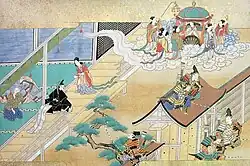
- Science fiction — Japanese science fiction subgenre of Mirai-ki ("records of the future") dates back to the 7th century. Famous early example is Urashima Tarō (8th century).[91]
- Time travel — Time travel in fiction dates back to the tale of Urashima Tarō from the Mukashibanashi (8th century).[91]
- Extraterrestrials in fiction — The Tale of the Bamboo Cutter (10th century) is considered to be the first story about an extraterrestrial visiting Earth.[91]
- Flying saucer — The Tale of the Bamboo Cutter (10th century) has an early manuscript illustration of a round flying machine similar to a flying saucer.[92]
- Time loop — The earliest novel about a time loop was Yasutaka Tsutsui's The Girl Who Leapt Through Time (1965).[93]
- Superhero — Sarutobi Sasuke was an early superhero ninja from 1910s Japanese children's novels.[94]
- Unreliable narrator — Dates back to Ryūnosuke Akutagawa's novel In a Grove (1922) and Akira Kurosawa's film adaptation Rashomon (1950).[95]
Audio
Audio technology
- Automatic dual-side record player — In 1981, Sharp Corporation released the first record player that automatically switches sides of a vinyl record.[96]
- Delta-sigma modulation (ΔΣ) — In 1962, ΔΣ digital sampling was defined and named in 1962 by University of Tokyo researchers H. Inose, Y. Yasuda and J. Murakami.[97]
- Digital audio recorder — In 1967, Heitaro Nakajima of NHK began work on the digitization of sound. By 1969, he developed the first digital audio tape recorder.[98]
- Digital multi-track recorder — Denon's DN-023R (1972) was the first digital multitrack recorder, supporting eight audio channels.[99]
- Digital audio mastering — The Denon DN-023R (1972) was the first pulse-code modulation (PCM) digital recorder for audio mastering.[100]
- PCM adaptor — Sony's PCM-1 (1976) was the first PCM adaptor and the first digital audio player and recorder for the consumer market.[98]
- Random access digital editing — The Denon DN-036ED (1982) was the first random access PCM digital audio editing system.[100]
- Digital mixing console — The Denon DN-050MD (1984) was the first digital mixing console for audio mastering.[100]
- Digital optical audio disc — In 1976, Sony first demonstrated a digital audio optical disc. In 1978, they demonstrated a disc with 16-bit audio and 44,056 Hz sample rate.[98]
- Cross-interleaved error correction — In 1978, Sony demonstrated an optical audio disc with cross-interleaved error correction code.[98]
- Compact Disc Digital Audio (CD-DA) — Developed by Sony and Philips in 1980. Sony proposed 16-bit audio and 44.1 kHz sample rate based on their PCM adaptor.[101]
- Compact disc player (CD player) — The world's first compact disc (CD) player was Denon's DN-3000F (1981).[102]
- Electrostatic headphones — The Stax SR-1 were the first electrostatic headphones, developed between 1959 and 1960 by Stax Ltd.[103]
- 3.5 mm headphone jack — Introduced with Sony's EFM-117J transistor radio in 1964.[104]
- In-ear headphones — Sony's MDR-E252 (1982) were the first in-ear headphones.[105]
- FET audio power amplifier — In 1974, Junichi Nishizawa introduced a power MOSFET used as an audio power amplifier.[106]
- High-resolution audio — In 1972, Denon's DN-023R digital audio recorder introduced a high-resolution 47.25 kHz sample rate.[99]
- 44,100 Hz (44.1 kHz) — Sony's PCM-1600 (1978) PCM adaptor introduced the CD quality standard of 16-bit audio and 44.1 kHz sample rate.[101]
- 48,000 Hz (48 kHz) — Introduced by Sony's PCM-3324 (1982) multitrack recorder, which played and recorded 16-bit audio at 44.1 KHz and 48 kHz sample rates.[107]
- 24-bit audio — Panasonic's D-5 HD (1994) digital video format supported 24-bit digital audio bit depth and 48 kHz sample rate.[108]
- Megahertz sample rate (MHz) — In 1999, the Direct Stream Digital (DSD) format by Sony and Philips introduced delta-sigma modulation with 1-bit audio and 2.8 MHz sample rate, developed for the Super Audio CD (SACD) format.[107]
- Home stereo system — In 1962, Pioneer Corporation introduced the world's first home stereo system with detachable speakers.[109]
- Car stereo component speakers — In 1975, Pioneer Corporation released the first component car stereo system.[109]
- Human voice synthesis — Early speech synthesis systems typically produced a low-quality robotic voice. In 1998, Toshiba introduced the first speech synthesis system that produced a high-quality human voice.[110]
- Integrated amplifier — Sony's TA-1120 (1965) was the first silicon transistor stereo integrated amplifier. Compared to vacuum tube amplifiers at the time, the TA-1120 offered higher output with lower distortion.[105]
- Karaoke — The Sparko Box, invented by Japanese engineer Shigeichi Negishi in 1967, was the first karaoke machine. Karaoke was later popularized by Daisuke Inoue's karaoke machine released in 1972.[45]
- Linear predictive coding (LPC) — The origins of linear predictive coding (LPC) speech coding dates back to the work of Fumitada Itakura (Nagoya University) and Shuzo Saito (Nippon Telegraph and Telephone) in 1966.[111]
- Itakura–Saito distance — Fumitada Itakura and Shuzo Saito first presented the Itakura–Saito distance algorithm in 1968.[111]
- Line spectral pairs (LSP) — Developed by Fumitada Itakura in 1975.[111]
- MPEG-1 Audio Layer II (MP2) — The MUSICAM (MP2) audio coding format was co-developed by Matsushita Electric in 1989.[112]
- Advanced Audio Coding (AAC) — The AAC patent holders include Japanese companies JVC Kenwood, NEC, NTT, Panasonic and Sony.[113]
- Paper audio record — In 1950, Yoshiro Nakamatsu invented the Jūshoku record, an optical sound media which uses a printed paper sheet instead of transparent film. He claimed it was an early floppy disk, which is disputed by IBM.[114]
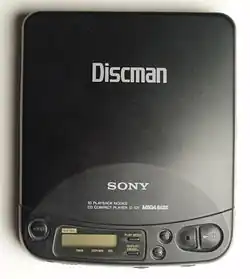
- Portable audio player — The Denon R-26-F (1951) was the first portable audio tape recorder.[115]
- Microcassette — Olympus Corporation's Zuiko Pearlcoder (1969) was the first microcassette tape recorder.[116]
- Personal stereo (Walkman) — The first personal stereo was the Sony Walkman (1979), created by Akio Morita, Masaru Ibuka and Kozo Ohsone.[117]
- Portable CD player — Sony's Discman, released in 1984, was the first portable CD player.[118]
- 1-bit DAC — The Sony D-303 (1991) was the first portable CD player to use a 1-bit digital-to-analog converter (1-bit DAC).[119]
- Portable car stereo — The Sony Music Shuttle (1983) was the first car stereo that could be detached and used as a portable audio player.[119]
- 5.1 surround sound vehicle audio — In 2003, Honda's 2004 Acura TL was the first car with 5.1 surround sound.[120]
- Speech recognition — In 1966, Fumitada Itakura and Shuzo Saito developed an early practical speech recognition algorithm using LPC.[111]
- Stereo digital audio — In 1969, NHK developed the first pulse-code modulation (PCM) stereo digital audio recorder.[99]
- Discrete quadraphonic sound — In September 1970, JVC introduced Compatible Discrete 4 (CD-4), the first discrete quadraphonic sound system for LP records.[100]
- 8-channel digital audio — Denon's DN-023R (1972) digital audio recorder supported 8-channel digital audio.[100]
- 22.2 surround sound — In 2005, NHK Science & Technology Research Laboratories (NHK STRL) demonstrated the first prototype 22.2 surround sound system for its Super Hi-Vision UHDTV technology.[121]
- Vehicle audio steering wheel controls — In 1984, the Nissan 300ZX introduced car radio controls on the steering wheel.[122]
Instruments
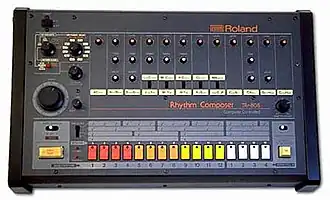
- Analog modeling synthesizer — The Roland D-50 (1987) was the first virtual analog synthesizer.[123]
- Linear arithmetic synthesis (LA synthesis) — A sample-based synthesis method invented by Roland Corporation for the Roland D-50 synthesizer (1987).[124]
- Sample-based synthesis with digital effects — The Roland D-50 (1987) was the first sample-based synthesizer with built-in digital effects, e.g. delay, reverb and chorus.[125]
- Supersaw — A waveform created by Roland for the Roland JP-8000 (1996) analog modeling synthesizer. It is commonly used in trance music.[126]
- Bass synthesizer–sequencer — The Japanese instruments Firstman SQ-01 (1980) and Roland TB-303 (1981) were the first bass synthesizers with integrated sequencers.[127]
- Acid bass — Acid house music is characterized by the distinctive squelching basslines of the Roland TB-303 (1981) bass synthesizer.[128]
- Chorus pedal — The Boss CE-1 Chorus Ensemble, released by Boss Corporation in 1976, was the first chorus pedal.[129]
- Overdrive pedal — The Boss OD-1 Overdrive (1977) was the first overdrive pedal.[130]
- Digital delay pedal — The Boss DD-2 (1983) was the first digital delay pedal.[130]
- Digital reverb pedal — The Boss RV-2 (1989) was the first digital reverb pedal.[130]
- CV/gate — Introduced with the Roland MC-8 Microcomposer (1977) music sequencer.[131]
- DIN sync — Introduced with the Roland TR-808 (1980) drum machine.[132]
- Digital piano — Yamaha Corporation's GS1 (1980) FM synthesizer was the earliest digital piano.[133]
- Digital piano sound module — The Roland MKS-20 (1986) was an early digital piano MIDI module, using Roland's structured adaptive synthesis (SAS) for more realistic piano sounds.[123]
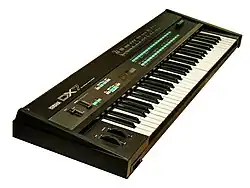
- Digital synthesizer (FM synthesizer) — In 1974, Yamaha developed the first prototype digital synthesizer with frequency modulation synthesis (FM synthesis).[134]
- Phase distortion synthesis (PD) — Invented by Casio for its Casio CZ-101 digital synthesizer in 1984.[135]
- Digital accordion — The Roland FR-7 (2004) was the first digital accordion.[136]
- Direct-drive turntable — Technics SP-10 (1969), invented by Shuichi Obata at Matsushita Electric, was the first direct-drive turntable. It was used by DJs for turntablism.[137]
- CDJ — Pioneer DJ's CDJ-500 (1994) was the first commercial DJ CD player.[138]
- Electronic drum — Ikutaro Kakehashi developed the first fully transistorized electronic drum instrument, the R1 Rhythm Ace, exhibited in 1964. It was manually hand-operated like modern electronic drum pads.[123]
- Mesh drumhead — The Roland V-Drums (1997) was the first drum kit with mesh drum pads.[139]
- Cymbal drum pad — Roland's TD-10 Expanded System (2001) was the first electronic drum kit with V-Cymbals drum pads.[139]
- Marching percussion electronic drum — Roland's RMP-12 Marching Percussion (2008) was the first electronic marching percussion instrument.[139]
- Cajón electronic drum — Roland's ELCajon EC-10 Electronic Percussion (2016) was the first hybrid cajón with built-in electronic sounds.[140]
- Guitar synthesizer — The Roland GR-500 (1977), manufactured by Roland Corporation and FujiGen, was the first guitar synthesizer.[140]
- Keytar — The earliest commercial keytar was Japanese company Hillwood's RockeyBoard RB-1 (1977), a synth piano with voltage-controlled filter (VCF).[141]
- MIDI guitar — The Roland GR-700 (1984) was the first guitar synthesizer to support MIDI and memory functions.[142]
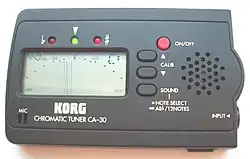
- Handheld electronic tuner — Korg's WT10 (1975) was the first battery-powered handheld electronic tuner. Korg tuners were widely adopted by guitarists and bass players.[143]
- Chromatic tuner — Boss Corporation's TU-12 (1983) was the first automatic chromatic tuner.[144]
- Compact pedal tuner — The Boss TU-2 (1998) was the first compact pedal tuner.[144]
- Microprocessor music sequencer — The Roland MC-8 Microcomposer (1977) was the first microprocessor‑based music sequencer.[123]
- Polyphonic digital sequencer — The Roland MC-8 Microcomposer (1977) was the earliest polyphonic digital sequencer.[123]
- MIDI music sequencer — The Roland MSQ-700 (1983) was the first MIDI music sequencer.[140]
- Microprocessor programmable drum machine — In 1978, the Roland CR-78 and CR-68 were the first microprocessor‑based programmable rhythm machines.[140]
- Fully programmable drum machine — The Roland TR-808 (1980) was the first fully programmable drum machine, with the ability to program an entire percussion track from beginning to end, complete with breaks and rolls.[145]
- Groovebox — The Roland CR-78 (1978), TR-808 (1980) and TR-606 (1981) were precursors to the groovebox. The Roland MC-202 (1983) is considered the first true groovebox.[146]
- MIDI drum machine — In 1983, the first MIDI drum machine was the Roland TR-909.[131]
- MIDI — In 1981, Roland founder Ikutaro Kakehashi proposed a standardized means of synchronizing electronic music instruments. Roland, Yamaha, Korg and Kawai co-developed the MIDI standard between 1981 and 1983.[123]
- MIDI keyboard — In 1983, the first MIDI Synthesizer keyboards were the Roland Jupiter-6 and Prophet 600.[131]
- MIDI sound card — Between 1982 and 1984, Roland developed the Roland MPU-401 (1984), the first MIDI-equipped sound card capable of MIDI sound processing and sequencing.[147]
- MIDI wind controller — Pioneered in the 1980s by Akai with the EVI and EWI as well as Yamaha's WX7 controller.[148]
- General MIDI — Standardized in 1991 by the Japan MIDI Standards Committee (JMSC) and MIDI Manufacturers Association (MMA).[149]
- MIDI digital audio workstation (DAW) — Yamaha's MSX personal computers Yamaha Integrated System (YIS) and Yamaha CX5M, developed between 1981 and 1983, were the first MIDI-equipped music workstations.[150]
- LCD digital audio workstation — Yamaha's C1 Music Computer (1988) laptop was the first portable DAW with liquid-crystal display (LCD).[150]
- Digital audio workstation with MIDI timecode (MTC) — Korg's Soundlink (1990) was the first DAW with MTC synchronisation.[143]
- Touchscreen digital audio workstation — In 1995, the Korg OASYS and Korg Trinity were the first DAWs with touch-sensitive screen.[143]
- Music computer — Yamaha's MSX computers, Yamaha Integrated System (YIS) and Yamaha CX5M developed between 1981 and 1983, were the first dedicated music home computers.[150]
- USB audio interface — Roland's UA-100 USB Audio Interface (1998) was the first USB audio interface, allowing recording and playback of high-fidelity digital audio with a personal computer.[140]
- Music Macro Language (MML) — The first commands for classical MML appeared on the Sharp MZ-80K (1978) computer.[151]
- PCM digital sampler — Toshiba's LMD-649 (1981) was an early digital sampler that played and recorded PCM samples.[152]
- Phaser effects pedal — In 1968, Shin-ei's Uni-Vibe effects pedal, designed by audio engineer Fumio Mieda, incorporated phase shift and chorus effects, soon becoming favorite effects of guitarists such as Jimi Hendrix and Robin Trower.[154]
- Physical modelling synthesis — The Yamaha VL‑1 (1994) was the first commercial physical modelling synthesizer.[155]
- Polyphonic synthesizer with digital keyboard scanning — In the early 1970s, Yamaha developed polyphonic synthesizers with voice allocation technology and digital keyboard scanning. The Yamaha GX-1 (1973) used voice allocation technology.[134]
- Polyphonic string synthesizer — The Roland RS-101 (1975) was the earliest polyphonic string synthesizer.[156]
- Singing voice synthesis software — Between 1999 and 2003, Yamaha developed Vocaloid, a then novel software that synthesized a singing human voice.[157]
- Sound chip — The earliest was Sony's PCM-1, a pulse-code modulation (PCM) processor introduced in 1976.[98]
- Differential PCM sound chip — The earliest was Oki Electric Industry's MSM5205, an adaptive differential PCM (ADPCM) speech synthesis chip released in 1979.[158]
- FM synthesis sound chip — The Yamaha GS1 (1980) synthesizer featured the earliest frequency modulation synthesis (FM synthesis) chipset.[159]
- Sample-based synthesis sound chip — The earliest is the Roland LA32 (1987) chip, producing LA synthesis (a form of sample-based synthesis) in the Roland D-50 synthesizer and Roland MT-32 sound module.[160]
- Sound module — The Roland SPV355 Pitch‑to‑Voltage Synthesizer (1979) was the earliest rack-mounted sound module.[161]
- MIDI sound module — The Yamaha SFG-01 (1983) sound module for the MSX introduced FM synthesis and MIDI sequencing to computers.[162]
- Multi-timbral sound module — The Roland MT-32 (1987) was the first MIDI sound module using LA synthesis, a form of multi-timbral sample-based synthesis. It was commonly used in computer music, especially game music.[163]
- Touch-sensitive electronic keyboard — The Roland EP-30 (1974) electronic piano featured the first touch-sensitive keyboard.[140]
- Vowel–consonant synthesis — A type of hybrid digital-analog synthesis first employed by the early Casiotone keyboards in the early 1980s.
Music
.jpg)

- Ambient music — Pioneered by Japanese electronic music composer Isao Tomita during the late 1960s to early 1970s.[164]
- Space music — Pioneered by Isao Tomita in the early 1970s.[164]
- Chillwave — According to Mojo magazine, Haruomi Hosono's album Paraiso (1978) was "prescient of late-noughties chillwave".[165]
- Deep Note — Yellow Magic Orchestra's "Loom" from BGM (1981) has "a patiently ascending, two-minute-long Shepard's tone" anticipating the Deep Note.[166]
- Glitch music — The genre was pioneered by Ryoji Ikeda in the 1990s.[167]
- Commercial digital recording — Pioneered in Japan by NHK and Nippon Columbia (Denon) in the 1960s. The first commercial digital recordings were released in 1971.[99]
- Orchestral digital recording — The first digitally recorded classical music album was recorded in Tokyo (April 1972) and released by Nippon Columbia.[99]
- Digital sample loops — Yellow Magic Orchestra's Technodelic (1981) was the first music album with digital sample loops.[168]
- FM synthesis album — The earliest was Mari Iijima's city pop album Rosé (1983), produced by Ryuichi Sakamoto using the Yamaha DX7 synthesizer.[169]
- Electro — Pioneered by Yellow Magic Orchestra (YMO), with tracks such as YMO's "Computer Game / Firecracker" (1978) and Ryuichi Sakamoto's "Riot in Lagos" (1980).[170]
- Electronic hip-hop — YMO's "Music Plans" and "Rap Phenomena" from BGM (1981) were the earliest synthesized electronic rap songs with drum machine beats.[171]
- Boom bap — YMO's "Music Plans" from BGM (1981) is credited with introducing boom-bap hip‑hop beats.[171]
- Electro-pop — Pioneered by Yellow Magic Orchestra (YMO) in the late 1970s, before it became popular in 1980s music.[172]
- Synth-pop — Pioneered by YMO in the late 1970s, before it became popular in the 1980s.[170]
- Gated reverb — YMO's "Behind the Mask" (1979) was the first song to use gated reverb on the snare drums, a technique that later became popular in 1980s pop music.[173]
- Electronica — According to Pitchfork, Ryuichi Sakamoto's "E-3A" from the album B-2 Unit (1980) was looking "ahead to Mouse on Mars' idyllic '90s electronica."[174]
- Synthwave — YMO's "Mass" from the album BGM (1981) anticipated the "ominous drama" of synthwave according to Noah Yoo of Pitchfork.[166]
- Electronic dance music (EDM) — Japanese composer Ryuichi Sakamoto's "Riot in Lagos" from the album B-2 Unit (1980) laid the groundwork for modern electronic dance music.[175]
- Broken beat — Foreshadowed by Ryuichi Sakamoto's B-2 Unit (1980).[176]
- Electronic body music (EBM) — Ryuichi Sakamoto's "Riot in Lagos" from B-2 Unit (1980) was "a new body music" that "foretold the future" of music according to Mary Anne Hobbs of BBC Radio 6 Music.[177]
- Intelligent dance music (IDM) — Foreshadowed by Ryuichi Sakamoto's B-2 Unit (1980).[176]
- 22-beat rhythm — Haruomi Hosono's album S-F-X (1984) experimented with new 22-beat rhythms, which went beyond the standard 8‑beat rhythms of rock music and even the complex rhythms of funk, disco, jazz fusion and hip hop at the time.[178]
- Funky house — Yellow Magic Orchestra's "Tighten Up" from the album X∞Multiplies (1980) featured "grooves now‑recognizable as funky house" according to Tastemakers Music Magazine.[179]
- Ambient house — Pioneered by Yellow Magic Orchestra in the early 1980s.[180]
- Deep house — "Heartbeat" (1981) by Colored Music (Ichiko Hasimoto and Atsuo Fujimoto) "sounds remarkably like classic deep house" according to Resident Advisor in 2016.[181]
- Grime music — The origins of grime music has been traced back to Ryuichi Sakamoto's music, notably the tracks "Grasshopper" and "End of Asia" from his album Thousand Knives (1978) and the single "Bamboo Houses" (1982).[182]
- Japanese mode — A pentatonic musical scale commonly used in traditional Japanese music.[183]
- Royal road progression — The earliest example of the contemporary royal road chord progression occurs in Yumi Arai's "Yasashisa ni Tsutsumareta Nara" (1974), closely followed by Arai's "Sotsugyou Shashin" (1975) released by Hi-Fi Set.[184]
- J-pop — Modern J-pop has its roots in traditional music of Japan, and significantly in 1960s pop and rock music. Genre began with Japanese rock bands such as Happy End who fused rock with Japanese music during the 1960s–1970s.[185]
- City pop — The genre's origin has been attributed to the Japanese band Happy End (Haruomi Hosono, Takashi Matsumoto, Eiichi Ohtaki and Shigeru Suzuki), active from 1969 to 1972.[186]
- Shibuya-kei — A music genre that flourished in Japan during the 1990s.[187]
- Noise rock — The genre was pioneered by Japanoise band Les Rallizes Dénudés, founded in 1967.[188]
- Visual kei — The Tigers (1967–1972) lead vocalist Kenji Sawada was a precursor to visual kei. The visual kei style emerged in the early 1980s, with artists such as Ryuichi Sakamoto, Masami Tsuchiya, Boøwy and Kinniku Shōjo Tai.[189]
- Kawaii metal — In the early 2010s, Japanese idol heavy metal music group Babymetal pioneered the kawaii metal genre.[190]
- Quadraphonic LP record — In June 1971, JVC released Wonderful CD-4 Sound in Japan. It was the first quadraphonic LP record produced using the Compatible Discrete 4 (CD-4) quadraphonic sound system.[100]
- Techno — Pioneered by YMO during the late 1970s to early 1980s. They coined the "techno" genre label, with releases such as "Technopolis" (1979), Technodelic (1981) and "The Spirit of Techno" (1983).[174]
- Industrial techno — Ryuichi Sakamoto's B-2 Unit (1980) anticipated the sounds of industrial techno.[176]
- Ambient techno — YMO's "Happy End" from the album BGM (1981) was "a progenitor of" ambient techno according to Noah Yoo of Pitchfork.[166]
- Jungle music — According to Fact magazine, Ryuichi Sakamoto's "Differencia" from the album B-2 Unit (1980) has "relentless tumbling beats and a stabbing bass synth that foreshadows jungle by nearly a decade".[176]
- Techno-pop — Pioneered by YMO in the late 1970s.[174]
Biomedical
Biomedical science


- 10,000 steps — In 1963, Dr. Iwao Ohya proposed the ideal of walking 10,000 steps a day. It was popularized by the Manpo-kei (10,000 step) pedometer released by Yamasa in 1965.[191]
- Acetylcholine neurotransmitter — In 1926, Kenmatsu Shimidzu discovered that acetylcholine was a neuromuscular neurotransmitter.[192]
- Glutamate (neurotransmitter) — The first suggestion that glutamate might function as a neurotransmitter came from Takashi Hayashi in 1952.[192]
- Inhibitory GABA — In 1956, Takashi Hayashi discovered the inhibitory action of GABA.[192]
- Amino acid neurotransmitter — Between the 1960s and 1970s, Masanori Otsuka established GABA as the first amino acid neurotransmitter.[192]
- Substance P neuropeptide — Between the 1960s and 1970s, Masanori Otsuka established substance P (SP) as the first peptide neurotransmitter.[192]
- Adrenaline (epinephrine) — Jōkichi Takamine and Keizo Uenaka discovered epinephrine in 1900. Takamine successfully isolated and purified the andrenaline hormone.[192]
- Agar — Agar was discovered in Japan around 1658 by Mino Tarōzaemon.[193]
- ALK positive lung cancer — Hiroyuki Mano, Research Institute director at the National Cancer Center, led the discovery of lung cancer fusion genes.[194]
- Cancer genome treatment — Hiroyuki Mano led the discovery of cancer genome treatment.[194]
- Antiparasitic drugs — Satoshi Ōmura discovered antiparasitic drugs including avermectin, endectocide and ivermectin.[194]
- Antiretroviral medication (anti-AIDS drugs) — Hiroaki Mitsuya discovered the anti-HIV drug zidovudine (AZT) and anti-AIDS drugs including didanosine (ddI) and zalcitabine (ddC).[194]
- Aspergillus oryzae — The genome for Aspergillus oryzae was sequenced and released by a consortium of Japanese biotechnology companies, in late 2005.[195]
- Clustered regularly interspaced short palindromic repeats (CRISPR) — Yoshizumi Ishino discovered CRISPR in 1987. It is the basis for CRISPR gene editing.[196]
- Condensin — Discovered by Riken senior researcher Tatsuya Hirano.[194]
- Chromosome assembly — Discovered by Tatsuya Hirano.[194]
- Dementia with Lewy bodies — First described in 1976 by psychiatrist Kenji Kosaka. He was awarded the Asahi Prize in 2013 for his discovery.[194]
- Dopamine in striatum — In 1959, Isamu Sano discovered a high concentration of dopamine in the striatum.[192]
- Dopamine reduction in Parkinson's disease — In 1959, Isamu Sano discovered the reduction of dopamine in patients with Parkinson's disease.[192]
- DOPA treatment for Parkinson's disease — In 1960, Isamu Sano discovered the use of DOPA as a treatment for Parkinson's disease.[192]
- Endoscopic submucosal dissection (ESD) — This surgical procedure was developed in Japan by M. Tada, M. Murata and F. Murakami between 1974 and 1984.[197]
- Fukuyama congenital muscular dystrophy (FCMD) — Discovered by Yukio Fukuyama, Tatsushi Toda and Tamao Endo.[194]
- General anesthesia — Hanaoka Seishū was the first surgeon who used the general anaesthesia in surgery, in 1804. He also dared to operate on cancers of the breast and oropharynx, remove necrotic bone, and perform amputations of extremities.[198]
- Green fluorescent protein (GFP) — Discovered by Osamu Shimomura.[194]
- Immunoglobulin E (IgE) — Antibody only found in mammals. It was discovered during 1966–1967 by Kimishige Ishizaka's team at the Children's Asthma Research Institute and Hospital in Denver, Colorado.[199]
- Induced pluripotent stem cell — The induced pluripotent stem cell (iPSCs) is a kind of pluripotent stem cell which can be created using a mature cell. iPSCs technology was developed by Shinya Yamanaka and his lab workers in 2006.[200]
- Okazaki fragment — DNA fragments formed on lagging template strand during DNA replication. Discovered 1966 by Reiji Okazaki, Tsuneko Okazaki and Kiwako Sakabe.[201]
- Bacteriophage DNA replication — In 1968, Okazaki fragments were further investigated by Okazaku's research team including the study on bacteriophage DNA replication in Escherichia coli.[202]
- Orexin — Discovered by Masashi Yanagisawa.[194]
- Endothelin — Discovered by Masashi Yanagisawa.[194]
- Plant fertilization — Nagoya University professor Tetsuya Higashiyama discovered the process of plant fertilization.[194]
- Pulse oximetry — Pulse oximetry was developed in 1972 by Takuo Aoyagi and Michio Kishi, bioengineers at Nihon Kohden. Susumu Nakajima, a surgeon, and his associates first tested the device in patients, reporting it in 1975.[203]
- Regulatory T cell — Discovered by Shimon Sakaguchi.[194]
- Thiamine (Vitamin B1) — In 1884, Kanehiro Takaki attributed beriberi to insufficient nitrogen intake (protein deficiency). In 1910, Umetaro Suzuki succeeded in extracting a water-soluble complex of micronutrients from rice bran. It was named vitamine.[204]
- Transurethral resection in saline (TURis) — This urological surgical procedure was developed by Japanese physicians Makoto Miki (Shinjuku Ishikawa Hospital), Hiroaki Shiozawa, Tetsuo Matsumoto and Taku Aizawa between 2000 and 2003.[205]
Equipment


- 3D holographic radiography (holographic X-ray) — In 1969, Tadashi Kasahara's Konishiroku and Tokyo University group invented 3D holographic X-ray imaging.[206]
- Holographic X-ray microscope — In 1975, Tokyo University researchers Sadao Aoki and Seishi Kikuta invented a 3D medical imaging holographic X-ray microscope.[207]
- Digital radiography (digital X-ray) — Fujifilm's FCR (1981) was the first digital X-ray diagnostic imaging system with computer processing.[208]
- Amino acid analyzer — JEOL's JLC-5AH (1968) was the first amino acid analyzer.[209]
- Spectrum cell analyzer — Sony's SP6800 (2013) was the first spectrum cell analyzer.[105]
- Audiometer — Nihon Kohden's MAW-1 White Noise Audiometer (1951) was the first audiometer.[203]
- Direct-writing electroencephalograph (EEG) — Nihon Kohden's ME-1D (1951) was the first 8-channel direct-writing electroencephalograph (EEG) running on AC power.[203]
- Pulse oximeter — Nihon Kohden's Ear Oximeter OLV-5100 (1974), invented by Takuo Aoyagi in 1972, was the first pulse oximeter.[203]
- Automated dispensing cabinet — In 2004, Sumitomo Heavy Industries released the first automatic radiopharmaceutical administering device for positron emission tomography.[210]
- Confocal microscope — In 1942, Zyun Koana described an early confocal microscope.[211]
- Atomic force microscopy — In 1976, the first micrograph of atomic arrangements was taken with JEOL Electron Microscope.[209]
- High-resolution field-emission microscope — In 1978, Hitachi developed the first field emission electron microscope with high image resolution.[212]
- Autofocus microscope — Olympus Corporation's AH-2 (1983) was the first high‑performance microscope with autofocus (AF) function.[116]
- Digital microscope — Invented by Japanese company Hirox in 1985.[213]
- Video microscopy — Invented by Hirox in 1985.[213]
- Digital blood pressure monitor — Between 1961 and 1973, Omron under Kazuma Tateishi developed the first digital blood pressure monitors, released as HEM-1 (1973) for medical use and HEM-77 (1978) for home use.[214]
- Electrosurgical insulated-tip knife (IT knife) — Introduced by Olympus Corporation in 2002 for endoscopic submucosal dissection (ESD) surgical procedures.[215]
- Electrosurgery with ultrasound and RF energy — The Thunderbeat (2012) by Olympus was the first electrosurgical device with ultrasonic and bipolar RF energy.[216]
- Esophagogastroduodenoscope (EGD) — Japanese engineer Mutsuo Sugiura invented the first gastrocamera (EGD), a type of endoscope camera. Olympus released it as the Olympus GT-1 in 1950.[116]
- Fiber gastroscope — Introduced by Olympus in 1964.[216]
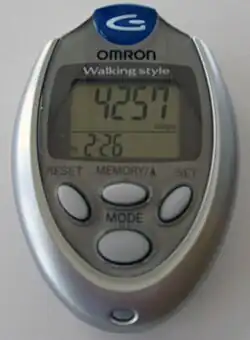
- Fitness tracker — Juri Kato produced the Manpo-kei (10,000 step meter), the first modern pedometer (step-counter) wearable technology, released by Yamasa in 1965.[191]
- Flexible bronchoscopy — Shigeto Ikeda invented the flexible fiber bronchoscope in 1966.[217]
- Video bronchoscope — In 1994, Pentax researchers developed video broncoscopes with a charge-coupled device (CCD) video chip located at their distal end.[218]
- High-definition video bronchoscope — The first high-definition video (HD video) bronchoscope was introduced by Pentax in 2011.[219]
- High-definition video brain surgery — In 1987, a brain surgery was first recorded in HD video using NHK's Hi-Vision analog HDTV technology.[220]
- High-resolution ultrasound machine — Developed by Toshiba between 1971 and 1975.[110]
- Ultrasound vector monitor — In 1975, JVC introduced the first 8-inch X-Y monitor for ultrasound.[221]
- Endoscopic ultrasound (EUS) — Introduced by Olympus in 1982.[215]
- HD video endoscopy — In 2002, the Olympus Evis Lucera was the first HD endoscopic video system.[215]
- High-tensile strength plate — In 2007, Nippon Steel & Sumitomo Metal developed the first high-tensile strength plate for improving the fatigue strength of welded joints.[222]
- Medical imaging display monitor — In 1982, JVC introduced a CRT monitor for medical imaging.[221]
- Medical imaging LCD monitor — In 2001, JVC introduced a 20.8-inch LCD monitor with calibration for 2–3 megapixel medical imaging.[221]
- Medical monitor — In 1957, JVC introduced a medical CRT display with deflection yoke technology. In 1972, JVC introduced the first 12‑inch raster display medical CRT monitor.[221]
- Flat screen medical monitor — By 1991, JVC had developed a medical LCD monitor. In 2000, they introduced a flat-screen medical CRT monitor.[221]
- High-resolution medical monitor — In 2000, JVC introduced high-resolution medical monitors, including a 2–5 megapixel CRT monitor and a 3 megapixel LCD monitor.[221]
- High brightness monitor — JVC's i series (2005) medical diagnostic monitor was the first high brightness color display with more than 450 cd/m2 luminance.[221]
- Non-mydriatic retinal camera — The first non-mydriatic retinal camera was the CR-45NM (1976) by Canon Inc.[223]
- Portable electrocardiograph (ECG) — Taro Takemi built the first portable electrocardiograph (ECG) in 1937.[224]
- ECG differential amplifier — Fukuda Denshi's AD-1 (1949) was the first ECG with differential amplifier.[225]
- ECG monitor — In 1976, JVC introduced the first electrocardiogram (ECG) medical monitor.[221]
- Isolation amplifier — Fukuda Denshi's FX-102 (1983) was the first ECG with isolation amplifier.[225]
- Sub-pixel super-resolution imaging — In 2007, JVC introduced the first 15 megapixel LCD medical monitor using independent sub-pixel technology, used for mammography.[221]
- Multimodality color medical monitor — In 2012, Eizo introduced the first multi-modality color medical monitor, with a 4K resolution (8 megapixel) display used for mammography, cardiology and radiology.[226]
- OLED medical monitor — Sony's 25-inch PVM-2551MD (2012) surgical monitor was the first Food and Drug Administration (FDA) approved OLED medical grade display.[227]
- Vectorcardiography (VCG) — Taro Takemi invented the vectorcardiograph in 1939.[224]
Cameras

- 3D holographic stereo camera — In 1968, Konishiroku (Konica) invented the first holographic 3D camera, using holographic multi-lens stereogram technology.[228]
- Action camera (body camera) — The first action camera was the Canon CI-10 (1985) by Canon Inc.[229]
- Autofocus camera (AF camera) — The Konica C35 AF (1977) was the first camera with autofocus (AF).[230]
- Eye-controlled focusing (ECF) — The Canon EOS 5 (1992) was the first single-lens reflex (SLR) AF camera with eye tracking AF control.[223]
- Beauty filter — Beauty filters originate from Purikura ("print club"), introduced by Atlus and Sega primarily for female visitors at Japanese arcades.[231]
- Bayonet lens mount — The Nikon F-mount, debuted with the Nikon F (1959), was the first interchangeable lens bayonet mount.[230]
- Fluorite lens — In 1969, Canon introduced the first camera lens employing fluorite.[232]
- Close range correction (CRC) — Nikon's Nikkor Auto 24mm f/2.8 (1967) was the first camera lens with a CRC system.[233]
- Bridge camera — In early 1988, the first bridge cameras were the Ricoh FF-7, Kyocera's Samurai, Olympus Corporation's Infinity SuperZoom 300, and the Chinon Genesis.[234]
- CdS meter — In 1962, the Taron Marquis from Japan was the first camera with built-in cadmium sulfide (CdS) light meter, shortly followed by the Minolta SR-7.[235]
- Center-weighted average metering — The Nikon F Photomic TN (1967) was the first camera with a center-weighted exposure metering system.[233]
- Matrix metering — The Nikon FA (1983) was the first SLR camera with matrix metering.[233]
- Depth of field (DOF) — The Nikon F (1959) introduced a DOF preview button.[233]
- Perspective-control lens (PC lens) — The Nikon F-mount f/3.5 35 mm PC-Nikkor (1961) was the first PC lens manufactured for SLR cameras.[236]
- Tilt–shift photography — In 1961, Nikon introduced the first interchangeable tilt-shift lens for SLR cameras.[236]
- Electronic memory — The Asahi Pentax Electro Spotmatic (ES), released in 1971, introduced the use of electronic memory in a camera.[237]
- Electronic camera integrated circuit — Nikon's Nikkormat EL (1972) was the first camera with a monolithic integrated circuit (IC) chip.[233]
- Electronic camera microprocessor — The Canon AE-1 (1976) was the first camera with a central processing unit (CPU) computer chip. The Canon A-1 (1978) introduced the first camera-based microprocessor system.[235]
- Event camera — The development of silicon retina event cameras dates back to Kunihiko Fukushima's Reticon in 1989.[238]
- Fisheye lens for 35 mm camera — In 1962, Nikon introduced the first regular production fisheye lens for 35 mm cameras.[239]
- Ultra wide angle lens — In 1968, Nikon's Masaki Isshiki and Keiji Matsuki filed a patent for super wide fisheye lens with 220° to 270° field of view.[240]
- Flash synchronization (flash sync) — The Mamiyaflex (1948) by Mamiya was the first twin-lens reflex (TLR) camera with flash sync.[235]
- Single-lens reflex flash camera (flash SLR) — The Pentax SFX (1987) was the first SLR camera with built-in flash.[241]
- Instant return mirror — The Asahiflex IIB (1954) was the first single-lens reflex (SLR) camera with a practical instant return mirror.[241]
- Metal-bladed focal-plane shutter — The Konica F (1960) introduced a new metal-bladed focal-plane shutter designed and manufactured by Konishiroku, which they branded the Hi Synchro.[242]
- Electronic shutter — Yashica's TL Electro-X (1968) was the first 35 mm SLR camera with an electronically timed shutter.[235]
- High-speed camera shutter speed — The Asahi Pentax ES (1971) introduced an electronic shutter with variable shutter speeds up to 1 millisecond.[237]
- Multi-layer optical coating — The first multi-layer lens coating was the "Super-Multi-Coating" introduced by Pentax in the 1950s.[241]
.jpg)
- Point-and-shoot 35 mm camera — The Konica C35 AF (1977) and Canon AF35M Sure Shot (1979) were the first 35 mm point‑and-shoot electronic cameras.[243]
- Lithium battery compact camera — The Olympus AFL Picasso (1983) was the first compact camera powered by a lithium battery.[116]
- Single-use camera — Fujifilm's QuickSnap (1986) was the first single-use point-and-shoot disposable camera.[208]
- Pocket camera — The Konica A4 (1989) was the first pocket-size 35 mm point-and-shoot camera.[243]

- Selfie camera — The Minolta Disc-7 (1983) was the first camera with a selfie mirror on its front for shooting selfie photos.[244]
- Selfie stick — Invented by Hiroshi Ueda for the Minolta Disc-7 (1983), where the package showed the camera mounted on a selfie stick.[244]
- Shutter priority auto-exposure — The Konica Autoreflex (1965) was the first SLR camera with shutter priority auto‑exposure.[235]
- Aperture priority — The Asahi Pentax ES (1971) was the first SLR camera with aperture priority auto-exposure.[241]
- Single-lens reflex system camera (system SLR) — The Nikon F (1959) was the first SLR system camera.[230]
- Electric motor drive — The Nikon F (1959) was the first camera with an electric motor drive.[230]
- Full-frame SLR camera — The Nikon F (1959) was the first SLR camera with full frame coverage.[233]
- Half-frame camera — The Olympus Pen F (1963) was the first half-frame SLR camera.[116]
- Superzoom — The Nikon Super Zoom-8 (1966) introduced 5× zoom lens. The Nikon 8X Super Zoom (1967) introduced 8× zoom. The Nikon R10 Super Zoom (1973) introduced 10× zoom.[233]
- Through-the-lens metering (TTL) — The first camera to feature TTL light metering was by Japanese company Nikon, with a prototype rangefinder camera, the SPX, in 1950.[245]
- Open-aperture metering — The Asahi Pentax Electro-Spotmatic (ES), released in 1971, was equipped with the first TTL open-aperture metering.[241]
- Pinhead mirror — The Nikon F3 (1980) was the first TTL camera with a pinhole mirror.[233]
- Vibration reduction (VR) — The Nikon Zoom 700VR (1994) was the first camera featuring optical vibration reduction.[233]
- Viewfinder digital display — Fujifilm's Fujica ST 801 (1972) was the first SLR camera with a viewfinder incorporating digital LED display.[235]
- Electronic viewfinder (EVF) — The Nikon F3 (1980) was the first camera with liquid-crystal display (LCD) viewfinder.[233]
- Weather-proof camera — The Olympus AF-1 Nuretemo-Pikaso (Wet Flash), released in 1986, was the first weather‑proof compact camera.[246]
Digital cameras

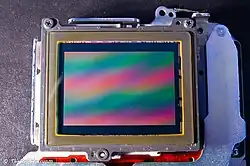
- Active-pixel sensor (MOS sensor) — Olympus Corporation invented the first MOS active‑pixel image sensor in 1985, using NMOS logic transistors.[247]
- CMOS sensor — Mitsubishi Electric developed the first CMOS active-pixel sensor in 1992. Mitsubishi began mass production of CMOS sensors in 1997.[248]
- Back-illuminated sensor (BI sensor) — Invented by Sony engineer Hideo Yamanaka in 2002.[249]
- Stacked CMOS — In 2012, Sony released the first stacked CMOS sensor, the Exmor RS.[250]
- CCD color camera — A Sony research team developed a charge-coupled device (CCD) color camera in 1977.[251]
- Three-CCD camera (3CCD) — The Minolta RD-175 (1995) was the first digital camera integrated with three CCD image sensors.[229]
- Super CCD — A type of CCD sensor developed by Fujifilm in 1999.[252]
- Digital 3D stereo camera — The Minolta Dimâge 3D 1500 (1999) was the first stereoscopic 3D digital camera.[229]
- Autostereoscopic 3D camera — The Fujifilm FinePix Real 3D (2009) was the first autostereoscopic 3D camera.[253]
- Digital camera with flash memory — In 1988, Fujifilm introduced the Fujix DS-1P, the first fully digital camera to record digital images on a flash memory card.[229]
- Digital infrared camera — Sony's DSC-F1 (1996) was the first digital camera with a built-in infrared transceiver.[229]
- Touchscreen digital camera — The Nikon Coolpix 300 (1996) was the first digital camera with a touchscreen.[229]
- Digital rangefinder — The Epson R-D1 (2004) was the first digital rangefinder camera.[254]
- Digital camera optical zoom — Fujifilm's Fujix DS-100 (1991) was the first digital camera with 3× optical zoom.[229]
- Digital single-lens reflex camera (DSLR) — At Photokina 1986, Nikon revealed the first prototype digital SLR camera, the Nikon SVC, which was commercialized as the Nikon QV-1000C in 1988.[255]
- CMOS sensor DSLR — The Canon EOS D30 (2000) was the first DSLR camera with CMOS sensor.[252]
- Full-frame DSLR — The first full-frame DSLR was the Contax N Digital, announced in 2000 and released in 2002.[256]
- Full-frame compact camera — The Sony Cyber-shot DSC-RX1 (2012) was the first compact camera with a full-frame sensor.[230]
- Live preview — The first digital camera with LCD live preview was the Canon QV-10 (1994) by Canon Inc.[257]
- Swivel lens — The Canon QV-10 (1994) introduced a rotating lens.[257]
- Front-facing camera (digital selfie) — The Canon QV-10 (1994) introduced a digital selfie function, allowing the swivel lens to be pointed at the user with LCD live preview.[257]
- Mirrorless camera — The Epson R-D1 (2004) was also the first mirrorless interchangeable-lens camera (MILC).[254]
- Full-frame mirrorless interchangeable-lens camera (full-frame MILC) — The Sony α7 (2013) was the first full-frame MILC.[230]
- Smart digital camera — The Nikon Coolpix S800c (2012) was the first digital smart camera, running on the Android operating system and integrating Android mobile apps like smartphones and other smart devices.[258]
Video cameras
.jpg)
- Color home video camera — In 1973, Toshiba released the first color video camera for home use.[110]
- Camcorder — In 1980, Sony demonstrated the first prototype camcorder, combining a color CCD camera with video cassette recorder (VCR) using 8 mm video format.[259]
- Lithium-ion camcorder — The Sony CCD-TR1 (1990) 8 mm camcorder was the first commercial product to use a lithium-ion battery.[260]

- Digital video camera — In 1986, Sony developed a prototype digital video camera that recorded digital video on D-1 (Sony) video cassettes.[261]
- 3CCD video camera — The Sony DCR-VX1000 (1995) digital camcorder was the first digital video camera with three CCD sensors.[262]
- Digital movie camera — Sony's Solid State Electronic Cinematography digital video camera was used to shoot the first digital film, Rainbow (1996).[263]
- Digital video camera with flash memory — The Ricoh RDC-1 (1995) was the first digital camera capable of video recording on a flash memory card.[229]
- Digital TV camera — Sansui Electric's CT0110 (1996) was the first digital camera with a built-in TV tuner.[229]
- DSLR video camera — The Nikon D90 (2008) was the DSLR camera capable of video recording.[230]
- Full HD DSLR video camera — The Canon EOS 5D Mark II (2008) was the first DSLR camera capable of full high-definition video recording.[230]
- Handheld TV camera — Ikegami Tsushinki introduced the first portable 4+1⁄2-inch Image Orthicon tube hand-held TV camera. The camera made its US debut in February 1962.[264]
- Video camera recorder — Sony's Portapak (1965) was the first self-contained portable camera and video tape analog recording system. It led to the emergence of electronic news gathering (ENG), guerrilla television and video art.[265]
- HD video CCD camera (HD CCD) — In the 1980s, prototype HD CCD cameras were developed by Fujitsu, Ikegami Tsushinki, Matsushita Electric, NEC, Sanyo, Sharp Corporation, Sony, Toshiba and JVC.[266]
- High-speed camera — Between 1974 and 1975, NHK developed a Saticon video camera capable of high frame rates above the 60 Hz NTSC standard, reaching up to 500 Hz frame rate.[267]
- Image stabilization — Panasonic invented optical image stabilization (OIS) for the PV-460 (1988) video camera.[268]
- Electronic image stabilization (EIS) — Panasonic invented EIS for the Brenby NV-S1 (1990) compact video camera.[268]
- MPEG video camera — The Hitachi MP-EG1 (1996) digital camera introduced MPEG-1 support. Sharp Corporation's VN-EZ1 Internet ViewCam (1999) camera introduced MPEG-4 support.[229]
- Still video camera (SVC) — The first prototype SVC to be developed was the SV Camera (1977) by Canon Inc. The first SVC to be demonstrated was the Sony Mavica (1981).[269]
Combat
Martial arts

- Budō
- Bushido
- Jujutsu — A Japanese martial art style evolved among the samurai of feudal Japan for defeating an armed and armored opponent without weapons.[270]
- Judo — It was created as a physical, mental and moral pedagogy in Japan, in 1882, by Kanō Jigorō.[271]
- Aikido — Aikido was created and developed by Morihei Ueshiba in first half of the 20th century.
- Kimura lock — Known as gyaku ude-garami in judo, it was popularized by Masahiko Kimura in 1951. Commonly used in judo, Brazilian jiu-jitsu and mixed martial arts.[272]
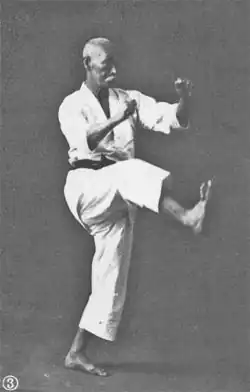
- Kenpō
- Okinawan martial arts — Okinawans combined Chinese Chuan Fa (introduced in the 14th century) with the existing martial art of Te to form Tō-de (Okinawa-te).[273]
- Karate — Began as a common fighting system known as "ti" (or "te") among the pechin class of the Ryukyuans. Motobu‑ryū school was passed down by Seikichi Uehara.[274]
- Mixed martial arts (MMA) — Mixed martial arts in Japan dates back to ancient times.[275]
- Kūdō — Japanese hybrid martial art founded by Takashi Azuma in 1981.[276][277]
- Ninjutsu — Developed by groups of people mainly from the Iga Province and Kōka, Shiga of Japan. Different ryū (schools) taught versions of ninjutsu, such as the Togakure-ryū.[278]
- Puroresu
- Soccer kick — A high-profile early user of soccer kicks as a finishing move was Antonio Inoki. In a 1977 puroresu match, he used it to knock out Great Antonio.[279]
- Strong style
- Shoot wrestling — Hybrid wrestling style pioneered in the 1970s Japanese puroresu circuit by wrestlers such as Antonio Inoki and Tatsumi Fujinami.[280]
- Shoot boxing — Shoot boxing was created in August 1985 by former kickboxer Caesar Takeshi.[281]
- Shootfighting
- Sumo — According to the Nihon Shoki, published in 720, the origin of sumo is the contest of strength between Nomi no Sukune and Taima no Kehaya in 26 BC.[282]
- Tessenjutsu
Military

- Air raid — Early in World War I (1914), the Japanese seaplane carrier Wakamiya conducted the world's first carrier-launched air raid.[283]
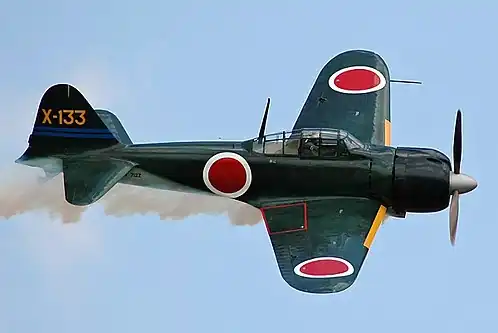
- Aluminium-zinc alloy fighter aircraft — The Mitsubishi A6M Zero (1939) fighter plane was the first vehicle to use the zinc-based 7075 aluminium alloy.[284]
- Amphibious assault ship — The Japanese amphibious assault ship Shinshū Maru (1934) was a pioneer of modern-day amphibious assault ships.[285]
- Dock landing ship — The Shinshū Maru (1934) is regarded as the first dock landing ship.
- Landing craft carrier — The Shinshū Maru (1934) was the world's first landing craft carrier ship to be designed as such.[285]
- Diesel-powered tank — The Japanese Type 89 I-Go medium tank Otsu was the first diesel-powered tank, produced with a diesel engine from 1934 onwards.
- Japanese armour
- Kamikaze
- Wireless navigation system — In 1961, Hidetsugu Yagi designed the first wireless navigation system for military use.[286]
Weapons
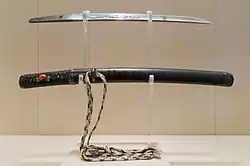

- Amappo
- Arisaka
- Concealed weapon — Several early concealed weapons were invented in classical Japan, known as kakushibuki (concealed weapon) or hibuki (secret weapon).[287]
- Shuriken — The most famous Japanese concealed weapon, the Shuriken was invented during the Gosannen War in the 11th century.[287]
- Fire balloon (balloon bomb) — The Fu-Go balloon bomb was an experimental fire balloon weapon launched by Japan from 1944 to 1945, during World War II.[288]
- Fukiya
- Japanese sword
- Japanese sword mountings
- Katana — Traditional Japanese sword used by samurai warriors of ancient and feudal Japan. The swords originated in the Muromachi period (1392–1573).[289]
- Ninjatō
- Kanabō
- Kusarigama
- Murata rifle
- Naginata
- Nuclear weapon — In 1934, Tohoku University professor Hikosaka Tadayoshi proposed that the huge energy in atomic nuclei could be used to create nuclear weapons.[290]
- Nuclear fission weapon — Proposed by Japanese scientist Takutaro Hagiwara in the early 1940s.[291]
- Thermonuclear bomb — First proposed by Takutaro Hagiwara in 1941.[291]
- Pepper spray — An early form of pepper spray was metsubushi, used by samurai in feudal Japan as a form of policing.[292]
- Tantō
- Type 30 bayonet
- War fan (tessen)
- Yumi
Computing
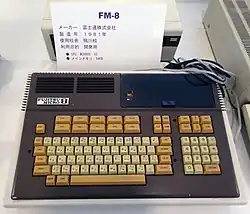

- Arrow keys — Fujitsu's OASYS100 (1980) word processor and Fujitsu FM-8 (1981) personal computer introduced a thumb-shift keyboard layout with arrow keys.[293]
- Cordless digital pen — Introduced by Wacom in 1984.[294]
- Fingerprint scanner mobile device — In 1997, Fujitsu introduced the first fingerprint reader PC Card device for laptops and mobile computers.[295]
- Information society — The concept originates from Japan, where the term Joho Shakai (information society) was first coined by the periodical Hoso Asahi in 1964.[296]
- Mail sorter with optical character recognition (OCR) — Developed by Toshiba between 1966 and 1967.[110]
- NILFS — A log-structured file system for Linux developed by Nippon Telegraph and Telephone (NTT) in 2005.[297]
- QR code — The QR code, a type of matrix barcode, was invented in 1994 by a Denso Wave research team led by Masahiro Hara.[45]
- Text-to-speech (TTS) — Noriko Umeda et al. developed the first general English text-to-speech system in 1968, at the Electrotechnical Laboratory in Japan.[298]
- Touch tablet word processor — Appeared in 1970s Japan. In 1979, Sharp Corporation's Shoin WD‑3000 featured touch tablet input with a touch pen.[299]
Artificial intelligence

- Activation function — Dates back to Kunihiko Fukushima's development of the rectified linear unit (ReLU) activation function in 1969.[300]
- Rectified linear unit (ReLU) — In 1969, Kunihiko Fukushima introduced ReLU in the context of visual feature extraction in hierarchical neural networks.[301]
- Artificial intelligence marketing (AIM) — Toyota's "Driven by Intuition" advert for the 2018 Lexus ES car was the first advert written entirely by artificial intelligence (AI).[302]
- Artificial neural network (ANN) with deep learning and stochastic gradient descent (SGD) — First proposed by Shun'ichi Amari in 1967.[301]
- Backpropagation — Anticipated by Shun'ichi Amari in the 1960s.[303]
- Multilayer perceptron (MLP) with stochastic gradient descent — In 1967, Shun'ichi Amari and H. Saito reported the first multi-layered ANN trained by SGD.[301]
- Recurrent neural network (RNN) — In 1972, Shun'ichi Amari and Kaoru Nakano published the first papers on deep learning RNN networks.[301]
- Amari–Hopfield network — The Amari network, the earliest deep learning RNN, was first published by Shun'ichi Amari in 1972. It was rediscovered by John Hopfield in 1982 as the Hopfield network.[301]
- Computer vision — Pioneered at Visual and Auditory Information Science Unit (VAISU) of NHK Science & Technology Research Laboratories (NHK STRL) in the 1960s.[304]
- Feature extraction — Developed at the VAISU unit of NHK STRL in the 1960s.[304]
- Image analysis — Developed at the VAISU unit of NHK STRL in the 1960s.[304]
- 3D computer vision — Takeo Kanade pioneered the field of three-dimensional computer vision in the 1970s.[305]
- Object detection — In 1981, Takeo Kanade co-developed an object detection algorithm using part-based models.[306]
- Convolutional neural network (CNN) — A deep learning feedforward neural network first developed by Kunihiko Fukushima between 1969 and 1979. It forms the basis of contemporary pattern recognition AI.[304]
- Neocognitron — A hierarchical multi-layered CNN first developed by Kunihiko Fukushima between 1969 and 1979.[304]
- Unsupervised learning — Pioneered by Kunihiko Fukushima with the neocognitron in 1979.[307]
- Competitive learning — A form of unsupervised learning developed by Fukushima with the neocognitron in 1979.[307]
- Facial recognition system — In 1970, Takeo Kanade publicly demonstrated a face‑matching system.[308]
- Face detection with artificial neural network (ANN) — In 1996, Takeo Kanade, Henry Rowley and Shumeet Baluja developed a face detector using ANN network.[309]
.jpg)
- Fifth Generation Computer Systems (FGCS) — MITI initiated the FGCS project in 1982. The project extensively researched AI and natural language processing (NLP).[310]
- KL0 — An AI programming language developed by the FGCS project between 1982 and 1986.[311]
- AI computer workstation (personal sequential inference machine) — Mitsubishi Electric's Melcom PSI (developed 1982–1986) was the first AI workstation.[311]
- AI home computer — The Sega AI Computer (1986) was the earliest home computer specialized for AI and NLP.[312]
- Adaptive neuro fuzzy inference system (ANFIS) — A fuzzy logic ANN inference system proposed by Hideyuke Takagi and Isao Hayashi in 1991.[313]
- Lucas–Kanade method — In computer vision, the Lucas–Kanade method is a widely used differential method for optical flow estimation developed by Takeo Kanade and Bruce D. Lucas in 1981.[314]
- Kanade–Lucas–Tomasi feature tracker (KLT) — The KLT feature tracker is an approach to feature extraction. It was developed by Takeo Kanade and Carlo Tomasi in 1991.[315]
- KLT tracker corner detection — Developed by Kanade and Tomasi in 1991.[316]
- Tomasi–Kanade factorization — Developed by Kanade and Tomasi in the early 1990s.[317]
- Machine vision — Pioneered by Hitachi researchers in 1964.[318]
- Image processor — In 1970, Hitachi researchers developed an image processor for machine vision.[318]
- Cognitive computing image processor — Sony's Cognitive Processor XR (2020) was the first picture processor with cognitive intelligence.[319]
- Smart vision sensor — In 2007, Omron developed the first 3D vision image sensor for 3D imaging.[320]
- Intelligent vision sensor — In 2020, Sony's IMX500 and IMX501 were the first intelligent vision sensors with AI edge computing and image analysis for smart cameras.[105]
- Cognitive computing smart TV — The Sony Bravia XR, introduced in January 2021, was the first cognitive intelligence TV using Cognitive Processor XR technology.[319]
- Visual recognition — Pioneered at the VAISU unit of NHK STRL in the 1960s.[304]
Calculators

- All-electric compact calculator — The Casio Model 14-A (1957) was the first all-electric compact calculator, based on relay technology.[321]
- All-transistor desktop calculator — Sharp Corporation's CS-10A (1964) was the first all-transistor-diode electronic desktop calculator.[96]
- 10-key electronic calculator — The first ten-key electronic calculator was the Canon Canola 130 (1964) by Canon Inc.[223]
- Calculator memory — The Casio 001 (1965) was the first electronic calculator with a memory function.[322]
- Handheld calculator — Sharp Corporation's Micro Compet (1969) was the first commercial electronic calculator that could be held in the palm of a hand.[323]
- Battery-powered handheld calculator — Introduced in 1970 with Sharp's QT-8B Micro Compet and EL-8, the Sanyo ICC-82D, and Pocketronic by Canon Inc.[324]
- Integrated circuit calculator — Between 1964 and 1966, Sharp developed the CS-31A, the first electronic calculator incorporating integrated circuit (IC) chips.[325]
- MOS calculator — In 1966, NEC developed the first metal–oxide–semiconductor (MOS) calculator IC chip for Hayakawa Electric (Sharp).[326]
- LSI calculator — The Sharp QT-8D Micro Compet (1969) was the first calculator to use large-scale integration (LSI) MOS integrated circuit chips.[327]
- Microprocessor calculator — Busicom's 141-PF (1971) calculator was the first commercial product to use a microprocessor.[327]
- CMOS calculator — Between 1971 and 1972, Sharp and Toshiba co-developed the Sharp Elsi Mini, the first calculator using a CMOS LSI chip. The calculator was manufactured by Sharp, while the CMOS chip was manufactured by Toshiba.[327]
- LCD calculator — Between 1968 and 1970, Sharp developed the first prototype desktop calculators with LCD displays.[328]
- VFD calculator — The Sharp QT-8D Micro Compet (1969) was the first calculator to use a vacuum fluorescent display (VFD).[329]
- LED calculator — In 1971, Busicom's LE-120A (Handy-LE) and LE-120S (Handy) were the first calculators to use LED displays.[324]
- Pocket calculator — In 1971, Busicom's LE-120A (Handy-LE), Handy LC and LE-120S (Handy) were the first truly pocket-sized electronic calculators.[324]
- Credit card size calculator — The Casio Mini Card LC-78 (1978) was the first credit card sized calculator.[324]
- Graphing calculator — The Casio fx-7000G (1985) was the first scientific calculator with graphing function.[322]
- Mathematical display — The Casio fx-82ES (2004) introduced a natural mathematical display as the calculator input method.[322]
- Soroban — The soroban is an abacus developed in Japan. It is derived from the ancient Chinese suanpan, imported to Japan in the 14th century.[330]
- Soroban with electronic calculator — In the 1970s, Suntory released a device combining a soroban abacus with an electronic calculator.[324]
- Touch key calculator — In 1975, Sharp released the lsimate EL-8130 Arithmetic Calculator, the first touch key calculator. Instead of a push-button keypad, it had a flat touch key interface using membrane keypad (like a touchpad or touchscreen).[331]
Computers
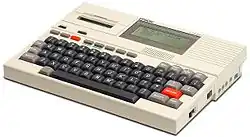
- Direct numerical control (DNC) — In 1968, FANUC developed the first DNC, a type of computer numerical control (CNC).[332]
- 32-bit computer numerical control (CNC) — Mitsubishi Electric's MELDAS 300 (1987) was the first 32-bit CNC.[248]
- E-reader with electronic paper — Sony Librie (2004), co-developed with Toppan, was the first e‑reader with electronic paper display (EPD).[333]
- Fifth generation computer — Japan's Ministry of International Trade and Industry (MITI) initiated the Fifth Generation Computer Systems (FGCS) project in 1982.[310]
- Massively parallel microcomputers — LINKS-1 (1982) was an early massively parallel computing system with up to 256 microcomputer network nodes.[311]
- Gigascale computing — The NEC SX, developed by NEC in 1983, was the first supercomputer to achieve GigaFLOPS (GFLOPS) performance with 1 billion floating point operations per second (FLOPS).[334]
- Terascale computing — The NEC SX-4 (1994) was the first supercomputer to achieve TeraFLOPS (TFLOPS) performance with 1 trillion FLOPS.[334]
- Handheld computer (pocket PC) — Sharp Corporation's PC-1210 and PC-1211 (1980) were the first handheld pocket computers.[324]
- Personal digital assistant (PDA) — The Sharp PC-1211 (1980) was the first PDA.[335]
- Touchscreen PDA — The Sharp PV-F1 (1992) was the first PDA with a touchscreen interface.[336]
- Smart device — The Sharp Zaurus (1993), an early touchscreen PDA with online capability, was considered to be the earliest smart handheld device.[337]
- Integrated circuit minicomputer — NEC's NEAC-1240 (1967) was the first minicomputer to use integrated circuit (IC) chips.[338]
- Laptop — The Epson HX-20, introduced in 1981, was the first laptop computer.[339]
- Measurement-based quantum computer (MBQC) — In 2008, Nippon Telegraph and Telephone (NTT) presented the first demonstration of quantum computing based on quantum gate teleportation.[341]
_(8861765856).jpg)
- Microcomputer — The Sord SMP80/08, developed by Sord Computer Corporation from 1972 to early 1973, was an early microcomputer, using the Intel 8008 microprocessor.[340]
- 16-bit microcomputer — The Panafacom L-16A (1976) was the earliest 16-bit microcomputer, based on the 16-bit Panafacom MN1610 (1975) microprocessor.[342]
- Home computer with disk drive — The Sord M200 Smart Home Computer (1977) was the earliest home desktop computer with a floppy disk drive.[340]
- Notebook computer — Yukio Yokozawa, working for Suwa Seikosha (Seiko Epson), invented the first notebook computer in July 1980, introduced as Epson HX-20 in 1981.[343]
- Notebook PC — The NEC UltraLite (1988) was the first IBM PC compatible laptop notebook computer.[344]
- A4 notebook computer — Toshiba's Dynabook J-3100 SS (1989) was the first A4 binder size notebook computer.[340]
- Personal computer with hard disk drive — The Sord M223 Mark VI came with a built-in hard disk drive in 1979.[340]
- Personal computer with optical disc drive — Fujitsu's FM Towns, released in February 1989, was the first personal computer sold with a built-in CD-ROM drive.[340]
- Petascale computing — The RIKEN MDGRAPE-3, developed by Riken between 2003 and 2006, was the first supercomputer to achieve PetaFLOPS (PFLOPS) performance with 1 quadrillion floating point operations per second (FLOPS).[345]
- Exascale computing — The Fugaku (supercomputer), developed by Riken between 2014 and 2020, was the first computer to achieve ExaFLOPS (EFLOPS) performance with 1 quintillion FLOPS.[346]
- Standardized computer architecture — The first attempt at a standardized computer architecture was the MSX, introduced by ASCII Corporation and Microsoft Japan in 1983.[347]
- Personal computer with laserdisc player — The Pioneer Palcom, a 1984 MSX computer by Pioneer Corporation, was the first personal computer sold with an optional laserdisc player.[348]
- Stored-program transistor computer — Electrotechnical Laboratory's ETL Mark III, which began development in 1954 and was completed in 1956, was the first stored-program transistor computer.[349]
Computer graphics

- 3D computer graphics software — Earliest was 3D Art Graphics, a set of 3D computer graphics effects written by Kazumasa Mitazawa and released for the Apple II in 1978.[350]
- 3D graphics processor — Koichi Omura's Osaka University research team developed the LINKS-1 (1982), a dedicated 3D graphics processing system.[19]
- Render farm — The LINKS-1 Computer Graphics System (1982) was a massively parallel system with up to 256 computer nodes for rendering 3D graphics.[311]
- Ray-tracing hardware — The first interactive ray tracer was the LINKS-1 Computer Graphics System (1982), used to render 3D graphics with high-speed ray tracing.[311]
- Animated color character sprite — First appeared in Kasco's arcade video game Playtron (1973).[351]
- Human sprite — Taito's arcade game TV Basketball (1974), designed by Tomohiro Nishikado, first represented human sprites.[352]
- Multi-color sprite — Taito's arcade game Super Speed Race (1977) first displayed multi-colored sprites.[353]
- Hardware sprite — Introduced by the Namco Galaxian arcade system board with Galaxian (1979).[354]
- LCD character sprite — Nintendo's LCD game Game & Watch Ball (1980) featured the first depiction of character sprites on a liquid-crystal display (LCD).[355]
- Bloom (shader effect) — Squaresoft's PlayStation 2 game The Bouncer (2000) introduced the use of bloom in 3D real-time computer graphics.[356]
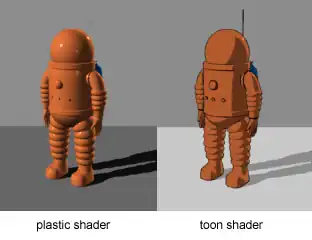
- Cel shading (toon shading) — First appeared in Riverhillsoft's video game Doctor Hauzer (1994).[357]
- Cel shader (toon shader) — Sega Dreamcast game Jet Set Radio, first demonstrated in 1999, introduced a real-time cel shader.[358]
- Computer graphics raster display CRT monitor — In the 1960s, Hitachi developed a raster scan CRT computer monitor to display raster graphics on computer terminals.[327]
- Color display tube (CDT) — In 1972, Matsushita Electric developed a high resolution CDT monitor. In 1980, Sony developed a CDT monitor with 19" display size.[54]
- CRT controller (CRTC) — Hitachi's HD46505 (HD6845), a large-scale integration (LSI) video display controller (VDC) chip released in 1977, was the first CRTC.[327]
- TV tuner — The Sharp X1 (1982) was the first personal computer with a TV tuner, used as both a computer and television. The RGB display monitor could superimpose a computer screen over a TV screen, allowing both on the same display.[96]
- Multisync monitor — The NEC Multisync (1985) computer monitor introduced support for a wide range of sync frequencies.[359]
- Anti-static and anti-reflective coating — In 1988, Japanese companies Sony, Toshiba and Hitachi developed CDT monitors with anti-static, anti-reflex and anti-glare coating.[54]
- Digital Visual Interface (DVI) — Developed between 1998 and 1999 by the Digital Display Working Group (DDWG), co-founded by Japanese companies Fujitsu and NEC.[360]
- Frame memory — Between 1964 and 1969, NHK STRL developed a prototype 1125i Hi-Vision analog HDTV system which used a minicomputer with 20 megabyte (MB) frame memory disk storage to store images.[267]
- Graphics processing unit (GPU) — The Fujitsu MB14241, used in arcade video games such as Gun Fight (1975) and Space Invaders (1978), is considered the first GPU. The NEC μPD7220 (1981) was the first large-scale integration (LSI) GPU.[361]
- 3D GPU — Between 1985 and 1988, Namco developed the first GPU dedicated to 3D polygon graphics for the Namco System 21, which was commercialized with arcade game Winning Run (1988).[362]
- 32-bit GPU — Sega developed the first 32-bit GPU for the Sega X Board arcade game system, which debuted with After Burner (1987).[363]
- 64-bit GPU — Sega developed the first 64-bit GPU for the Sega Model 1 arcade game system, which debuted with Virtua Racing (1992).[363]
- T&L GPU — In 1995, Fujitsu developed the first integrated 3D GPU with hardware T&L.[364]
- High color — The Sega Super Scaler (1985) arcade board had a 16-bit color palette (65,536 colors).[365]
- True color — The Namco System 2 (1987) arcade board had a 24-bit color palette (16,777,216 colors).[366]
- High-dynamic-range rendering (HDR rendering) — In 1990, Hiroshima University researchers presented a lighting model for driving simulators that demonstrated high dynamic range (HDR) processing.[367]
- Isometric graphics — Introduced by Data East's arcade video game Treasure Island (1981) for the DECO Cassette System.[368]
- Axonometric graphics — Introduced by Sega's arcade game Zaxxon (1981).[369]
- JPEG arithmetic coding — Patents providing the basis for JPEG's arithmetic coding algorithm include two Mitsubishi Electric patents by Toshihiro Kimura, Shigenori Kino, Fumitaka Ono and Masayuki Yoshida in 1989 and 1990.[370]
- JBIG — The JBIG lossless image compression format, introduced in 1991, was developed using patents from Japanese companies Mitsubishi, KDDI and Canon Inc.[371]
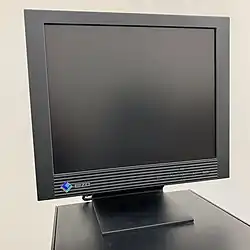
- LCD computer display — The Sharp PC-1211 (1980) pocket computer was the first computer with liquid-crystal display (LCD).[324]
- TFEL computer display — In 1983, Sharp Corporation developed the first TFEL portable computer display.[54]
- Desktop computer LCD monitor — The Eizo FlexScan (1997) was the first LCD monitor for desktop computers.[372]
- OLED computer display — The Sony CLIÉ PEG-VZ90 (2004) was the first personal digital assistant (PDA) mobile computing device to feature an OLED display.[373]
- Pseudo-3D scaling — Taito's arcade game Interceptor (1975) introduced sprite scaling. Sega's arcade game Road Race (1976) enhanced it with background scaling effects.[374]
- Pseudo-3D rotation (Mode 7) — Sega's 1987 arcade games After Burner and Thunder Blade introduced pseudo-3D rotation effects for sprites and backgrounds.[375]
- Scrolling — Introduced with the vertical scrolling in arcade racing game Speed Race (1974) by Taito's Tomohiro Nishikado.[374]
- Side-scrolling — Dates back to Taito's arcade racing game Dead Heat (1975).[376]
- Multi-directional scrolling — Introduced by Tomohiro Nishikado's arcade shooter game Interceptor (1975).[374]
- Forward scrolling — Introduced by Sega's arcade driving game Road Race (1976).[374]
- Parallax scrolling — First appeared in the arcade games Jump Bug (1981) by Alpha Denshi and Moon Patrol (1982) by Irem.[377]
- Infinite scrolling — Dates back to Konami's arcade shoot 'em up game Time Pilot (1982).[378]
- Super video graphics array (SVGA) — In 1988, NEC Home Electronics created the Video Electronics Standards Association (VESA) to develop the Super VGA (SVGA) computer display standard. The development of SVGA was led by NEC.[379]
- VGA projector — The first video graphics array (VGA) projectors were Epson's light valve TFT LCD projector in 1993 and 3LCD projector in 1994.[54]
- Tile-based graphics — The tile-map model was introduced by Namco's arcade game Galaxian (1979), which ran on the Namco Galaxian arcade system board.[380]
- Hardware scrolling — The Namco Galaxian arcade system board introduced with Galaxian (1979) pioneered a hardware sprite system that animates pre-loaded sprites over a scrolling background, the basis for later 2D game systems.[354]
- Tile-based graphics card — HAL Laboratory's PCG (1980) was an early tile-based graphics card for home computers.[381]
- Virtual pet — The first virtual pet was the screenmate application Neko, created by Naoshi Watanabe for the PC-9801 in the 1980s.[382]
- VR photography — In 1995, Takeo Kanade's team introduced virtualized reality, where a multi-camera setup captures a real‑world scene from different angles to render as a virtual world within a virtual reality.[383]
Culture
- Cosplay — Dates back to 1960s Japan. The term "cosplay" was coined by Nobuyuki Takahashi in 1983.[384]
- Dab — Known as "henshin" or "sentai move" in Japan, it originates from the tokusatsu show Kamen Rider (1971).[385]
- Kawaii — Roots date back to The Pillow Book (1002).[386]
- Netsuke — A miniature sculpture, originating in 17th-century Japan.[387]
- Lolita fashion — In the late 1970s, a new movement known as Otome (乙女) was founded, which inspired Lolita fashion.[388]
- Selfie — The Minolta Disc-7 (1983) was the first camera designed for selfies, including a selfie mirror and a selfie stick attachment.[244]
- Soramimi — Derived from long-running "Soramimi Hour" segment (debuted 1992) on Japanese comedian Tamori's TV program Tamori Club.[389]
Finance
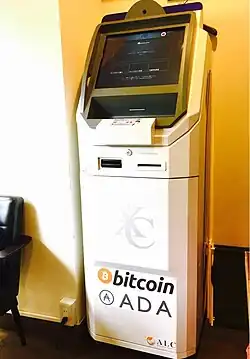
- Automated teller machine (ATM) — In the mid-1960s, the Computer Loan Machine in Japan was the first ATM cash machine.[390]
- Bitcoin — Bitcoin's founder uses the name Satoshi Nakamoto, but his identity is unknown. He was previously believed to be Dorian Nakamato, but he denied it was him.[391]
- Candlestick chart — Candlestick charts have been developed in the 18th century by Munehisa Homma, a Japanese rice trader of financial instruments.[392]
- Futures contract — The first futures exchange market was the Dōjima Rice Exchange in Japan in the 1730s.[393]
- ISO 22301 — In 2012, Fujitsu co-developed the ISO 22301 international standard for business continuity management systems.[293]
- Mobile payment (mobile wallet) — In 2004, NTT DoCoMo and Sony introduced the first mobile wallets with the Osaifu-Keitai payment system for 3G mobile phones in Japan.[394]
- Okamoto–Uchiyama cryptosystem — Developed by Tatsuaki Okamoto.[194]
- Efficient Probabilistic Public-Key Encryption Scheme (EPOC) — Developed by Tatsuaki Okamoto.[194]
- MOV attack — Developed by Tatsuaki Okamoto.[194]
- Smart card — Kunitaka Arimura of the Arimura Technology Institute in Japan independently developed the idea of an integrated circuit card, and filed a smart card patent in March 1970.[395]
Food and drink

- Bento
- Canned coffee — Canned coffee was invented in 1965 by Miura Yoshitake, a coffee shop owner in Hamada, Shimane Prefecture, Japan.[396]
- Cooking comic — Genre emerged in 1970, with Totsugeki Ramen, Cake Cake Cake and Kitchen Kenpo.[397]
- Curry bread — Invented in Japan during the early 20th century, either by Nakata Toyoharu (in 1927) or by Aizō Sōma (some time after meeting Rash Behari Bose in 1916).[398]
- Retort pouch — In 1968, Otsuka Foods Company in Japan introduced the first retort food product, a Japanese curry called Bon Curry.[399]
- Fake food — Simulated food was invented after Japan's surrender ending World War II in 1945. Japanese artisans and candlemakers created wax food initially for foreigners.[400]
- Fortune cookie — Originates from tsujiura senbei in 19th century Japan. Modern fortune cookies originate from Japanese immigrants to America in the late 19th century.[401]
- Monosodium glutamate — Invented and patented by Kikunae Ikeda.[402]
- Probiotic drink — Introduced with Yakult, invented by Minoru Shirota in 1935.[45]
- Ramen
- Instant noodle — Invented by Momofuku Ando, a Taiwanese-Japanese inventor, in 1958.[45]
- Cup noodle — Momofuku Ando invented the first cup noodle, Nissin Cup Noodles, introduced in 1971.[45]
- Rice ball — Onigiri rice balls date back more than 2,000 years, found at an archaeological site in Ishikawa Prefecture.[403]
- Sushi
- Umami — Umami as a separate taste was first identified in 1908 by Kikunae Ikeda of the Tokyo Imperial University while researching the strong flavor in seaweed broth.[404]
Philosophy
_Press_Photo_of_Toshiro_Mifune_and_Machiko_Ky%C5%8D.jpg)
- Autonomation — Concept proposed by Taiichi Ohno and Sakichi Toyoda in the early 20th century.[405]
- Kokugaku — A school of Japanese philology and philosophy originating during the Edo period.[406]
- Kyokan — A concept forwarded by Masao Kawai. It first appeared to Western readers in Kawai's book Ecology of Japanese Monkeys (1969).[407]
- Lean manufacturing — A generic process management philosophy derived mostly from the Toyota Production System (TPS) and identified as "Lean" only in the 1990s.[408]
- Paris syndrome — Hiroaki Ota, a Japanese psychiatrist working at the Sainte-Anne Hospital Center in France, identified the syndrome in the 1980s.[409]
- Galápagos syndrome — Identified in Japan during the 2000s.[410]
- Postmodern art game — Hideo Kojima's Metal Gear Solid 2: Sons of Liberty (2001) is considered the first postmodern video game.[411]
- Post-truth politics — Hideo Kojima's Metal Gear Solid 2: Sons of Liberty (2001) is cited as an early work that anticipated contemporary post-truth politics.[411]
- Psychological novel — The Tale of Genji (11th century) is considered to be the first psychological novel.[86]
- Rashomon effect — The concept originates from Ryūnosuke Akutagawa's novel In a Grove (1922), which was adapted into Akira Kurosawa's film Rashomon (1950).[412]
- Uncanny valley — Masahiro Mori first introduced the concept in his 1970 essay The Uncanny Valley Phenomenon.[413]
Textiles
- Automatic power loom with non-stop shuttle-change motion — Invented by Sakichi Toyoda with the Toyoda Automatic Loom (1924) using autonomation.[414]
- Clarino — A synthetic leather developed by Kuraray in 1964.[415]
- Clarino shoe — In 1966, Onitsuka Tiger (Asics) released the first athletic shoes using Clarino.[416]
- Numerical control straight stitch sewing machine — Introduced by Brother Industries in 1974.[417]
- Computerized sewing machine — Brother's ZZ3-B820 "Opus 8" (1979) was the first computerized sewing machine.[417]
- Nylon 6 — A type of synthetic nylon developed by Toray between 1938 and 1941.[418]
- Nylon shoe — The After Boots (1954) by Onitsuka Tiger were the first shoes made with nylon.[416]
- Vinylon — The second man-made fiber after nylon. Invented by Ichiro Sakurada, H. Kawakami and Ri Sung-gi at the Takatsuki chemical research center in 1939.[419]
- Synthetic rubber shoe sole — The Rubber Sponge Shoe (1956) by Onitsuka Tiger (Asics) was the first shoe with synthetic rubber sponge sole.[416]
Stationery

- Correction tape — Correction tape was invented in 1989 by the Japanese product manufacturer Seed. It is an alternative to correction fluid.[420]

- Gel pen — The gel pen was invented in 1984 by the Sakura Color Products Corporation of Osaka.[421]
- Mechanical pencil — In 1915, Sharp Corporation founder Tokuji Hayakawa invented an early mechanical pencil.[323]
- Chromium ballpoint pencil — Ohto's Auto-Pencil (1949), a ballpoint pen shaped like a pencil, was the first writing instrument to use a chrome ball with chrome tip refill.[422]
- Retractable ballpoint pen — In 1962, Ohto released the first commercial retractable ballpoint pen.[422]
- Tungsten carbide ballpoint pen — In 1963, Ohto introduced the first ballpoint pen with tungsten carbide ball.[422]
- Transparent ballpoint pen refill — In 1964, Ohto manufactured the first ballpoint pen refill with transparent pipe.[422]
- Rollerball pen — The first rollerball pen was invented by Ohto in 1963 and released in 1964.[422]
- Rubber grip ballpoint pen — In 1978, Ohto introduced the first ballpoint pen with rubber grip.[422]
Display technology

- AV receiver — Denon's AVC-500 (1985) was the first AV amplifier, enabling the development of modern home cinema.[115]
- Calibration sensor — Introduced with Eizo's ColorEdge CG Series monitors in 2010, for which Eizo received an Academy Award for Technical Achievement in 2021.[423]
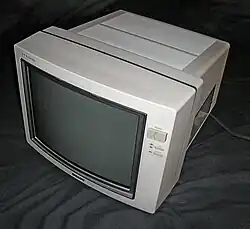
- Cathode-ray tube (CRT) with thermal electron emission — In 1925, Kenjiro Takayanagi invented a high-performance CRT display with a thermal electron emission source.[424]
- Horizontal sync and vertical sync with photocell — In 1927, Takayanagi demonstrated a CRT with horizontal/vertical sync pulses generated by a photocell.[424]
- Bipotential electron gun —In 1929, Takayanagi demonstrated a CRT that incorporated a bipotential electron gun with G2 and oxide cathode.[54]
- Aperture grille — One of two major CRT display technologies, along with shadow mask. Aperture grile was introduced by Sony with their Trinitron TV set in 1968.[54]
- Deflection yoke — In 1971, JVC introduced deflection yokes for CRT displays.[221]
- Chip-on-glass (COG) — Developed by Kyocera in 1987, used for manufacturing LCD and OLED displays.[328]
- Color TFT liquid-crystal display (TFT LCD) — In 1983, a-Si thin-film transistor (TFT) color LCD panels were demonstrated by Sanyo, Sanritsu and Canon Inc.[328]
- Ferroelectric liquid crystal display (FLCD) — By 1985, Seiko had demonstrated a color FLCD panel.[425]
- Dual-scan super twisted nematic (DSTN) — In 1987, Seiko Epson developed dual‑scan super-twisted nematic (DSTN) LCD technology.[54]
- Color STN (CSTN) — Toshiba, Sharp Corporation and Mitsubishi Electric introduced color LCD STN displays in the 1980s.[328]
- IPS panel — In the early 1990s, Katsumi Kondo at Hitachi combined in-plane switching (IPS) with TFT LCD technology to develop the first practical IPS panel with wide viewing angle, presented by Hitachi in 1995.[54]
- Flat-panel video display — In 1974, Sharp Corporation's scientists demonstrated the first flat-panel display capable of showing video images, using thin-film electroluminescence (TFEL) technology.[426]
- Color electroluminescent display (ELD) — Demonstrated by K. Okamoto of Osaka University in 1981.[427]
- See-through display — In 2000, Denso co-developed a transparent EL display (ELD).[54]
- Grayscale plasma display — Developed by Mitsubishi Electric and Hitachi in 1972.[428]
- Magnesium oxide plasma display (MgO) — Developed by Fujitsu and Hiroshima University in 1973.[428]
- Color plasma display — The first full-color plasma display prototype was demonstrated by NHK in 1978.[54]
- High frame rate — Between 1974 and 1975, NHK developed prototype CRT displays capable of frame rates higher than the 60 Hz NTSC standard, reaching up to 500 Hz frame rate.[267]
- Metal–insulator–metal LCD (MIM LCD) — In 1981, Seiko Epson co-developed the first LCD display using metal‑insulator‑metal (MIM) diodes.[54]
- Metal–insulator–metal field-emission display (MIM FED) — In 2000, Hitachi developed the first field-emission display (FED) with MIM field emitter.[54]
- Ballistic electron surface-emitting display (BSD) — A type of FED developed by Matsushita Electric in 2001.[54]
- OLED display — In 1996, TDK demonstrated the first active-matrix OLED (AMOLED) QVGA display.[54]
- PMOLED — In 1996, Pioneer Corporation produced the first passive matrix OLED (PMOLED) display for car audio systems.[429]
- Flexible OLED display — In 2005, Sony and the Institute of Physical and Chemical Research developed a prototype OLED rollable display.[430]
- OLED head-mounted display (HMD) — The Sony HMZ-T1 (2011) was the first 3D HMD equipped with a HD OLED display.[105]
- Crystal LED (CLED) — Sony unveiled CLED display technology at CES 2012.[431]
- Slot mask — A variant of shadow mask CRT display technology developed by Toshiba in 1971.[54]
- Invar shadow mask — Developed by Toshiba for a color display tube (CDT) computer monitor in 1983 and a CRT television set in 1986.[54]
- S-Video — The S-Video cable standard was introduced in 1987 with JVC's S-VHS format.[432]
- TFT LCD projector — In 1986, Seiko Epson developed a TFT LCD light valve projector. In 1988, Sharp Corporation introduced a commercial TFT LCD projection system.[54]
- Color LCD projector — The Epson VPJ-700, released in January 1989, was the first compact full-color LCD projector.[433]
- LCD video projector — In 1989, Sharp released the first 100-inch LCD video projector for home use.[323]
- Metal-halide lamp projector — In 1991, Japanese company Iwasaki Electric developed the first metal-halide discharge projection lamp.[54]
- UHP lamp projector — Epson's ELP-3500 (1996) was the first commercial LCD projector with ultra-high-performance lamp (UHP lamp).[54]
- Telecentric projector — In 1999, telecentric projection lens for LCD projectors were co-developed by Minolta and Nikon.[54]
- LED-backlit pocket projector — In 2005, the first LED-illuminated digital light processing (DLP) pocket projector was released by Mitsubishi Electric, Toshiba and Samsung.[54]
- LCD laser projector — The Sony VPL-FHZ55 (2013) was the first 3LCD laser light source projector.[105]
- Vacuum fluorescent display (VFD) — In 1966, ISE Electronics Corporation established the basic structure of VFD. They developed a single-digit VFD in 1967 and multi-digit VFD in 1970. In 1972, ISE received a patent for inventing VFD.[434]
- VFD color display — In 1979, Japanese company Kasei Optonics developed a multi-color VFD.[54]
Electronic television
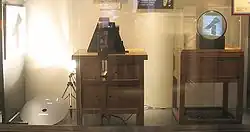
- All-electronic television (TV) — Between 1924 and 1925, Kenjiro Takayanagi invented the first all‑electronic TV. By 1927, he improved display resolution to 100 scanlines.[435]
- Cathode-ray tube television (CRT TV) — Developed by Kenjiro Takayanagi between 1924 and 1925.[435]
- Halftone television — By 1928, Kenjiro Takayanagi was the first to transmit human faces in halftones. His work influenced the later work of Vladimir K. Zworykin.[436]
- Transistor TV set — The first fully transistorized, portable solid-state TV set was Sony's TV8-301, developed from 1958 to 1959 and then released in early 1960.[98]
- Flyback transformer — In 1968, Matsushita Electric invented the first winding-free high-voltage flyback transformer for TV receivers using piezoelectric ceramics.[437]
- Automatic fine tuning (AFT) — In 1969, Toshiba released the first color TV with AFT integrated circuit (IC) technology.[110]
- Integrated circuit color TV — In 1969, Toshiba released an early color TV incorporating an IC chip. In 1971, they released the first color TV with mostly IC chips.[110]
- Digital TV (DTV) — In the mid-1980s, Toshiba, Sony and NEC released TV sets with digital capabilities. These early digital TV sets converted analog TV signals into digital video signals.[438]
- DTV broadcast — Proposed in 1986 by Nippon Telegraph and Telephone (NTT) and Ministry of Posts and Telecommunications (MPT) as part of the Integrated Network System (INS).[439]
- Enhanced-definition television (EDTV) — Nippon TV (NTV) began broadcasting Clear-Vision (EDTV) in 1989 and Wide Clear Vision (widescreen EDTV) in 1995.[440]
- Improved-definition television (IDTV) — In 1989, IDTV used digital electronics to improve NTSC picture quality in Japan.[266]

- Flat-screen TV — In 1974, Sharp Corporation demonstrated the first flat-screen TV using thin-film electroluminescence (TFEL) technology.[54]
- Plasma TV — The first prototype color plasma TV was demonstrated by NHK in 1978.[428]
- Flat-panel CRT TV — Sony's KV-28SF5 (1996), which introduced Super Flat Trinitron technology, was the first CRT TV with a flat screen.[105]
- OLED TV — The Sony XEL-1 (2007) was the first OLED TV.[105]
- Hybrid log–gamma (HLG) — High-dynamic-range television (HDR TV) format co-developed by NHK in 2015.[441]
- Interactive TV — Between 1975 and 1977, Pioneer Electronics developed Qube, the first two-way addressable, interactive cable TV system.[442]
- Smart TV — Introduced in Japan during the early 1980s. LSI chips with memory and character generator enabled a mix of programming and information over TV signals.[443]
- Large-screen television technology (video wall) — In 1980, Mitsubishi Electric introduced Diamond Vision, the first large-scale video display system.[248]
- Jumbotron — Introduced by Sony at the Expo '85 held in May 1985 at Tsukuba, Ibaraki.[444]
- Laser TV — In early 2006, Mitsubishi Electric demonstrated the first commercial laser TV.[445]
- LCD television (LCD TV) — The first LCD televisions were invented as handheld televisions in Japan. The first LCD TV prototypes were demonstrated by Hitachi in 1977 and Matsushita Electric in 1978.[328]
- Color LCD TV — In 1980, Hattori Seiko's R&D group began development on color LCD pocket televisions.[446]
- Wall-mount TV — In 1991, Sharp Corporation released the first wall-mountable TV, with a color TFT LCD display.[323]
- LED-backlit LCD — The Sony Qualia 005 (2004) was the first LED-backlit LCD television.[105]
- On-screen display (OSD) — In 1972, Sharp Corporation introduced the first television set to display a television channel number on the corner of the screen.[448]
- Picture-in-picture (PIP) — In 1978, Sharp's CT-1804X was the first TV that could display two programs at once on the same screen.[96]
- Portable television — The Sony TV8-301, developed from 1958 to 1959, was the first portable direct-view television.[98]
- SAW TV receiver — In 1977, Toshiba produced the first surface acoustic wave (saw) device for TV receivers.[110]
- Widescreen television — Between 1970 and 1975, NHK developed widescreen TV displays for their Hi-Vision analog HD system. They experimented with different aspect ratios from 1:1 to 9:1 before settling on 5:3.[267]
High definition
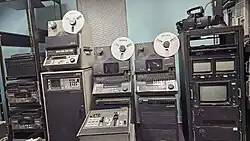
- High definition (HD) — From 1964 to 1969, NHK STRL developed a Hi-Vision 1125i analog HDTV system, demonstrated in 1969 with a CRT monitor and video camera.[267]
- Component video — Between 1970 and 1973, NHK and Panasonic developed a HDTV system with color analog component video, demonstrated by Panasonic in 1973.[267]
- HD interlaced video — Between 1970 and 1975, NHK developed a Saticon video camera and CRT displays with interlaced display resolutions from 935i to 2125i scanlines.[267]
- HD video progressive scan — Between 1974 and 1975, NHK developed a Saticon video camera and CRT displays with progressive scan resolutions from 610p to 1195p.[267]
- Digital HD — NEC's μPD7220 (1981) graphics processing unit (GPU) supports digital HD resolutions up to 1024p with 16 colors or up to 2048i in monochrome.[450]
- 4K resolution — The NEC μPD7220 (1981) GPU supports monochrome 4K horizontal resolutions up to 4096×1024p or 4096×2048i.[451]
- High-definition LCD display — In the 1980s, prototype HD LCD displays were developed NEC, Sanyo and Sharp Corporation.[266]
- HD plasma display — In the 1980s, prototype HD plasma displays were developed by Fujitsu, Hitachi, Matsushita Electric, Mitsubishi Electric, Sony and Toshiba.[266]
- HD video projector — Introduced with the Sony HDVS in 1981.[452]
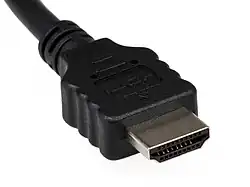
- High-Definition Multimedia Interface (HDMI) — In 2002, HDMI was co-developed by Hitachi, Panasonic, Maxell, Sony and Toshiba.[453]
- High-definition television program (HDTV program) — NHK's Images for Hi-Vision (1982) was the first HDTV program, broadcast on NHK's Hi-Vision analog HDTV.[220]
- High-definition video codec
- HD video decoder — In the 1980s, HD video decoders were released by Hitachi, NEC, NHK (MUSE), Sanyo, Toshiba and Canon Inc.[266]
- HD video encoder — In the 1980s, HD video encoders were released by Canon, Ikegami Tsushinki, NHK (MUSE) and Toshiba.[266]
- High-definition video disc — In the 1980s, HD video recording optical disc formats were released by Sanyo, Sony and JVC.[266]
- Digital HD video disc — In 2000, Sony demonstrated a prototype blue laser disc format, Blu-Ray, capable of storing digital HD video.[454]
- High-definition video recording — Introduced with Sony HDVS (1981), including Hi-Vision VCR recording 1125i analog HDTV content on U-matic cassettes.[452]
- Progressive scan HD video — Panasonic's D-5 HD (1994) videocassette format was the first HD digital video format to support progressive scan, recording 720p content.[455]
- HD video combo television unit — The Sharp Aquos LC-52X1 (2008) LCD TV was the first TV set with a built-in Blu-Ray disc HD digital video recorder.[323]
- Satellite HDTV — NHK used Yuri, a Japanese broadcasting satellite launched in 1978, to demonstrate analog HDTV satellite transmission in 1979.[267]
- Super XGA (SXGA) — The super extended graphics array (SXGA) display standard was developed by JVC in 1997.[456]
- Ultra HD (UHD) — Hitachi's ARTC HD63484 (1984) GPU supports monochrome 4K UHD resolutions up to 4096×2048p or 4096×4096i. The resolutions were targeted at the bit-mapped desktop publishing market.[458]
- 8K resolution — Between 1995 and 2003, NHK, JVC and Ikegami Tsushinki developed a prototype 8K Super Hi-Vision video system, demonstrated in 2003 with 8K compatible UHDTV, video camera, video disc recorder and video projector.[459]
- 10K resolution — In 2010, 120 megapixels image resolution and 13K horizontal resolution (13,280×9184) was reached using an APS-H CMOS sensor developed by Canon Inc.[460]
- 16K resolution — Sony, Nest+Visual and Indy Associates in early 2014 demonstrated 16K video, using a modified Sony F65 CineAlta camera. A 16K film was presented in March 2014 on a multi-screen video display at Tokyo International Airport.[461]
- 32K resolution — In 2018, Sony were working on developing a 32K display.[462]
- Ultra HDTV (UHDTV) — Between 1995 and 2003, researchers from NHK, JVC and Ikegami Tsushinki developed a prototype UHDTV system, which they demonstrated as Super Hi-Vision in 2003.[459]
- Ultra HD camcorder — JVC's GY-HMQ10, released in January 2012, was the first handheld 4K camcorder.[463]
- 8K resolution camcorder — Sharp Corporation's 8C-B60A (2017) was the first 8K camcorder.[323]
- Upscaler television — The Toshiba Regza ZH7000 (2008) LCD TV was the first upscaling TV, capable of upscaling standard definition (SD) content to full HD using super-resolution imaging (SR).[110]
Three-dimensional
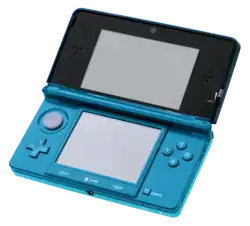
- Autostereoscopic 3D TV — In the late 1950s, NHK developed a prototype autostereoscopic 3D TV using parallax barrier technology.[206]
- Active shutter 3D TV — In the late 1970s, Matsushita Electric developed a stereoscopic 3D TV using an active shutter 3D system, commercialized in 1981.[464]
- 3D video — In 1981, Matsushita demonstrated 3D images stored on video tape.[464]
- 3D HDTV — In the 1998 Nagano Olympics, some sporting events were filmed in 3D high definition.[465]
- Multi-primary color display (MPC) — The Sharp Aquos Quattron (2010) 3D LCD TV introduced four primary color sub-pixels, including RGB and a yellow sub-pixel.[96]
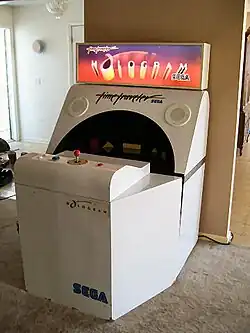
- Holographic 3D display — In 1970, a prototype holographic projection 3D display was developed by Takanori Okoshi of Tokyo University and A. Yano of Canon Inc.[466]
- Wide view holographic projection — Developed by Takanori Okoshi between 1968 and 1980.[467]
- Computer-generated holography with spatial light modulator (SLM) — First proposed in 1976 by Keio University and Electrotechnical Laboratory.[468]
- Holographic 3D game — Sega's arcade electro-mechanical game Monte Carlo (1971) was the first game to display holographic animations.[469]
- Holographic 3D video game — Sega's Time Traveler (1991) was the first holographic video game, using a holographic optical device invented by Dentsu.[470]
- Holographic video — In 1973, Hitachi researchers Yoshito Tsunoda and Yasutsugu Takeda developed a video recording media storing video frame images as holograms.[471]
- Holographic video disc — In 1975, a Hitachi research team demonstrated a video disc system with audio-visual information encoded holographically.[472]
- Stereoscopic mobile phone — The Mova SH251iS (2002) by Sharp Corporation and NTT DoCoMo was the first mobile phone with a stereoscopic 3D display.[473]
- Autostereoscopic mobile phone — In January 2009, Hitachi introduced the first autostereoscopic 3D phone under KDDI, the Hitachi H001.[474]
- Stereoscopic video game — The arcade game SubRoc-3D, developed by Sega and Matsushita Electric between 1981 and 1982, was the first stereoscopic 3D game. It used a periscope viewer with active shutter 3D system.[464]
- Stereoscopic handheld — The Bandai LCD Solarpower game Terror House (1982) displayed a 3D-like effect. Tomy's Tomytronic 3D (1983) was a stereoscopic 3D binocular viewer.[475]
- Autostereoscopic game — In 1997, Sega AM3 presented the Floating Image System, an autostereoscopic 3D display.[476]
- Autostereoscopic game console — The Nintendo 3DS (2011) was the first game console with an autostereoscopic 3D display using parallax barrier technology.[477]
- Touchable hologram — In 2015, Japanese 3D display firm Aerial Burton and researchers from four Japanese universities demonstrated the first touchable hologram, using sensors to detect touch and haptic technology to provide feedback.[478]
Timekeeping
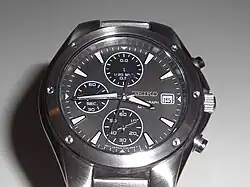
- Battery-powered electric clock — In 1885, Sakizō Yai invented a continuous electric clock powered by wet-cell batteries.[479]
- Digital wristwatch — In 1953, Yoshiro Nakamatsu invented the first prototype wristwatch with a digital display.[114]
- Digital stopwatch — Seiko's Stop Clock (1963), used at the 1964 Tokyo Olympics, was the first digital stopwatch.[480]
- Japanese clock (wadokei)
- Myriad year clock — Universal clock designed by the Japanese inventor Hisashige Tanaka in 1851. It belongs to the category of Japanese clocks called Wadokei.[481]
- LCD digital watch — In 1969, Yoshio Yamasaki at Suwa Seikosha (Seiko Epson) began developing a digital watch with LCD display.[328]
- Multi-function display (digital calendar) — The Casiotron QW02-10 (1974) by Casio was the first digital watch with an automatic calendar (auto-calendar) function.[482]
- Digital thermometer — The Casio TS-1000 (1982) was the first wristwatch with built-in thermometer.[482]
- Portable quartz clock — Seiko's Crystal Chronometer (1963), used at the 1964 Tokyo Olympics, was the first portable quartz clock.[483]
- Quartz watch — The world's first quartz wristwatch was revealed in 1967, a prototype of the Astron revealed by Seiko in Japan, where it was in development since 1958. It was eventually released to the public in 1969. It sparked the Quartz revolution.[484]
- CMOS wristwatch — Suwa Seikosha (Seiko Epson) began developing a CMOS integrated circuit chip for a Seiko quartz watch in 1969. It was revealed as the Seiko Analog Quartz 38SQW in 1970.[485]
- Spring Drive — A watch movement which was first conceived by Yoshikazu Akahane working for Seiko in 1977 and was patented in 1982. It features a true continuously sweeping second hand, rather than the traditional beats per time unit.[433]
- Automatic quartz — The first watch to combine self-winding with a crystal oscillator for timekeeping was unveiled by Seiko in 1986.[484]
- Self-winding chronograph — In early 1969, Seiko produced the first commercial self-winding chronograph with a vertical clutch system and column wheel.[484]
- Digital chronograph — The Seiko LC Chronograph (1975) was the first digital chronograph.[480]

- Smartwatch — Casio Databank series (1983–1991) were the first smartwatches, featuring calculator, PDA, memory, touchscreen, gesture recognition, phonebook and calendar.[482]
- GPS watch — The Casio Pro Trek PRT-1GPJ (1999) was the first watch with built-in GPS navigation.[482]
- Titanium diving watch (water resistant watch) — The Professional Diver's 600m, developed by Seiko from 1968 to 1975, was the first diver's watch with titanium case.[484]
- Shock-resistant watch — The Casio G-Shock DW-5000C (1983) was the first tough shock-resistant watch that could withstand shocks, drops and impacts.[482]
- Voice recording watch — Seiko's Voice Note (1983) was the first watch with voice recording function, which could be played back or used for voice alerts.[484]
- Wearable TV watch — Seiko's TV-Watch (1982) was the first TV watch using active-matrix LCD display. It also had FM radio, alarm, chronograph and calendar functions.[484]
- World radio watch — The Citizen Watch Radio-Controlled Watch (1993) was the first radio-controlled clock (RCC) supporting multiple time zones.[486]
Video
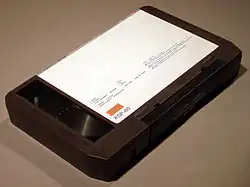
- Digital video — In 1972, Toshiba's TOSBAC computer was using digital video disc technology to store color digital images.[487]
- Digital video recorder (DVR) — In the 1980s, prototype digital high-definition video recorders were developed by Fujitsu, Hitachi, Sanyo and Canon Inc.[266]
- Digital component video — The D-1 (Sony) digital videocassette format introduced in 1986 was the first commercial digital component video format.[488]
- Deep color (30-bit color) — The D-5 (Panasonic) digital videocassette introduced in 1993 was the first component video format supporting 10-bit color per component.[488]
- Digital video optical disc — Matsushita's Erasable Optical Memory Disc Recorder System (1983) was the first optical disc format storing digital video content.[489]
- Digital video disc (DVD) — The DVD format was developed in 1995 by Sony, Toshiba, Panasonic and Philips.
- DVD player — The first DVD player was released by Toshiba in November 1996.[110]
- DVD recorder — The first DVD recorder was released by Pioneer Corporation in 1999.[490]

- Helical scan video tape recorder (VTR) — Invented by Norikazu Sawazaki in 1953. In 1959, Toshiba released the first commercial helical scan VTR.[491]
- Transistor VTR — Sony's SV-201 (1961) was the first transistor-based VTR.[105]
- Videocassette — The first video cassette tape format was Sony's U-matic, developed in the 1960s before being released in 1971.[492]
- Videocassette recorder (VCR) — In 1971, the first videocassette player was the Sony VP-1100 and the first VCR was the Sony VO-1700, using U-matic videocassettes.[493]
- VHS — The VHS (Video Home System) was invented in 1973 by Yuma Shiraishi and Shizuo Takano, who worked for JVC.[494]
- Betamax — Betamax was an analog magnetic tape videocassette marketed to consumers released by Sony on 10 May 1975.[495]
- Inter-frame motion compensation (MC) — In 1959, NHK's Y. Taki, M. Hatori and S. Tanaka proposed predictive inter-frame MC video coding in the temporal dimension.[496]
- H.261 — The majority of patents for the H.261 (1988) video coding standard were from Japanese companies, including Hitachi, Nippon Telegraph and Telephone (NTT), Toshiba, KDDI, Sony, Sharp Corporation, Oki and Matsushita.[497]
- VC-1 — Japanese companies that contributed patents towards the VC-1 (2006) video coding format include Panasonic, Hitachi, Mitsubishi Electric, Sony, JVC Kenwood, Toshiba, Fujitsu, Sharp, and NTT.[498]
- AV1 — Japanese companies that contributed patents towards the development of the AV1 (2018) video coding format include NTT and Toshiba.[499]
- Laserdisc player (LD player) — In February 1979, Pioneer Corporation released the first laserdisc (LD) player for business use. In June 1980, Pioneer released the first LD player for home use.[490]
- MPEG (MPEG-1) — In 1988, Hiroshi Yasuda co-founded the Moving Picture Experts Group (MPEG) to develop the MPEG-1 video coding standard.[500]
- MPEG-4 (H.263) — In 1998, Toshiba developed the first MPEG-4 Visual (MP4) large-scale integration (LSI) video codec chip, enabling the video compression and video decoding of MP4 video files.[110]
- Context-adaptive variable-length coding (CAVLC) — Video coding algorithm developed in 2003 by Sadātsu Kato's NTT DoCoMo research team.[503]
- H.264 (AVC) — NTT DoCoMo's CAVLC coding algorithm was adopted by the Advanced Video Coding (AVC) H.264 standard in 2003.[503]
- H.265 (HEVC) — Japanese companies that contributed patents towards HEVC (2013) include NTT, JVC, NEC, Fujitsu, Maxell, NHK, Funai and Canon Inc.[504]
- H.266 (VVC) — Japanese companies that contributed patents towards VVC (2020) include NTT, Godo Kaisha, JVC, KDDI, Mitsubishi Electric, NEC, Panasonic and Fujitsu.[505]
- Video floppy — The first prototype video floppy disk was developed in 1977 by Canon Inc. The Video Floppy format was demonstrated by Sony and introduced under the Mavipak name in 1981 for their prototype Mavica camera.[269]
Domestic appliances
Air conditioning
.png)
- Bladeless fan — The first bladeless electric fan was patented by Toshiba in 1981.[506]Various air conditioners (AC) manufactured by Japanese companies Mitsubishi Electric, Daikin and Olympus Corporation.
- Ductless air conditioner (mini-split) — In 1961, Toshiba introduced the first ductless mini-split air conditioner (AC).[507]
- Cross-flow fan — In 1968, Mitsubishi Electric introduced the first wall-mounted mini‑split AC with cross-flow fan.[248]
- Portable air conditioner (AC) — In 1968, Toshiba introduced the first set-free room air conditioner that could be moved around the room.[110]
- Ductless multi-split AC — Multi-zone ductless AC systems were invented by Daikin in 1973. It was first sold in Japan.[508]
- Variable refrigerant flow (VRF) — VRF systems (larger multi-split systems) were invented by Daikin in 1982. It was first sold in Japan.[508]
- Folding fan — The folding hand fan was invented in Japan, with dates ranging from the 6th to 9th centuries.[509]
- Helical air compressor — In 2000, Toshiba released the first AC with helical compressor, the Modular Multi System using R407C refrigerant.[507]
- DC twin rotary compressor — In 2017, Toshiba developed the first DC twin rotary air compressor, the world's largest capacity for INV Chiller.[507]
- Inverter air conditioner (inverter AC) — In 1980, Toshiba released the first inverter AC, as an alternative to the standard home window AC.[110]
- Energy-saving air conditioner — In 1994, Mitsubishi Electric released the first energy-saving household AC.[248]
- Light commercial AC — The first was Toshiba's Super Power Eco (2001) using DC inverter rotary compressors (R410A refrigerant).[507]
- Plasma air purifier — Sharp Corporation's Plasmacluster, developed between 1998 and 2000, was the first plasma air purifier.[96]
- Air purifier with mosquito trap — Sharp's FU-GK50 (2016) Plasmacluster is the first mosquito-catching air purifier.[323]
- Voice control air conditioner — In 2011, Toshiba released the first voice-controlled AC.[507]
Kitchen appliances

- Bread machine — The bread machine was developed and released in Japan in 1986 by the Matsushita Electric Industrial Company (Panasonic).[510]
- Electric rice cooker — The first electric rice cookers were developed by Matsushita, Mitsubishi Electric and Sony between the 1920s and 1940s.[511]
- Automatic rice cooker — Invented by husband–wife team Yoshitada Minami and Fumiko Minami between 1951–1955. It was commercialized by Toshiba in 1955.[511]
- Individual quick freezing (IQF) — A quick freezer for whipped cream was developed by Norio Owada of Abi in the 1970s.[512]
- Dual-swing refrigerator — In 1989, Sharp Corporation introduced the first dual-swing refrigerator, with doors that opened from both the left and right.[96]
- Cells Alive System (CAS) — Refrigeration technology developed by Norio Owada of Abi from 1992 to 1998.[512]
- Japanese kitchen knife
- Santoku — A general-purpose kitchen knife originating in Japan. This knife was created in the 1940s, known as the santoku bōchō.[513]

- Microwave oven with turntable — Between 1964 and 1966, Sharp Corporation introduced the first microwave oven with a turntable, an alternative means to promote more even heating of food.[323]
- Sensor microwave oven — In 1979, Sharp introduced the first microwave oven incorporating sensor and microcomputer technology.[96]
- Microwave oven smart device — In 1999, Sharp introduced the RE-M210, the first Internet-capable smart microwave oven. It allowed users to download recipes and heating instructions from the Internet.[514]
- Microwave oven drawers — Sharp's KB6014MSC and KB6015MSC, released in 2007, were the first microwave drawers.[323]
- Stainless steel vacuum bottle — Nippon Sanso and Honda invented a stainless steel vacuum flask with a double-layer structure and without glass. It was launched in 1978.[515]
- RFIQin (RFIQ) — An automatic induction cooking device using radio-frequency identification (RFID) technology, invented by Mamoru Imura in early 2004 and patented in 2007.[516]
- Sushi machine
Sanitation
.jpg)
- Automatic faucet — In 1984, the first commercial hands-free automatic faucet was launched by Toto Ltd.[517]

- Dual flush toilet — In 1960, Toto developed the first dual flush toilet system.[518]
- Electronic bidet toilet — The INAX Sanitarina 61 (1967) was the first commercial bidet toilet with warm water spray and drying functions.[519]
- Heated toilet seat — The INAX Sanitarina F1 (1976) bidet toilet introduced a heated toilet seat.[519]
- Low-flush toilet — Toto's CS Series (1976) was the first water saving toilet with noise reduction.[517]
- Washlet — Between 1978 and 1980, Toto developed the first washlet, the Washlet G. It featured warm water spray, heated seat and dryer functions.[517]
- Smart toilet — Invented by Toto in the 1980s.[520]
- Electronic waste recycling plant — In 1999, Mitsubishi Electric opened the Higashihama Recycling Center, the first recycling plant for the household appliance industry.[248]
- Sound Princess
- Jet Towel hand dryer (airblade) — Introduced by Mitsubishi Electric in 1993. It blows jets of air on both sides, pushing water off the hands.[521]
Energy
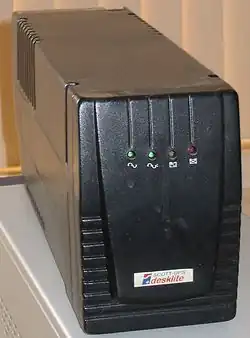
- Electro-hydraulic actuator — In 1959, FANUC developed the first electrohydraulic pulse motor.[332]
- Permanent fuse — Introduced by Mitsubishi Electric in 1969.[248]
- Piezoelectric ceramics (PCM) — Developed by Matsushita Electric in 1966.[437]
- Self-powered automatic faucet — The INAX Automage (1990) was the first automatic faucet with a self-powered energy harvesting system.[519]
- Micro Piezo — In 1993, Epson's Epson Stylus 800 inkjet printer and Epson MJ-500 inkjet cartridge introduced Micro Piezo technology using piezoelectric crystals.[433]
- Self-holding reed switch — In 1971, Fujitsu introduced the first practical application of self‑holding reed switches.[293]
- Uninterruptible power supply (UPS) — In the early 1950s, Fuji Electric developed an early UPS, demonstrated in 1954.[522]
- Microprocessor-based numerical relay — Introduced by Toshiba in 1980.[110]
- Vector-control inverter — Introduced by Toshiba in 1979.[110]
Batteries
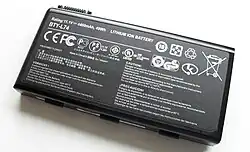
- Dry cell battery — In 1885, Sakizō Yai invented the world's first dry cell battery in Meiji era Japan and founded Yai Dry Battery Limited Partnership Company.[523]
- Lithium-ion battery — Akira Yoshino's team at Asahi Kasei invented the modern lithium‑ion battery in 1985. Sony commercialized the technology in 1990.[524]
- Solar battery — In 1984, Shunpei Yamazaki's Semiconductor Energy Laboratory (SEL) developed the first solar battery using a laser scribing method.[525]
Lighting
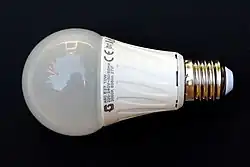
- Blue LED lighting — Invented by Shuji Nakamura and commercialized by Nichia in 1994.[526]
- Double-coil bulb — Invented by Junichi Miura of Hakunetsusha (Toshiba) in 1921 using a coiled coil tungsten filament. They began mass-producing coiled coil filaments by 1936.[110]
- Compact fluorescent bulb — Toshiba began development after the 1973 oil crisis and had a trial run in 1978, before commercially releasing it as the "Neo Ball" in 1980.[110]
- White LED lighting — Developed by Yoshinori Shimizu's team at Nichia in 1995.[527]
Nuclear power
.jpg)
- Nuclear power — In 1934, Hikosaka Tadayoshi proposed the huge energy in atomic nuclei could be used to produce nuclear power generation as well as nuclear weapons.[528]
- Magic number (physics) — Proposed by Hikosaka Tadayoshi in 1934.[291]
- Nuclear shell model — Proposed by Hikosaka Tadayoshi in 1934.[529]
- Nuclear reaction with particle accelerator — In 1934, Seishi Kikuchi demonstrated nuclear reactions using an accelerator.[529]
- Nuclear pile — In 1941, Hikosaka Tadayoshi proposed a pile-type nuclear reactor.[529]
- Fast breeder reactor — Proposed by Hikosaka Tadayoshi in 1944.[529]
- Advanced boiling water reactor (ABWR) — Developed by Hitachi, Toshiba and GE Hitachi. In 1996, the first ABWR entered commercial operation in Japan.[110]
- Ultra-supercritical steam generator — In 1989, Toshiba developed the first large-capacity ultra‑supercritical pressure steam turbine.[110]
- Uranium-238 nuclear fission (U238) — In 1941, Hikosaka Tadayoshi reported the chain reaction of uranium fission caused by fast neutrons, noting the fatal factor which breaks the chain reaction is the resonance absorption of neutrons by U238.[529]
Solar power

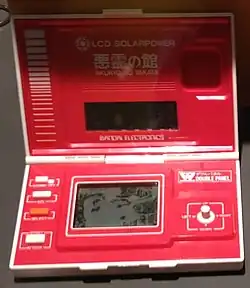
- Bifacial solar cell (BSC) — BFC solar cell was first proposed by Hiroshi Mori in 1960 while working for Hayakawa Denki Kogyo Kabushiki Kaisha (Sharp Corporation).[530]
- Floating solar — The first floating solar installation was built in 2007 by the National Institute of Advanced Industrial Science and Technology (AIST) in Aichi.[531]
- Perovskite solar cell (PSC) — Invented by Tsutomu Miyasaka, Akihiro Kojima, Kenjiro Teshima and Yasuo Shirai in 2009.[532]
- Solar car racing — In 1987, Shunpei Yamazaki's Semiconductor Energy Laboratory (SEL) participated in the first World Solar Challenge (WSC).[525]
- Solar ventilation — The Mazda Sentia (Mazda 929) car, released in 1991, introduced a solar ventilation system using solar cells in the sunroof.[533]
- Solar powered ships — The Auriga Leader (2008) by Nippon Yusen and Nippon Oil was the first electric ship powered by photovoltaic solar cells.[534]
- Solar module — Between 1959 and early 1963, Sharp Corporation developed the first commercial solar module.[96]
- Solar-powered buoy — In May 1963, solar modules were first commercially used for a marine application, a solar-powered lighted buoy at Yokohama Port.[96]
- Solar-powered calculator — The Sharp EL-8026 Sunman (1976) was the first solar-powered electronic calculator, using solar cell technology.[329]
- Solar powered camera — The first fully solar-powered camera was the Sure Shot Del Sol (1995) point-and-shoot camera by Canon Inc.[223]
- Solar-powered electronic game — Kōsenjū SP (1970), a light gun developed by Nintendo and Sharp, was the first electronic game device using solar cell technology.[535]
- Solar-powered video game system — The Bandai LCD Solarpower (1982) handheld game system was the first solar‑powered video game device.[475]
- Solar-powered watch (light-powered watch) — Citizen Watch Crystron Solar Cell (1976) was the first quartz watch powered by solar cell technology. Citizen Watch Eco-Drive (1995) was the first Ecomark certified watch.[486]
- Space-based solar power — JAXA announced in March 2015 that they wirelessly beamed 1.8 kilowatts about 50 meters to a small receiver by converting between electricity and microwaves.[536]
Games
- Capsule toy
- Hanafuda
- Modelguns — Japan's Model Gun Collection, founded in 1959, was the first manufacturer of modelguns, which they debuted in 1962.[537]
- Model robot
- Pachinko — Pachinko machines were first built during the 1920s as a children's toy called the Corinth game.[538]
- Rock paper scissors — Jan-ken, a 17th century Japanese variation of Chinese ken games, introduced the modern moves of rock, paper and scissors.[539]
- Shiritori
Board games
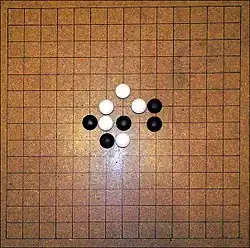
- Go (modern rules) — Though the game originated in China, free opening of the game as it is played globally began in the 16th century Japan.
- Gomoku — Historical records indicate the origins of gomoku can be traced back to the mid-1700s during the Edo period. By 1850, books had been published on gomoku.[540]
- Renju — A professional variant of gomoku. It was named renju by journalist Ruikou Kuroiwa in 1899.[541]
- Replays — Created by Group SNE with Record of Lodoss War (1986).[542]
- 2d6 System — Created by Group SNE for Sword World RPG (1989), one of the most successful tabletop role-playing games in Japan.[542]
- Shogi
Electro-mechanical
- Audio-visual novelty game — Electro-mechanical (EM) arcade game genre originating from Japan, pioneered by Periscope (1965) from Namco and Sega.[543]
- Virtual world — Introduced by Periscope (1965).[544]
- Visual effects — Introduced by Periscope (1965).[545]
- Image projection — EM games with rear image projection on a screen were introduced in 1968 with Sega's Duck Hunt and Kasco's Indy 500.[546]
- Character animation — Sega's Duck Hunt (1968) introduced the projection of animated moving targets on a screen.[547]
- Bonus points — Dates back to Sega's Duck Hunt (1968). It awarded a higher score of 15 points for a head shot, whereas a standard body shot earned 10 points.[548]
- Car combat — The concept of ramming cars dates back to Sega's Stunt Car (1970) and Dodgem Crazy (1972). They reversed racing game conventions by making vehicle collisions the objective of the gameplay.[549]
- Block breaker — In Sega's Stunt Car (1970), the car is used as a kicker to launch balls into holes on the playfield, anticipating the gameplay of Breakout (1976).[550]
- Cockpit arcade cabinet — In 1970, Kasco's Indy 500 (F-type) introduced a sit-down cockpit arcade cabinet.[551]
- Cooperative gameplay (co-op) — Periscope (1965) was both a single-player game and a three-player co-op game.[552]
- First-person light gun shooter — Sega's Duck Hunt (1968) was the first shooter game to project first-person graphics on a screen.[548]
- Headshot — The concept dates back to Sega's Duck Hunt (1968). The game awarded the player a higher score for a head shot, earning 15 points, whereas a standard body shot earned 10 points.[548]
- First-person shooter (FPS) — Sega's Jet Rocket (1970) was the earliest FPS, with free-roaming first-person movement and shooting. Sega expanded its FPS gameplay with Heli‑Shooter (1977) using microprocessor technology.[554]
- First-person racing game — Kasco's arcade racer Indy 500 (1968) introduced pseudo-3D graphics projected using mirrors to give a first-person perspective on a screen.[555]
- Full-motion video (FMV) — Nintendo's EM arcade game Wild Gunman (1974), published by Sega in North America, was the first FMV game.[556]
- Live-action FMV — Wild Gunman (1974) was the first game to use live-action video footage, using actors who portrayed cowboy characters.[557]
- Adult game — The first erotic game was Nintendo's FMV arcade game Fascination (1974).[558]
- Female character — Nintendo's FMV arcade game Fascination (1974) featured the earliest female character in an electronic game, portrayed by a live-action Swedish model.[558]
- Family fun center — Modern family fun centers appeared in Japan during the late 1960s, notably arcades operated by Sega.[559]
- Handheld electronic game — Waco's Electronic Tic-Tac-Toe (1972) is commonly cited as the first commercial handheld electronic game.[560]
.jpg)
- Head-to-head shooting — Sega's Gun Fight (1969) introduced competitive head-to-head shooting between two players, inspiring several early shooter video games.[561]
- Interactive movie game (cinematic game) — Nintendo's Wild Gunman (1974) was the first interactive movie game.[562]
- Interactive storytelling — Wild Gunman (1974) was the first game with interactive storytelling. Alternate FMV scenes are presented depending on user action.[562]
- Medal game — Medal games began in Japan during the early 1970s and started becoming popular with Sega's Harness Racing (1974).[563]
- Ninja game — The earliest ninja game was Kasco's EM arcade shooter game Ninja Gun (1977).[564]
- Open world — Sega's Jet Rocket (1970) is considered the earliest open world game, which Sega expanded with Heli‑Shooter (1977) using microprocessor technology.[554]
- Pseudo-3D — Pseudo-3D effects date back to Periscope (1965) by Namco and Sega.[565]
- Quick time event (QTE) — Nintendo's electro-mechanical arcade game Wild Gunman (1974) featured the earliest quick time events (QTE).[567]
- Submarine simulator — Periscope (1965) was the earliest submarine simulator, using lights and plastic waves to simulate sinking ships from a submarine.[568]
- Flight simulator game — Sega's Jet Rocket (1970), a first-person combat flight simulator, was the first flight simulator game.[569]
- Whac-A-Mole — Between 1974 and 1975, Kazuo Yamada of TOGO invented the first Whac-A-Mole machine.[570]
- Vehicular combat game — Dates back to Periscope (1965).[543]
Game audio

- Chiptune — Taito's arcade video game Space Invaders (1978), designed by Tomohiro Nishikado, had the earliest continuous background music produced from a sound chip.[571]
- Adaptive music — The first example was Space Invaders (1978). Simple background music increased in tempo as time goes on and aliens descend upon the player.[572]
- Melodic chiptune — Nintendo's arcade game Sheriff (1979) had the earliest continuous melodic music produced from a sound chip.[573]
- Digital sample loops — Rally-X (1980), composed by Namco's Toshio Kai, demonstrated the earliest use of digital sample loops.[574]
- Electronic sound effects — Introduced with electro-mechanical (EM) arcade game Periscope (1965) by Namco and Sega.[545]
- Loudspeaker — Periscope (1965) was the first electronic game with sound effects played through a speaker.[550]
- Solid-state electronics — Solid‑state electronic sound dates back to Sega's EM game Duck Hunt (1968).[548]
- Sound volume — Duck Hunt (1968) introduced volume controls for the sound effects.[547]
- Game music — Sega introduced electronic game music with their EM arcade game Jumbo (1969), which used an 8-track player to stream electronic circus music.[575]
- Game music tape loops — Sega introduced tape music loops to arcades with EM games such as Sand Buggy (1972).[576]
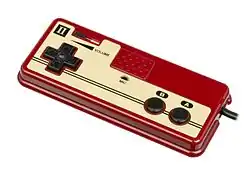
- Microphone game controller — Nintendo's Famicom (1983) introduced the first microphone game controller.[577]
- Pulse-code modulation (PCM) — Namco's arcade game King & Balloon (1980) was the first video game to feature PCM digital samples, using a DAC for voice synthesis.[577]
- Differential PCM (DPCM) — Irem's Moon Patrol (1982) was the earliest video game to use an adaptive DPCM (ADPCM) sound chip, the MSM5205 by Oki Electric.[578]
- Bit Rate Reduction (BRR) — Audio compression format based on ADPCM, introduced with Sony's SPC700 sound chip in the Super Nintendo (1990) game console.[579]
- Rhythm game — In the early 1970s, Kasco created a rhythm-based EM arcade game, designed by Kenzou Furukawa, inspired by the 1969 Oh! Mouretsu commercials.[351]
- Rhythm video game — Dance Aerobics (1987) allowed players to create music by stepping on Nintendo's Power Pad peripheral. It has been called the first rhythm‑action game in retrospect.[580]
- Rhythm game accessories
- Dance pad — The earliest dance pad was Bandai's Power Pad, released for the Nintendo Entertainment System in 1987.[581]
- Musical instrument peripheral — In the late 1990s, Konami's Bemani division invented the first rhythm game peripherals simulating musical instruments.[582]
- Guitar controller — Invented by Konami's Bemani division in 1998 for the arcade game GuitarFreaks.[582]
- Drum kit peripheral — Konami invented a drum kit peripheral for DrumMania (1999).[582]
- Streaming audio — Sega's EM arcade game MotoPolo (1968) introduced an 8-track player unit that plays sounds from endless tape cartridge through a speaker.[583]
- Streaming audio in video games — Nintendo's arcade title EVR Race (1975) was the first video game to stream pre-recorded audio from a video tape.[584]
- Streaming video game music — Sega's Astron Belt, an arcade laserdisc game debuted in 1982 and released in early 1983, was the first video game with streaming music.[585]
- Video game music album (VGM album) — Haruomi Hosono's Video Game Music (1984), featuring arrangements of Namco's arcade game music, was the first VGM album.[586]
- Voice acting — Dates back to Nintendo's EM game Wild Gunman (1974), where the full-motion video (FMV) intro scene has a voiced narrator giving gameplay instructions.[556]
- Video game voice acting — The first video game with voice acting was Nintendo's arcade game EVR Race (1975), streamed from a video tape.[584]
- Speech synthesis — Sunsoft's arcade shooter Stratovox (1980) was the first video game to feature voice synthesis.[587]
- Wavetable synthesis — The Namco WSG (Waveform Sound Generator) was a wavetable synthesis chip introduced in 1980 and used in several arcade system boards including the Namco Pac-Man (1980) and Namco Galaga (1981).[572]
Game consoles
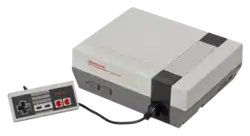
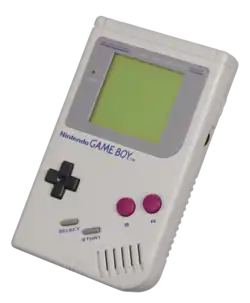
- 8-bit handheld console — Nintendo's Game Boy (1989) was the first handheld game console with an 8-bit CPU.[588]
- Dual-ported video RAM (DP VRAM) — The Sega Mega Drive (1988) was the first console to use DP VRAM.[589]
- Geometry processor — The Sega Saturn (1994) was the first console with a 3D geometry processor.[590]
- Hybrid console — The Sega Nomad (1995) was the first hybrid console.[591]
- Mass storage — The Famicom Disk System (1986) introduced mass disk storage to console gaming, using Mitsumi's Quick Disk format.[592]
- Optical disc drive — NEC's PC Engine CD-ROM, released in November 1988, was the first game console to use CD-ROM as storage media.[593]
- Nintendo — Gunpei Yokoi was the creator of the Game Boy and Virtual Boy, worked on the Famicom or Nintendo Entertainment System (NES), and worked on the Metroid series and Game Boy Pocket.[594]
- Multi-screen display — First appeared with Nintendo's Game & Watch series. The first game in the Multi-Screen series was Oil Panic (1982).[595]
- Cheat code — The first console cheat code was the Konami Code, created in 1986 by Kazuhisa Hashimoto as he worked on porting the 1985 arcade game Gradius for the NES.[596]
- Online console multiplayer — In 1987, Nintendo launched the Family Computer Network System (Famicom Modem) for the Famicom in Japan. Online games for the system included a graphical competitive online multiplayer version of Go.[597]
- Digital purchase — Introduced in 1987 with Nintendo's Japan-only Disk Writer kiosks, which allowed users to purchase and download the latest Famicom Disk System games onto their floppy disks.[598]
- Downloadable content (DLC) — The Sega Meganet service launched for the Japanese Mega Drive in 1990. Phantasy Star II (1989) featured eight Phantasy Star II Adventures for download on Meganet. This was the earliest example of DLC.[599]
- Built-in modem — Sega's Dreamcast, launched in 1998, was the first console with a built-in modem.[600]
- Voice chat in online gaming — Began with the Dreamcast in 1999. Games such as Seaman (1999) and Alien Front Online (2001) included built-in voice chat functionality via the SegaNet online service.[601]
- PlayStation — The first Sony PlayStation was invented by Ken Kutaragi. Research and development for the PlayStation began in 1990, headed by Kutaragi, a Sony engineer.[602]
- Saved game — The Legend of Zelda (1986) for the Famicom Disk System was the first console game with a save feature, using Mitsumi's Quick Disk format.[603]
- Cartridge save — Taito's Mirai Shinwa Jarvas (1987) for the Famicom introduced the concept of saves stored on a battery‑backed static RAM (SRAM) memory chip on the game cartridge.[604]
- Ferroelectric RAM save — Ferroelectric RAM (FRAM) was commercialized in the mid-1990s. Its first high-profile commercial use was by game company Sega, who used FRAM chips to store saves in Sonic the Hedgehog 3 (1994) cartridges.[605]
- Memory card save — SNK's Neo Geo (1990) was the first home game console to feature a removable memory card for saves.[606]
- Touchscreen handheld — In the early 1990s, Sega were planning to release a Game Gear successor with a touchscreen interface. However, touchscreen technology was expensive, so they instead released the Sega Nomad in 1995.[607]
- TV game — The Sharp Nintendo Television (C1 NES TV) is a CRT television with a built-in Famicom that was produced by Sharp Corporation under license from Nintendo. It was originally released for Japan in October 1983 as the My Computer TV.[608]
- Video screen capture — Sharp's Famicom Titler (1989) was a Famicom variant that captured direct game footage from a Famicom game, along with video editing capabilities, keypad and touchpad controls, and microphone audio input.[609]
- Vertical scrolling game console — The first console with vertical scrolling was Nintendo's dedicated console Color TV-Game Racing 112 (1978), a clone of Taito's arcade video game Speed Race (1974).[610]
- Scrolling tiled background — The Famicom (1983) was the first console featuring a graphics chip with hardware support for scrolling tiled backgrounds.[611]
- Virtual reality headset (VR) — The Sega VR headset was an early unreleased VR device with built-in motion tracking, first announced in 1991. Its sensors tracked the player's movement and head position.[612]
Game controllers
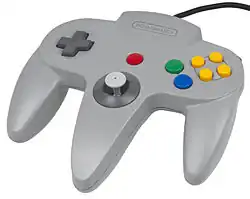
- Analog thumbstick — Introduced by Dempa's XE-1 AP (1989) controller for the Sega Mega Drive and Japanese computers. Popularized by Nintendo 64 controller (1995).[613]

- Cockpit controls — Sega's EM arcade game Jet Rocket (1970) introduced cockpit controls.[547]
- Throttle — Sega's EM arcade game Heli-Shooter (1977) involves the player piloting a helicopter using a throttle joystick to accelerate and decelerate.[614]
- Throttle lever — Sega's arcade video game After Burner II (1987) introduced a throttle lever to accelerate and decelerate the speed.[615]
- D-pad — Developed by Nintendo's Gunpei Yokoi, who developed the modern "cross" design for the Donkey Kong (1982) Game & Watch handheld game.[616]
- Directional buttons — Sega's arcade electro-mechanical game Missile (1969) had two directional buttons are used to move a motorized tank.[617]
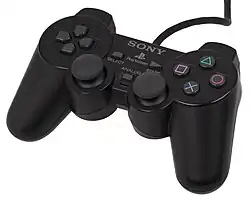
- Dual control — Sega's EM game Missile (1969) had dual-control scheme, with two directional buttons moving a tank and a joystick used to shoot and steer the missile.[617]
- Twin-stick shooter — Introduced with Taito's Western Gun (1975), which used one joystick for movement and a second for firing.[618]
- Dual analog control — Sony's Dual Analog and DualShock controllers in 1997 introduced two analog sticks, for which Sony won an Emmy Award.[619]
- Fire button — The EM arcade game Periscope (1965) by Namco and Sega was the earliest game with a firing button.[565]
- Force feedback — Sega's arcade motorbike game Man T.T. (1976), also known as Fonz, was the first game using haptic technology for vibrating collisions.[543]
- Gamepad (joypad) — Introduced by Nintendo with the D-pad controller for the Donkey Kong Game & Watch handheld (1982) and the NES controller (1983).[620]
- Shoulder buttons and grip handles — Introduced by Dempa's XE-1 AP (1989) controller for the Sega Mega Drive console and Japanese computers.[613]
- Joystick — Sega's EM arcade game MotoPolo, released in early 1968, introduced joystick controllers, used to move miniature motorbikes in any direction on the table.[621]
- Analog joystick — Introduced by Sega's MotoPolo (1968). Joysticks used analog magnetic lever technology to move miniature motorbikes in any direction.[621]
- Joystick with fire button — First game to use a joystick with fire button was Sega's Missile (1969), which used a joystick to shoot and steer the missile.[617]
- Analog flight stick — Developed by Sega's Yu Suzuki for arcade game Space Harrier (1985). It could register movement in any direction as well as the degree of push.[622]
- Rotary joystick — Joystick–knob hybrid, which moves like a joystick and rotates like a knob, such as for movement and aiming. Introduced by SNK's TNK III (1985) and Ikari Warriors (1986).[623]
- Light gun toy — Nintendo introduced a light gun toy to the home market with the Kōsenjū SP (Beam Gun) in 1970. The gun was developed by Nintendo's Gunpei Yokoi with Sharp's Masayuki Uemura.[535]
- Light gun video game controller — The first video game light gun, released for the Magnavox Odyssey console in 1972, was designed and manufactured by Nintendo, based on their earlier Kōsenjū SP light gun.[624]
- Hands-free head-mounted display with head tracking and voice command — The first such device was Konami's LaserScope (1990) for the NES console. It supported all NES Zapper light gun games.[625]
- Laser sight — Konami's LaserScope (1990) for the NES was the first game controller to use laser sight technology.[626]
- Motion controller — Sega's arcade boxing game Heavyweight Champ (1985) featured the first motion-based controllers.[627]
- Full-body motion control — Invented by Yu Suzuki for Sega's arcade motorbike racing game Hang-On (1985).[628]
- Motion-sensing controller — Invented by Nintendo for the Wii, the Wii Remote was the first controller with motion sensing capability. It was a candidate for Time magazine's Best Invention of 2006.[629]
- Motion simulator — The first hydraulic motion simulator arcade cabinets were developed by Sega for the arcade games Space Tactics (1981), Hang-On (1985) and Space Harrier (1985).[630]
- Gyroscope — Sega's R360 cabinet, debuted with the arcade game G-LOC: Air Battle (1990), introduced the use of gyroscope technology for the first 360-degree motion simulator experience.[631]
- Periscope — Periscope (1965) by Namco and Sega introduced a new controller in the form of a periscope viewer. Its periscope viewer arcade cabinet design was later adopted by several arcade video games.[632]
- Positional gun — Earliest example of a positional gun was used for Sega's EM arcade gun game Sea Devil (1972).[633]
- Racing wheel with accelerator pedal — Kasco's EM game Indy 500 (1968) featured a steering wheel along with an accelerator pedal.[634]
- Handheld racing wheel — Tomy's Demon Driver (1978) and Turnin' Turbo Dashboard (1983) were the first handheld games with racing wheels.[475]
- Touch control — In 1985, the Sega Graphic Board for the SG-1000 and SC-3000 was a touch tablet with stylus pen, used for the drawing game Terebi Oekaki.[635]
- Touchpad — In 1986, the Sega AI Computer had a touchpad, mainly used for educational games.[636]
- Trackball control — The earliest use of trackball controls in a video game was Sega's arcade football/soccer game World Cup, released in March 1978.[637]
Sports

- Air hockey — Sega's electro-mechanical (EM) arcade game MotoPolo (1968) anticipated air hockey gameplay.[583]
- Motorbike electronic sports game — Sega's MotoPolo (1968) was the first electronic sports game featuring motorbikes.[638]
- Formula One electronic game — Namco's EM arcade games Formula-X (1973) and F-1 (1976) were the first Formula One electronic games.[639]
- Bowlingo — Capcom's Bowlingo (1990) was a coin-operated, electro-mechanical, automated mini ten-pin bowling installation, smaller than a standard bowling alley.[640]
- Airsoft — Airsoft originated in Japan, then spread to Hong Kong and China in the late 1970s.[641]
- Airsoft gun — The inventor of the first airsoft gun was Tanio Kobayashi in the 1970s.[642]
- Association football video game — Tomohiro Nishikado's arcade video game Soccer (1973) was the first association football (soccer) sports video game.[643]
- Basketball video game — Tomohiro Nishikado's arcade title TV Basketball (1974) was the first basketball video game.[644]
- Skiing sports video game — Taito's arcade title Alpine Ski (1981) was the first skiing video game.[645]
- Olympic video game — Konami's arcade title Track & Field (1983) was the first officially licensed video game based on the Olympic Games.[646]
- Rugby video game — Data East's Scrum Try (1984) for arcade DECO Cassette System was the first rugby video game.[647]
- Combat sports video game — Sega's arcade video game Heavyweight Champ (1976) was the first boxing video game and the first combat sports video game.[648]
- Wrestling video game — Technōs Japan's arcade title Tag Team Wrestling (1983) was the first wrestling video game.[649]
- Sumo video game — Technōs Japan's arcade title Shusse Ōzumō (1984) was the earliest sumo video game.[650]
.jpg)
- Drifting — Kunimitsu Takahashi created drifting techniques in the 1970s.[651]
- Drifting competition — In 1988, Keiichi Tsuchiya and Option magazine founder Daijiro Inada organised the first contest specifically for sliding a car sideways.[652]
- Ekiden (road relay)
- Esports — Has arcade roots dating back to 1974, with Sega's All Japan TV Game Championships, a nationwide tournament in Japan.[653]
- Gateball
- Instant replay — From 1957, NHK began instant replay broadcasts of sumo wrestling events. Due to matches being short, broadcasters would quickly rewind the video tape after a match to replay the contest.[654]
- HDTV sports broadcasting — The 1984 Summer Olympics, where NHK shot some of the events in HD video, was the first sporting event broadcast on HDTV.[220]
- 3D TV sports broadcasting — In the 1998 Nagano Olympics, some sporting events were filmed for 3D HDTV.[465]
- VOD sports broadcasting — The 1998 Nagano Olympics included the first video-on-demand (VOD) sports coverage.[465]
- Bullet time instant replay — Takeo Kanade developed a multi-camera instant replay system for CBS that produced a bullet time effect during replays. The system was demonstrated during a Super Bowl 2001 broadcast on CBS.[655]
- Keirin — Started as a gambling sport in 1948 and became an Olympic sport in 2000.
- Sports animation — Animal Olympic Games, a 1928 animated short film directed by Yasuji Murata, was the first sports anime.[656]
- Sports comic — The judo manga series Igaguri-kun by Eiichi Fukui, first published in the manga magazine Bōken'ō in 1952, was the first sports manga series.[657]
Video games
- 16-bit video game system — Universal's arcade video game Get A Way (1978) was the earliest game with a 16-bit CPU.[658]
- 3D polygon graphics (pre-rendered) — Funai's arcade laserdisc game Interstellar, debuted in September 1983, introduced pre-rendered 3D polygon graphics.[659]
- Real-time 3D computer graphics — Technosoft's racing game Plazma Line (1984) was the first computer game with real‑time 3D polygon graphics.[660]
- 3D polygon human character — Arsys Software's Star Cruiser (1988) featured the earliest human 3D polygon non-player character (NPC), named Sakai Daigo.[661]
- 3D character physics — Sega AM2's Virtua Fighter (1993) introduced a 3D physics engine for the game's human 3D polygon player characters.[662]
- 3D texture mapping — Namco's SimDrive (SimRoad) for the Namco System 22, with a limited 1992 release, introduced 3D texture mapping.[663]
- Texture filtering — The Sega Model 2 arcade system introduced the use of 3D texture filtering with Daytona USA (1993).[664]
- Texture-mapped characters — Sega AM2's Virtua Fighter 2 (1994) introduced texture‑mapped 3D player characters.[665]
- 6-player video game — Dates back to Taito's arcade racing game Dead Heat (1975).[376]
- Action role-playing game (ARPG) — Nihon Falcom's Panorama Toh (1983) is considered to be the first ARPG.[666]
- Role-playing shooter (RPS) — Panorama Toh (1983) was the first ARPG with shooter game elements.[666]
- Activity-based progression — Nihon Falcom's Xanadu: Dragon Slayer II (1985) was the earliest role-playing video game where individual stats increase based on activity levels.[667]
- Morality meter — Xanadu: Dragon Slayer II (1985) featured a Karma meter, which affects the temple's reaction.[667]
- Soulslike — A subgenre of ARPG and action-adventure games that originate from FromSoftware's Demon's Souls in 2009.[668]
- Adult video game — The first erotic video game was Hudson Soft's Yakyūken (1981) for the Sharp MZ-80K computer.[558]
- Dating sim — Dating sims date back to Koei's Night Life (1982).[669]
- Gal game — The first bishōjo game was Koei's Night Life (1982).[670]
- Alien invasion — Space Invaders (1978) was the first video game to depict aliens.[671]
- Arcade conversion — Kasco's Playtron (1973) had an early prototype arcade system board that supported interchangeable games.[351]
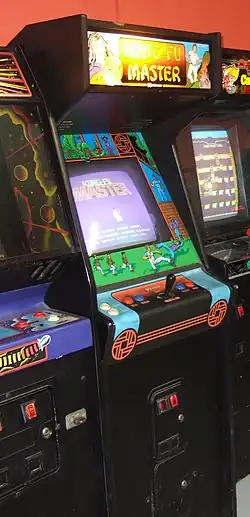
- Beat 'em up — In 1984, Irem's Kung-Fu Master laid the foundations for scrolling beat 'em ups with its hand-to-hand combat against multiple enemies.[672]
- Belt scrolling— Introduced by Technōs Japan with Nekketsu Kōha Kunio-kun (1986) and Double Dragon (1987).[672]
- Bonus stage — The first bonus stage in video game history is in Rally-X, released by Namco in 1980. This became a signature feature of other arcade games.[673]
- Boss battle in real-time — Sega's Samurai (released March 1980) had the player samurai fight a number of swordsmen before confronting a powerful boss samurai.[674]
- Multiple bosses — SNK's Sasuke vs. Commander, released in October 1980, is the earliest game with multiple boss encounters.[675]
- Final boss — In Taito's Phoenix, released in December 1980, the player's ship must fight a giant mothership boss in the final level.[676]
- Sub-boss — In Irem's Kung-Fu Master (1984), end-of-level sub-bosses are followed by the final boss on the top level.[677]
- Boss rush — Sega's Fantasy Zone (1986) popularized the concept of a boss rush, a stage where players face multiple previous bosses again in succession.[678]
- Branching storylines — The Portopia Serial Murder Case (1983) introduced non-linear branching storylines, presenting different scenarios in response to player actions.[679]
- Multiple endings — The Portopia Serial Murder Case (1983) introduced alternate endings, considered "way ahead of its time".[680]
- Breaking the fourth wall — Hideo Kojima's Metal Gear (1987) featured the earliest video game narrative to break the fourth wall.[681]
- Camera change button — Introduced in 1991 by MNM Software's Japan-exclusive Sharp X68000 games Magical Shot and Star Wars: Attack on the Death Star.[682]
- Free-floating camera — Nintendo EAD's Super Mario 64 (1996) introduced a free-floating camera that can be controlled independently of the character.[683]
- Character action game — Genre was established by Namco's Pac-Man (1980).[684]
- Hack and slash — In Sega's action game Samurai (1980), the player samurai swordsman must fight a number of other swordsmen.[674]
- Reactive AI — The ghosts in Pac-Man (1980) were early examples of enemy AI that react to the player's choices.[684]
- Climbing — Nichibutsu's arcade game Crazy Climber (1980) was the first climbing game.[685]
- Combo — Data East's arcade DECO Cassette System game Flash Boy (1981), a scrolling action game, had the earliest combo mechanic. When the player punches an enemy and it explodes, debris can destroy other enemies.[686]
- Combo system — The first fighting game with a combo system was Culture Brain's Shanghai Kid (1985), with "rush" attacks similar to custom combos in Street Fighter Alpha 2 (1996).[687]
- Super combo — Introduced by SNK's Art of Fighting (1992).[688]
- Command menu — Yuji Horii's The Hokkaido Serial Murder Case: The Okhotsk Disappearance (1984) introduced a command menu system.[679]
- Branching menu — The 1985 NES port of The Portopia Serial Murder Case has branching menu selections.[689]
- Color vector graphics — The Sega G80 arcade system, launched in 1981, possessed the world's first color vector X-Y video system.[690]
- Co-op action video game — Sega's arcade light gun shooter Balloon Gun (1974) was the earliest co-op action video game.[691]
- Cover system — In Tomohiro Nishikado's Western Gun (1975), the player characters could take cover behind destructible objects.[618]
- Cover button — Namco's 1995 3D light gun shooter arcade game Time Crisis introduced a dedicated cover button, specifically an "action" foot pedal, that could be used to take cover behind in-game objects.[692]
- Cutscene — Taito's Space Invaders Part II (1979) introduced cutscenes as brief comical intermissions between levels.[673]
- Narrative cutscene — The first video game with storytelling cutscenes was Nintendo's Sheriff (1979).[693]
- Quick time event cutscene (QTE) — Sega's Die Hard Arcade (1996) introduced QTEs in the modern form of cutscene interludes in an otherwise interactive game.[694]
- Destructible object — Destructible objects were introduced by Tomohiro Nishikado's Western Gun (1975).[618]
- Destructible environment — Namco's Dig Dug (1982) was the first game with a fully destructible environment.[695]
- Dialogue tree — Introduced by Yuji Horii's The Portopia Serial Murder Case (1983), with branching dialogue choices considered "way ahead of its time".[680]
- Difficulty level — Dates back to Tomohiro Nishikado's Speed Race (1974).[696]
- Difficulty curve — The concept was accidentally invented by Tomohiro Nishikado when he created Space Invaders (1978).[697]
- Dynamic difficulty — Pioneered by Space Invaders (1978).[698]
- Enemy horde — Space Invaders (1978) was the first video game where a player had to repel hordes of hostile enemies.[699]
- It's not a bug, it's a feature — The earliest example of this in video games is Space Invaders (1978), where the gradually increasing speed and difficulty was originally an accident.[700]
- Risk and reward — Pioneered by Space Invaders (1978).[701]
- Digitized character sprite — Magical Company's 2D arcade fighting game Last Apostle Puppet Show (1988) was the first game to feature fully digitized character sprites.[702]
- Drifting mechanic — Introduced by Sega's Out Run (1986). The mechanic incorporates AI assistance and details such as, if the car's tires grip the road surface too closely, the car's handling becomes too twitchy.[703]
- Farm life sim — The genre began with the SNES game Harvest Moon (1996).[704]
- Female video game character — In Nintendo's arcade game Sheriff (1979), the non-player character Betty was the earliest female character in a video game.[573]
- Damsel in distress — Betty from Nintendo's Sheriff (1979) was the first damsel-in-distress to appear in a video game.[693]
- Female protagonist — Hiroshi Suzuki's stealth game Manbiki Shōjo (Shoplighting Girl), released for the PET 2001 in 1980, was the earliest video game with a female player character. It was a sequel to 1979's Manbiki Shōnen (Shoplighting Boy).[705]

- Fighting game — Sega's Heavyweight Champ (1976) was the first video game with fist fighting. Technōs Japan's Karate Champ (1984) established the fighting game genre.[706]
- Tag team — Technōs Japan's arcade title Tag Team Wrestling (1983) was the first video game with a tag team game mechanic.[707]
- Special move — Introduced by Karate Champ (1984).[688]
- Platform fighter — Namco's The Outfoxies (1994) originated the concept of platform fighters. The subgenre was later defined by Nintendo's Super Smash Bros. (1999).[708]
- First-person shooter video game (FPS) — Tomohiro Nishikado's Interceptor (1975) was the earliest commercial first-person shooter (FPS) video game.[709]
- Sniper rifle — Vic Tokai's Golgo 13: Top Secret Episode (1988) was the first video game with a sniper rifle.[707]
- Strafing — Arsys Software's Star Cruiser (1988) was the earliest FPS with strafing controls, considered ahead of its time.[710]
- Flight simulator video game — Tomohiro Nishikado's arcade game Interceptor (1975) was a crude early first-person combat flight simulator video game.[711]
- Train simulator — The first train video game was Sega's arcade title Super Locomotive (1982).[712]
- FMV video game — Nintendo's EVR Race (1975) played full-motion video (FMV) anime scenes from an Electronic Video Recording (EVR) video tape on a CRT display.[713]
- FMV cutscene — Data East's laserdisc video game Bega's Battle (1983) introduced animated FMV cutscenes with voice acting to develop a story between the game's shooting stages.[585]
- Gouraud shading — Namco's SimDrive (SimRoad) for the Namco System 22, with a limited release in 1992, introduced Gouraud shading.[714]
- Phong shading — The Sega Hikaru arcade system introduced Phong shading, with the system's debut title Brave Firefighters (1999). Space Channel 5 (1999) for the Sega Dreamcast was the first home console game with limited Phong shading.[715]
- High score — Defined by Taito's Space Invaders (1978), with high scores determined by playing to stay alive for as long as possible, as scores keep rising.[716]
- Save data — The first game to save the player's high score was Space Invaders (1978).[717]
- Horror game — Early forerunners date back to the survival scenarios in Space Invaders (1978) and Pac-Man (1980).[718]
- Survival horror — The earliest survival horror was AX-2: Uchū Yusōsen Nostromo, developed by Akira Takiguchi for the PET 2001 and PC-6001 in 1981. The genre was later named and defined by Capcom's Resident Evil (1996).[719]
- Psychological horror game — Capcom's Sweet Home (1989) was the earliest psychological horror game, based on the 1989 Japanese film of the same name.[720]
- Fast zombie — Originates from 1990s Japanese horror games. Resident Evil (1996) featured zombie dogs that run towards the player. The House of the Dead (1996) introduced running human zombies who run towards the player, jump and swim.[721]
- Zombie dog — Resident Evil (1996) was the first video game with zombie dogs, popularizing the concept in mass media.[721]
- Zombie virus — Resident Evil (1996) gave realistic scientific explanations for zombie origins, such as biological weaponry, genetic manipulation, and parasitic symbiosis. This became the standard approach for explaining zombie origins.[722]
- Human combat — Tomohiro Nishikado's arcade title Western Gun (1975) was the first video game to depict human-to-human combat.[723]
- Violent video game — Western Gun was the first video game to depict human violence.[723]
- Western video game — Western Gun was the first Western genre video game.[724]
- Invisible wall — Invented by Konami and patented in 1996.[725]
- Japanese role-playing game (JRPG) — Koei's The Dragon and Princess (1982), released for the PC-88 and FM-7 computers, was the first role-playing video game (RPG) made in Japan.[726]
- Tactical RPG (strategy RPG) — The Dragon and Princess (1982) laid the foundations for the tactical RPG genre, with a tactical turn‑based battle system.[726]
- Critical hit — The concept of critical hits was introduced to video games with the 1986 JRPG title Dragon Quest.[727]
- Steampunk video game — Squaresoft's Final Fantasy (1987) was the earliest steampunk video game, influenced by Hayao Miyazaki.[728]
- Active Time Battle (ATB) — Hiroyuki Ito introduced the ATB system in Final Fantasy IV (1991).[729]
- Pausable real-time — The earliest example of pausable real-time combat was ELF Corporation's Knights of Xentar (1991).[730]
- Jumping — First appeared in Tomohiro Nishikado's arcade game TV Basketball (1974).[731]
- Double jump (game mechanic) — Namco's arcade game Dragon Buster (1984) originated the double jump mechanic.[732]
- Wall jump — First appeared in UPL's arcade game Ninja-Kid II (1987).[733]
- Triple jump (game mechanic) — First appeared in Exact's Geograph Seal (1994) for the Sharp X68000.[734]
- Optical disc video game — The first video game to use optical disc technology was Sega's arcade laserdisc game Astron Belt, which debuted in 1982.[735]
- CD-ROM video game — The first CD-ROM games released were Fighting Street and No-Ri-Ko for the PC Engine CD-ROM in 1988. In 1987, there were PC Engine CD-ROM demos of Tengai Makyō: Ziria, Odori Koen Satsujin Jiken and CD Zoo.[736]
- AAA game — Tengai Makyō II: Manji Maru (1992) for the PC Engine was the first AAA game production on CD-ROM.[737]
- Last man standing — The earliest last-man-standing video game with a shrinking play zone was Hudson Soft's 1983 action game Bomberman.[738]
- Battle royale game (BR) — Bomberman (1990) is considered the first battle royale game.[738]
- Levels — Tomohiro Nishikado's Space Invaders (1978) introduced the "concept of going round after round".[739]
- Multiple distinct levels — Dates back to Nintendo's Sheriff (1979), which features nine distinct stages.[558]
- Lives — Taito's classic arcade video game Space Invaders (1978) is credited with introducing multiple lives to video games.[740]
- Energy shield — SNK's arcade shoot 'em up game Ozma Wars (1979) introduced an energy supply represented numerically that depletes when taking hits.[707]
- Health meter — Data East's Flash Boy (1981) for the DECO Cassette System introduced an energy bar.[686]
- Health meter regeneration — Nintendo's Punch-Out, developed in 1983 and released in 1984, introduced a stamina meter that replenishes when the player strikes the opponent.[741]
- Maze chase — Heiankyo Alien (1979) was an early maze chase game predating Namco's Pac-Man (1980), which established the maze chase genre and spawning many imitations.[742]
- Microtransaction — Double Dragon 3: The Rosetta Stone (1990) arcade game introduced shops where coins purchase upgrades, power-ups, health, weapons, moves and characters.[743]
- Monster-taming game — Namco's Gaplus (1984) introduced a tractor beam that allows the player to capture alien enemies and turn them into useful allies.[707]
- Motion capture — In Magical Company's arcade fighting game Last Apostle Puppet Show (1988), an early form of motion capture was used to animate the 2D digitized sprites.[702]
- Passive optical motion capture — Namco's arcade fighting game Soul Edge (1995) was the first video game to use passive optical motion-capture technology.[744]
- Motorcycle video game — Sega's Man T.T. (1976), later re-branded as Fonz, was the earliest racing video game featuring motorcycles.[543]
- Licensed game — Sega's Fonz (1976) was the first video game to license a television character.[745]
- Multi-directional shooter — Taito's Western Gun (1975) laid the foundations for the multi-directional shooter genre.[746]
- Named character — In Nintendo's arcade game Sheriff (1979), the player character Mr. Jack and non-player character Betty were the earliest video game characters with names.[693]
- Video game mascot — Pac-Man (1980) is recognized as the first video game mascot.[644]
- Ninja video games — The earliest ninja video game was SNK's arcade shooter Sasuke vs. Commander (1980).[747]
- Online graphical multiplayer — LINKS, a Japanese online network for the MSX launched in 1986, featured early graphical online multiplayer games: T&E Soft's Daiva Dr. Amandora and Super Laydock, Telenet's Girly Block, and Bothtec's Dires.[748]
- Open world video game — Tomohiro Nishikado's Western Gun (1975) is considered to be the earliest rudimentary open world video game.[749]
- Mini-map — The first video game with a radar mini-map was Namco's arcade game Rally-X (1980).[750]
- Overworld — The arcade game Route-16 (1981) by Sun Electronics was the earliest game with an overworld. Exiting a maze takes the player to a large overworld map, from where they could enter various buildings.[751]
- Hub world — Sega's 1981 arcade game 005 was the first game with a hub world.[569]
- Day-night cycle — Nihon Falcom's computer game Panorama Toh (1983) introduced an open world with day-night cycles.[666]
- NPC schedule — Konami's Castlevania II: Simon's Quest (1987) introduced a day-night cycle where non-player characters (NPC) appear in certain locations depending on the time of day.[752]
- Open-world graphic adventure — Yuji Horii's The Portopia Serial Murder Case (1983) was the earliest open world graphic adventure game.[680]
- Point-and-click — Legends of Star Arthur: Planet Mephius, released by T&E Soft in July 1983, introduced a point-and-click interface using a cursor to interact with objects.[753]
- Visual novel (VN) — A type of interactive fiction originating in Japan. The Portopia Serial Murder Case (1983) is credited with defining the genre.[689]
- Platformer — Space Panic (1980) by Universal Entertainment is considered the first platformer. Donkey Kong (1981) by Nintendo's Shigeru Miyamoto was the first platformer that allowed players to jump over obstacles and across gaps.[754]
- Side-scrolling platformer — Alpha Denshi's Jump Bug (1981) was the first platformer with side-scrolling levels.[755]
- Grappling hook — Tokuro Fujiwara's Roc'n Rope (1983) introduced a grappling hook mechanic, later used by 1987 platformers Bionic Commando and Arumana no Kiseki.[756]
- Metroidvania — Brain Breaker (1985) by Enix is considered the first Metroidvania game.[757]
- Power-up — Pac-Man from 1980 is credited as the first video game to feature a power-up mechanic.[707]
- Puzzle video game — Heiankyo Alien (1979) by University of Tokyo's Theoretical Science Group (TSG) was the first puzzle video game.[758]
- Puzzle-platformer — Universal's Space Panic (1980) was the earliest puzzle-platformer.[759]
- Physics game — Nintendo's Gyromite (1985) was an early physics-based puzzle game.[760]
- Racing simulation — The earliest attempt at a racing simulation was Namco's arcade game Pole Position (1982).[761]
- Checkpoint — Namco's Pole Position (1982) was the first game with a checkpoint system.[762]
- Time trial — Pole Position (1982) was the first game to have a qualifying lap before the main race.[762]
- Kart racing game — Sega's arcade game Power Drift featured go-kart racing in 1988.[763]
- Real-time strategy (RTS) — Bokosuka Wars (1983) is considered an early proto-RTS game. Technosoft's Herzog Zwei (1989) for the Sega Mega Drive is considered the first true RTS game.[764]
- Multiplayer online battle arena (MOBA) — The genre originates from Herzog Zwei (1989).[765]
- Shoot 'em up — Space Invaders (1978) is widely considered the first shoot 'em up. Space Invaders pitted the player against multiple enemies descending from the top of the screen at a constantly increasing speed.[766]
- Bullet hell — The bullet hell or danmaku genre began to emerge in the early 1990s. Toaplan's Batsugun (1993) is considered to be the ancestor of the modern bullet hell genre.[767]
- Stealth game — Hiroshi Suzuki's Manbiki Shounen (Shoplifting Boy), released in 1979, was the stealth game. It inspired two stealth games in 1980, Taito's Lupin III and Suzuki's own sequel Manbiki Shoujo (Shoplifting Girl).[768]
- Survival game — Survival scenarios date back to Space Invaders (1978), Pac-Man (1980) and early survival horror.[718] Survival game mechanics were introduced in Nihon Falcom's Panorama Toh (1983).[666]
- Third-person shooter (TPS) — Radar Scope (1979) was the first shooter game with a pseudo-3D third-person perspective.[769]
- Rail shooter — Sega's arcade game Buck Rogers: Planet of Zoom (1982) was an early pseudo-3D third-person rail shooter.[770]
- Over-the-shoulder (OTS) — Resident Evil 4 (2005) redefined the TPS genre with its "over the shoulder" offset camera angles, where the camera is placed directly over the right shoulder and therefore doesn't obscure the action.[771]
- Time travel video game — Dates back to Konami's arcade shoot 'em up game Time Pilot (1982).[378]
Mechanical technology
Printing

- 3D printing — Invented by Hideo Kodama in the 1970s. In 1980, he invented two additive methods for fabricating 3D plastic models with photo-hardening thermoset polymer.[772]
- Automatic photo print washer — In 1951, Noritsu founder Kan'ichi Nishimoto invented an automatic photo print washer by applying the principles behind a water wheel.[773]
- Film processor — Noritsu's RF−20E (1961) black-and-white film processor automated the black-and-white film development process for the first time.[773]
- ISO 400 — Fujifilm's Fujicolor 400 (1976) was the first ISO 400 color print film.[235]
- Minilab — The first minilab, the QSS-1 (Quick Service System 1), was introduced by Noritsu in 1976.[773]
- Digital minilab — Fujifilm's Frontier (1996) was the first digital minilab.[208]
- Color instant-print camera — The Fujifilm FinePix PR21 (1999) was the first digital camera with built-in color printer.[229]
- Compact copier — The Fuji Xerox 2200 (1973) by Fujifilm was the first compact photocopier.[208]
- Fuzzy logic copier — The Canon NP9800 (1990) was the first high-speed photocopier incorporating fuzzy logic.[223]
- Digital printing — Seiko Epson's EP-101 (1968) was the first compact digital printer.[433]
- Electronic printer — The EP-101 (1968) was the first electronic mini-printer.[774]
- Desktop laser printer — An early laser printer was developed in 1975 by Canon Inc. The Canon LBP-10 (1979) was an early desktop printer using a semiconductor laser.[223]
- Laptop computer printer — In 1993, Canon and IBM Japan developed the first laptop notebook computer with built-in printer.[223]
- Game score printing — Sega's arcade electro-mechanical game Duck Hunt (1968) was the first electronic game to print out the player's score.[547]
- Purikura (print club) — Conceived in 1994 by Sasaki Miho for Atlus, which released the first purikira arcade machine with Sega as Print Club in 1995.[45]
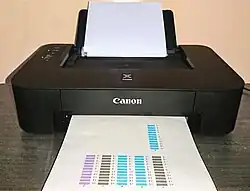
- Inkjet printing — First extensively developed in the early 1950s at Canon Inc. While working at Canon, Ichiro Endo suggested the idea for a bubble jet printer.[775]
- Compact photo printer — In 2001, Canon introduced the first "camera direct" inkjet printer allowing digital pictures to be printed directly from a digital camera.[223]
- Large-format printer with ambient light sensor — The first was Canon's ImagePROGRAF iPF6100 (2007) with an ambient light adjustment function.[223]
- Multi-function printer (MFP) — Canon PC Printer 70 (1984) was a photocopier, printer, computer and monitor. Canon CLC800 (1994) was a photocopier and laser printer.[223]
- All-in-one printer (AIO) — The Inkjet All-in-One MFC-7000FC (1997) by Brother Industries was the first color inkjet AIO printer.[417]
- Outer space color printer — In 1998, the Epson Stylus Color 800 was the first color printer in space, launched on board the Space Shuttle Discovery.[774]
- Printer tracking dots — Developed in the mid-1980s by Canon, Fujifilm and Xerox.[776]
- Screen printing — Screen printing originates from Japanese Ise katagami, in turn influenced by block printing from China.[777]
- Serial impact dot matrix printer — In 1968, Oki introduced the first serial impact dot matrix printer (SIDM), the Oki Wiredot. It supported a character generator for 128 characters with a print matrix of 7 × 5.[778]
- Microcomputer line printer — In 1980, Citizen Watch introduced first microcomputer-controlled line impact printer.[486]
- Thermal transfer printing — The SATO M-2311 (1981) was the first thermal transfer barcode printer.[779]
- IoT label printer — The SATO CL4/6NX (2015) was the first Internet of things (IoT) ready label printing solution.[779]
- Water transfer printing (hydrographics) — Invented in Japan. Taica Corporation claims to have invented cubic printing in 1974. However, the earliest hydrographic patent was filed by Motoyasu Nakanishi of Kabushiki Kaisha Cubic Engineering in 1982.[780]
Robotics

- Android — Waseda University initiated the WABOT project in 1967, and in 1972 completed the WABOT-1. It was the first android.[781]
- Intelligent robot — WABOT-1 (1972) was the world's first full-scale humanoid intelligent robot.[782]
- Actroid — An android visually similar to humans. DER-01 (2003), developed by The Intelligent Robotics Lab in Japan, was the first actroid.[783]
- Bipedal robot — Invented at University of Tokyo in 1967.[784]
- Quadrupedal robot — Invented by Shigeo Hirose in 1978.[785]
- Climbing robots — Invented by Shigeo Hirose in 1979.[785]
- Wall running robot — Developed by Hitachi in 1986.[786]
- Demining robot — Invented by Shigeo Hirose in 1997.[785]
- Cycling robot — Murata Boy, developed by Murata Manufacturing in 2005, was the first robot that could ride a bicycle.[629]
.jpg)
- Giant boarding mecha robot — Kuratas, revealed in 2012, was the first giant boarding robot modelled after the mechs from mecha anime and manga.[787]
- Intelligent robot — In 1970, Hitachi researchers invented an intelligent assembly robot for factory automation. A computer with image processor was used for machine vision.[318]
- Multi-arm robot — In 1977, Nissan and Toshiba developed the first multi-arm robot. It performed the work of four conventional industrial robots, with simultaneous multi-spot welding capabilities.[788]
- Micro robot — NEC's ARMS-D, introduced in 1981, was the first industrial robot with micrometre level precision, enabled by NEC 8085 microprocessor technology.[789]
- Industrial robot with linear motor — NEC's ARMS-D (1981) was the first industrial robot to use linear motors.[789]
- Karakuri puppet — Karakuri puppets (からくり人形, karakuri ningyō) are traditional Japanese mechanized puppets or automata, originally made from the 17th century to the 19th century. The word karakuri means "mechanisms" or "trick".[790]
- Mole robot — In 2001, Nippon Telegraph and Telephone (NTT) developed the first non-soil discharge mole robot, used to install a conduit without excavation.[341]
- Nursing medical robot — The first was RIBA (Robot for Interactive Body Assistance), originally known as Ri-Man, developed by Riken and Tokai Rubber Industries (TRI) in 2006.[629]
- Rehabilitation robotics — Panasonic's Realive, developed in 2006, was the first practical robotic suit designed for rehabilitating stroke patients.[629]
- Robotic exoskeleton for motion support — The first Hybrid Assistive Limb (HAL) prototype was proposed by Yoshiyuki Sankai, a professor at Tsukuba University.[791]
- Robotic sensing electronic tongue — In the mid-2000s, NEC and Mie University invented the first robot with an optical tongue capable of tasting.[629]
- Sensitive skin (electronic device) — In 2013, sensitive electronic skin was developed by a group at the University of Tokyo led by Professor Takao Someya.[792]
- Running humanoid robot — Sony's QRIO (2003) was the first humanoid robot capable of running.[105]
- Swimming humanoid robot — The first was Swumanoid, developed by Motomu Nakashima's team at the Tokyo Institute of Technology between 2007 and 2012.[793]
- Snake robot — Invented by Shigeo Hirose in 1972.[794]
- Spider robot — Invented by Shigeo Hirose in 1976.[794]
- Soft robotics — Shigeo Hirose invented the first soft robotic gripper in 1977.[795]
- Toy robot arm — Tomy's Armatron, introduced in 1982, was the first toy robot arm, moved by dual analog control joysticks. It had a significant influence on the development of modern robotics and artificial intelligence.[796]
- Video game peripheral robot — Nintendo's R.O.B. (1985) was the first robot peripheral for a video game.[760]
- Wind-up toy robot — Lilliput, a Japanese robot introduced in 1932, was the first wind-up toy robot.[797]
Microtechnology

- Avalanche breakdown — Between 1952 and 1953, Junichi Nishizawa discovered the avalanche effect in semiconductors.[798]
- Far infrared terahertz radiation (THz) — Junichi Nishizawa first proposed the concept in 1963 and demonstrated it in 1980.[799]
- Microwave amplification by stimulated emission of radiation (maser) — In 1955, Junichi Nishizawa invented the first solid-state electronic maser.[800]
- Multi-mode optical fiber (MMF) — A type of optical fiber invented by Junichi Nishizawa in 1964.[799]
- Graded-index fiber (GI fiber) — Invented by Nishizawa in 1964.[799]
- Optic crystals — In 1961, Junichi Nishizawa proposed crystal growth using optical energy. In 1963, he demonstrated an optically excited crystal growth method for silicon.[799]
- Oxypnictide — Discovered by a Tokyo Institute of Technology team under Hideo Hosono.[801]
- Parametron — Invented by Eiichi Goto in 1954 as an alternative to the vacuum tube. Early Japanese computers used parametrons until superseded by transistors.[802]
- Quantum flux parametron — Eiichi Goto invented the quantum flux parametron in 1986 using superconducting Josephson junctions on integrated circuits.[802]
- Silicon carbide power semiconductor — Hiroyuki Matsunami pioneered the application of silicon carbide in power electronics.[194]
- Switching circuit theory — From 1934 to 1936, NEC engineer Akira Nakashima introduced switching circuit theory in a series of papers showing that two-valued Boolean algebra can describe the operation of switching circuits.[803]
- Universal Serial Bus (USB) — The USB standard was co-developed by NEC between 1995 and 1996.[804]
Diodes

- Avalanche diode — Junichi Nishizawa invented the avalanche photodiode in 1952 and avalanche injection diode in 1958.[798]
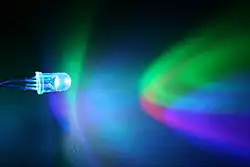
- Green light-emitting diode (green LED) — Developed by Junichi Nishizawa in 1971.[805]
- Blue LED — Between 1988 and 1992, Shuji Nakamura invented the first efficient blue LED, building on the earlier work of Isamu Akasaki and Hiroshi Amano.[806]
- White LED (RGB LED) — In 1995, Yoshinori Shimizu's team at Nichia developed the first white LED, by combining blue LED with phosphors, the basis for modern LEDs.[527]
- White organic LED (white OLED) — Pioneered by J. Kido's team at Yamagata University in 1995. It led to the commercialization of OLED displays.[807]
- Photodiode — Invented by Junichi Nishizawa in 1950.[798]
- Avalanche photodiode — Invented by Junichi Nishizawa in 1952.[798]
- Pinned photodiode (PPD) — Invented by Nobukazu Teranishi, Hiromitsu Shiraki and Yasuo Ishihara at NEC in 1980.[808]
- PIN diode — Invented by Junichi Nishizawa and Yasushi Watanabe in 1949.[809]
- PIN photodiode — Invented by Junichi Nishizawa in 1950.[798]
- Static induction thyristor (SITh) — Invented by Junichi Nishizawa in 1973.[810]
- Tunnel diode (Esaki diode) — Invented in August 1957 by Leo Esaki and Yuriko Kurose while working at Tokyo Tsushin Kogyo, now known as Sony.[98]
- Tunnel injection — In 1958, Junichi Nishizawa invented the first tunnel injection diode, a transit-time diode with tunnel injection of electrons (TUNNETT).[798]
- Variable capacitance diode (varicap) — Junichi Nishizawa invented the hyperabrupt variable capacitance diode in 1959.[798]
Integrated circuits
- CMOS large-scale integration (CMOS LSI) — Toshiba used C2MOS technology to develop a CMOS LSI chip for the Sharp Elsi Mini LED pocket calculator in 1971.[327]
- Very-large-scale integration (VLSI) — In 1972, Nippon Telegraph and Telephone (NTT) introduced a 64 kbit VLSI memory chip.[341]

- Direct memory access controller (DMA controller) — In the late 1970s, Hitachi developed a DMA microcontroller on a single large-scale integration (LSI) chip.[327]
- Floppy-disk controller integrated circuit (FDC IC) — In the late 1970s, Hitachi introduced a floppy disk microcontroller on a single LSI chip.[327]
- Magnetic-tape data storage microcontroller — Developed by Hitachi in the late 1970s.[327]
- Fuzzy controller — In 1987, Omron developed the first high-speed fuzzy controller.[320]
- Glass integrated circuit (IC) — In 2002, Shunpei Yamazaki's Semiconductor Energy Laboratory (SEL) and Sharp Corporation demonstrated an 8-bit central processing unit (CPU) integrated circuit (IC) chip on a glass substrate.[811]
- Programmable interval timer (PIT) — Dates back to the Intel 8253 (1975) integrated circuit chip designed by Masatoshi Shima.[812]
- Programmable interrupt controller (PIC) — The first PIC was the Intel 8259 (1976) chip designed by Masatoshi Shima.[812]
- Universal synchronous and asynchronous receiver-transmitter (USART) — Dates back to the Intel 8251 (1976) chip designed by Masatoshi Shima.[812]
- Three-dimensional integrated circuit (3D IC) — In 1969, a 3D IC memory chip was proposed by Katsuhiro Onoda's NEC research team.[813]
- Through-silicon via (TSV) — The first 3D IC chips fabricated with TSV technology were developed during the 1980s in Japan. The first TSV patents were filed by Hitachi in 1983 and Fujitsu in 1984.[814]
- Wafer bonding — Proposed by Yoichi Akasaka's Mitsubishi Electric research team in 1986. In 1989, Yoshihiro Hayashi's NEC research team fabricated a two active layer 3D IC chip using CUBIC (Cumulatively Bonded IC) technology.[815]
Lasers
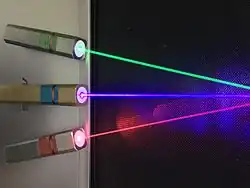
- Light amplification by stimulated emission of radiation (laser) — The laser was invented by Junichi Nishizawa and Yasushi Watanabe in early 1957.[799]
- Raman fiber laser — The first continuous wave Raman laser using an optical fiber as the gain medium was co-developed by B.S. Kawasaki and demonstrated in 1976.[816]
- Semiconductor laser (laser diode) — Invented by Junichi Nishizawa and Yasushi Watanabe in early 1957.[799]
- Continuous wave semiconductor laser — Invented by Izuo Hayashi (1970). It's commonly used for fiber-optics, laser printers, barcode readers and optical discs.[817]
- Raman semiconductor laser — Junichi Nishizawa proposed the concept in 1972. In 1979, he demonstrated the first Raman semiconductor laser.[799]
- Laser mask aligner — Canon's PLA-500FA (1978) was the first mask aligner with laser-based automatic alignment.[223]
- THz radiation laser — In 1980, Junichi Nishizawa demonstrated the first 12 THz electromagnetic wave using the lattice vibration of gallium phosphide crystals in a Raman semiconductor laser.[799]
- Blue laser — Invented by Shuji Nakamura, Isamu Akasaki and Hiroshi Amano while developing blue LED from 1986 to 1992, winning them 2014 Nobel Prize in Physics.[806]
- Vertical-cavity surface-emitting laser (VCSEL) — Short cavity VCSEL was proposed by Kenichi Iga in 1977, and then demonstrated by Haruhisa Soda, Iga, Kitahara and Yasuharu Suematsu in 1979.[818]
Memory

- 3D optical data storage (holographic data storage) — In 1971, Yasutsugu Takeda's Hitachi research team developed holographic memory data storage.[819]
- 3.5-inch floppy disk — The standardized 3.5-inch floppy disk format was developed by Sony in 1981.[820]
- Compact floppy — The 3-inch Compact Floppy Disk format was developed by Hitachi Maxell and Matsushita Electric in 1982.[821]
- Compact disc (CD) — The CD format was jointly developed by Sony (Toshitada Doi) and Philips (Joop Sinjou) between 1979 and 1983.[101]
- CD-ROM — Sony and Philips created the technical standard that defines the CD-ROM format in 1983.[822]
- Digital versatile disc (DVD) — The DVD format (1995) was developed by three Japanese companies (Sony, Toshiba and Panasonic) and one Dutch company (Philips).
- DVD recordable (DVD-R) — Pioneer Corporation released the first DVD-R drive in 1997.[490]
- Dynamic random-access memory (DRAM) — Toshiba's Toscal BC-1411 electronic calculator (released in November 1965) introduced bipolar DRAM, using discrete bipolar transistors and capacitors as DRAM memory cells.[823]
- Embedded DRAM (eDRAM) — In 1988, a Toshiba research team led by Kazuhiro Sawada demonstrated an embedded 1 Mbit DRAM chip optimized for embedded system applications.[824]
- Synchronous graphics RAM (SGRAM) — Hitachi's 8 Mbit (1 MB) HM5283206 graphics memory chip, introduced in November 1994, was the first SGRAM memory chip.[825]
- Double data rate SDRAM (DDR SDRAM) — In February 1997, Fujitsu introduced the first double data rate (DDR) synchronous DRAM (SDRAM) chip, with a capacity of 256 Mbit (16 MB).[826]
- Flash memory (NOR flash) — Flash memory was invented by Fujio Masuoka while working at Toshiba. In 1980, he filed a patent for NOR flash memory.[827]
- NAND flash — Invented by Fujio Masuoka, while working at Toshiba, in 1986.[827]
- Charge trap flash (CTF) — In 1991, NEC's research team including N. Kodama, K. Oyama and Hiroki Shirai developed a type of flash memory that incorporated a charge trap method.[828]
- Vertical NAND (V-NAND) — V-NAND (3D NAND) stacks NAND flash memory cells vertically within a chip using 3D CTF technology. V-NAND technology was introduced by Toshiba in 2007.[829]
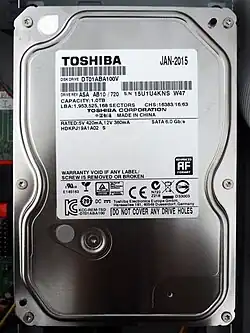
- Gigabyte hard disk drive (GB HDD) — The NEC N7755 (1979) was the first hard disk drive (HDD) exceeding 1 gigabyte (GB) data storage, with 1.27 GB mass storage.[830]
- Perpendicular magnetic recording (PMR) — Shun-ichi Iwasaki invented PMR in 1975. The first commercial PMR HDD was released by Toshiba in 2005.[831]
- Giant magnetoresistance disk read-and-write head (GMR head) — In 1997, Toshiba released the first practical HDD equipped with a GMR head.[110]
- Bit-patterned media (BPM) — In 2010, Toshiba introduced the first BPM hard drive.[832]
- Flux control MAMR (FC-MAMR) — In 2021, Toshiba released the first flux control microwave-assisted magnetic recording (FC-MAMR) hard drive.[829]
- Laptop hard drive — The Toshiba T3100 (1986) was the first laptop computer with built-in hard disk drive (HDD).[340]
- Glass substrate — The Toshiba MK1122FC (1990) HDD featured the first hard disk drive platter with a glass substrate.[830]
- Memory card — In 1984, Japanese company Logitec developed the first erasable optical storage memory card, created for interchangeable arcade video game systems.[833]
- Flash memory card — The Fujix Image Memory Card (1988) by Fujifilm and Toshiba was the earliest flash memory card, compatible with digital cameras from Fuji and Toshiba.[834]
- SD card — The Secure Digital (SD) memory card format was jointly developed in 1999 by Panasonic (then known as Matsushita), Kioxia (then part of Toshiba) and SanDisk.[835]
- Minidisc — In 1992, Sony introduced the MiniDisc (MD), a music recording and playback format intended to replace audio cassettes.[836]
- Heat-assisted magnetic recording (HAMR) — Sony's recordable MiniDisc (1992) used HAMR recording, but the discs were read optically via the Kerr effect.[836]
- Multi-level cell (MLC) — In Japan, the first 3D integrated circuit (3D IC) DRAM memory chips with MLC memory cells were developed, introducing stacked capacitor cells in 1978 and trench capacitor cells in 1982.[327]
- Triple-level cell (TLC) — In 1978, a Hitachi research team led by Mitsumasa Koyanagi demonstrated the first MOS memory RAM (MOS RAM) chip with TLC stacked capacitor memory cells.[837]
- Quad-level cell (QLC) — In early 1996, NEC researchers led by M. Ohkawa introduced a 3D IC flash memory chip with QLC memory cells.[838]
- NMOS logic semiconductor memory — In 1968, NEC introduced a 144-bit NMOS static random-access memory (SRAM) chip, with each memory cell composed of six NMOS transistors.[327]
- Spin-transfer torque (STT) — In 1997, Sony Research Center published the first patent for STT RAM.[839]
- Non-volatile memory (NVM) — In 1970, Shunpei Yamazaki invented a floating-gate NVM semiconductor memory device, a precursor to flash memory.[811]
- EEPROM — Electrotechnical Laboratory (ETL) began research in 1971 and demonstrated an electrically re-programmable NVM in 1972.[840]
- Optical disc drive (ODD) — Toshiba's Tosfile, developed from 1978 to 1979, was the first optical disc recorder drive. It was capable of storing digital images and documents on optical disc.[110]
- Erasable optical disc drive — Matsushita Electric's Erasable Optical Memory Disc Recorder System, introduced in early 1983, was the first erasable ODD. It was capable of storing and erasing digital video, images and documents.[489]
- Magneto-optical drive — In 1982, KDDI researchers Yasuyuki Nagao, Shinsuke Tanaka, Fujio Tanaka and Nobutake Imamura first demonstrated magneto-optical disc recording technology.[841]
- LD-ROM — In 1984, Sony first demonstrated a laserdisc format designed to store digital data, with a 3.28 GB capacity.[842]
- Blu-ray Disc (BD) — After Shuji Nakamura's invention of practical blue laser diodes, Sony first demonstrated a prototype blue laser disc in 2000. Sony named it Blu-Ray.[454]
- Terabyte mass storage (TB) — The Fujitsu GR720 (1999) was the first disk array unit exceeding 1 TB storage capacity using RAID-5 technology. The GR72G02 model supports up to 4.672 TB storage.[830]
Microfabrication
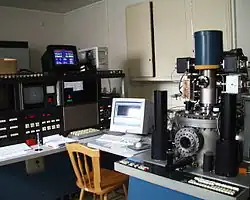

- 3D microfabrication — Developed by Hideo Kodama in 1981, originally for 3D printing.[843]
- Stereolithography (SLA) — Invented by Hideo Kodama for 3D printing in the 1970s.[772]
- Photopolymerization — Invented by Kodama for 3D printing in 1981.[844]
- Projection micro-stereolithography (PμSL) — The microstereolithography method developed by Koji Ikuta and K. Hirowatari in 1993 is the basis for PμSL.[845]
- Automatic mold semiconductor packaging — Developed in 1980 by Towa Corporation based on a multi-plunger mold design, enabling the mass production of high-quality semiconductor devices.[846]
- Electron-beam lithography (EBL) — JEOL's JEBX-2A (1966) and JEBX-2B (1967) were the first electron-beam lithography (EBL) systems.[847]
- Microlithography — The first photolithography system to achieve a high optical resolution more precise than a square micrometre was the FPA-141F (1975) by Canon Inc.[848]
- Multi-photon lithography — Invented by Hideo Kodama in 1981, originally for 3D printing stereolithography.[843]
- Epitaxy — Junichi Nishizawa invented electroepitaxy in 1955, photoepitaxy in 1961, and gallium arsenide (GaAs) molecular layer epitaxy (MLE) in 1984.[798]
- Ion implantation — Discovered by Junichi Nishizawa in 1950.[798]
- Microthermoforming — Dates back to the work of Kyushu Institute of Technology researchers Koji Ikuta and K. Hirowatari in 1993.[849]
- Synthetic diamond chemical vapor deposition (diamond CVD) — In 1986, Shunpei Yamazaki's Semiconductor Energy Laboratory (SEL) developed the SEL μH-2, the first diamond deposition apparatus.[525]
- Transparent conducting oxide — Developed by Hideo Hosono.[194]
Microprocessors
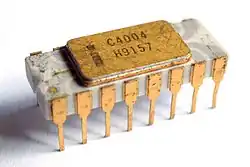
- Microprocessor — Proposed by Tadashi Sasaki in 1968. Masatoshi Shima of Busicom co‑designed the first single-chip microprocessor, Intel 4004, from 1968 to 1971.[850]
- 12-bit microprocessor — The Toshiba TLCS-12 (1973) was the first 12-bit microprocessor.[327]
- Microcontroller unit (MCU) — Introduced in Japan for automobiles in early 1970s, including 4-bit and 8-bit MCUs for entertainment, wipers, locks and dashboard.[851]
- Microprocessor microcode — The Toshiba TLCS-12 (1973) introduced the first microprocessor architecture with microprogram control.[327]
- Compressed instruction set — Originally developed by Hitachi for their SuperH (1992) central processing unit (CPU) microprocessor.[852]
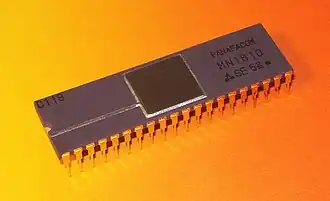
- NMOS logic microprocessor — NEC's μCOM-4 (1973) was the earliest NMOS logic microprocessor, developed by Sohichi Suzuki's NEC research team.[853]
- 16-bit microprocessor — The NEC μCOM-16 (1974) was the earliest two-chip 16-bit microprocessor.[327]
- 16-bit microprocessor integrated circuit — The Panafacom MN1610 (1975) was the first single-chip 16-bit microprocessor.[854]
- Digital signal processor (DSP) — The NEC μPD7720 (1980) was the first commercial DSP chip.[855]
- 32-bit microprocessor — In 1981, Nippon Telegraph and Telephone (NTT) developed a prototype 32-bit microprocessor using VLSI technology.[341]
- 128-bit vector registers — The Hitachi SH-4 (1997) microprocessor introduced a floating-point unit (FPU) with 128-bit vector registers.[856]
- Plastic CPU — In 1984, Shunpei Yamazaki's Semiconductor Energy Laboratory (SEL) developed the first central processing unit (CPU) chip on a plastic substrate.[525]
Nanotechnology
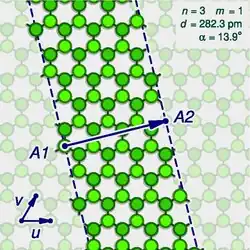
- Carbon nanofiber (CNF) — Discovered by Morinobu Endo in the early 1970s.[857]
- Carbon nanotube (CNT) — Discovered by Morinobu Endo in 1976.[858]
- Multi-walled carbon nanotube (MWCNT) — Discovered by Sumio Iijima of NEC in 1991.[859]
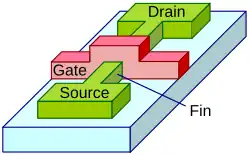
- Multi-gate MOSFET — In 1980, the XMOS transistor developed by Toshihiro Sekigawa of Electrotechnical Laboratory (ETL) was the first double-gate MOSFET.[860]
- Gate-all-around MOSFET (GAAFET) — In 1988, Fujio Masuoka's Toshiba research team demonstrated the first nanowire GAAFET.[861]
- Fin field-effect transistor (FinFET) — In 1989, the DELTA transistor demonstrated by Digh Hisamoto's Hitachi research team was the first FinFET.[862]
- Nanoelectronics
- Surface-conduction electron-emitter display (SED) — SED display technology was developed between 1986 and 1997 by Canon Inc.[54]
- Nanoscale transistor — In 1993, a Toshiba research team developed the first NMOS logic transistor with 40 nm gate length and 10 nm drain junction.[863]
- Carbon nanotube field-emission display (CNT FED) — First demonstrated by Yahachi Saito, Sashiro Uemura and Koji Hamaguchi in 1998.[864]
- Nanocomputer — In 2008, Imran Mahboob and Hiroshi Yamaguchi at NTT proposed a nanomechanical computer using nanoelectromechanical systems (NEMS).[802]
- Optical communication nanowire lasers — In 2017, NTT demonstrated the first laser oscillation and modulation with optical communication nanowire.[341]
- Nanolithography
- Extreme ultraviolet lithography (EUV) — Hiroo Kinoshita invented EUV at Nippon Telegraph and Telephone (NTT) in the mid-1980s and first successfully demonstrated EUV in 1986.[865]
- Nanoimprint lithography mass production — Canon's FPA-1200NZ2C, developed from 2004 to 2017, was the first mass production equipment for nanoimprint lithography (NIL).[866]
- Multi-beam lithography — In 2017, JEOL and IMS developed the first multi-electron beam lithography system for mass production.[209]
- Nanotechnology — The field of nanotechnology was named and defined by Norio Taniguchi in 1974.[867]
Transistors
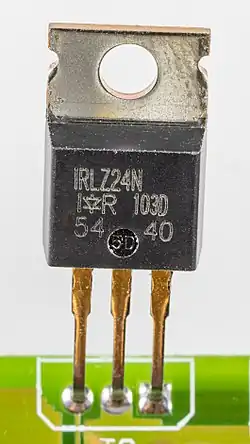
- Field-effect transistor (FET)
- Junction FET (JFET) — In 1950, Junichi Nishizawa and Yasushi Watanabe invented the static induction transistor (SIT), the first JFET and the first practical FET to be built.[799]
- Clocked CMOS (C2MOS) — In 1969, Toshiba developed C2MOS, a circuit technology with lower power consumption and faster operating speed than earlier CMOS.[327]
- Twin-well CMOS — In 1978, Toshiaki Masuhara's Hitachi team introduced the twin-well Hi-CMOS process with the HM6147 memory chip. It soon became the standard CMOS process.[327]
- Organic field-effect transistor (OFET) — In 1986, a Mitsubishi Electric research team led by H. Koezuka reported the first OFET.[868]
- Microscale transistor — In 1979, a metal-oxide-semiconductor FET (MOSFET) 1 μm process was demonstrated by Nippon Telegraph and Telephone (NTT) for their 64 kb DRAM memory chip.[869]
- Shallow trench isolation (STI) — Developed by Osamu Kudoh's NEC research team in 1984.[870]
- Oxide thin-film transistor (oxide TFT) — The first oxide TFT was the indium gallium zinc oxide TFT (IGZO TFT) invented by Hideo Hosono's group at Tokyo Institute of Technology and JST in 2003.[871]

- PNP transistor — Invented by Junichi Nishizawa in 1950.[798]
- Insulated-gate bipolar transistor (IGBT) — The IGBT mode of operation was first proposed by K. Yamagami and Y. Akagiri of Mitsubishi in 1968.[872]
- Non-latch-up IGBT — Akio Nakagawa's team at Toshiba invented the non-latch-up IGBT in 1984. Toshiba commercialized the technology in 1985.[110]
- Power MOSFET — In 1969, Hitachi introduced the first vertical power MOSFET.[873]
- Double-diffused MOSFET (DMOS) — In 1969, DMOS with self-aligned gate was first reported by Toshihiro Sekigawa's team at Electrotechnical Laboratory.[874]
- Laterally-diffused MOSFET (LDMOS) — Introduced by Hitachi in 1977. They first manufactured LDMOS for audio power amplifiers and PA systems.[106]
- V-groove MOSFET (VMOS) — Invented by Hitachi in 1969.[873]
Motor vehicles
Automobiles

- 4-valve dual overhead camshaft (DOHC) — The Nissan Skyline GT-R (C10), released in 1969, was the first production vehicle with a four-valve DOHC.[788]
- 4-wheel multi-link suspension — The Nissan Fairlady Z Model Z32 (1989) featured the first four-wheel multi-link suspension system.[788]
- 5-speed automated manual transmission (AMT) — Isuzu Aska's NAVi5 (1985) introduced the first 5-speed AMT.[875]
- 5-speed automatic transmission (AT) — Introduced with Jatco 5R01 transmission (1989) by Jatco and Nissan, used in various Nissan vehicles.[788]
- Twin Clutch SST (sport shift transmission) — A type of dual-clutch AMT developed by Mitsubishi Motors and introduced in 2007.[876]
- Active exhaust system — Introduced with the Mitsubishi 3000GT in 1990.[120]
- Auto rickshaw — The Mazda-Go (1931) was the first auto rickshaw.[877]
- Cam-shifting variable valve timing (VVT) — Between 1982–1989, Honda invented VTEC, a VVT system hydraulically selecting between two (or three) camshaft profiles.[878]
- VVT diesel engine — In 2010, Mitsubishi developed and started mass production of its 4N13 1.8 L DOHC I4, the first passenger car diesel engine with VVT system.[879]
- Diesel boxer engine — In early 2007, the Subaru EE engine was the first passenger car diesel boxer engine. This engine is a turbocharged boxer-four with common rail fuel injection.[880]
- Dual-mass flywheel (DMF) — Introduced with the Toyota Mark II in 1984.[881]
- Fluoropolymer automotive paint — In 1988, Nissan introduced painting with fluorocarbon polymers.[788]
- Head restraint (head rest) — In 1968, Mazda Porter trucks and vans were the first production vehicles equipped with a head rest as standard equipment.[533]
- Insulated vehicle glass — In 1985, Nissan introduced insulated rear window glass to improve automotive air conditioning performance.[788]
- Kei car (mini-car) — A category of small automobiles, including passenger cars, vans and pickup trucks. The first kei cars were launched for Japan in 1949.[882]
- Automatic transmission mini car — Honda N360 AT (1968).[883]
- 5-valve engine — Mitsubishi were the first to market a car engine with five valves per cylinder, with the 548 cc 3G81 engine in their Minica Dangan ZZ kei car in 1989.[884]
- Low emission vehicle (LEV) – The first LEV was the 1996 Honda Civic, released in 1995.[885]
- Ultra-low-emission vehicle (ULEV) – The first ULEV was the Honda Accord in 1997.[885]
- Super ultra-low emission vehicle (SULEV) – The first SULEV was the Honda Accord in 1999.[885]
- Miller cycle car engine — The Mazda Millenia (1993) was the world's first production car to employ a Miller cycle engine.[533]
- Multi-rotary engine — Mazda Wankel engine (1960s) was the first twin rotary engine, commercialized with Mazda Cosmo Sports (1967). Mazda's 20B (1987) was the first three-rotor engine. Mazda 13J (1987) was the first four-rotor engine.[533]
- Automatic transmission rotary engine — The Mazda Capella (1970) introduced the Mazda 12A engine, the first rotary engine with automatic transmission.[533]
- Turbo rotary engine — In 1982, the Mazda Cosmo (929) and Mazda Luce (929) were the first cars with a rotary turbo engine. In 1986, the Mazda Luce (929) introduced a twin-turbo rotary engine configuration.[533]
- Rotary engine hydrogen vehicle — The Mazda RX-8 Hydrogen RE (2006) was the first hydrogen vehicle with a rotary engine.[533]
- Modulated displacement (MD) — In early 1982, Mitsubishi Motors introduced modulated displacement (MD), a form of variable displacement first used in Mitsubishi's 1.4 L 4G12 straight-four engine.[876]

- Natural gas vehicle (NGV) — The Honda Civic GX (1998) was the first production car to run on compressed natural gas (CNG).[886]
- Partial zero-emissions vehicle (PZEV) – The Honda Civic GX (1998) was the first PZEV.[886]
- Oxygen storage three-way catalyst — Introduced by Toyota in 1978.[887]
- NOx adsorber — Introduced by Toyota in 1994.[887]
- Parallel axis system — Introduced by the Hondamatic system with the Honda N360 AT (1968). It is used in most Honda automatic and semi-automatic vehicles.[883]
- Plasma spark ignition system — Introduced by Nissan in 1982.[788]
- Selective catalytic reduction (SCR) — The first large-scale SCR was installed by IHI Corporation in 1978.[888]
- Self-repair car paint — In 2005, Nissan introduced Scratch Guard Coat, the first clear exterior paint that can self-repair scratches.[788]
- Hydrogen-free diamond-like carbon (hydrogen-free DLC) — In 2006, Nissan introduced the first hydrogen-free DLC coating.[788]
- Semi-monocoque car — The Honda NSX (1990) was the first production car to feature an all-aluminium semi-monocoque.[889]
- Torque vectoring — In 1996, Honda and Mitsubishi released sports cars with torque vectoring systems. Torque vectoring differentials were originally used in auto racing. Mitsubishi rally cars were some of the earliest to use the technology.[890]
- Triple-viscous four-wheel drive (4WD) — In January 1987, Nissan introduced the first triple-viscous full-time 4WD vehicles, with the Nissan Pulsar, Nissan EXA, Nissan Langley and Liberta Villa models.[788]
- Truck dual-clutch transmission (DCT) — In 2010, the Mitsubishi Fuso 6-speed Duonic transmission was the first dual-clutch transmission (DCT) used in a truck.[891]
- Variable-geometry turbocharger — Introduced by the Honda Legend Wing Turbo (1988).[892]
- Ceramic turbocharger — The Nissan Fairlady Z (300ZX), launched in 1989, was equipped with the first production ceramic turbocharger.[788]
- Water intercooler — Introduced with the Toyota M-TEU engine in 1983.[881]
Electric vehicles
- Battery electric car — The Mitsubishi Libero EV (1993), co-developed with Tokyo Electric Power Company, was a fully battery-powered commercial electric car.[876]
- Lithium-ion automotive battery — Between 1992 and 1996, Nissan and Sony developed the first lithium-ion electric vehicle battery.[788]
- Lithium-ion battery electric vehicle (BEV) — Nissan Prairie Joy EV (1996) was the first electric vehicle (EV) using lithium-ion battery, developed by Nissan and Sony.[788]
- DC fast charging — The Mitsubishi i-MiEV (2009) was the first electric car with DC fast charging capability.[893]
- Electric kei car — The Mitsubishi i-MiEV (2009) was the first electric kei car.[894]
- Electric delivery truck — In January 1991, Isuzu developed the first prototype 2-ton electric delivery truck.[875]
- Electric SUV — The Toyota RAV4 EV, developed from 1995 to 1997, was the first electric sport utility vehicle (SUV).[895]
_Plug-in_Hybrid_-_Silver_Metallic_-_10-2024%252C_Front_Quarter.jpg)
- Hybrid electric vehicle (HEV) — The first production HEV was a hybrid electric bus introduced by Hino Motors in 1991 as an urban transit bus.[896]
- Hybrid electric car — The first production hybrid car was the Toyota Prius launched in 1997.[897]
- Atkinson cycle car engine — The first Atkinson cycle car engine was used in the Toyota Prius (1997).[898]
- Hybrid electric tour bus — Introduced by Hino Motors in 1997.[899]
- Hydrogen car — The Toyota Mirai (2014) was the first production hydrogen fuel cell vehicle (FCV).[900]
- Parallel hybrid — The Honda Insight (1999) introduced a parallel hybrid system, Integrated Motor Assist (IMA).[901]
- BAS hybrid — In June 2001, Toyota introduced a BAS (belted alternator starter) hybrid system under the Toyota Hybrid System-Mild (THS-M) brand name.[902]
- Mild hybrid electric vehicle (MHEV) — Introduced with the Toyota Hybrid System‑Mild (THS-M) in the Toyota Crown Royal Saloon (2001).[881]
- Hybrid electric SUV — Toyota's Lexus RX 400h (2004) was the first luxury hybrid SUV.[302]
- Hybrid electric sedan — Toyota's Lexus GS 450h (2006) was the first high-performance luxury hybrid sedan.[302]
- Hybrid electric compact car — Toyota's Lexus CT 200h (2011) was the first full hybrid luxury compact car.[302]
- Zero-emission vehicle (ZEV) — The Nissan Leaf (2009) was the world's first ZEV.[903]
Electronic systems

- 4-wheel steering (4WS) — Mazda were pioneers in applying four-wheel steering to automobiles, demonstrating it on their Mazda MX-02 (1984) concept car.[904]
- 4WS speed-sensitive steering — The Mazda Capella (626), released in 1987, introduced the first speed-sensitive 4WS system.[533]
- 4WS active steering — The Nissan Skyline (V36), released in 2006, introduced the first four-wheel active steering system.[788]
- 42-volt electrical system (42V) — In 2001, the Toyota Crown Royal Saloon was the first production vehicle with 42V electrical system.[905]
- Active noise control (ANC) — The Nissan Bluebird U13 (1991) was the first production vehicle with active noise control.[788]
- Active noise cancellation (ANC) — In 2004, Honda's 2005 Acura RL was the first car with active noise cancellation.[120]
- Advanced driver-assistance system (ADAS)
- Voice warning system — In 1980, the Toyota Mark II was the first car with a voice warning system.[881]
- Voice command — In 1982, the Nissan Silvia S110 introduced voice recognition for operating the power windows.[788]
- Automotive head-up display (HUD) — Nissan was the first manufacturer to offer a HUD with the Nissan Silvia S13 (1988).[788]
- Adaptive cruise control (ACC) — Introduced by Mitsubishi Motors in 1992. They were the first to offer a lidar-based distance detection system on the Mitsubishi Debonair.[906]
- Blind spot monitor — Introduced by Mitsubishi with their Driver Support System (DSS) in 1998.[876]
- Active automotive night vision — Toyota's Night View (2002) was the first active automotive night vision system.[907]
- Automatic car door — Introduced for Japanese taxi vehicles in 1964.[908]
- Automatic air conditioner (automatic AC) — Introduced by Toyota and Nissan in 1971.[909]
- Automotive engine microcomputer — The earliest microcomputer designed for an automobile was developed by Toshiba for Ford's Electronic Engine Control (EEC) in the early 1970s.[110]
- Auxiliary connector — In 1991, the Mitsubishi 3000GT and Galant VR-4 were the first cars with auxiliary inputs for portable devices.[120]
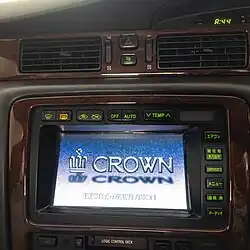
- Carputer — Electro Multi Vision by Denso and Toyota was an integrated computer system for the 1985 Toyota Soarer and 1987 Toyota Crown.[910] It introduced features including:
- Digital dash CRT display (1985)[911]
- High-resolution on-board diagnostics (1985)[911]
- In-car entertainment TV/VCR combo (1985)[911]
- Touchscreen interface (1987)[910]
- Collision avoidance system (CAS) — The first CAS systems were Toyota's Clearance Sonar (Aug 1989), Nissan's Traffic Eye (Dec 1989) and Isuzu's CAS system (1990).[912]
- Pre-collision system (PCS) — In February 2003, Toyota launched PCS using millimeter wave radar for the Toyota Harrier.[881]
- Driver monitoring system (DMS) — Introduced by Toyota in 2006 for Lexus models, offered on the GS 450h. System functions co-operate with the PCS system.[913]
- Eye tracking driver monitoring system — In 2008, the Toyota Crown's Driver Monitoring System (DMS) was the first driver eyelid monitoring system.[914]
- Electronic control unit (ECU) — In the early 1970s, the Japanese electronics industry began producing integrated circuits and microcontrollers for controlling vehicle engines.[915]
- Transmission control unit (TCU) — Transmission control was introduced by Toyota in 1970.[909]
- Engine control unit (ECU) — Toshiba developed the Electronic Engine Control (EEC) for Ford Motor Company. The core Toshiba TLCS-12 microprocessor CPU was developed from 1971 to 1973. The EEC system entered production in 1974.[110]
- Electronic Diesel Control — In August 1982, Toyota introduced a microprocessor-based engine control system for diesel engines.[916]
- Electronically controlled automated manual transmission (AMT) — Introduced with Isuzu Aska's NAVi5 in 1985.[875]
- Electronically adjustable suspension dampers — In 1981, the Nissan Skyline Turbo GT-ES introduced the first electronically adjustable suspension shock absorbers.[917]
- Continuously variable damping — Invented by Honda engineers Yoshihiko Toshimitsu, Toshihiko Aoyama and Takashi Ishida in 1984.[918]
- Electronically controlled suspension (ECS) — The 1983 Toyota Soarer introduced Toyota Electronic Modulated Suspension (TEMS), the first electronically controlled car suspension.[881]
- Semi-active suspension (SAS) — The 1983 Toyota Soarer's TEMS system was the first SAS in a production car.[881]
- Ultrasonic ECS — In 1984, the Nissan Bluebird Maxima Model PU11 introduced Super Sonic Electronic Control Suspension with ultrasonic road surface sonar.[788]
- Active air suspension — Introduced in 1984 with the Mitsubishi Galant's CECS (Chassis Electronic Control Systems).[919]
- Electronically controlled air suspension (ECAS) — In 1986, the Toyota Soarer had the first electronically controlled full air suspension (spring constant, variable attenuation force) installed.[881]
- Electronically controlled anti-lock braking system (ABS) – ABS control was introduced by Toyota and Nissan in 1971.[909]
- Automated emergency braking system (AEBS) – AEBS dates back to the 1997 Nissan 240SX.[920]
- Brake-by-wire – Electronically controlled brake (ECB) system, developed by Toyota initially for its hybrid and Lexus models and introduced in June 2001, is the first production brake-by-wire braking system.[921]
- Electronically controlled continuously variable transmission (ECVT) — In early 1987, Subaru launched the Justy in Tokyo with an ECVT developed by Fuji Heavy Industries, which owns Subaru.[922]
- Toroidal continuously variable transmission (toroidal CVT) – Introduced in 1999 with Nissan's Extroid CVT for the Nissan Cedric (Y34) and Nissan Gloria.[923]
- Electronic stability control (ESC) – The 1971 Toyota Crown introduced Electronic Skid Control (ESC).[924]
- Traction control system (TCS) — Toyota introduced TCS for the Toyota Crown (1987) and improved it for the Lexus LS400 (1989).[925]
- Fuel injection control — Introduced by Toyota and Nissan in 1971.[909]
- Electronic gasoline direct injection (GDI) – Introduced by Mitsubishi in 1995.[876]
- Common rail diesel engine — In 1995, the first mass production vehicle with common rail was the Hino Ranger truck, using the ECD-U2 common rail system developed by Denso.[926]
- Gasoline direct–indirect injection – The 2005 Toyota 2GR-FSE V6 engine was the first to combine both direct and indirect injection. The system (called "D-4S") has since been used in most Toyota engines.[927]
- Turbo gasoline direct injection (turbo GDI) — The first turbocharged GDI engine was used in the Mitsubishi Pajero iO 4G93 (2000).[928]
- Fully active suspension — The Toyota Celica (1989) introduced Toyota Active Control Suspension, the first fully active suspension without anti-roll bars.[881]
- Hydraulic active suspension — Nissan's Infiniti Q45 Model G50 (1989) was the first passenger car with hydraulic active suspension.[788]
- Skyhook suspension — The 1994 Toyota Celsior introduced the first skyhook air suspension.[881]
- Keycard lock — In 1985, the Nissan Skyline (R31) introduced a car lock system that allows locking and unlocking with a card.[788]
- Laser cut car key — Toyota's Lexus LS400 (1989) was the first major car with a laser-cut key.[929]
- LCD rear-view mirror — Nissan Laurel C32 (1984) introduced an auto reflex room mirror using automatic anti-glare liquid-crystal display (LCD).[788]
- Electrochromic rear-view mirror — Invented by Nissan engineers Harutoshi Miyagi, Masazumi Ishikawa and Yasuyuki Murofushi between 1985 and 1986.[930]

- LED headlight — Toyota's Lexus LS 600h L, introduced in 2006, was the first production car with LED headlights.[931]
- Parking sensor — Toyota introduced ultrasonic Back Sonar on the 1982 Toyota Corona, the first production parking sensor, offering it until 1988.[932]
- Windshield wiper sensor — In 1983, Nissan Cedric and Nissan Gloria introduced the first windshield wipers that adjust to changes in snow and rain sensor levels.[788]
- Pedestrian detection — In 2004, Honda introduced Intelligent Night Vision, the first system with pedestrian detection, on the Honda Legend.[933]
- Power side-view mirror — The Nissan Laurel C32 (1984) introduced electric retractable side-view mirrors.[788]
- Anti-glare side-view mirror — The Nissan Cefiro A31 (1988) introduced automatic anti-glare door mirrors.[788]
- Titanium side-view mirror — In 1997, Nissan developed the first titanium clear outside mirror with super hydrophilicity.[788]
- Rear airbag — The Nissan President Model G50 (1993) introduced the first rear seat SRS airbag system, for the left-hand side (curbside) rear seat passenger.[788]
- Seat cushion airbag — The Nissan Skyline V35 (2001) introduced the first active seat cushion, which works in tandem with the seat belt and SRS airbag.[788]
- Dual-chamber airbag — Toyota's 2005 Lexus IS was the first car with a twin-chamber front passenger airbag.[302]
- Rear curtain airbag — In 2008, the Toyota iQ microcar featured the first production rear-curtain shield airbag to protect the rear occupants' heads in the event of a rear-end impact.[934]
- Center airbag — In 2009, Toyota developed the first production rear-seat center airbag designed to reduce the severity of secondary injuries to rear passengers in a side collision. This system first appeared on the Toyota Crown Majesta.[881]
- Synchronized down shift rev-matching system (SynchroRev Match) — Invented by Nissan in 2008 for use on the Nissan 370Z and Fairlady Z.[935]
Motorcycles
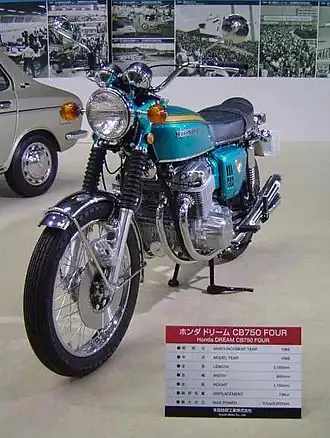
- Air bag vest — Honda introduced the first motorcycle airbag system in 2005.[936]
- Double cradle frame — The Honda CB750, released in 1969, was the first mass-production motorcycle with a double cradle motorcycle frame.[515]
- Four mufflers — The Honda CB750 (1969) was the first mass-production motorcycle with four mufflers.[515]
- Straight-four SOHC — Honda CB750 (1969) was the first mass-produced motorcycle with a parallel four-cylinder single overhead camshaft (SOHC) motorcycle engine.[515]
- Superbike — The Honda CB750 (1969) was the first superbike.[937]
- Front disc brake — The Honda CB750 (1969) was the first mass-production motorcycle with front disc brake.[938]
- Hydraulic disc brakes — Honda CB750 (1969) was the first production motorcycle with hydraulic disc brakes.[515]
- Combined braking system (CBS) — The first CBS was introduced with the Honda RCB1000 in 1976.[939]
- Oval piston engine — A piston engine using oval cylinders, it was developed by Honda and introduced with the Honda NR500 in 1979.[940]
- 8-valve engine — Introduced with Honda's oval piston engine for the Honda NR500 in 1979.[940]
- Traction control system (TCS) — The Honda ST1100 (1992) was the first motorcycle with TCS.[938]
- Dual-clutch transmission (DCT) — The 2009 Honda VFR1200F was the first motorcycle to use DCT.[941]
- Universal Japanese Motorcycle (UJM) — The term was coined in the 1970s to describe a proliferation of similar Japanese standard motorcycles that became commonplace following Honda's 1969 introduction of its successful CB750.[942]
Navigation

- Automotive navigation system — Ministry of International Trade and Industry (MITI) established CATC (Comprehensive Automobile Traffic Control) in 1973.[943]
- Car navigation system — In 1980, the Toyota Crown introduced the Electro Auto Compass, the first car navigation system.[881]
- Automotive dead reckoning — Used in first automotive navigation systems, including Toyota's Electro Auto Compass (1980) and Honda's Electro Gyrocator (1981).[943]
- Digital map — Honda's Electro Gyrocator (1981) was the first car navigation system with a digital map display, using a small CRT display.[943]
- High-resolution digital map color display — Introduced with the 1987 Toyota Crown's Electro Multi Vision system, using a CD-ROM drive and CRT display.[943]

- Backup camera (rear-view camera) — First production automobile with a backup camera was the Toyota Crown in 1987.[881]
- Smart camera — Nissan's Rear View Monitor the Infiniti Q45 (2000) was a smart camera projecting on‑screen parking guidelines onto the navigation screen.[944]
- Surround-view system — Introduced in January 2007 with the Mitsubishi Delica's Multi-Around Monitor system.[945]
- Lane departure warning system (LDWS) — Introduced by Mitsubishi Motors with their Driver Support System (DSS) in 1998.[876]
- Lane keeping assist (LKA) — The Nissan Cima Model F50 (2001) introduced the first lane keeping assistance system.[788]
- Satellite navigation (Satnav)
- GPS navigation — Pioneer Corporation's AVIC-1 (1990) was the first GPS car satnav system.[490] The Mazda Eunos Cosmo (1990) was the first production car with a built-in GPS satnav system.[533]
- Satnav panoramic view — In 1995, Nissan introduced BirdView, the first satnav with 3D over-the-shoulder panorama view. BirdView used a 32-bit CPU and Nissan image processor.[788]
- Differential GPS (DGPS) — In 1997, a navigation system using differential GPS was developed as a factory-installed option on the Toyota Prius.[881]
- Self-driving car (vehicular automation) — The first self-driving car that did not rely upon rails or wires under the road was designed by the Tsukuba Mechanical Engineering Laboratory in 1977, using cameras and analog computer technology.[946]
- Automatic parking — Toyota's Intelligent Parking Assist System (IPAS) is the first production automatic parking system, developed in 1999 initially for the hybrid Prius and Lexus models. It assists drivers in parking a vehicle.[947]
- Voice assisted GPS navigation — In 1992, the world's first voice assisted GPS navigation system was introduced for the Toyota Celsior.[881]
Sciences
Astronomy
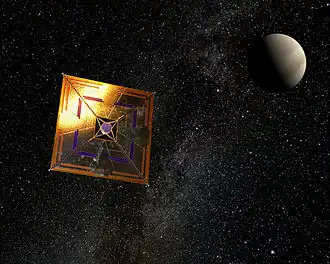
- Asteroid sample-return mission — Hayabusa (2003–2010) was the first successful asteroid space probe to travel through outer space and return with an asteroid sample.[194]
- Planetarium projector with 3D ray tracing — LINKS-1 Computer Graphics System used to create the first 3D planetarium video with ray-traced 3D computer graphics in 1985.[311]
- Space camera — Konica's Minolta Hi-Matic was the first camera taken into outer space on a human spaceflight mission by astronaut John Glenn in 1962.[948]
- Space photography digital camera — Nikon NASA F4 (1987) was the first digital camera for space photography, used on the Space Shuttle Discovery in 1991.[233]
- HD video space camera — NHK and Sony developed the first HD video camcorder used on a spacecraft, the Space Shuttle Discovery in 1998.[949]
- Comet digital video footage — In 2013, a 4K resolution Canon Cinema EOS digital video camera was used to capture the first video footage of Comet ISON.[223]
- Solar sail — IKAROS, launched by Japan Aerospace Exploration Agency (JAXA) in 2010, was the first spacecraft to successfully use solar sail technology for propulsion. It made the first successful interplanetary spaceflight using solar sail technology.[950]
Atmospheric science

- Downburst — Downbursts, strong ground-level wind systems that emanate from a point above and blow radially, were discovered by Ted Fujita.[951]
- Macroburst — Ted Fujita discovered macrobursts and classified them as downbursts larger than 4 km (2.5 mi).[951]
- Microburst — The microburst was first discovered and identified as a small scale downburst affecting an area 4 km (2.5 mi) in diameter or less by Fujita in 1974.[951]
- Fujita scale — The first scale designed to measure tornado intensity, it was introduced by Ted Fujita in 1971. The scale was widely adopted until the Enhanced Fujita scale.[952]
- Fujiwhara effect — The Fujiwhara effect is an atmospheric phenomenon first described by Sakuhei Fujiwhara in 1921.[953]
- Jet stream — Jet streams were first discovered by Japanese meteorologist Wasaburo Oishi by tracking ceiling balloons.[954]
Chemistry

- Aluminium-zinc alloy — By alloying zinc with aluminium, Sumitomo Metal Industries developed the 7075 aluminium alloy (extra super duralumin) in 1935.[284]

- Artificial snowflake — The first artificial snowflake was created by Ukichiro Nakaya in 1936, three years after his first attempt.[955]
- Endless hot rolling — First developed in 2000 by Nippon Steel & Sumitomo Metal, Kawasaki Steel, Mitsubishi Heavy Industries and IHI Corporation.[222]
- Hot rolling thermometer — In 2011, Nippon Steel & Sumitomo Metal developed the first hot rolling sheet steel thermometer with high precision.[222]
- Ephedrine synthesis — In 1885, the chemical synthesis of ephedrine was first accomplished by Japanese organic chemist Nagai Nagayoshi.[956]
- Ferrite magnet — Yogoro Kato and Takeshi Takei of the Tokyo Institute of Technology synthesized the first ferrite compounds in 1930.[957]
- Neodymium magnet (rare-earth magnet) — The first neodymium magnets were invented independently in 1982 by Sumitomo Special Metals and General Motors.[958]
- Friction analysis of galvannealed sheet steel — First conducted In 2003 by Sumitomo Metal Industries and Toyota researchers using Dr. STAMP technology.[959]
- Frontier molecular orbital theory — Kenichi Fukui developed and published a paper on frontier molecular orbital theory in 1952.[960]
- Gold synthesis — First synthesis of gold was conducted by Japanese physicist Hantaro Nagaoka, who synthesized gold from mercury in 1924 by neutron bombardment.[961]
- KS steel — Magnetic resistant steel that is three times more resistant than tungsten steel. It was invented by Kotaro Honda in 1917.[962]
- MKM steel — MKM steel, an alloy containing nickel and aluminium, was developed in 1931 by the Japanese metallurgist Tokuhichi Mishima.[963]
- Methamphetamine (meth) — Methamphetamine was first synthesized from ephedrine in Japan in 1894 by chemist Nagayoshi Nagai.[964]
- Methamphetamine hydrochloride — In 1919, methamphetamine hydrochloride was synthesized by pharmacologist Akira Ogata.[965]
- Nihonium — Element 113. Named after Nihon, the local name for Japan. It was discovered by a Japanese team under Kōsuke Morita.[194]
- Photocatalysis — Akira Fujishima discovered photocatalysis occurring on the surface of titanium dioxide in 1967.[966]
- Polyvinyl alcohol fiber (PVA fiber) — Developed by Kuraray between 1940 and 1950.[415]
- Ethylene vinyl alcohol (EVOH) — Developed by Kuraray between 1957 and 1964.[415]
- Polyisoprene synthetic rubber — Developed by Kuraray in 1972.[415]
- Statin — The statin class of drugs was first discovered by Akira Endo, a Japanese biochemist working for the pharmaceutical company Sankyo. Mevastatin was the first discovered member of the statin class.[967]
- Takadiastase — A form of diastase which results from the growth, development and nutrition of a distinct microscopic fungus known as Aspergillus oryzae. Jōkichi Takamine developed the method first used for its extraction in the late 19th century.[968]
- Synthetic fluorite — In 1968, synthetic fluorite was first successfully mass-produced by Canon Inc.[232]
- Urushiol — Urushiol, a mixture of alkyl catechols, was discovered by Rikou Majima. Majima also discovered that Urushiol was an allergen which gave members of the genus Toxicodendron, such as poison ivy and poison oak, their skin-irritating properties.[969]
Mathematics

- Amari distance — It is named after Japanese information theorist Shun'ichi Amari and was originally introduced as a performance index for blind source separation.[970]
- Bernoulli number — Studied by Seki Kōwa and published after his death in 1712, a year before Jacob Bernoulli independently rediscovered the concept.[971]
- Calculus — Seki Kōwa (1642–1708) founded Enri, a mathematical system with the same purpose as calculus.[972]
- Determinant — Introduced by Seki Kōwa in 1683 to study elimination of variables in higher‑order algebraic equations, to give shorthand representation for the resultant.[973]
- Elimination theory — In 1683 (Kai-Fukudai-no-Hō), Seki Kōwa came up with elimination theory, based on resultant.[973]
- Hironaka's example — Hironaka's example is a non-Kähler complex manifold that is a deformation of Kähler manifolds discovered by Heisuke Hironaka.[974]
- Information geometry — The modern theory is largely due to Shun'ichi Amari, whose work has been greatly influential on the development of the field.[975]
- Itô calculus — Developed by Kiyosi Itô in the 1940s. Concepts include Itô integral and Itô's lemma. It is widely used in various fields, especially mathematical finance.[976]
- Itô's lemma — This result was discovered by Kiyoshi Itô in 1951.[977]
- Stochastic calculus — Developed by Kiyosi Itô in the 1940s, involving stochastic integrals and stochastic differential equations based on the Brownian motion or Wiener process.[976]
- Stochastic differential equation (SDE) — Invented by Kiyosi Itô in 1942.[976]
- Itô diffusion — A diffusion process developed by Kiyosi Itô.[976]
- Iwasawa theory — Initially created by Kenkichi Iwasawa, Iwasawa theory was originally developed as a Galois module theory of ideal class groups.[978]
- Main conjecture of Iwasawa theory — A deep relationship between p-adic L-functions and ideal class groups of cyclotomic fields, proved by Iwasawa for primes satisfying the Kummer–Vandiver conjecture.[978]
- Japanese theorem for cyclic polygons — This result comes from a sangaku tablet dated 1800.[979]
- Japanese theorem for cyclic quadrilaterals — In geometry, this theorem states that the centers of the incircles of certain triangles inside a cyclic quadrilateral are vertices of a rectangle. It was originally stated on a sangaku tablet in 1880.[979]
- Kenmotsu manifold — Discovered by Katsuei Kenmotsu in 1972.[980]
- Richardson extrapolation — Takebe Katahiro used Richardson extrapolation in 1695, about 200 years earlier than Richardson.[981]

- Sangaku — Japanese geometric puzzles on wooden tablets created during the Edo period (1603–1867) by members of all social classes. Introduced to Europe in the 1790s.[982]
- Soddy's hexlet — Irisawa Shintarō Hiroatsu analyzed Soddy's hexlet in a Sangaku in 1822 and was the first person to do so.[983]
- Takagi existence theorem — Takagi existence theorem was developed by Teiji Takagi in isolation during World War I. He presented it at the International Congress of Mathematicians in 1920.[984]
- Takagi–Sugeno–Kang (TSK) — A fuzzy logic system proposed by Tomohiro Takagi and Michio Sugeno in 1985.[313]
- Two-valued Boolean algebra — Discovered independently by NEC engineer Akira Nakashima. From 1934 to 1936, his switching circuit theory showed that two-valued Boolean algebra can describe the operation of switching circuits.[803]
Physics

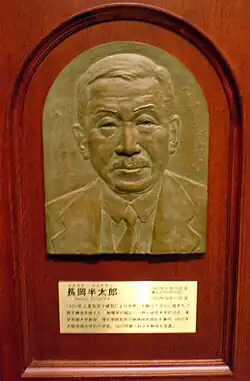
- Cabibbo–Kobayashi–Maskawa matrix — Discovered by Makoto Kobayashi and Toshihide Maskawa, it introduced three generations of quarks.[985]
- Spontaneous symmetry breaking — Discovered by Kobayashi and Maskawa, for which they were awarded the 2008 Nobel Prize in Physics.[985]
- High-temperature superconductors (HTS) — Jun Akimitsu discovered new HTS including magnesium diboride[194]
- Iron-based superconductor (FeSC) — Discovered by Tokyo Institute of Technology team under Hideo Hosono.[801]
- K2K experiment
- Klein–Nishina formula
- Kuramoto model — Developed by Yoshiki Kuramoto.[194]
- Kuramoto–Sivashinsky equation — Developed by Yoshiki Kuramoto.[194]
- Non-linear synchronization — Yoshiki Kuramoto pioneered the non-linear model of the synchronization phenomenon.[194]
- Magnetic field microscopic observation — In 1982, Hitachi made the first successful microscopic scale observation of a magnetic field using electron beam holography.[212]
- Meson — In 1934, Hideki Yukawa predicted the existence and the approximate mass of the meson as the carrier of the nuclear force that holds atomic nuclei together.[986]
- Neutron scattering — Seishi Kikuchi demonstrated the scattering of fast neutrons in 1934.[529]
- Plasma gasification commercialization — In 1999, a 166-short-ton (151 t) per day pilot plant was built in Yoshii, co-developed by Hitachi Metals.[988]
- Thermal cracking by gasification — By 2015, Nippon Steel & Sumitomo Metal had successfully established the first thermal cracking technology using gasification recycling equipment for 100% resource recovery.[222]
- Quantum electrodynamics (QED) — Shin'ichirō Tomonaga co-developed the field of quantum electrodynamics in the mid-20th century, for which he was awarded the 1965 Nobel Prize in Physics.[989]
- Lamb shift — Co-developed by Shin'ichirō Tomonaga in the mid-20th century.[989]
- Schwinger–Tomonaga equation
- Tomonaga–Luttinger liquid
- Quantum tunnelling — In 1957, Leo Esaki demonstrated tunneling of electrons over a few nanometer wide barrier in a semiconductor structure and developed a diode based on tunnel effect.[990]
- Quantum Hall effect — First predicted by Tsuneya Ando's University of Tokyo team in 1975.[991]
- Quantum telecloning — In early 2006, quantum telecloning was first demonstrated by researchers from the University of Tokyo, Japan Science and Technology Agency and University of York.[992]
- Saturnian model (planetary model) — In 1904, Hantaro Nagaoka proposed the first planetary atomic model as an alternative to the plum pudding model. It was a basis for the Bohr model in 1913.[993]
- Sakata model — The Sakata model was a precursor to the quark model proposed by Shoichi Sakata in 1956.[994]
- Yukawa coupling
- Yukawa potential
Telecommunication

- Ansafone — Invented by Kazuo Hashimoto between 1954 and 1958. He was employed by PhoneTel, which in 1960 began selling the first answering machines in the US.[995]
- Caller ID — In 1976, Kazuo Hashimoto built the first prototype of a caller ID display device that could receive caller information.[995]
- Digital answering machine — In 1983, Kazuo Hashimoto invented the first digital answering machine.[996]
- Color videophone — In 1970, Toshiba developed the first color videophone.[110]
- Digital telephony electronic switching system (ESS) — Fujitsu's FETEX-150 (1981) was the first fully digital ESS with a full digital telephone switchboard.[293]
- Emoji — The first emoji was created between 1998 and 1999 by Shigetaka Kurita in Japan.[997]
- Face with Tears of Joy emoji — NTT DoCoMo's emoji set in 1999 introduced the Face with Tears of Joy emoji.[997]
- Hands free car phone — Introduced with the 1987 Toyota Crown's Electro Multi Vision system developed by Denso and Toyota.[910]
Internet

- Asynchronous Transfer Mode (ATM) — Fujitsu's FETEX-150 (1981) was the first commercial ATM electronic switching system (ESS).[293]
- Digital videophone — The first practical videophone for home use was Mitsubishi Electric's Luma 1000 (1986), where digital images were streamed over a phone line.[998]

- Fiber-optic communication — First proposed by Junichi Nishizawa in 1963.[999]
- Fiber-optic cable — In 1975, NEC and Tokyo Electric Power Company conducted the first comprehensive field test of a fiber‑optic cable system.[338]
- Fiber-optic communications system — In 1977, NEC developed the first commercial fiber-optic communications system.[338]
- Multi-core fiber (MCF) — Invented by S. Inao of Furukawa Electric in 1979.[1000]
- Optical fiber connector — Invented by Nippon Telegraph and Telephone (NTT) in 1986.[1001]
- Gigabit per second (Gbit/s) — In 1979, Takashi Kimura of Nippon Telegraph and Telephone (NTT) demonstrated 1 Gbit/s fibre-optic transmission over 20 km.[1002]
- Terabit per second (Tbit/s) — In 1996, Fujitsu demonstrated the first 1 Tbit/s fibre‑optic transmission over 150 km, using zero-dispersion and wideband EDFA.[1003]
- Petabit per second (Pbit/s) — In 2012, NTT demonstrated the first successful 1 Pbit/s fibre-optic transmission over 50 km.[341]
- Image sharing — In the 1980s, NTT's INS-Net introduced an image sharing service supporting high-resolution color digital images.[1004]
- Digital camera image sharing — The Olympus Deltis VC-1100 (1994) was the first digital camera with image sharing, using an internal modem connected to an external phone line.[229]
- Integrated Services Digital Network (ISDN) — NTT's Integrated Services Network (INS), also known as INS-Net, was the first ISDN service. After field tests from 1984 to 1987, NTT launched INS-Net in 1988.[1004]
- Broadband Internet fibre-optic network — NTT's INS-Net 1500 was the first broadband ISDN fibre-optic network. After field tests from 1986 to 1987, INS-NET 1500 was launched in 1989. Internet bandwidth was 1.5 megabits per second (Mbit/s).[1004]
- Multiprotocol Label Switching (MPLS) — Originates from Toshiba's Cell Switch Router (CSR) technology in 1994.[1005]
- Multicast MPLS — In 2003, Nippon Telegraph and Telephone (NTT) first developed multicast MPLS for broadband services.[341]
- Online magazine — The first online magazine was Internet Magazine launched by Japanese company Impress in September 1994.[1006]
- Optical communication — First proposed by Junichi Nishizawa in 1963.[999]
- Optical Transmission System — In 1976, Hitachi successfully demonstrated the first optical transmission system.[212]
- Synchronous optical network (SONET) — In 1989, NEC and NTT developed the first commercial synchronous digital hierarchy (SDH) system.[338]
- Photonics telecommunications network — Between 2019 and 2021, Nippon Telegraph and Telephone (NTT) led the development of Innovative Optical and Wireless Networks (IOWN), the first all-photonics telecommunications network.[1007]
- Streaming media (music streaming service) — In the 1980s, NTT's INS-Net launched with a music streaming service allowing digital music transmission.[1004]
- Video on demand (VOD) — In 1986, a VOD service was first proposed for INS-Net.[439]
- Karaoke streaming — In 1992, Brother Industries introduced Karaoke Joysound, the first karaoke network system via ISDN. In 1993, Brother introduced JS-1X, the first centralized network control system for karaoke establishments.[417]
- Textboard — Textboards like imageboards were invented in 1990s Japan. However, unlike imageboards, textboards are relatively unknown outside Japan.[1008]
- Imageboard — The first imageboards were created in Japan. Later imageboards such as Futaba Channel (2chan) would be created.[1008]
- VTuber — In 2010, Nitroplus uploaded YouTube videos with Super Sonico talking to the audience about herself and company releases.[1009]
Mobile phones
- 1G mobile network — In 1979, the first 1G analog mobile cellular network was launched by Nippon Telegraph and Telephone (NTT) in Japan.[1010]
- 800 MHz frequency band — Introduced in Japan with NTT's 1G network in 1979.[1011]
- Commercial mobile phone — The Panasonic TZ‑801 (1979) was the first commercial cellular mobile phone, using NTT's 1G network.[1012]
- Frequency-division multiple access (FDMA) — Introduced with NTT's 1G network in 1979.[1011]
- Pocket cell phone — The NEC P3 (1990) was the first truly portable pocket-sized cellular mobile phone.[1013]
- 2G digital mobile network — First 2G mobile data networks were Japan's Personal Handy-phone System (PHS) in 1989 and Personal Digital Cellular (PDC) in 1991.[1011]
- Gigahertz mobile network (GHz) — The first GHz band mobile networks were Japan's 2G networks PHS (1989) and PDC (1991).[1011]
- Mobile Internet — Toshiba's T24D/X (1990) cellular modem enabled laptop computers to connect with a mobile phone and use wireless Internet via mobile network.[1014]
- Flip phone — The NEC TZ-804 (Mova N), launched in 1991, was the first mobile phone with a clamshell design.[1015]
- Lithium-ion cell phone — In 1991, Sony lithium-ion rechargeable batteries were first used in mobile phones.[1016]
- Mobile computer — NEC's UltraLite Cellular Workstation (1991) was the first laptop computer with an integrated mobile phone.[1014]
- 3G mobile broadband — Between 1997–1998, NTT DoCoMo demonstrated the first 3G W-CDMA broadband FOMA network with up to 2 Mbit/s data signaling rate.[1017]
- Mobile phone tracking — In the 1990s, Seizo Onoe developed the 3G rapid cell search algorithm, where mobile devices quickly identify the nearest base station.[1010]
- Orthogonal frequency-division multiple access (OFDMA) — Developed by Sony for 3G networks in the 1990s.[1010]
- Mobile web — NTT DoCoMo's i-mode (1999) was the first commercial Internet access web service dedicated to mobile phones.[326]
- C-HTML — A type of HTML format introduced with i-mode (1999).[1018]
- Mobile app store — i-mode (1999) featured the first integrated online mobile app store, gaining nationwide popularity in Japanese mobile phone culture.[1019]
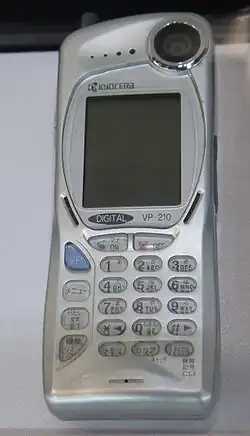
- Camera phone — The Kyocera VP-210 Visual Phone, released in May 1999, was the first commercial camera phone.[255]
- Front-facing camera phone — The Kyocera VP-210 Visual Phone (1999) was the first camera phone with a front-facing selfie camera.[255]
- Mobile videophone — The Kyocera VP-210 (1999) was the first mobile videophone, which also doubled as a camera phone for still photos.[1020]
- Multimedia messaging service (MMS) — Picture messaging was introduced with the J-SH04, released by Sharp Corporation and J-Phone in 2000.[96]
- Long-term evolution (LTE) — Developed by NTT DoCoMo in 2004.[1021]
- 4G (LTE+) — First demonstrated in 2004 by NTT DoCoMo using VSF-OFCDM technology, reaching 1 Gbit/s data rate.[1021]
- 5G — NTT DoCoMo began developing 5G in 2010 and demonstrated it in 2013, reaching up to 10 Gbit/s data rate and super high frequency 11 GHz bandwidth.[1021]
- 6G — Proposed by NTT DoCoMo in January 2019.[1021]
- Mobile phone charm — The earliest mobile phone charms were Hello Kitty charms introduced in Japan during the mid-1990s.[1022]
- Ringtone — In September 1996, IDO sold Denso's Digital Minimo D319, the first mobile phone where a user could input an original melody.[1023]
- Polyphonic ringtone — Dates back to 1999, when Yamaha Corporation's MA-1 sound chip was introduced for phones with four FM synthesis channels.[1024]
- Smartphone — Earliest smartphones with handheld PC and online features in 1990s include Sharp Zaurus, Toshiba Genio, Kyocera DataScope and Matsushita Pinocchio.[337]
- Mobile phone facial recognition — In 2004, Omron developed facial recognition technology for mobile phones.[320]
- Foldable smartphone — The first commercial foldable smartphone was the Kyocera Echo (2011).[1025]
- Multi-camera smartphone — The Sharp Aquos R2 (2018) was the first smartphone with a dual-camera configuration including separate photo camera and video camera.[323]
- Wideband Code Division Multiple Access (W-CDMA) — Between 1996 and 1997, wideband code-division multiple access (W‑CDMA) was developed by NTT DoCoMo for 3G networks.[1017]
Wireless
- Cordless phone with answering machine — In 1989, Sharp Corporation introduced the first low-power cordless phone with an answering machine function.[96]
- Direct broadcast satellite (DBS) — Between 1965 and 1984, the first practical direct broadcast satellite (DBS) service was co-developed by NHK Science & Technology Research Laboratories, NASDA and Toshiba.[1026]
- Hands free Bluetooth car phone — Introduced in 2003 with Honda's 2004 Acura TL.[120]
- Meteor burst communications — The first observation of interaction between meteors and radio propagation was reported by Hantaro Nagaoka in 1929.[1027]
- Mobile computer with wireless Internet — Fujitsu's MV-BIBLO LOOX (2000) was the first mobile computer with built-in wireless Internet data transmission.[293]
- Multi-tube radio transceiver — Matsushita Electric's R-31 (1931) was the first three-tube radio.[1028]
- Pocket radio — The Sony TR-63 (1957) was the first portable transistor radio that could fit in a pocket.[98]
- Near-field communication (NFC) — In March 2002, Sony and Philips established a technology specification for NFC and created a technical outline.[1029]
- Proximity sensor — In February 1960, Omron developed the first contactless proximity switch.[320]
- Automatic door infrared sensor — In 1980, Japanese company OPTEX developed the first automatic door using far infrared sensor technology.[1030]
- Wireless outdoor security sensor — In 1983, OPTEX developed the earliest wireless outdoor security sensor.[1030]
- RC car wheel transmitter — Futaba Corporation's FP-T2F (1974) was the first RC transmitter to allow RC cars to be wirelessly controlled by a wheel controller.[1031]
- Semiconductor microwave communication — In 1963, NEC developed first solid-state electronic semiconductor microwave communications line.[326]
- Transistor repeater — In 1963, NEC developed the first fully transistorized microwave repeaters, using silicon transistors for microwave amplification.[338]
- Digital microwave communication — Between 1963–1968, Masasuke Morita led a team of NEC and NTT engineers in developing the first commercial pulse-code modulation (PCM) digital microwave communications system.[1032]
- Single channel per carrier (SCPC) — In 1973, Fujitsu developed the first SCPC satellite communications system.[293]
- Satellite modem — In 1978, Fujitsu developed the first satellite communications burst modem.[293]
- WiMAX integrated circuit — In 2005, Fujitsu developed the first large-scale integration (LSI) chips for WiMAX-compliant base stations.[293]
- Wireless broadband — In 1980, Seizo Onoe at Kyoto University demonstrated wireless mobile radio transmission at 1.544 megabits per second (Mbit/s).[1010]
- Terahertz band wireless communication (THz) — Tadao Nagatsuma demonstrated 120 GHz wireless with photonics video signal in 2000 and 10 Gbit/s broadband in 2002. In 2014, Minoru Fujishima demonstrated 1 THz RF CMOS signal.[1033]
- Wireless communication with orbital angular momentum multiplexing (OAM) — In 2018, Nippon Telegraph and Telephone (NTT) successfully demonstrated the first 100 Gbit/s wireless transmission using OAM multiplexing.[341]
- Wireless earphones — Onkyo's W800BT range, launched in 2015, were the first wireless in-ear headphones.[1034]
- Wireless game console — The earliest was the TV Tennis Electrotennis (1975) home console by Epoch Co. It connected wirelessly to a TV through ultra high frequency (UHF) antenna technology.[1035]
- Wireless controller — Epoch's TV Tennis Electrotennis (1975).[1035]
- Wireless guitar amplifier — Boss Corporation's KATANA-AIR Wireless Guitar Amplifier (2018) was the first fully wireless guitar amplifier.[136]
- Wireless image sharing — The Ricoh RDC-2S (1996) was the first digital camera with wireless image sharing, using the Personal Handy-phone System (PHS) mobile network.[229]
- Yagi antenna — The Yagi-Uda antenna was invented in 1926 by Shintaro Uda of Tohoku Imperial University, Sendai, Japan, with the collaboration of Hidetsugu Yagi, also of Tohoku Imperial University.[1036]
Transportation
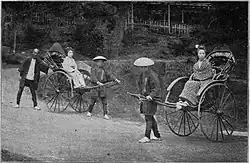
- Attitude direction indicator control display unit (ADI CDU) — In 1975, Matsushita Electric developed a HIS ADI CDU system with CRT display for aircraft cockpit.[54]
- Ruggedized color CRT display — Developed by Toshiba in 1982 for commercial aircraft.[54]
- Avionic CRT display with electrostatic deflection and magnetic deflection — Developed by Sony in 1983.[54]
- Air traffic control (ATC) CRT display — In 1986, Sony developed a large Trinitron CRT display for ATC.[54]
- Diesel engine two-wheel tractor — In 1926, Okayama farmer Nishizaki Hiroshi invented a two-wheel tractor with a diesel engine.[1037]
- Coaxial rotary tiller — Honda's Lucky FU650, launched in 1993, was the first rotary tiller with coaxial rotating tines.[1038]
- Blue LED traffic light — In 1994, Nichia initially commercialized blue LED technology for traffic lights.[526]
- Inverter-controlled high-speed gearless elevator — Introduced by Toshiba in 1985, using IGBT-based inverter-controlled gearless drive system.[110]
- Rickshaw (pulled rickshaw) — A passenger cart serving as human-powered transport. The rickshaw was invented in Japan circa 1869.[1039]
- Spiral escalator — Mitsubishi Electric unveiled the world's first practical spiral escalator in 1985. Spiral escalators take up less space than their conventional counterparts.[1040]
Trains

- Automatic ticket gate — Invented by Omron between 1964 and 1967.[320]
- Bullet train (high-speed rail) — The first commercial high-speed train was Tōkaidō Shinkansen, which began construction in 1959 and opened in 1964.[1041]
- Fuzzy control system — Between 1985 and 1987, Hitachi engineers developed the first practical fuzzy logic control system for the Sendai Subway Namboku Line.[212]
- Hybrid train — JR East's NE Train (2003) was the first commercial hybrid electric railcar.[1042]
- Hydrogen train (hydrail) — JR East's NE Train KuMoYa E995 (2006) was the first commercial hydrogen fuel cell rail vehicle.[1042]
- Battery electric multiple unit (BEMU) — JR East's NE Train Smart Denchi-kun (2009) was an early commercial battery electric train.[1043]
- Piezoelectric walkway — In 2007, East Japan Railway's Tokyo train stations harvested energy from footsteps to power ticket gates and EL displays.[1044]
Watercraft

- Autonomous ship (autonomous cargo ship) — In 2019, Nippon Yusen Kaisha (NYK) conducted the first Maritime Autonomous Surface Ship (MASS) voyage.[1045]
- Fibre-optic submarine communications cable for remotely operated underwater vehicle (ROUV) — Co-designed by A. Nakagawa and demonstrated in 1978.[1046]
- Computer-aided voice control — In 1979, A. Nakagawa at Naval Ocean Systems Center demonstrated computer-aided voice control with telemetry system.[1046]
- Digital data telemetry — In 1980, Nakagawa co-developed the Miniature Optical Stereo Evaluation System (MOSES), a fibre-optic digital telemetry system.[1046]
- Personal watercraft (PWC) — Kawasaki's Jet Ski (1973) was the first stand-up PWC. The Jet Ski was the first commercially successful and practical PWC.[1047]
Other
- Blotting paper — Cosmetic oil blotting paper dates back to the Heian period (794-1185) and gained popularity during the Edo period (1603-1867).[45]
- Hand warmer — The first commercial hand warmer was created by Japanese inventor Niichi Matoba. In 1923, he manufactured the Hakukin-kairo (Hakkin warmer).[1048]
- Japanese typewriter — The first typewriter to be based on the Japanese writing system was invented by Kyota Sugimoto in 1915.[1049]
- Kama (tool)
- Mechatronics — The term "mechatronics" was coined and defined by Tetsuro Mori, an engineer from Yaskawa Electric Corporation, in 1969.[1050]
- Third industrial revolution — Led by Japan during the mid-to-late 20th century, with the country's important role in the optical, semiconductor and information revolutions.[799]
- Wand vibrator — The Hitachi Magic Wand (1968) was the first wand vibrator. Originally designed as a massage device, it later became popular as a sex toy.[1051]
- Washi — The washi papermaking technique was developed in Japan during the Heian period circa 805 to 809.[1052]
Chindōgu
Chindōgu is the Japanese art of inventing ingenious everyday gadgets that, on the face of it, seem like an ideal solution to a particular problem. However, Chindōgu has a distinctive feature: anyone actually attempting to use one of these inventions would find that it causes so many new problems, or such significant social embarrassment, that effectively it has no utility whatsoever. Thus, Chindōgu are sometimes described as "unuseless" – that is, they cannot be regarded as 'useless' in an absolute sense, since they do actually solve a problem; however, in practical terms, they cannot positively be called "useful". The term "Chindōgu" was coined by Kenji Kawakami.
See also
- History of science and technology in Japan
- History of typography in East Asia
- List of automotive superlatives
- List of Chinese inventions
- List of Chinese discoveries
- List of Korean inventions and discoveries
- List of Taiwanese inventions and discoveries
- Science and technology in Japan
- Ten Japanese Great Inventors
References
- ^ Nash, Eric P. (2009). Manga Kamishibai: The Art of Japanese Paper Theatre. Abrams Comicarts. p. 57.
- ^ a b "Eight Years Before Superman, These Were the First Superheroes". IGN. 10 December 2022. Retrieved 3 August 2025.
- ^ Tuova, Diana (22 April 2024). "10 Animated Movies About Robots". Loud And Clear Reviews. Retrieved 1 July 2025.
- ^ Shamoon 2012, p. 58.
- ^ Ortolani, Benito (1995). The Japanese theatre: from shamanistic ritual to contemporary pluralism. Princeton University Press. p. 132. ISBN 0-691-04333-7.
- ^ "Kabuki". Britannica. Retrieved 8 July 2025.
- ^ Hantke, Steffen, ed. (2004). Horror Film. University Press of Mississippi. pp. 123–4. ISBN 9781617034114.
- ^ Maltarich, Bill (2005). Samurai and supermen: national socialist views of Japan. P. Lang. ISBN 3-03910-303-2. OCLC 59359992.
- ^ "折り紙の歴史と現在: 前史" (in Japanese). Kyushu University Library. Retrieved 14 November 2022.
- ^ 折り紙の歴史と現在: 戦国~江戸中期 (in Japanese).
- ^ Nick Robinson (2004). The Origami Bible. Chrysalis Books. p. 18. ISBN 978-1-84340-105-6.
- ^ Heritage, Stuart (5 October 2017). "Takeshi's Castle: welcome back to the king of agony-as-amusement TV". The Guardian. Retrieved 16 November 2021.
- ^ Natalie Avella, Graphic Japan: From Woodblock and Zen to Manga and Kawaii, Rotovision, 2004, p111. ISBN 2-88046-771-3
- ^ Litten, Frederick S. (29 June 2014). "Japanese color animation from ca. 1907 to 1945" (PDF). p. 14. Retrieved 23 September 2020.
- ^ Galbraith 2019, pp. 98–9.
- ^ Richmond, Simon (2009). The Rough Guide to Anime. Penguin Books.
- ^ Dutta, Debopriyaa (5 July 2022). "The Matrix's Original Bullet-Time Method Was A Little Too Risky To Work". SlashFilm. Retrieved 16 June 2025.
- ^ Halverson, Dave (December 2005). "Anime Reviews: The Professional Golgo 13". Play. No. 48. p. 92.
- ^ a b c "日本にフルCGアニメは根付くのか? 第 2 回:木村 卓(アートディレクター、CG アーティスト)". CGWORLD (in Japanese). 27 April 2012. Retrieved 4 August 2025.
- ^ "20 Movies So Bad They Killed The Studios That Made Them". Looper.com. 13 September 2023. Retrieved 4 August 2025.
- ^ a b Lambie, Ryan (15 March 2019). "Megazone 23: The '80s Anime That Tackled Simulated Reality Before The Matrix". Den of Geek. Retrieved 26 May 2025.
- ^ Joel Silver, interviewed in "Scrolls to Screen: A Brief History of Anime" featurette on The Animatrix DVD.
- ^ Person, Lawrence (15 January 2006). "Ghost in the Shell: Stand Alone Complex". Locus Online. Retrieved 7 February 2008.
- ^ "90yo Japanese anime recovered". ABC News (Australia). 27 March 2008. Retrieved 24 July 2025.
- ^ Ornelas, Joseph (18 August 2023). "Steven Spielberg Called This Early Miyazaki Film One of the Greatest Action Films of All-Time". Collider.com. Retrieved 28 July 2025.
- ^ Mattson, Kelcie (31 March 2024). "This Notorious Flop Was the First Film to Use Motion Capture". Collider. Retrieved 9 July 2025.
- ^ Ziegler, John R.; Richards, Leah (9 January 2020). Representation in Steven Universe. Springer Nature. p. 10. ISBN 978-3-030-31881-9. Retrieved 10 November 2021.
- ^ a b Novielli, Maria Roberta (17 January 2018). "From the New Web Perspectives to the Authorial Achievement: Shinkai Makoto". Floating Worlds: A Short History of Japanese Animation. CRC Press. ISBN 978-1-351-33481-5.
- ^ "リヴァイアスイリュージョン その". Infinite Ryvius (Official Site) (in Japanese). TV Tokyo. Retrieved 19 December 2019.
- ^ 10 commandments of Real robot, Gundam Sentinel introduction, Gundam workshop, Format ACG
- ^ a b Cavallaro, Dani (2015). The Art of Studio Gainax: Experimentation, Style and Innovation at the Leading Edge of Anime. McFarland & Company. p. 41. ISBN 978-1-4766-0070-3.
- ^ "HADOUKEN! The story behind Street Fighter's most iconic move". GamesRadar+. 2 July 2017. Retrieved 4 August 2025.
- ^ 岡田斗司夫『オタク学入門』太田出版、1996年、30頁
- ^ Jolliffe, Tom (5 June 2021). "The Groundhog Day Formula". Flickering Myth. Retrieved 4 August 2025.
- ^ Grebey, James (9 March 2023). "Everything We Know About The Super Mario Bros. Movie". Rotten Tomatoes. Retrieved 5 August 2025.
- ^ Eisenbeis, Richard (7 September 2012). "The Fictional (Yet Amazingly Popular) Singers of Japan". Kotaku. Retrieved 16 April 2020.
- ^ Rattray, Tim (25 June 2018). "From Macross to Miku: A History of Virtual Idols". Crunchyroll. Retrieved 16 April 2020.
- ^ a b c Kovacic, Ivana (14 August 2020). Nonlinear Oscillations: Exact Solutions and their Approximations. Springer Nature. pp. 1–2. ISBN 978-3-030-53172-0.
- ^ "Buddhist Monuments in the Horyu-ji Area". UNESCO World Heritage. Retrieved 2 April 2007.
- ^ Chow, Elaine (5 November 2008). "Soken E-Ink Wall Looks Tacky But Promising". Gizmodo. Retrieved 6 August 2025.
- ^ Inoue, Munekazu (1959). Castles of Japan. Association of Japanese Castle.
- ^ Fujita Masaya, Koga Shūsaku, ed. (10 April 1990). Nihon Kenchiku-shi (in Japanese) (30 September 2008 ed.). Shōwa-dō. ISBN 978-4-8122-9805-3.
- ^ Slavin, Erik (25 March 2007). "My months in a love hotel". Stars and Stripes. Retrieved 17 January 2022.
- ^ Lin, Z. (2010). Kenzo Tange and the Metabolist Movement. Routledge. p. 23.
- ^ a b c d e f g h i "18 Japanese Inventions We Would Be Lost Without". Matcha. 29 October 2024. Retrieved 17 August 2025.
- ^ "World Trade Center architect Minoru Yamasaki wanted 'living symbol' for humanity". Federal Way Mirror. 8 September 2011. Retrieved 12 August 2020.
- ^ Prince, Stephen (6 November 2015). "Kurosawa's international legacy". Rashomon Effects: Kurosawa, Rashomon and their legacies. Routledge. p. 132. ISBN 978-1-317-57464-4. Retrieved 21 April 2022.
- ^ Billson, Anne (30 October 2018). "Why is Seven Samurai so good?". BBC Culture. BBC. Retrieved 31 May 2020.
- ^ a b c d Sherlock, Ben (13 December 2020). "10 Ways Akira Kurosawa Has Influenced Modern Blockbusters". Screen Rant. Retrieved 21 April 2022.
- ^ Gladman, Andrew (4 August 2024). "The Connection Between Akira Kurosawa's The Hidden Fortress and Star Wars, Explained". Comic Book Resources. Retrieved 9 July 2025.
- ^ Sheldon Hall; Stephen Neale (30 April 2010). Epics, Spectacles, and Blockbusters: A Hollywood History. Wayne State University Press. p. 298. ISBN 978-0814330081 – via Google Books.
- ^ a b "FilmInt". Film International. 4 (1–6). Kulturrådet: 163. 2006.
- ^ Sterling, R.D.; Bleha, W.P. "Electronic Cinema Using ILA Projector Technology" (PDF). JVC. Hughes-JVC Technology Corporation. Retrieved 16 January 2024.
- ^ a b c d e f g h i j k l m n o p q r s t u v w x y z aa ab ac "Archives". Society for Information Display. Retrieved 18 July 2025.
- ^ "History: 90th Anniversary Special". Imagica. Retrieved 3 August 2025.
- ^ Sam Stone (14 April 2020). "Mortal Kombat Legends' Jeremy Adams Explains How Scorpion's Revenge Adapts the Game". Comic Book Resources. Retrieved 7 June 2020.
- ^ Japan Pop!: Inside the World of Japanese Popular Culture, p. 262 ISBN 0-7656-0560-0
- ^ McCoy, Joshua Kristian (18 June 2024). "Could Ultraman Have A Massive Worldwide Franchise Like Godzilla?". Game Rant. Retrieved 23 November 2024.
- ^ Disse, Diane. "The Birth of IMAX". IEEE. IMAX Corp. Retrieved 8 July 2025.
- ^ a b Ching, Gene (24 July 2021). "Snake Eyes, Storm Shadow, and the Legacy of Ninja Movies". Den of Geek. Retrieved 28 May 2025.
- ^ Gerow, Aaron, ed. (2012). "The Sword and The Screen: The Japanese Period Film 1915–1960". Film Series Commentaries. Yale University Council on East Asian Studies.
- ^ "Amazon.com: The Great Buddha Arrival : Hiroto Yokokawa: Prime Video". www.amazon.com. Retrieved 30 April 2023.
- ^ a b Millennial Monsters: Japanese Toys and the Global Imagination, pp. 47–48. ISBN 0-520-24565-2
- ^ Chute, Harrison (13 January 2023). "Best Video Game Adaptations That Prove They're Not All Terrible". Collider. Retrieved 15 September 2024.
- ^ Bordwell, p. 78
- ^ Ebert, Roger (19 December 2012). "Ozu: The Masterpieces You've Missed". Roger Ebert's Film Journal. Retrieved 19 May 2015.
- ^ Urquhart, Jeremy (26 April 2024). "Action Movies Wouldn't Be the Same Today Without Akira Kurosawa's 'Seven Samurai'". Collider. Retrieved 10 June 2025.
- ^ a b Prince, Stephen (1 January 2001). Screening Violence 1. A&C Black. pp. 178–185. ISBN 978-0-485-30095-6.
- ^ "HOLOSYS+". Crescent Inc. (in Japanese). Retrieved 2 August 2025.
- ^ "Deja-view: The best time-loop movies and shows for one lifetime". Hindustan Times. 12 March 2021. Retrieved 14 June 2025.
- ^ 百科年鑑 [Encyclopedia Yearbook] (in Japanese). Heibonsha. 1984. p. 100 – via Google Books.
- ^ "「元祖」ゴジラ・スーツアクター中島春雄". Nippon.com (in Japanese). 23 July 2014. Retrieved 19 April 2023.
- ^ Schilling 2003, pp. 314.
- ^ Kern, Adam (2006). Manga from the Floating World: Comicbook Culture and the Kibyōshi of Edo Japan. Harvard University Press. pp. 139–144 (Fig. 3.3). ISBN 978-0-674-02266-9.
- ^ Kageyama, Y. "A SHORT HISTORY OF JAPANESE MANGA". Retrieved 1 October 2017.
- ^ Alt, Matt (18 June 2021). ""Demon Slayer": The Viral Blockbuster from Japan". The New Yorker. Retrieved 17 August 2025.
- ^ "What is cyberpunk?". Polygon. 30 August 2018.
- ^ Kurten, Guillermo (7 October 2022). "10 Best Anime Set In The Distant Past". Screen Rant. Retrieved 22 May 2025.
- ^ Ekens, Gabriella (27 May 2016). "What Makes Magical Girls So Popular?". Anime News Network. Retrieved 7 December 2020.
- ^ Huff, Sid L.; Barnes, Stuart J (1 November 2003). Rising Sun: iMode and the Wireless Internet, Vol. 46, No. 1. Communications of the ACM. pp. 79–84.
- ^ Gilson, Mark (1998). "A Brief History of Japanese Robophilia". Leonardo. 31 (5): 367–369 [368]. doi:10.2307/1576597. JSTOR 1576597. S2CID 191411400.
- ^ Johnston, Rich (20 June 2017). "Japan's First Transforming Robot, Tank Tankuro By Gajo Sakamoto, Reissued By Fantagraphics". Bleeding Cool News And Rumors. Retrieved 11 July 2017.
- ^ "Game Center Arashi's Best Selection Compilation Book Includes First New Chapter in 35 Years". Anime News Network. 16 November 2019. Retrieved 21 June 2025.
- ^ "Why Are There So Many Parallel World Anime?". Anime News Network. 31 January 2017. Retrieved 9 February 2019.
- ^ Kato, Shuichi (1979). A History of Japanese Literature: The First Thousand Years. David Chibbett. New York: Kodansha International, Ltd. pp. 160, 163. ISBN 0-87011-491-3.
- ^ a b Tyler, Royall (2003). The Tale of Genji. Penguin Classics. p. xxvi. ISBN 0-14-243714-X.
- ^ Hijiya-Kirschnereit, Irmela (1996). Rituals of self-revelation : Shishōsetsu as literary genre and socio-cultural phenomenon. Council on East Asian Studies, Harvard University. ISBN 0-674-77319-5. OCLC 461943570.
- ^ Steinberg, Marc (2015). Naze nihon wa media mikkusu suru kuni nanoka. Translated by Nakagawa, Yuzuru. Translation supervised by Eiji Ōtsuka. Kadokawa. pp. 241–242. ISBN 978-4-04-080019-6. OCLC 907893641.
- ^ Charity, Justin (19 July 2018). "The Japanese Thriller That Explains 'Fortnite' and American Pop Culture in 2018". The Ringer.
- ^ "Cell phone novels come of age". Japan Today. 26 January 2009. Retrieved 10 February 2020.
- ^ a b c Nathan, Richard (10 October 2017). "Ahead of Time: Japan's early science fiction". Red Circle Authors. Retrieved 1 July 2025.
- ^ "Once Upon a Time". Emerald City (85). September 2002.
- ^ Frisch, Benjamin (1 October 2021). "The Best Time-Loop Story Out There Is on the PS5". Slate. ISSN 1091-2339. Retrieved 10 June 2025.
- ^ Torrance, Richard (2005). "Literacy and Literature in Osaka, 1890–1940". The Journal of Japanese Studies (31). Society for Japanese Studies: 56.
- ^ Redoblado, Simoun Victor (3 May 2022). "10 Films Told From The Perspective Of An Unreliable Narrator". Collider. Retrieved 13 June 2025.
- ^ a b c d e f g h i j k l "Product Story". Sharp Corporation. Retrieved 30 May 2025.
- ^ "Continuous-time sigma-delta modulation". Continuous-Time Sigma-Delta Modulation for A/D Conversion in Radio Receivers. The International Series in Engineering and Computer Science. Vol. 634. Springer Publishing. 2001. pp. 29–71. doi:10.1007/0-306-48004-2_3. ISBN 9780306480041.
- ^ a b c d e f g h i Genryu: Sony 50th Anniversary. Sony. 1996. Retrieved 1 August 2025.
- ^ a b c d e Fine, Thomas (2008). Barry R. Ashpole (ed.). "The Dawn of Commercial Digital Recording" (PDF). ARSC Journal. 39 (1). Ted P. Sheldon: 1–17. Retrieved 2 May 2010.
- ^ a b c d e f Anazawa, Takeaki (March 1993). Historical Development of Analog Disk Recording Technology and Artifacts Now in Existence (PDF). Center of the History of Japanese Industrial Technology (National Museum of Nature and Science).
- ^ a b c Immink, K. (December 2007). "Shannon, Beethoven, and the Compact Disc" (PDF). IEEE Information Theory Newsletter. IEEE. pp. 42–6. Retrieved 5 August 2025.
- ^ "Inside Denon: A Legacy of Firsts". Denon. Retrieved 29 June 2025.
- ^ "Product History". Stax Ltd. 19 July 2018. Retrieved 5 August 2025.
- ^ Becky Scarrott (2 June 2022). "Lightning headphones: are they good? Do they have a future?". What Hi-Fi?. Retrieved 16 June 2025.
- ^ a b c d e f g h i j k "Product & Technology Milestones". Sony. Retrieved 8 June 2025.
- ^ a b Duncan, Ben (1996). High Performance Audio Power Amplifiers. Elsevier. pp. 177–8, 406. ISBN 9780080508047.
- ^ a b "Story". Sony. Retrieved 25 July 2025.
- ^ Wyatt, Hilary (18 July 2013). Audio Post Production for Television and Film: An introduction to technology and techniques. Taylor & Francis. p. 13. ISBN 978-1-136-12005-3.
- ^ a b Saunders, Jarrah (29 May 2023). "Gear Icons: Pioneer DJ". Mixdown. Furst Media. Retrieved 3 August 2023.
- ^ a b c d e f g h i j k l m n o p q r s t u v w x y "History". Toshiba. Retrieved 9 June 2025.
- ^ a b c d Gray, Robert M. (2010). "A History of Realtime Digital Speech on Packet Networks: Part II of Linear Predictive Coding and the Internet Protocol" (PDF). Found. Trends Signal Process. 3 (4): 203–303. doi:10.1561/2000000036. ISSN 1932-8346.
- ^ Fischer, Walter (9 January 2008). Digital Video and Audio Broadcasting Technology: A Practical Engineering Guide. Springer Science & Business Media. p. 144. ISBN 978-3-540-76358-1.
- ^ "AAC Licensors". Via Corp. Retrieved 15 January 2020.
- ^ a b Lidz, Franz (December 2012). "Dr. NakaMats, the Man With 3300 Patents to His Name". Smithsonian Magazine. Retrieved 15 October 2014.
- ^ a b "Built on 110 years of innovation". Denon. Retrieved 29 June 2025.
- ^ a b c d e "Olympus Chronology". Olympus Corporation. Retrieved 26 June 2025.
- ^ Mark Batey (2016), Brand Meaning: Meaning, Myth and Mystique in Today's Brands (Second ed.), Routledge, p. 140
- ^ "Sony Celebrates Walkman 20th Anniversary". Sony Press Release. Retrieved 4 May 2009.
- ^ a b "History of the Sony Walkman". Crutchfield. Retrieved 28 July 2025.
- ^ a b c d e Wright, Ian (25 January 2022). "9 Automotive Firsts We Take For Granted". CarBuzz. Retrieved 6 June 2025.
- ^ "Development of a 22.2 Multichannel Sound System". NHK Science & Technology Research Laboratories. Broadcast Technology (No. 25). Winter 2006. Retrieved 26 June 2025.
- ^ Hutton, Ray (1985). "8: The third generation". The Z-series Datsuns: a collector's guide (Second ed.). Motor Racing Publications Ltd. pp. 83–93 (92–3). ISBN 0-947981-02-0.
- ^ a b c d e f Reid, Gordon (2005). "The History of Roland". Sound on Sound. Retrieved 7 June 2025.
- ^ "Roland – D-50 30th Anniversary".
- ^ Vail, Mark (2014). The Synthesizer. Oxford University Press. p. 63. ISBN 978-0195394894.
- ^ Shore, Alex (13 May 2013). "An Analysis of Roland's Super Saw Oscillator and its Relation to Pads within Trance Music" (PDF).
- ^ "Firstman SQ-01 Sequencer". Keyboard Report. Contemporary Keyboard. Vol. 7, no. October 1981. 1981. pp. 82, 88. ("Keyboard Report, Oct. '81", according to the "Vol.9, 1983". Contemporary Keyboard. 1983.)
- ^ "Acid House Entry". AllMusic.
- ^ Laughton, Jay (5 April 2017). "Tribute: Ikutaro Kakehashi and Roland's Impact on Music". Reverb.com. Retrieved 3 June 2025.
- ^ a b c "The History of Boss Compact Pedals". Roland Corporation. Retrieved 1 July 2025.
- ^ a b c Russ, Martin (2012). Sound Synthesis and Sampling. CRC Press. pp. 192, 346. ISBN 978-1136122149.
- ^ "SYNC24USB: Sync your TR-808 and other DIN sync gear via a USB cable". Gearnews. 13 December 2017. Retrieved 22 July 2025.
- ^ "Yamaha GS-1". Vintage Synth Explorer. Retrieved 31 May 2025.
- ^ a b "Yamaha Synth 40th Anniversary: History". Yamaha Corporation. 2014. Retrieved 5 August 2025.
- ^ Jenkins, Mark (19 October 2009). Analog Synthesizers: Understanding, Performing, Buying—From the Legacy of Moog to Software Synthesis. Taylor & Francis. p. 108. ISBN 978-1-136-12277-4.
- ^ a b Panara, Kerry (2 July 2020). "The History and Evolution of the Accordion". Roland Corporation. Retrieved 1 July 2025.
- ^ Trevor Pinch, Karin Bijsterveld, The Oxford Handbook of Sound Studies, page 515, Oxford University Press
- ^ "Company information". AlphaTheta. Retrieved 29 July 2025.
- ^ a b c "History: Timeline of V-Drums Innovation". Roland Corporation. Retrieved 28 July 2025.
- ^ a b c d e f "History". Roland Corporation. Retrieved 1 July 2025.
- ^ "Rockeyboard RB-1". Hillwood Keyboard / Synthesizer Catalog 1977. Hillwood Musical Instrument/Zen-On.
- ^ Leete, Norm (August 1999). "Roland GR-Series". Sound on Sound. Retrieved 1 July 2025.
- ^ a b c Reid, Gordon (2002). "The History of Korg". Sound on Sound. Retrieved 1 July 2025.
- ^ a b "Tuner History". Boss Corporation. Retrieved 1 July 2025.
- ^ [[Keyboard (magazine)|Contemporary Keyboard]]. Vol. 7, Issues 1–6. Keyboard Players International. 1981. pp. 1, 53–4.
{{cite book}}: URL–wikilink conflict (help) - ^ Loops and Grooves: The Musician's Guide to Groove Machines and Loop Sequencers. Hal Leonard Corporation. 2003. pp. 32–3. ISBN 978-0-634-04813-5.
- ^ Lizzy (October 1984). "High IQ". Electronic Soundmaker & Computer Music (Oct 1984): 15–16.
- ^ Jenkins, Mark (February 1995). "Susurrant synthesis". The Mix (Feb 1995): 18–22.
- ^ Holmes, Thom (22 May 2012). Electronic and Experimental Music: Technology, Music, and Culture. Routledge. p. 262. ISBN 978-1-136-46895-7.
- ^ a b c "Yamaha History: Personal Computers". Yamaha Corporation. Retrieved 17 July 2025.
- ^ "MZ-80K: The monitor program SP-1002". SharpMZ.org. 1 September 2002. Retrieved 19 September 2012.
- ^ Rockin'f, March 1982, pages 140–141
- ^ Wiffen, Paul (June 1994). "Multitimbrality: A Brief History". Sound on Sound. Retrieved 1 July 2025.
- ^ Molenda, Mike; Pau, Les (2007). The Guitar Player Book: 40 Years of Interviews, Gear, and Lessons from the World's Most Celebrated Guitar Magazine. Hal Leonard. p. 222. ISBN 9780879307820.
- ^ Aikin, Jim (2003). Software Synthesizers: The Definitive Guide to Virtual Musical Instruments. Backbeat Books. p. 4. ISBN 978-0879307523.
- ^ Jenkins, Mark (2009). Analog Synthesizers: Understanding, Performing, Buying—From the Legacy of Moog to Software Synthesis. CRC Press. p. 89. ISBN 978-1-136-12278-1.
- ^ "20 years of Vocaloid history". Vocaloid. Yamaha. 3 December 2024. Retrieved 1 July 2025.
- ^ Ciarcia, Steve (1979). Ciarcia's Circuit Cellar. Circuit Cellar. pp. 207–16. ISBN 978-0-07-010966-7.
- ^ "Yamaha Combo Keyboard Instruments: GS1 / GS2". Yamaha. Retrieved 29 June 2025.
- ^ "LA32". Video Game Music Preservation Foundation. Retrieved 26 June 2025.
- ^ Carter, Chris (May 2001). "Roland SPV355". Sound on Sound. Retrieved 29 June 2025.
- ^ Ellis, David (October 1984). "Yamaha CX5M". Electronics & Music Maker: 82–84.
- ^ Lendino, Jamie (17 June 2019). Faster Than Light: The Atari ST and the 16-Bit Revolution. Steel Gear Press. p. 164. ISBN 978-1-7323552-1-7.
- ^ a b "Q&A with Isao Tomita". Tokyo Weekender. 21 January 2013. Retrieved 6 August 2025.
- ^ Male, Andrew (3 April 2023). "Ryuichi Sakamoto And Yellow Magic Orchestra: The Ten Best Albums". Mojo. Retrieved 9 March 2025.
- ^ a b c Yoo, Noah (7 March 2021). "Yellow Magic Orchestra: BGM". Pitchfork. Retrieved 7 March 2021.
- ^ "Ryoji Ikeda: Ultratronics". Pitchfork.com. 2022. Retrieved 6 August 2025.
- ^ Carter, Monica (30 June 2011). "It's Easy When You're Big in Japan: Yellow Magic Orchestra at the Hollywood Bowl". The Vinyl District (accessed 22 July 2011).
- ^ "Sakamoto and Yamaha Synthesizers". Yamaha. Retrieved 28 February 2025.
- ^ a b Lufkin, Bryan (16 June 2012). "Proto Synthpop Turned Yellow Magic Orchestra Into Godfathers of Electro". Wired.com. Retrieved 6 August 2025.
- ^ a b Clenney, Chuck (4 October 2022). "Did Japan Invent Hip-Hop?". UnderMain Magazine. Retrieved 8 March 2025.
- ^ "Which underrated artists paved the way for these bigger stars?". BBC Music. 2 June 2018. Retrieved 6 August 2025.
- ^ Bocaro, Madeline (25 April 2020). "Behind The Mask". Madelinex. Retrieved 10 February 2025.
- ^ a b c Reynolds, Simon (2 April 2023). "Ryuichi Sakamoto's Borderless Brilliance". Pitchfork. Retrieved 6 March 2025.
- ^ Barsanti, Sam (2 April 2023). "R.I.P. Ryuichi Sakamoto, Oscar-winning composer". AV Club. Retrieved 3 March 2025.
- ^ a b c d Jones, Mikey (22 January 2015). "The Essential... Yellow Magic Orchestra". Fact. Retrieved 3 March 2025.
- ^ Hobbs, Mary Anne (9 December 2020). "In praise of the 808 – 8 essential tracks to celebrate the drum machine that changed the world". BBC Radio 6 Music. BBC. Retrieved 3 March 2025.
- ^ Suzuki, Soichiro (2015). "Recording Techniques: Haruomi Hosono and Yasuhiko Terada on S-F-X & Medicine Compilation". Hosono Haruomi Rokuon‑jutsu: Bokura wa Kōshite Oto wo Tsukutte Kita (in Japanese). Du Books. ISBN 978-4-907583-69-9.
- ^ Matthews, Ethan (26 April 2024). "Discography: Yellow Magic Orchestra". Tastemakers Music Magazine. Retrieved 23 June 2025.
- ^ Yellow Magic Orchestra at AllMusic. Retrieved June 3, 2009.
- ^ "Colored Music – Colored Music (Club Edit) / Heartbeat (Club Edit) · Single Review ⟋ RA". Resident Advisor. Retrieved 30 June 2025.
- ^ a b Takahashi, Logan (8 August 2016). "Teengirl Fantasy's Logan Takahashi Gives Us the Lowdown on Ryuichi Sakamoto's Most Influential Releases". Vice. Retrieved 7 March 2025.
- ^ Harich-Scheider, Eta (1973) [1922]. A History of Japanese Music. London: Oxford University Press. p. 520. ISBN 0-19-316203-2.
- ^ Ramage, Maxwell (2023). "The Royal Road Progression in Japanese Popular Music". Music Theory Spectrum. 45 (2): 238–256. doi:10.1093/mts/mtad008.
- ^ 究極のビートルズ来日賞味法! ビートルズが日本に与えたもの (in Japanese). Oricon. 21 June 2006. Retrieved 9 January 2009.
- ^ Kimura, Yutaka (September 2002). ジャパニーズ・シティ・ポップ : Selected 500 over titles of albums [Japanese City Pop : Selected 500 over titles of albums]. Disc guide series : The DIG presents ; 10 (in Japanese). Shinko Music. p. 2. ISBN 978-4-401-61773-9.
- ^ Ohanesian, Liz (13 April 2011). "Japanese Indie Pop: The Beginner's Guide to Shibuya-Kei". LA Weekly.
- ^ "Japanese Innovators: Pioneers in Experimental Sounds". Barbican Centre. 2018. Retrieved 30 June 2025.
- ^ Chapman, Ian; Johnson, Henry (12 February 2016). Global Glam and Popular Music: Style and Spectacle from the 1970s to the 2000s. Routledge. pp. 199–213. ISBN 978-1-317-58819-1.
- ^ "Nothing Personal: Babymetal Don't Like Answering Questions". Noisey. 15 July 2014. Retrieved 23 October 2016.
- ^ a b "Watch your step: why the 10,000 daily goal is built on bad science". The Guardian. 3 September 2018. Retrieved 14 August 2025.
- ^ a b c d e f g h i Otsuka, M. (2007). "Contributions to the field of neurotransmitters by Japanese scientists". Proceedings of the Japan Academy. 83 (2): 47–64. Bibcode:2007PJAB...83...47O. doi:10.2183/pjab.83.47. PMC 3756739. PMID 24019584.
- ^ Zimbro, M.J.; et al., eds. (2009). Difco & BBL Manual (PDF) (2nd ed.). Becton Dickinson and Company. p. 6.
- ^ a b c d e f g h i j k l m n o p q r s t u v w x "The Asahi Prize". The Asahi Shimbun. Asahi Prize. Retrieved 13 July 2025.
- ^ Goffeau, André (December 2005). "Multiple moulds". Nature. 438 (7071): 1092–1093. Bibcode:2005Natur.438.1092G. doi:10.1038/4381092b. PMID 16371993.
- ^ Forterre, Patrick; et al. (1 April 2018). "History of CRISPR-Cas". Journal of Bacteriology. 200 (7): e00580–17. doi:10.1128/JB.00580-17. ISSN 0021-9193. PMC 5847661. PMID 29358495.
- ^ Fukuzawa, Masakatsu; et al. (1 December 2012). "History of endoscopic submucosal dissection and role for colorectal endoscopic submucosal dissection: A Japanese perspective". Gastrointestinal Intervention. 1 (1): 30–35. doi:10.1016/j.gii.2012.09.001. ISSN 2213-1795.
- ^ Mestler, GE (April 1956). "A galaxy of old Japanese medical books with miscellaneous notes on early medicine in Japan. III. Urology, syphilology and dermatology; surgery and pathology". Bull Med Libr Assoc. 44 (2): 125–59. PMC 199999. PMID 13304528.
- ^ Ishizaka, K.; et al. (1966). "Physico-chemical properties of human reaginic antibody. IV. Presence of a unique immunoglobulin as a carrier of reaginic activity". J. Immunol. 97 (1): 75–85. doi:10.4049/jimmunol.97.1.75. PMID 4162440. S2CID 255620017.
- ^ Scudellari, Megan (16 June 2016). "How iPS cells changed the world". Nature. 534 (7607): 310–312. Bibcode:2016Natur.534..310S. doi:10.1038/534310a. PMID 27306170.
- ^ Moitra, Karobi (December 2013). A Journey Through Genetics, Part I. Biota Publishing. p. 49. ISBN 978-1615046416.
- ^ Okazaki R, Okazaki T, Sakabe K, Sugimoto K (June 1967). "Mechanism of DNA replication possible discontinuity of DNA chain growth". Japanese Journal of Medical Science & Biology. 20 (3): 255–60. PMID 4861623.
- ^ a b c d "History". Nihon Kohden. Retrieved 9 August 2025.
- ^ Raichurkar, P.; et al. (June 2024). "Adopters of Innovation in a Crisis". Annals of Surgery Open. 5 (2): e422. doi:10.1097/AS9.0000000000000422. ISSN 2691-3593. PMC 11191903. PMID 38911635.
- ^ Miki, Makoto; et al. (November 2003). "Transurethral resection in saline (TURis)". The Japanese Journal of Urology. 94 (7): 671–677. doi:10.5980/jpnjurol1989.94.671. ISSN 0021-5287. PMID 14671997.
- ^ a b Okoshi, Takanori (June 1972). Three-Dimensional Imaging Techniques. Elsevier (published 2 December 2012). pp. 248, 360, 366, 391. ISBN 978-0-323-15132-0.
- ^ Aoki, Sadao; Kikuta, Seishi (1974). "X-Ray Holographic Microscopy". Japanese Journal of Applied Physics. 13 (9): 1385–1392. Bibcode:1974JaJAP..13.1385A. doi:10.1143/jjap.13.1385. ISSN 0021-4922. S2CID 121234705.
- ^ a b c d "Fujifilm's 90-Year History". Fujifilm. 2024. Retrieved 1 July 2025.
- ^ a b c "Milestones". JEOL. Retrieved 17 July 2025.
- ^ "History". Sumitomo Heavy Industries, Ltd. Retrieved 9 July 2025.
- ^ Sheppard, Colin (3 November 2009). "Confocal Microscopy. The Development of a Modern Microscopy". Imaging & Microscopy. Retrieved 5 August 2025.
- ^ a b c d "History". Hitachi. Retrieved 2 August 2025.
- ^ a b García-Villena, J.; et al. (2021). "3D-Printed Portable Robotic Mobile Microscope for Remote Diagnosis of Global Health Diseases". Electronics. 10 (19): 2408. doi:10.3390/electronics10192408.
- ^ Li, J.; et al. (August 2017). "The History and Innovation of Home Blood Pressure Monitors". IEEE History of Electrotechnology Conference: 82–86. doi:10.1109/HISTELCON.2017.8535736.
- ^ a b c "Appendix" (PDF). Olympus Corporation. 2021. pp. 38–44. Retrieved 26 June 2025.
- ^ a b "Innovation History" (PDF). Olympus Corporation. One Olympus Report. 2017. pp. 6–7. Retrieved 26 June 2025.
- ^ Ikeda S, Tobayashi K, Sunakura M, Hatakeyama T, Ono R (August 1969). "[Diagnosis using a fiberscope—the respiratory organs]". Naika (in Japanese). 24 (2): 284–91. PMID 5352887.
- ^ Kobayashi T, Koshiishi H, Kawate N, A dela Cruz CM, Kato H (1994). "The Performance of Prototype Videobronchoscopes: The Pentax Eb-Tm1830 and Eb-Tm1530". Journal of Bronchology & Interventional Pulmonology. 1 (2): 160–167.
- ^ "PENTAX launches first HD video bronchoscope". Fierce Biotech. 25 September 2011. Retrieved 26 June 2025.
- ^ a b c "Milestones: The High Definition Television System, 1964–1989". ETHW. IEEE Milestones. 11 May 2016. Retrieved 8 July 2025.
- ^ a b c d e f g h i j "History". JVC Healthcare. JVC. Retrieved 24 July 2025.
- ^ a b c d "Basic Facts About Nippon Steel & Sumitomo Metal" (PDF). Nippon Steel & Sumitomo Metal. 2015. Retrieved 9 July 2025.
- ^ a b c d e f g h i j k l "The History of Canon". Canon Inc. Retrieved 17 July 2025.
- ^ a b "Dr. Taro Takemi". Harvard School of Public Health. 14 October 2024. Retrieved 14 August 2025.
- ^ a b "Company History". Fukuda Denshi. Retrieved 9 August 2025.
- ^ "EIZO Introduces Industry First Multi-Modality Color Monitor with FDA 510(k) Clearance for Mammography". Eizo. 14 November 2012. Retrieved 24 July 2025.
- ^ "The Evolution of Medical Imaging Displays". Imaging Technology News. 8 July 2013. Retrieved 24 July 2025.
- ^ GB1278673A, "Holographic camera", issued 21 June 1972
- ^ a b c d e f g h i j k l m "World's Firsts". Digital Camera Museum. Retrieved 1 July 2025.
- ^ a b c d e f g h Wade, John (10 October 2024). "140 years – A lifetime of landmark cameras". Amateur Photographer. Retrieved 1 July 2025.
- ^ "How 'playing Puri' paved the way for Snapchat". BBC. 23 November 2018. Retrieved 16 September 2019.
- ^ a b "The history of fluorite lenses". Canon Inc. Retrieved 1 August 2025.
- ^ a b c d e f g h i j k "Our Product History". Nikon. Retrieved 7 July 2025.
- ^ Colton, Sandy (29 April 1988). "New Bridge Cameras Offer Perks To Novice And Pro Alike". Chicago Tribune. p. 96, section 7.
- ^ a b c d e f g Peres, Michael R. (2007). The Focal Encyclopedia of Photography: Digital Imaging, Theory and Applications, History, and Science. Taylor & Francis. pp. 778–81. ISBN 978-0-240-80740-9.
- ^ a b Sato, Haruo. "The Thousand and One Nights No. 17". Nikon. Retrieved 10 July 2025.
- ^ a b Honeywell Pentax ES Operating Manual (PDF). Honeywell Pentax. 1971.
- ^ Delbrück, Tobi (6 July 2020). "The Slow But Steady Rise of the Event Camera". EE Times. Retrieved 9 July 2025.
- ^ Miyamoto, Kenro (1964). "Fish Eye Lens". Journal of the Optical Society of America. 54 (8): 1060–1061. Bibcode:1964JOSA...54.1060M. doi:10.1364/JOSA.54.001060.
- ^ US Grant 3524697, Isshiki Masaki & Matsuki Keiji, "Achromatic super wide-angle lens", issued 18 August 1970, assigned to Nikon Corp.
- ^ a b c d e "Course of History". Ricoh Imaging. Pentax. Retrieved 7 July 2025.
- ^ "Konica F instruction booklet". Konishiroku Photo Ind. Co., Ltd. April 1960. pp. 25–6.
- ^ a b American Photo. Vol. 6 (No. 6). November–December 1995. p. 74. ISSN 1046-8986.
- ^ a b c "Japan Invented the Selfie Stick. In 1983". Kotaku. 8 April 2015. Retrieved 30 June 2025.
- ^ Stephen, Gandy. "Nikon Shibata Book". Stephen Gandy's CameraQuest. Retrieved 8 June 2008.
- ^ "Waterproof Cameras: Dedication to meeting and exceeding customer needs". Olympus Corporation. Retrieved 7 July 2025.
- ^ Fossum, E. (12 July 1993). "Active pixel sensors: Are CCDs dinosaurs?". In Blouke, Morley M. (ed.). Charge-Coupled Devices and Solid State Optical Sensors III. Vol. 1900. pp. 2–14. Bibcode:1993SPIE.1900....2F. CiteSeerX 10.1.1.408.6558. doi:10.1117/12.148585. S2CID 10556755.
- ^ a b c d e f g "History". Mitsubishi Electric. Retrieved 10 July 2025.
- ^ US patent 7521335, Yamanaka, Hideo, "Method and apparatus for producing ultra-thin semiconductor chip and method and apparatus for producing ultra-thin back-illuminated solid-state image pickup device", issued 21 April 2009, assigned to Sony
- ^ "Sony Develops "Exmor RS," the World's First*1 Stacked CMOS Image Sensor". Sony. 20 August 2012. Retrieved 16 August 2015.
- ^ Ochi, S.; et al. (February 1978). "A Device Structure and Spatial Spectrum for Checker-Pattern CCD Color Camera". IEEE Journal of Solid-State Circuits. 13 (1): 187–192. Bibcode:1978IJSSC..13..187O. doi:10.1109/JSSC.1978.1051013. ISSN 0018-9200.
- ^ a b "Tech timeline: Milestones in sensor development". Digital Photography Review. 17 March 2023. Retrieved 20 July 2025.
- ^ "Fujifilm launches world's first 3D imaging system". DPReview. 22 July 2009. Retrieved 6 August 2025.
- ^ a b "A brief history of mirrorless cameras". Engadget. 15 April 2019. Retrieved 28 September 2024.
- ^ a b c "When was the digital camera invented and other fun facts about digital cameras". iMore. 30 September 2020. Retrieved 7 August 2025.
- ^ "Contax Introduces N Digital Camera, World's First Digital SLR With Full-Frame 6.29 Mega Pixel Sensor". Kyocera. 24 February 2002. Retrieved 30 June 2025.
- ^ a b c "Oldest camera with live screen: The Casio QV-10 from 1995". Digitec. 13 July 2020. Retrieved 7 August 2025.
- ^ "Nikon Coolpix S800c review". Amateur Photographer. Retrieved 7 August 2025.
- ^ Ochi, Shigeyuki; et al. (15 November 2022). Charge-Coupled Device Technology. Taylor & Francis. p. 139. ISBN 978-1-351-46172-6.
- ^ "The Global Demand for Lithium Is Set to Grow". Nasdaq. 22 July 2022. Retrieved 29 July 2025.
- ^ Slaymaker, James (28 November 2024). Essay Cinema in the Digital Era. Springer Nature. p. 60. ISBN 978-3-031-74042-8.
- ^ "The Consumer Electronics Hall of Fame: Sony DCR-VX1000". IEEE Spectrum. 3 January 2019. Retrieved 16 July 2025.
- ^ "7 Times New Technology Was Created to Make a Film". HowStuffWorks. 16 February 2023. Retrieved 16 July 2025.
- ^ Ellerbee, Bobby (20 February 2017). "February 20, 1962...Glenn Orbits Earth, CBS Debuts Mini Camera". Eyes of a Generation. Retrieved 6 February 2024.
- ^ Boyle, Deirdre (1992). "From Portapak To Camcorder: A Brief History Of Guerrilla Television". Journal of Film and Video. 44 (1–2).
- ^ a b c d e f g h The Big Picture: HDTV & High-resolution Systems (PDF). Office of Technology Assessment (United States Congress). 1990. pp. 27–9, 36, 72, 108.
- ^ a b c d e f g h i Cianci, Philip J. (10 January 2014). High Definition Television: The Creation, Development and Implementation of HDTV Technology. McFarland & Company. pp. 13–24, 83, 93. ISBN 978-0-7864-8797-4.
- ^ a b "20th Anniversary Special Column". Panasonic. Retrieved 6 July 2025.
- ^ a b Takishima, Yoshiyuki (9 December 2019). "第4回:瀧島芳之さん(元キヤノン取締役、元カメラ事業本部長、元ソフト統括-開発本部長)". Impress Watch (Interview) (in Japanese). Interviewed by Yasunori Ichikawa. Retrieved 10 November 2021.
- ^ Kanō, Jigorō (2006) [2005]. "A Brief History of Jujutsu". In Murata, Naoki (ed.). Mind over muscle: writings from the founder of Judo. trans. Nancy H. Ross (2 ed.). Kodansha International. p. 13. ISBN 4-7700-3015-0.
- ^ Kano, Jigoro (1994), Kodokan Judo, Kodansha, pp. 46–47
- ^ "Jiu-jitsu expert Rener Gracie unravels the devastating Kimura Lock". WWE. 4 May 2012. Retrieved 9 July 2025.
- ^ msisshinryu.com | Okinawan Masters
- ^ Bishop, Mark (1989). Okinawan Karate. A & C Black. p. 154. ISBN 978-0-7136-5666-4. Motobu-ryū & Seikichi Uehara
- ^ Brownell, Susan Elaine (1990). The olympic movement on its way into Chinese culture. University of California, Santa Barbara. pp. 29, 63.
- ^ Takashi, Azuma (July 1999), Hamidashi Karate, ISBN 978-4892248214
- ^ Takashi, Azuma (20 July 1999). Hamidashi Karate (in Japanese). Fukushodo. ISBN 978-4892248214.
- ^ Hayes, Stephen. "The Ninja and Their Secret Fighting Art." ISBN 0-8048-1656-5, Tuttle Publishing, 1990: 18–21
- ^ "Wrestling's Greatest Shoots, Volume 3: Antonio Inoki vs. the Great Antonio". Grantland. Retrieved 11 June 2014.
- ^ "MMA History Part III: Proto MMA Evolves Out of Worked Pro Wrestling in Japan". Bloody Elbow. 9 August 2007. Retrieved 7 August 2025.
- ^ 私説UWF 中野巽耀自伝 by Tatsuo Nakano. Page 18. Tatsumi Publishing Co., Ltd., 2020. ISBN 4777824268
- ^ "Dohyo (sumo ring): where gods dwell". 國學院大學. Retrieved 4 June 2023.
- ^ Polak, Christian (2005). Sabre et Pinceau: Par d'autres Français au Japon. 1872–1960 (in French and Japanese). Hiroshi Ueki (植木 浩), Philippe Pons, foreword; 筆と刀・日本の中のもうひとつのフランス (1872–1960). éd. L'Harmattan. p. 92.
- ^ a b "Mitsubishi A6M Zero Fighter". National Air and Space Museum. 1 May 2020. Retrieved 22 July 2025.
- ^ a b Williamson Murray; Alan R. Millet, eds. (1998). Military innovation in the interwar period (1st ed.). Cambridge University Press. p. 81. ISBN 978-1-107-26688-9. OCLC 852896224.
- ^ Posey, B.M. (2023). "The final destination: Incorporating 'Death by GPS' into forensic and legal sciences". Science & Justice. 63 (3): 421–426. doi:10.1016/j.scijus.2023.04.005. ISSN 1355-0306. PMID 37169468.
- ^ a b Mol, S. (2003). Classical Weaponry of Japan: Special Weapons and Tactics of the Martial Arts. Kodansha. pp. 131, 155. ISBN 978-4-7700-2941-6.
- ^ Webber, B. (1975). Retaliation: Japanese attacks and Allied Countermeasures on the Pacific Coast in World War II. Oregon State University. pp. 99–108. ISBN 978-0-87071-076-6.
- ^ Nagayama, K. (1997). The Connoisseur's Book of Japanese Swords. Kodansha. p. 28. ISBN 978-4-7700-2071-0.
- ^ Mangi, J. (2022). Dropping the Atomic Bomb on Hirohito & Hitler: What Might Have Happened if the A-Bomb Had Been Ready Early. Frontline Books. ISBN 978-1-3990-9316-3.
- ^ a b c El Naschie, M.S. (1999). "On Nishina's estimate of the critical mass for fission and early nuclear research in Japan". Chaos, Solitons & Fractals. 11 (11): 1809–18. Bibcode:2000CSF....11.1809E. doi:10.1016/S0960-0779(99)00172-1. ISSN 0960-0779.
- ^ Feigenbaum, A. (2017). Tear Gas: From the Battlefields of World War I to the Streets of Today. Verso Books. ISBN 978-1-78478-027-2.
- ^ a b c d e f g h i "Company milestones (Chronological table)". Fujitsu. Retrieved 11 July 2025.
- ^ "Wacom Celebrates Its 40th Anniversary". Wacom. 12 July 2023. Retrieved 13 August 2025.
- ^ "Fujitsu Labs Develops World's First PC Card-type Fingerprint Scanner". Fujitsu. 30 October 1997. Retrieved 31 July 2025.
- ^ "Information Society", Encyclopedia of Science and Technology Communication, California: SAGE Publications, 2010, doi:10.4135/9781412959216.n136, ISBN 978-1-4129-5920-9
- ^ "NILFS – A New Linux File System for Prevention of Data Loss" (PDF). Nippon Telegraph and Telephone. 26 September 2005. Retrieved 5 July 2025.
- ^ Klatt, D (1987). "Review of text-to-speech conversion for English". Journal of the Acoustical Society of America. 82 (3): 737–93. Bibcode:1987ASAJ...82..737K. doi:10.1121/1.395275. PMID 2958525.
- ^ Nanette Gottlieb, Word-Processing Technology in Japan: Kanji and the Keyboard (2013), Routledge
- ^ "Navigating Neural Networks: Exploring State-of-the-Art Activation Functions". Georgia Tech. 31 January 2024. Retrieved 14 July 2025.
- ^ a b c d e Schmidhuber, Juergen (2022). "Annotated History of Modern AI and Deep Learning". arXiv:2212.11279 [cs.NE].
- ^ a b c d e "Lexus History". Lexus. Toyota. 1 February 2022. Retrieved 9 July 2025.
- ^ "Japanese scientists were pioneers of AI, yet they're being written out of its history". Durham University. Retrieved 14 July 2025.
- ^ a b c d e f Hsiung, Hansun (11 November 2024). "Television and the Origins of Visual Pattern Recognition AI in Japan: a 'Quest for a Seeing Machine'". Asiascape: Digital Asia. 11 (1–2): 3–31. doi:10.1163/22142312-bja10054.
- ^ "The Frontiers of Knowledge Award goes to Takeo Kanade for developing mathematical foundations for computer vision and robot perception". EurekAlert!. 7 February 2024. Retrieved 14 July 2025.
- ^ Cyganek, Boguslaw (20 May 2013). Object Detection and Recognition in Digital Images: Theory and Practice. John Wiley & Sons. ISBN 978-1-118-61836-3.
- ^ a b "The Maverick Who Gave Machines The Gift Of Sight". Asian Scientist. 3 December 2021. Retrieved 15 July 2025.
- ^ de Leeuw, Karl; Bergstra, Jan (2007). The History of Information Security: A Comprehensive Handbook. Elsevier. p. 266. ISBN 9780444516084.
- ^ Henry Rowley; Shumeet Baluja; Takeo Kanade (June 1996). "Neural Network-Based Face Detection" (PDF). Computer Vision and Pattern Recognition '96.
- ^ a b Odagiri, Hiroyuki; et al. (1997). "Research consortia as a vehicle for basic research: The case of a fifth generation computer project in Japan". Research Policy. 26 (2): 191–207. doi:10.1016/S0048-7333(97)00008-5.
- ^ a b c d e f "Other Computers". Information Processing Society of Japan. Retrieved 11 July 2025.
- ^ Cohen, Charles L. (24 July 1986). "Children's Computer Brings AI Into the Home". Electronics.
- ^ a b Jang, J. (July 1991). Fuzzy Modeling Using Generalized Neural Networks and Kalman Filter Algorithm (PDF). Proceedings of the 9th National Conference on Artificial Intelligence. Vol. 2. pp. 762–7.
- ^ B. D. Lucas and T. Kanade (1981), An iterative image registration technique with an application to stereo vision. Proceedings of Imaging Understanding Workshop, pages 121—130
- ^ Carlo Tomasi and Takeo Kanade. Detection and Tracking of Point Features. Carnegie Mellon University Technical Report CMU-CS-91-132, April 1991.
- ^ Dickmanns, Ernst Dieter (2 June 2007). Dynamic Vision for Perception and Control of Motion. Springer Science & Business Media. p. 148. ISBN 978-1-84628-638-4.
- ^ Carlo Tomasi and Takeo Kanade. (November 1992). "Shape and motion from image streams under orthography: a factorization method". International Journal of Computer Vision. 9 (2): 137–154. CiteSeerX 10.1.1.131.9807. doi:10.1007/BF00129684. S2CID 2931825.
- ^ a b c Ejiri, Masakazu; et al. (November 2000). Evolution of Real-time Image Processing in Practical Applications (PDF). Proceedings of the IAPR Conference on Machine Vision Applications (IAPR MVA 2000).
- ^ a b "Sony Europe announces new BRAVIA XR 8K LED, 4K OLED and 4K LED models with new "Cognitive Processor XR"". Sony. 7 January 2021. Retrieved 24 July 2025.
- ^ a b c d e "Chronology". Omron. Retrieved 11 August 2025.
- ^ Houston, Keith (2023). Empire of the Sum: The Rise and Reign of the Pocket Calculator. Norton. ISBN 978-0-393-88214-8.
- ^ a b c "History of Casio's Electronic Calculator Business". Casio Official Website. Casio. Retrieved 30 June 2025.
- ^ a b c d e f g h i j "Sharp History". Sharp Corporation. Retrieved 24 July 2025.
- ^ a b c d e f g "Hand-held Calculators". Vintage Calculators Web Museum. Retrieved 30 May 2025.
- ^ "1964–1966: World's First Electronic Calculator". Sharp Corporation. Retrieved 30 May 2025.
- ^ a b c "NEC Celebrates 120 Years" (PDF). NEC. March 2020. Retrieved 4 July 2025.
- ^ a b c d e f g h i j k l m n o p "Integrated Circuits". Semiconductor History Museum of Japan. Retrieved 27 June 2019.
- ^ a b c d e f Castellano, J.A. (2005). Liquid Gold: The Story of Liquid Crystal Displays and the Creation of an Industry. World Scientific. pp. 180–8, 277–83. ISBN 9789812565846.
- ^ a b "Desk Electronic Calculators". Vintage Calculators Web Museum. Retrieved 30 May 2025.
- ^ Gullberg 1997, p. 169
- ^ "Sharp Elsimate EL-8130 Arithmetic Calculator". Centre for Computing History. Retrieved 4 June 2025.
- ^ a b "FANUC History". FANUC. Retrieved 2 August 2025.
- ^ Yang, Bo-Ru (15 August 2022). E-Paper Displays. John Wiley & Sons. p. 25. ISBN 978-1-119-74558-7.
- ^ a b "Supercomputers". Information Processing Society of Japan. Retrieved 4 August 2025.
- ^ Lunduke, Bryan (12 December 2022). "What was the first PDA?". The Lunduke Journal of Technology. Substack. Retrieved 24 July 2025.
- ^ "NEXT-GENERATION SHARP ORGANISER TO CARRY PEN INTERFACE". Computer Business Review. July 1992. Retrieved 4 August 2025.
- ^ a b "Japan's Smart Handheld Device". Computing Japan. Vol. 54–59. LINC Japan. 1999. pp. 19–22.
- ^ a b c d e Suzuki, Yoshitaka (December 2002). NEC Corporation 1899–1999: A Century of "Better Products, Better Services" (PDF). Translated by Elliott, Thomas I. (1st ed.). NEC.
- ^ "Epson HX-20 Portable Computer". National Museum of American History. Smithsonian Institution. 2001. Retrieved 29 June 2025.
- ^ a b c d e f g "Personal Computers". Information Processing Society of Japan. Retrieved 12 June 2025.
- ^ a b c d e f g h "R&D History". NTT R&D. Nippon Telegraph and Telephone. Retrieved 5 July 2025.
- ^ "マイクロコンピュータ PANAFACOM L-16A". Center of the History of Japanese Industrial Technology (in Japanese). National Museum of Nature and Science. 12 July 2001. Retrieved 2 July 2025.
- ^ FR2487094A1, Yokozawa, Yukio, "PORTABLE COMPUTER SYSTEM OF SMALL SIZE", issued 22 January 1982
- ^ Bugra, Ayse, ed. (2011). State, Market and Organizational Form. De Gruyter. p. 235. ISBN 9783110800739.
- ^ Taiji, M.; et al. (2004), "MDGRAPE-3: A petaflops special-purpose computer system for molecular dynamics simulations", Parallel Computing - Software Technology, Algorithms, Architectures and Applications, Advances in Parallel Computing, vol. 13, Elsevier, pp. 669–676, doi:10.1016/s0927-5452(04)80083-2, ISBN 978-0-444-51689-3
- ^ Matsuoka, Satoshi (June 2021). "Fugaku and A64FX: the First Exascale Supercomputer and its Innovative Arm CPU". 2021 Symposium on VLSI Circuits: 1–3. doi:10.23919/VLSICircuits52068.2021.9492415. ISBN 978-4-86348-780-2.
- ^ Loguidice, Bill (14 April 2017). "The bright life of the MSX, Japan's underdog PC". PC Gamer. Retrieved 14 June 2025.
- ^ "Pioneer Palcom PX-7(BK)". Centre for Computing History. Retrieved 14 June 2025.
- ^ 【Electrotechnical Laboratory】 ETL Mark III Transistor-Based Computer, Information Processing Society of Japan
- ^ "Cassettes from Japan". Brutal Deluxe Software. Retrieved 19 June 2025.
- ^ a b c "Kasco and the Electro-Mechanical Golden Age". Classic Videogame Station Odyssey (Interview). 2001. Retrieved 16 April 2021 – via Shmuplations.
- ^ Colby, Richard; et al. (27 January 2021). The Ethics of Playing, Researching, and Teaching Games in the Writing Classroom. Springer Nature. p. 130. ISBN 978-3-030-63311-0. Retrieved 3 May 2021.
- ^ "Galaxian (Namco set 1) – MAME machine". Arcade Database. Retrieved 13 June 2025.
- ^ a b Takano, Masaharu (12 September 1994). "Making the Famicom a Reality". Nikkei Electronics. Retrieved 2 August 2025.
- ^ "First LCD videogame to use drawn characters". Guinness World Records. Retrieved 17 July 2025.
- ^ Massey, Tom (9 February 2015). "Ys: Memories of Celceta review". Eurogamer. Retrieved 25 February 2022.
- ^ Kaharl, Jonathan (8 August 2022). "Doctor Hauzer". Hardcore Gaming 101. Retrieved 8 June 2025.
- ^ "Cel Shading: the Unsung Hero of Animation? – Animator". Animator. Retrieved 11 July 2025.
- ^ "NEC Multisync: Color Monitor Backs Wide Range of Displays". InfoWorld. Vol. 8 (No. 43). InfoWorld Media Group, Inc. 27 October 1986. p. 61. ISSN 0199-6649.
- ^ Mueller, Scott (22 June 2015). "DVI". Upgrading and Repairing PCs. Que Publishing. ISBN 978-0-13-405769-9.
- ^ Bauer, Sergei N. (13 January 2015). "Graphics Processing Units – GPUs" (PDF). University of Klagenfurt. Retrieved 1 August 2025.
- ^ Hurwitch, Nick (10 July 2019). The Art of Tekken: A Complete Visual History. Dynamite Entertainment. p. 12. ISBN 978-1-5241-1308-7.
- ^ a b Murnane, Kevin. "From Pong To Playstation: The 40-Year Evolution Of Gaming Processing Power". Forbes. Retrieved 13 June 2025.
- ^ Awaga, Makoto (August 1995). "3D Graphics Processor Chip Set" (PDF). Hotchips. Fujitsu. Retrieved 1 August 2025.
- ^ MacDonald, Charles (12 January 2003). "Sega System 16B hardware notes". Sega Retro. Retrieved 16 June 2025.
- ^ Wilkins, K. (October 1999). "Namco System II driver". GitHub. MAME. Retrieved 16 June 2025.
- ^ Nakamae, Eihachiro; et al. (1990). "A lighting model aiming at drive simulators". Proceedings of the 17th annual conference on Computer graphics and interactive techniques. pp. 395–404. doi:10.1145/97879.97922. ISBN 978-0201509335. S2CID 11880939.
- ^ Lankoski, P.; et al. (12 April 2023). "Towards a History of Finnish and Swedish Game Industry Platforms". Proceedings of the 18th International Conference on the Foundations of Digital Games. ACM. pp. 1–4. doi:10.1145/3582437.3587214. ISBN 978-1-4503-9855-8.
- ^ Paduano, Ivan (2024). "The Role of Isometry in Early Videogames: A Study of the Zaxxon Experience". Academia.edu.
- ^ "T.81 – DIGITAL COMPRESSION AND CODING OF CONTINUOUS-TONE STILL IMAGES – REQUIREMENTS AND GUIDELINES" (PDF). CCITT. September 1992. Retrieved 12 July 2019.
- ^ Brown, C. Wayne; Shepherd, Barry J. (1995). Graphics File Formats: Reference and Guide. Manning Publications. p. 373. ISBN 978-1-884777-00-4.
- ^ "Company History". Eizo. Retrieved 18 July 2025.
- ^ "Sony's Clie PEG-VZ90—the world's most expensive Palm?". Engadget.com. 14 September 2004. Retrieved 30 July 2010.
- ^ a b c d Zhouxiang, Lu (12 May 2022). A History of Competitive Gaming. Routledge. pp. 22–3. ISBN 978-1-000-58853-8.
- ^ "Shack Chat: What is your favorite Mode 7 game?". Shacknews. 4 October 2019. Retrieved 2 August 2025.
- ^ a b Nishikado, Tomohiro; et al. (2016). [講演] スペースインベーダーの歴史的意味 [(Lecture) The Historical Significance of Space Invaders] (in Japanese). Retro Game À La Carte. 28 minutes in. Retrieved 16 June 2025 – via YouTube.
- ^ Purcaru, Bogdan Ion (13 March 2014). "Games vs. Hardware. The History of PC video games: The 80's". Purcaru Ion Bogdan. p. 185 – via Google Books.
- ^ a b Kalata, Kurt (22 October 2009). "Time Pilot". Hardcore Gaming 101. Retrieved 15 July 2025.
- ^ Brownstein, Mark (14 November 1988). "NEC Forms Video Standards Group". InfoWorld. Vol. 10, no. 46. p. 3. ISSN 0199-6649. Retrieved 27 May 2016.
- ^ Mark J. P. Wolf (15 June 2012). Before the Crash: Early Video Game History. Wayne State University Press. p. 173. ISBN 978-0814337226. Retrieved 8 July 2016.
- ^ "For Character Generation... It's the new HAL PCG 6500" (PDF). Micro: The 6502 Journal. No. 28. July 1980. p. 8.
- ^ Akira, Eliot. "Neko: History of a Software Pet". Retrieved 14 August 2025.
- ^ Kanade, Takeo; et al. (June 1995). "Virtualized reality: Concepts and early results". Proceedings IEEE Workshop on Representation of Visual Scenes (In Conjunction with ICCV'95). pp. 69–76. doi:10.1109/WVRS.1995.476854. ISBN 0-8186-7122-X.
- ^ Plunkett, L. (22 October 2014). "Where The Word "Cosplay" Actually Comes From". Kotaku. Retrieved 14 August 2025.
- ^ A Dab Starts Since 1971 on YouTube
- ^ Shibagaki, Arisa (2007). The Barbie Phenomena in Japan (Masters thesis). Bowling Green University.
- ^ Yuji Yamashita (2014), Meiji no saimitsu kogei. pp. 86–87. Heibonsha ISBN 978-4582922172
- ^ Valdimarsdótti, I. Guðlaug (2015). Fashion Subcultures in Japan. A multilayered history of street fashion in Japan (Thesis). University of Iceland. p. 21.
- ^ "タモリ倶楽部|テレビ朝日".
- ^ "A Brief History of the ATM". The Atlantic. 26 March 2015. Retrieved 26 April 2015.
- ^ "The Face Behind Bitcoin". Newsweek. 6 March 2014. Retrieved 6 March 2014.
- ^ Gregory M., Morris (2006). Candlestick Charting Explained: Timeless Techniques for Trading Stocks and Futures. McGraw-Hill. ISBN 9780071461542.
- ^ Schaede, Ulrike (September 1989). "Forwards and futures in tokugawa-period Japan: A new perspective on the Dōjima rice market". Journal of Banking & Finance. 13 (4–5): 487–513. doi:10.1016/0378-4266(89)90028-9.
- ^ "Japanese get first mobile wallets". BBC News. 10 August 2004. Retrieved 3 June 2025.
- ^ Chen, Zhiqun (2000). Java Card Technology for Smart Cards: Architecture and Programmer's Guide. Addison-Wesley Professional. pp. 3–4. ISBN 9780201703290.
- ^ "Canned Coffee". Nippon. 26 June 2015. Retrieved 2 July 2016.
- ^ Sugimura, Kei. 50 Years of Gourmet Manga. Seikaisha Shinsho, 2017. ISBN 978-4061386181.
- ^ "カレーパンの起源 – 日本カレーパン協会". Japan Currypan Association. Retrieved 9 July 2024.
- ^ "Japan's Bon Curry certified as world's longest-selling retort pouch curry brand". Mainichi Shimbun. 12 January 2023. Retrieved 20 February 2024.
- ^ Hani, Yoko (24 November 2002), "A feast for the eyes", Japan Times
- ^ Lee, Jennifer 8. (16 January 2008). "Fortune Cookies are really from Japan". The Fortune Cookie Chronicles website. Retrieved 6 August 2025.
- ^ "Ten Great Japanese Inventors" (PDF). Ministry of Education, Culture, Sports, Science and Technology. 3 March 2011. Retrieved 6 August 2025.
- ^ "Onigiri". Britannica. 29 August 2024. Retrieved 14 August 2025.
- ^ Ikeda K (November 2002). "New seasonings". Chem. Senses. 27 (9): 847–9. doi:10.1093/chemse/27.9.847. PMID 12438213. (partial translation of Ikeda, Kikunae (1909). "New Seasonings[japan.]". Journal of the Chemical Society of Tokyo. 30: 820–836.)
- ^ Toyota Production System, Taiichi Ohno, Productivity Press, 1988, p 4
- ^ Earl, David Margarey, Emperor and Nation in Japan, Political Thinkers of the Tokugawa Period, University of Washington Press, 1964, pp. 66 ff.
- ^ Nakamichi, Masayuki (24 August 2021). "Professor Masao Kawai, a pioneer and leading scholar in primatology and writer of animal stories for children". Primates. 62 (5): 677–695. doi:10.1007/s10329-021-00938-2. PMID 34427809. S2CID 237280652.
- ^ Womack, James P.; Daniel T. Jones; Daniel Roos (1990). The Machine That Changed the World. Simon and Schuster. ISBN 9780892563500.
- ^ Wyatt, Caroline (20 December 2006). "'Paris Syndrome' strikes Japanese". BBC News. Retrieved 4 November 2009.
- ^ Tabuchi, Hiroko (19 July 2009). "Why Japan's Cellphones Haven't Gone Global". New York Times. Retrieved 20 July 2009.
- ^ a b Mróz, Adrian (2018). "Filtration Failure: On Selection for Societal Sanity". Kultura i Historia. 34 (2). Retrieved 24 March 2019.
- ^ McElhinney, David (22 April 2022). "The Rashomon Effect: In a Grove at 100 Years Old". Tokyo Weekender. Retrieved 11 June 2025.
- ^ Mori, M. (2012). "The Uncanny Valley (From the Field)". IEEE Robotics & Automation Magazine. 19 (2). Translated by MacDorman, K. F.; Kageki, Norri. Institute of Electrical and Electronics Engineers: 98–100. doi:10.1109/MRA.2012.2192811.
- ^ "Non-Stop Shuttle Change Toyoda Automatic Loom, Type G". Mechanical Engineering Heritage (Japan) (in Japanese). Retrieved 23 April 2012.
- ^ a b c d "History". Kuraray. Retrieved 13 August 2025.
- ^ a b c "History". Asics. Retrieved 12 August 2025.
- ^ a b c d "Brother Group History". Brother Industries. Retrieved 31 July 2025.
- ^ "Toray's History". Toray. Retrieved 13 August 2025.
- ^ James E. Hoare. Historical Dictionary of Democratic People's Republic of Korea. Scarecrow Press, 2012
- ^ "元祖修正テープはこうして世界に誕生した!".
- ^ "Gelly Roll". Retrieved 15 November 2018.
- ^ a b c d e f "The history of ballpoint pen is the history of Ohto". Ohto. Retrieved 13 August 2025.
- ^ "Academy Award Winning Calibration Sensor Technology – Factory Adjustment". Eizo. Retrieved 24 July 2025.
- ^ a b "Milestones: Development of Electronic Television, 1924–1941". ETHW. IEEE Milestones. 12 November 2009. Retrieved 22 July 2025.
- ^ Cole, George (October 1993). "The CRT challenge". Personal Computer World. pp. 362–365.
- ^ Wu, Xingwei (19 July 2005). "Inorganic Electroluminescent Display Technology; Current Status and Future Development" (PDF). IMID '05 Digest. International Meeting on Information Display: 889–90.
- ^ Krasnov, Alexey N. (1 August 2003). "Electroluminescent displays: history and lessons learned". Displays. 24 (2): 73–79. doi:10.1016/S0141-9382(03)00015-5. ISSN 0141-9382.
- ^ a b c Weber, L.F. (2006). "History of the plasma display panel". IEEE Transactions on Plasma Science. 34 (2): 268–78. doi:10.1109/TPS.2006.872440.
- ^ "OLED history". OLED-Info. 2 August 2025. Retrieved 19 August 2025.
- ^ Rojas, Peter (8 July 2005). "Sony's new ultrathin rollable display prototype". Engadget. Retrieved 12 February 2013.
- ^ a b "BRAVIA Professional Displays: Past, Present and Future". Sony. Retrieved 23 July 2025.
- ^ "Composite Video vs S-video – Difference and Comparison | Diffen". Diffen. Retrieved 12 June 2025.
- ^ a b c d "Milestone Products". Epson. Retrieved 9 June 2025.
- ^ "History". Noritake Itron Corporation. Retrieved 22 July 2025.
- ^ a b "Milestones: Development of Electronic Television, 1924–1941". ETHW. 14 June 2022. Retrieved 15 June 2025.
- ^ Abramson, Albert. (1995). Zworykin, pioneer of television. University of Illinois Press. ISBN 0-252-02104-5. OCLC 29954436.
- ^ a b Industrial Japan. Vol. 10–17. Dentsu Advertising. 1968. p. 72.
- ^ Bateman, Selby (April 1986). "New Technologies: The Converging Digital Universe". Compute!. No. 71. pp. 21–29 (26–8).
- ^ a b Lea, William (9 May 1994). Video on demand: Research Paper 94/68. House of Commons Library. Retrieved 20 September 2019.
- ^ "Corporate History". Nippon TV. Retrieved 6 January 2024.
- ^ Simon Thompson (15 May 2015). "High Dynamic Range at the SES Industry Days". BBC. Retrieved 1 November 2015.
- ^ "Qube Turns 25". TV Tech. 5 December 2002. Retrieved 8 June 2025.
- ^ Gene Gregory (1985), Japanese Electronics Technology, Enterprise and Innovation, page 351, Japan Times
- ^ Fisher, Arthur (May 1985). "Science Newsfront". Popular Science. 226 (5). Bonnier Corporation: 10. ISSN 0161-7370.
- ^ Marriott, Michel (3 April 2006). "Mitsubishi Harnesses Colored Lasers to Produce New-Generation Lightweight HDTV". The New York Times. Retrieved 7 May 2010.
- ^ Spin, Jul 1985, page 55
- ^ "SONY ANNOUNCES 2013 BRAVIA TVs". Cision. Sony. 8 January 2013. Retrieved 10 August 2025.
- ^ "Teletopics: New Ideas" (PDF). Practical Television. December 1972. p. 54.
- ^ Popular Science, April 1970, page 26
- ^ Posa, John G. (10 March 1981). "Chip controls high-resolution graphics" (PDF). Electronics. p. 210.
- ^ "Video Timing" (PDF). μPD7220/7220A Graphics Display Controller. NEC Electronics. December 1985. pp. 6–1.
- ^ a b "Sony Develops "High Definition Video System" To Meet the Needs of the Coming Era Of High-Standard Visual Information" (PDF). Sony Compact Disc Press Kit. Sony. 29 April 1981.
- ^ "HDMI v1.0 20th Anniversary". HDMI. 20 December 2022. Retrieved 10 August 2025.
- ^ a b "2000: Prototype blue laser disc stores HD video". Computer History Museum. Retrieved 18 July 2025.
- ^ Pizzi, Skip; Jones, Graham (24 April 2014). A Broadcast Engineering Tutorial for Non-Engineers. CRC Press. p. 150. ISBN 978-1-317-90683-4.
- ^ "JVC Celebrates the 20th year of D-ILA Device development". JVC. 2017. Retrieved 16 July 2025.
- ^ a b "D-ILA projector technology: The path to high resolution projection displays". EE Times. 5 December 2007. Retrieved 16 July 2025.
- ^ Anderson, Marian (7 October 2018). "GPU History: Hitachi ARTC HD63484". IEEE Computer Society. Retrieved 17 October 2023.
- ^ a b Kanazawa, M; et al. (2003). "Ultrahigh-Definition Video System with 4000 Scanning Lines" (PDF). SMPTE Motion Imaging Journal. Archived from the original (PDF) on 1 April 2012.
- ^ "Canon successfully develops world's first APS-H-size CMOS image sensor to realize record-high resolution of 120 megapixels". Canon Inc. 24 August 2010. Retrieved 31 July 2025.
- ^ "A breathtaking new approach to 16K production for Haneda Airport". Sony. 15 February 2015. Retrieved 27 June 2025.
- ^ Pennington, Adrian (2018). "Forget 8K, are you ready for 32K?". Red Shark News. Retrieved 1 July 2025.
- ^ "JVC Unveils World's First Handheld 4K Camcorder". JVC. 10 January 2012. Retrieved 24 July 2025.
- ^ a b c "World's First 3D Video Game Unveiled: Developed Jointly By Sega and World-famous Matsushita" (PDF). Game Machine. No. 185. Amusement Press, Inc. 1 April 1982. p. 30.
- ^ a b c Owens, Jim (5 June 2015). Television Sports Production. CRC Press. p. 215. ISBN 978-1-317-67109-1.
- ^ Okoshi, T.; Yano, A. (2 October 1970). "Reduced-information projection-type holography using a horizontally direction-selective stereoscreen". Optics Communications. 3 (2): 85–88. doi:10.1016/0030-4018(71)90183-0. ISSN 0030-4018.
- ^ "Oral-History: Takanori Okoshi". ETHW. 3 November 2022. Retrieved 1 August 2025.
- ^ Nakajima, M.; et al. (1 April 1976). "Computer generated polarization holograms: phase recording by polarization effect in photodichroic materials". Applied Optics. 15 (4): 1030–1033. Bibcode:1976ApOpt..15.1030N. doi:10.1364/AO.15.001030. ISSN 2155-3165. PMID 20165114.
- ^ "Monte Carlo". Sega Retro. 2 June 2025. Retrieved 21 June 2025.
- ^ "A New Dimension to Arcade Games : Time Traveler Introduces 3-D Action to Lure Coins From Players' Pockets". Los Angeles Times. 23 July 1991.
- ^ Tsunoda, Y.; Takeda, Y. (June 1973). "High-density image-storage holograms by a random-phase sampling method". IEEE Journal of Quantum Electronics. 9 (6): 707. Bibcode:1973IJQE....9..707T. doi:10.1109/JQE.1973.1077631. ISSN 1558-1713.
- ^ Tsunoda, Y.; et al. (September 1975). "A holographic video disk: An alternative approach to optical video disks". IEEE Journal of Quantum Electronics. 11 (9): 833. Bibcode:1975IJQE...11..833T. doi:10.1109/JQE.1975.1068810. ISSN 1558-1713.
- ^ "The return of 3D". The Guardian. 6 December 2002. Retrieved 11 August 2025.
- ^ "Hitachi H001 with 3D display leads up KDDI au's Spring 2009 lineup". Engadget. 29 January 2009. Retrieved 7 July 2025.
- ^ a b c "The top ten retro gaming secrets". PC Pro. 1 October 2010. Retrieved 10 August 2025.
- ^ Electronic Gaming Monthly. Vol. 93. April 1997. p. 22.
- ^ "New 3DS XL Review". GameSpot. Retrieved 8 May 2023.
- ^ "Touchable 3D holograms in daylight now possible using superfast femtosecond lasers". International Business Times. 30 June 2015. Retrieved 12 February 2016.
- ^ Takeda, Tomohiro (2015). 大日本帝国の発明 (in Japanese). Saizusha. 乾電池の発明.
- ^ a b "The Stopwatch and the Chronograph Part 3". Seiko. Retrieved 7 July 2025.
- ^ Challenge of the Myriad Year Clock (万年時計の謎に挑む), TV program (in Japanese) broadcast on 23 April 2005, Japan Broadcasting Corp. Retrieved on 5 February 2009.
- ^ a b c d e "Heritage Since 1974". Casio. Retrieved 6 July 2025.
- ^ "Quartz Crystal Chronometer". Seiko. Retrieved 7 July 2025.
- ^ a b c d e f "Heritage". Seiko. Retrieved 11 August 2025.
- ^ "History". Seiko. Retrieved 17 July 2025.
- ^ a b c "Corporate History". Citizen Watch. Retrieved 11 August 2025.
- ^ First USA-Japan Computer Conference Proceedings: October 3–5, 1972, Tokyo, Japan, pages 320–1, American Federation of Information Processing Societies
- ^ a b Mellor, David (18 July 2013). "Chapter 6: Digital Video". Sound Person's Guide to Video. Taylor & Francis. ISBN 978-1136120770.
- ^ a b "Matsushita unveils erasable disc recorder system". United Press International. 5 April 1983. Retrieved 25 July 2025.
- ^ a b c d "History of Pioneer". Pioneer Corporation. Retrieved 6 December 2019.
- ^ SMPTE Journal: Publication of the Society of Motion Picture and Television Engineers. Vol. 96. SMPTE. 1987. p. 256.
- ^ "Chapter 1: The Video Cassette Tape". Sony. Retrieved 27 June 2025.
- ^ Sony sold 15,000 U-matic machines in the U.S. in its first year. "Television on a Disk," Time, 18 September 1972.
- ^ Pollack, Andrew (20 January 1992). "Shizuo Takano, 68, an Engineer Who Developed VHS Recorders". The New York Times. Retrieved 11 July 2011.
- ^ McDonald, Paul (6 August 2007). Video and DVD Industries. British Film Institute. p. 33. ISBN 9781844571673. Retrieved 6 June 2012.
- ^ "History of Video Compression". ITU-T. Joint Video Team (JVT) of ISO/IEC MPEG & ITU-T VCEG (ISO/IEC JTC1/SC29/WG11 and ITU-T SG16 Q.6). July 2002. pp. 11, 24–9, 33, 40–1, 53–6. Retrieved 3 November 2019.
- ^ "ITU-T Recommendation declared patent(s)". ITU. Retrieved 12 July 2019.
- ^ "VC-1 Patent List". VIA-LA. Retrieved 5 April 2025.
- ^ Shankland, Stephen (10 March 2020). "Streaming video could be saddled with a new patent licensing cost". CNET. Retrieved 15 March 2020.
- ^ Wang, Yangyuan; et al. (27 November 2023). Handbook of Integrated Circuit Industry. Springer Nature. p. 271. ISBN 978-981-99-2836-1.
- ^ Chiariglione, Leonardo (30 November 2019). "The birth of an MPEG standard idea". Retrieved 11 August 2025.
- ^ "ISO Standards and Patents". ISO. Retrieved 11 August 2025.
- ^ a b Kato, S.; et al. (April 2003). "Structured "truncated Golomb code" for context-based adaptive VLC". International Conference on Acoustics, Speech, and Signal Processing. Vol. 3. pp. III–405. doi:10.1109/ICASSP.2003.1199497.
- ^ "HEVC/VVC Patent List". Via-LA. 28 July 2025. Retrieved 11 August 2025.
- ^ "VVC Worldwide Essential Patents Landscape". Access Advance. Retrieved 31 May 2025.
- ^ Maîtrejean, G.; et al. (2024), Parametric Study of a Bladeless Fan Geometry: Investigating the Influence of Geometry Parameters on Discharge Ratio and Thrust Force, arXiv:2406.03305
- ^ a b c d e "History of Toshiba Air Conditioning". Toshiba Air Conditioning. Toshiba. Retrieved 30 July 2020.
- ^ a b "History of Daikin Innovation". Daikin. Retrieved 12 May 2021.
- ^ Qian, Gonglin (2004). Chinese fans: artistry and aesthetics. Long River Press. pp. 12–22. ISBN 978-1-59265-020-0. OCLC 491728984.
- ^ Stetton, Marne (22 April 2012). "A History of Bread in America". Saveur. Retrieved 8 August 2025.
- ^ a b "The First Automatic Rice Cooker's Unlikely Inventor". IEEE Spectrum. 29 October 2024. Retrieved 13 August 2025.
- ^ a b "An Ideal for Freezing Food: CAS Technology Revolutionizes Preservation" (PDF). Government of Japan. Retrieved 23 June 2025.
- ^ "All You Need to Know About The Japanese All-purpose Knife: Santoku Knife". Kawashimaya: The Japan Store. 25 January 2019. Retrieved 28 April 2021.
- ^ "1999: Creating Demand for LCD TVs". Sharp Corporation. Retrieved 9 June 2025.
- ^ a b c d e "History: Trajectory of Challenges". Honda. Retrieved 7 June 2025.
- ^ US7157675B2, Imura, Mamoru, "Radio frequency identification controlled heatable objects", issued 2 January 2007
- ^ a b c "Evolution Growth of Toto". Toto Ltd. Retrieved 10 August 2025.
- ^ "【歴史】手洗付隅付ロータンク". Japan Toilet Association.
- ^ a b c "Heritage". INAX. Retrieved 10 August 2025.
- ^ "The Circuit". CIO. Vol. 2 (No. 9). June 1989. p. 72.
- ^ "ハンドドライヤー ジェットタオル". Mitsubishi Electric (in Japanese). Retrieved 13 August 2025.
- ^ "History of Uninterruptible Power Supplies (UPS)". Fuji Electric. Retrieved 9 June 2025.
- ^ "Milestones: Birth and Growth of Primary and Secondary Battery Industries in Japan". ETHW. IEEE Milestones. 14 June 2022. Retrieved 19 July 2025.
- ^ Dhage, Aditya (12 March 2023). "Sony Lithium Ion Batteries". Battery Design. Retrieved 29 July 2025.
- ^ a b c d "History". Semiconductor Energy Laboratory. Retrieved 13 August 2025.
- ^ a b "Markets that have been changed by blue LEDs (Traffic Signal/Display/Scanner)". Nichia. 31 August 2023. Retrieved 8 June 2025.
- ^ a b Schubert, E. Fred (3 February 2018). "3 - History of white light-emitting diodes". Light-Emitting Diodes (3rd Edition, 2018). E. Fred Schubert. ISBN 978-0-9863826-6-6.
- ^ "World War II: Japanese Nuclear Weapons/Genshi Bakudan Program".
- ^ a b c d e f Fukui, Shuji (1991). "Shell-Like Structure of Nuclei Introduced by Tadayoshi Hikosaka in 1934". Progress of Theoretical Physics Supplement. 105: 136–146. Bibcode:1991PThPS.105..136F. doi:10.1143/PTPS.105.136. ISSN 0375-9687.
- ^ US 3278811 Hiroshi Mori / Hayakawa Denki Kogyo KK: "Radiation energy transducing device" (filing date 3 October 1961)
- ^ Trapani, Kim; Redón Santafé, Miguel (2015). "A review of floating photovoltaic installations: 2007–2013". Progress in Photovoltaics: Research and Applications. 23 (4): 524–532. doi:10.1002/pip.2466. hdl:10251/80704.
- ^ Kojima, Akihiro; et al. (6 May 2009). "Organometal Halide Perovskites as Visible-Light Sensitizers for Photovoltaic Cells". Journal of the American Chemical Society. 131 (17): 6050–6051. Bibcode:2009JAChS.131.6050K. doi:10.1021/ja809598r. PMID 19366264.
- ^ a b c d e f g h i "History of Mazda". Mazda. Retrieved 17 July 2025.
- ^ Hagen, J.E. (30 November 2021). Sustainable Power, Autonomous Ships, and Cleaner Energy for Future Shipping. Artech House. p. 100. ISBN 978-1-63081-800-5.
- ^ a b Kohler, Chris (21 October 2016). Power-Up: How Japanese Video Games Gave the World an Extra Life. Courier Dover Publications. p. 27. ISBN 978-0-486-80149-0.
- ^ Tarantola, Andrew (12 March 2015). "Scientists make strides in beaming solar power from space" (PDF). Engadget. Vol. 162, no. 3856. pp. 857–861.
- ^ Quesada, Alejandro de (20 July 2014). MP 38 and MP 40 Submachine Guns. Bloomsbury Publishing. ISBN 978-1-78096-390-7.
- ^ "A little about the machines, and who makes (made) them". Retrieved 15 February 2021.
- ^ Sosnoski, Daniel (2001). Introduction to Japanese culture. Tuttle. p. 44. ISBN 9780804820561.
- ^ "連珠の誕生とルールについて". Nihon Renju-sha (in Japanese). 19 September 2022. Retrieved 26 April 2023.
- ^ 連珠...その起源
- ^ a b Iveniuk, Robert (30 November 2024). "How Record of Lodoss War Influenced Anime and Tabletop Gaming". Anime Herald. Retrieved 7 July 2025.
- ^ a b c d Smith, A. (2019). They Create Worlds. Vol. I. CRC Press. ISBN 978-0-429-75261-2.
- ^ Zagal, Jose P.; Edwards, Benj (14 May 2024). Seeing Red: Nintendo's Virtual Boy. MIT Press. p. 16. ISBN 978-0-262-36184-2.
- ^ a b Battelle, John (June 1993). "The Next Level: Sega's Plans for World Domination". Wired. Retrieved 11 August 2025.
{{cite magazine}}: CS1 maint: url-status (link) - ^ "Duck Hunt". Sega Retro. 2 July 2025. Retrieved 2 July 2025.
- ^ a b c d Harlock, J.D. "Insert Coin(s) Here: The History of the American Arcade". The Ilford Review. Retrieved 13 June 2025.
- ^ a b c d "New Sega Gun To Bow at ATE: Sega Duck Shoot". Cash Box. Cash Box Pub. Co.: 34 4 January 1969.
- ^ Williams 2017, pp. 64–5.
- ^ a b Shaggy (3 June 2015). "Sega Turns 55 – Let's Remember Their Electromechanical Games". Arcade Heroes. Retrieved 9 June 2025.
- ^ "Kansai Seiki (Kasco) – appearance ~ cockpit". A foreigners' guide to eremeka arcades. Retrieved 13 June 2025.
- ^ McFerran, Damien (28 January 2022). "Sega Is Exiting The Japanese Amusement Arcade Business After Half A Century". Nintendo Life. Retrieved 2 June 2025.
- ^ Horowitz 2018, p. 10.
- ^ a b Coxworth, Ben (3 August 2024). "Sega Jet Rocket: The trailblazing '70s arcade game with no computer or screen". New Atlas. Retrieved 26 May 2025.
- ^ "Did You Know... Game & Pop Culture Fun Facts & Trivia". Live Magazine. Gametraders. April–May 2017. pp. 26–7.
- ^ a b McFerran, Damien (13 August 2018). "Wild Gunman And The Unlikely Story Of Sega And Nintendo's Early Coin-Op Alliance". Nintendo Life. Retrieved 26 May 2025.
- ^ "First live-action light-gun game". Guinness World Records. Retrieved 20 June 2025.
- ^ a b c d Horowitz, Ken (20 August 2020). Beyond Donkey Kong: A History of Nintendo Arcade Games. McFarland & Company. pp. 16–7, 32–5. ISBN 978-1-4766-8420-8.
- ^ Stansfield, Jim (22 November 1969). "Family Fun Centers – Where Are You?" (PDF). Cash Box. p. 70.
- ^ Demaria, Rusel; Johnny L. Wilson (2002). High Score! The Illustrated History of Video games. McGraw-Hill. p. 30. ISBN 978-0-07-222428-3.
- ^ "Arcade Dreams' Forgotten Classics: Sega Gun Fight". IGN. 21 October 2020. Retrieved 7 May 2021.
- ^ a b Mukherjee, Arnab (3 June 2020). "Bandersnatched: The origins of interactive storytelling and branching storylines". Digit. Retrieved 3 June 2025.
- ^ "70s Amusement Machine History" (PDF). Japan Amusement Industry Association (in Japanese). Retrieved 11 August 2025.
- ^ Hartigan, Elizabeth (5 September 1985). "The way ninjas sell, it could be Japanese hotcake, but it isn't". Star Tribune. p. 37. Retrieved 21 April 2022.(subscription required)
- ^ a b Periscope: A Game A Challenge (PDF). Sega. 1968.
- ^ "Night Rider". Sega Retro. 28 March 2025. Retrieved 15 June 2025.
- ^ "Arcade Retrospective: The Tech That Nearly Killed the Arcade Industry! – Part 2". Arcade Heroes. 13 February 2023. Retrieved 3 June 2025.
- ^ Steve L. Kent (2001), The ultimate history of video games: from Pong to Pokémon and beyond: the story behind the craze that touched our lives and changed the world, p. 102, Prima, ISBN 0-7615-3643-4
- ^ a b Heath, David (24 May 2024). "7 Best Open-World Games by Sega, Ranked". Game Rant. Retrieved 15 June 2025.
- ^ "Whac-A-Mole: Why we're losing the fight against organised crime". Australian Strategic Policy Institute. 2 October 2019. Retrieved 12 August 2025.
- ^ "Sound Chips and Chiptune". Synth History. 20 May 2020. Retrieved 23 June 2025.
- ^ a b Fritsch, Melanie (2021). The Cambridge Companion to Video Game Music. Cambridge Companions to Music. Cambridge University Press. pp. 5–6. ISBN 978-1-108-60919-7.
- ^ a b Mackie, Drew (24 August 2022). "Unpacking the Sounds of Earthbound's Arcade". Thrilling Tales of Old Video Games. Retrieved 25 June 2025.
- ^ Collins, Karen (2008). Game sound: an introduction to the history, theory, and practice of video game music and sound design. MIT Press. pp. 112–118. ISBN 978-0-262-03378-7. Retrieved 12 June 2011.
- ^ "Jumbo". Sega Retro. 20 June 2025. Retrieved 20 June 2025.
- ^ Sweet, Michael (19 September 2014). Writing Interactive Music for Video Games: A Composer's Guide. Addison-Wesley Professional. ISBN 978-0-13-356351-1.
- ^ a b Hopkins, Christopher (31 August 2022). Video Game Audio: A History, 1972–2020. McFarland & Company. pp. 19–21, 23–4. ISBN 978-1-4766-7435-3.
- ^ "Moon Patrol – MAME machine". Arcade Database. Retrieved 25 June 2025.
- ^ Nintendo (1993). "SNES Development Manual – Section 3, Super NES Sound". Nintendo. Retrieved 11 September 2018.
- ^ "NES Power Pad Rocking Rhythm-Action Play". IGN. 8 July 2008. Retrieved 12 August 2025.
- ^ Miller, Skyler (24 January 2001). "Dance Dance Revolution". Salon.com. Retrieved 30 May 2025.
- ^ a b c Martin, Matt (11 July 2008). "Konami sues Harmonix over Rock Band". GamesIndustry.biz. Retrieved 28 July 2025.
- ^ a b "セガ60周年スペシャルインタビュー。伝説の筐体R360や『バーチャファイター』などアーケード開発者が開発秘話をたっぷり語る!" [Sega 60th Anniversary Special Interview: Arcade developers of the legendary chassis R360 and "Virtua Fighter" tell a lot of development secrets!]. Famitsu (in Japanese). 28 June 2020. Retrieved 18 April 2021.
- ^ a b Hunter, William (13 February 2019). "Donkey Kong & Nintendo". The Dot Eaters. Retrieved 14 June 2025.
- ^ a b Fahs, Travis (3 March 2008). "The Lives and Deaths of the Interactive Movie". IGN. Retrieved 11 March 2011.
- ^ "Xevious". Hardcore Gaming 101. 22 May 2014. p. 3. Retrieved 11 August 2025.
- ^ Altice, Nathan (May 2015). I Am Error: The Nintendo Family Computer / Entertainment System Platform. MIT Press. p. 260. ISBN 978-0-262-02877-6.
- ^ Parker, Gregg Maxwell (10 March 2021). "10 Games For The Original Game Boy That Still Hold Up". Game Rant. Retrieved 13 June 2025.
- ^ Leone, Matt (3 February 2015). "How Sega built the Genesis". Polygon. Retrieved 8 June 2025.
- ^ Peddie, Jon (1 January 2023). The History of the GPU – Eras and Environment. Springer Nature. p. 26. ISBN 978-3-031-13581-1.
- ^ Linneman, John (13 May 2018). "DF Retro: Revisiting Sega's Nomad - the original Switch?". Eurogamer. Retrieved 16 June 2025.
- ^ Linneman, John (27 July 2019). "Revisiting the Famicom Disk System: mass storage on console in 1986". Eurogamer. Retrieved 20 June 2025.
- ^ "Top 25 Videogame Consoles Of All Time: 13. TurboGrafx-16". IGN. 2009. Retrieved 14 June 2010.
- ^ History of Nintendo – Inventor Gunpei Yokoi. About.com (27 October 1992). Retrieved on 2014-04-18.
- ^ "Chapter 3: Game & Watch". Classic Videogame Hardware Genius Guide. Imagine Publishing. 2011. ISBN 978-1-908222-22-0.
- ^ "Cheat Codes Helped Turn the Most Devilishly Difficult Video Games Into Something Actually Beatable". Popular Mechanics. 27 September 2020. Retrieved 12 August 2025.
- ^ Takano, M. (11 September 1995). "How the Famicom Modem was Born". Nikkei Electronics. Retrieved 11 August 2025.
- ^ McFerran, Damien (20 November 2010). "Slipped Disk – The History of the Famicom Disk System". Nintendo Life. Retrieved 5 September 2014.
- ^ Cornelius, Dylan (8 May 2018). "Phantasy Star II: Amia's Adventure (MD, 1990)". Sega Does. Retrieved 8 June 2025.
- ^ Stuart, Keith (28 November 2018). "Sega Dreamcast at 20: the futuristic games console that came too soon". The Guardian. ISSN 0261-3077. Retrieved 24 June 2025.
- ^ "Sega Launches Online Game Network". The New York Times. 5 September 2000. ISSN 0362-4331. Retrieved 4 April 2023.
- ^ History of Sony PlayStation – Who Made the First PlayStation. Inventors.about.com (5 March 2014). Retrieved on 2014-04-18.
- ^ Ferreira, Becky (21 February 2016). "Why Zelda Was so Revolutionary When It Came Out 30 Years Ago Today". VICE. Retrieved 20 June 2025.
- ^ "Bravo World Record!". Famicom Tsūshin (in Japanese). No. 226. 16 April 1993. p. 91.
- ^ "FRAM converges with video game". EDN. Vol. 39, no. 5–8. 1994. p. 14.
- ^ Nicoll, Benjamin (2015). "Bridging the Gap: The Neo Geo, the Media Imaginary, and the Domestication of Arcade Games". Games and Culture. 12 (2): 1–22. doi:10.1177/1555412015590048. S2CID 147981978.
- ^ Fahs, Travis (21 April 2009). "IGN Presents the History of SEGA". IGN. p. 7. Retrieved 18 October 2013.
- ^ Sharp Corporation [@SHARP_JP] (25 October 2013). "ファミコン内蔵テレビ 19C-C1Fは1983年10月25日に発売(14型は一足はやく10/4発売)当初は「8ビットマイコン内蔵 マイコンピュータテレビ」という名でデビュー。今年でちょうど、30周年です。" (Tweet) (in Japanese). Retrieved 18 September 2022 – via Twitter.
- ^ Plunkett, Luke (25 August 2016) [28 October 2015]. "The Nintendo Console From The 80s Made For Recording Gameplay Footage". Kotaku. G/O Media. Retrieved 31 August 2021.
- ^ "Nintendo Color-TV Game Racing 112 (カラーテレビゲームレーシング112)". Nintendo Sega Japan!. 24 September 2016. Retrieved 13 June 2025.
- ^ Dalmau, Daniel Sánchez-Crespo (2004). Core Techniques and Algorithms in Game Programming. New Riders. pp. 22–3. ISBN 978-0-13-102009-2.
- ^ Lanxon, Nate (11 March 2008). "Sega VR". Vapourware: The tech that never was. CNET.com. Retrieved 15 May 2012.
- ^ a b "XE-1 AP". Sega Retro. Retrieved 20 November 2019.
- ^ "Sega Beginning Shipment Of New 'Heli-Shooter' & 'Sega Soccer' Games" (PDF). Cash Box. 31 December 1977. p. 146.
- ^ "After Burner II – Developer Interviews". Shmuplations. Retrieved 27 January 2020.
- ^ "From Janitor to Superstar". IGN. 8 September 2008. Retrieved 28 December 2008.
- ^ a b c Horowitz 2018, p. 11.
- ^ a b c "50 Years of Video Games: Gun Fight (Arcade)". The Game Hoard. 5 April 2022. Retrieved 12 August 2025.
- ^ "Sony wins Emmy for Dual Shock, not Sixaxis". GamesIndustry.biz. 10 January 2007. Retrieved 12 August 2025.
- ^ "Get a Grip!!!: Joysticks Past, Present & Future" (PDF). Next Generation. No. 17. Imagine Media. May 1996. pp. 34–42. Retrieved 20 November 2019.
- ^ a b "Sega Intros "Motopolo" Game" (PDF). Cash Box. 13 April 1968. p. 71.
- ^ "Space Harrier Retrospective". IGN. 5 September 2008. Retrieved 12 August 2025.
- ^ "「怒」を作った男" [The Man Who Made "Ikari"]. Continue (in Japanese). March 2001.
- ^ Herman, Leonard (January 2018). "The Nintendo Odyssey". Old School Gamer Magazine. Retrieved 9 June 2025.
- ^ Spöhrer, Markus; Ochsner, Beate (18 December 2023). Disability and Video Games: Practices of En-/Disabling Modes of Digital Gaming. Springer Nature. pp. 91–2. ISBN 978-3-031-34374-2.
- ^ "8 Most Embarassingly Stupid Video Game Accessories Ever Sold". Cracked.com. 15 February 2022. Retrieved 13 August 2025.
- ^ Zhouxiang, Lu (9 December 2024). A History of Sports Video Games: Building Virtual Athletic Fields in the Digital Age. Taylor & Francis. ISBN 978-1-040-26716-5.
- ^ Prince, Max (14 September 2019). "How The Creator Of Shenmue Reinvented Arcade Gaming". Motorcyclist. Retrieved 24 June 2025.
- ^ a b c d e "Best Inventions of 2006". Time. 2006. Retrieved 12 August 2025.
- ^ "Sega's Wonderful Simulation Games Over The Years". Arcade Heroes. 6 June 2013. Retrieved 22 April 2021.
- ^ Keinert, Kevin (December 2001). "The Hunt for Sega's R360 Wing War". RePlay.
- ^ Wolf, Mark J. P. (23 April 2012). Encyclopedia of Video Games: The Culture, Technology, and Art of Gaming. ABC-CLIO. ISBN 9780313379369 – via Google Books.
- ^ Sea Devil at the Killer List of Videogames
- ^ "Indy 500 – Kasco Distributing Co. (Arcade) – EU". Museum of the Game. Retrieved 9 June 2025.
- ^ "Terebi Oekaki / Sega Graphic Board". SMS Power. Retrieved 29 July 2015.
- ^ Orland, Kyle (2 February 2024). "Fans preserve and emulate Sega's extremely rare '80s "AI computer"". Ars Technica. Retrieved 4 June 2025.
- ^ Sega Arcade History. Famitsu DC (in Japanese). Enterbrain. 2002. p. 34.
- ^ Kato, Hiloko; Bauer, René (10 June 2021), "Mukokuseki and the Narrative Mechanics in Japanese Games" (PDF), Edition Medienwissenschaft, vol. 82 (1 ed.), Bielefeld, Germany: Transcript Verlag, pp. 113–150, doi:10.14361/9783839453452-006, ISBN 978-3-8376-5345-8, retrieved 4 June 2025
- ^ Lendino, Jamie (27 September 2020). Attract Mode: The Rise and Fall of Coin-Op Arcade Games. Steel Gear Press. pp. 59–61.
- ^ "A Bowling Alley No Arcade Should Be Without / Capcom Bows "Next Final Fight" With Magic Sword". RePlay. Vol. 15, no. 12. September 1990. pp. 19–20, 68.
- ^ "The History of Airsoft". Abbey Supply. 2 March 2016.
- ^ "A Journey through the History of Airsoft". Amped Airsoft. 11 September 2023. Retrieved 9 July 2025.
- ^ "First Soccer Videogame". Guinness World Records. Retrieved 1 May 2025.
- ^ a b Greenbaum, Aaron (28 October 2023). "15 Most Important Arcade Games Ever". Den of Geek. Retrieved 26 May 2025.
- ^ "First skiing videogame". Guinness World Records. Retrieved 17 June 2025.
- ^ Wilds, Anastasia (16 August 2021). "The 10 Best Olympic Sports Video Games". Screen Rant. Retrieved 17 June 2025.
- ^ Tunney, Jack (22 March 2023). "The history of rugby union video games: 1984 – 2008". RugbyPass. Retrieved 28 March 2023.
- ^ Arellano, Patrick (25 June 2022). "10 Video Games That Were The First Of Their Genre". Comic Book Resources. Retrieved 15 June 2025.
- ^ McLaughlin, Rus (12 November 2008). "IGN Presents the History of Wrestling Games". IGN. Retrieved 17 June 2025.
- ^ "Arcade Archives Shusse Ozumo for Nintendo Switch – Nintendo Official Site". www.nintendo.com. Retrieved 21 September 2023.
- ^ Dixon, Chris (7 May 2004). "DRIVING; Drifting: The Fast Art of the Controlled Slide". The New York Times. Retrieved 18 July 2018.
- ^ Super Street, Issue 4, December 1996
- ^ Borowy, Michael; et al. (15 October 2013). "Pioneering eSport: The Experience Economy and the Marketing of Early 1980s Arcade Gaming Contests". International Journal of Communication. 7: 1–21 (9). ISSN 1932-8036.
- ^ Daniel, Eric D.; et al. (31 August 1998). Magnetic Recording: The First 100 Years. John Wiley & Sons. p. 182. ISBN 978-0-7803-4709-0.
- ^ Shandor, John (9 February 2001). "Supr Bwl Replay Technlgy Draws on Carnegie Mellon and Psc". HPCwire. Retrieved 14 July 2025.
- ^ Clements, Jonathan (2013). Anime: A History. British Film Institute. p. 79. ISBN 978-1844573905.
- ^ Schodt 1983, p. 79.
- ^ Forster, Winnie (2008). Computer- und Video-Spielmacher (in German). Gameplan. p. 341. ISBN 978-3-00-021584-1.
- ^ "Overseas Readers Column: 21st AM Show Of Tokyo Held Heralding The Age Of The Video Disk" (PDF). Game Machine (in Japanese). No. 223. Amusement Press, Inc. 1 November 1983. p. 34.
- ^ "Plazma Line". Oh!FM. Retrieved 1 September 2012.
- ^ "スタークルーザー ストーリーダイジェスト(バッドエンド)". SSSG攻略日記 (in Japanese). 21 August 2022. Retrieved 15 June 2025.
- ^ "Physics Engine Development Engineer". Polyphony Digital. 21 November 2016. Retrieved 12 August 2025.
- ^ McFerran, Damien (28 May 2015). "Throwback Thursday: Ridge Racer". Red Bull. Retrieved 23 September 2015.
- ^ Fahs, Travis (21 April 2009). "IGN Presents the History of SEGA – IGN – Page 8". IGN. Retrieved 8 August 2016.
- ^ Villone, James (11 July 2019). "Virtua Fighter 2 (Saturn)". Sega-16. Retrieved 12 August 2025.
- ^ a b c d "Panorama Toh". Kotaku. Retrieved 30 May 2025.
- ^ a b Kalata, Kurt (25 May 2014). "Xanadu". Hardcore Gaming 101. Retrieved 12 August 2025.
- ^ Bea, Robin (8 October 2024). "15 Years Later, the Most Influential RPG of the Century Still Feels Original". Inverse. Retrieved 26 May 2025.
- ^ "Love Bytes". Metropolis. 26 August 2009. Retrieved 14 August 2025.
- ^ Jones, M.T. (December 2005). "The Impact of Telepresence on Cultural Transmission through Bishoujo Games". PsychNology Journal. 3 (3): 292–311. ISSN 1720-7525.
- ^ "First videogame to feature animated aliens". Guinness World Records. Retrieved 22 June 2025.
- ^ a b "The History and Evolution of Beat-Em-Up Games". Den of Geek. 19 April 2024. Retrieved 2 August 2025.
- ^ a b Sellers, John (21 August 2001). Arcade Fever: The Fan's Guide to the Golden Age of Video Games. Running Press. pp. 37, 63. ISBN 978-0-7624-0937-2.
- ^ a b "1980". Sega Arcade History. Famitsu DC (in Japanese). Enterbrain. 2002. pp. 40–42 (40).
- ^ Moyse, Chris (14 February 2020). "SNK obscurity Sasuke vs. Commander returns on PS4 and Switch". Destructoid. Retrieved 10 March 2022.
- ^ "First arcade game boss". Retrieved 12 August 2025.
- ^ Roberts, Mike (May 1985). "Coin-Op Connection". Computer Gamer. No. 2. Argus Press. pp. 26–7.
- ^ "Fantasy Zone – 2014 Developer Interview". Shooting Gameside. Vol. 10. 26 September 2014. Retrieved 4 May 2021.
- ^ a b "The Possibilities of Adventure Games with Yuji Horii of Enix and Rika Suzuki of Riverhillsoft". Beep. 1987. Retrieved 21 February 2017.
- ^ a b c "Megal Gear Solid V: The Phantom Pain". Official Xbox Magazine. Christmas 2015. p. 109.
- ^ Heath, David (8 October 2023). "Metal Gear: Best Fourth Wall Breaks". Game Rant. Retrieved 21 June 2025.
- ^ McFerran, Damien (18 December 2015). "How Star Wars Helped Nintendo Defeat One Of Sega's Most Ludicrous Patents". Nintendo Life. Retrieved 19 October 2021.
- ^ Glenday, Craig, ed. (2008). Guinness World Records Gamer's Edition 2008. Guinness World Records. pp. 108–110. ISBN 978-1-904994-21-3 – via Archive.org.
- ^ a b Wood, Sophie (18 June 2025). "Chomping through time: Celebrating 45 years of Pac-Man". National Science and Media Museum. Retrieved 15 July 2025.
- ^ "The Player's Guide to Climbing Games". Electronic Games. 1 (11): 54. January 1983. Retrieved 21 January 2024.
- ^ a b Szczepaniak, John (2014). "Flash Boy". The Untold History of Japanese Game Developers (DVD). Hardcore Gaming 101. Event occurs at 1:34:00.
- ^ "Pre-Street Fighter II Fighting Games". Hardcore Gaming 101. 19 February 2015. p. 4. Retrieved 4 June 2025.
- ^ a b Heath, David (9 March 2025). "Famous Firsts in Fighting Games". Game Rant. Retrieved 15 June 2025.
- ^ a b Szczepaniak, John (February 2011). "Portopia Renzoku Satsujin Jiken". Retro Gamer. pp. 64–5.
- ^ Horowitz 2018, pp. 31–5.
- ^ "Balloon Gun". Sega Retro. 17 June 2025. Retrieved 17 June 2025.
- ^ Ashcraft, Brian (20 January 2010). "How Cover Shaped Gaming's Last Decade". Kotaku. Retrieved 12 August 2025.
- ^ a b c Martin, Garrett (1 May 2024). "Nintensive Care: How 1979's Sheriff Foreshadowed Nintendo's Success". Paste Magazine. Retrieved 25 June 2025.
- ^ Waters, Tim (8 February 2011). "Full Reactive Eyes Entertainment: Incorporating Quick Time Events into Gameplay". Game Developer. Retrieved 8 February 2011.
- ^ Main, Brendan (12 December 2009). "I Smash the Body Electric: An Ethic of Digital Impact". eScholarship – via California Digital Library.
- ^ "Speed Race". Kotaku. 9 June 2025. Retrieved 13 June 2025.
- ^ Smallwood, Karl (7 June 2011). "6 Glitches That Accidentally Invented Modern Gaming". Cracked.com. Retrieved 13 June 2025.
- ^ Lindl, Jessica (22 April 2025). The Career Game Loop: Learn to Earn in the New Economy. John Wiley & Sons. p. 86. ISBN 978-1-394-21767-0.
- ^ "First videogame in which players had to repel hordes of enemies". Guinness World Records. Retrieved 21 June 2025.
- ^ "It's not a bug, it's a feature". The Mancunion. 12 February 2021. Retrieved 15 July 2025.
- ^ Reynolds, Ollie (30 August 2022). "Video: Masahiro Sakurai Breaks Down 'Risk And Reward' In Games". Nintendo Life. Retrieved 21 June 2025.
- ^ a b "Pre-Street Fighter II Fighting Games". Hardcore Gaming 101. p. 8. Retrieved 26 November 2021.
- ^ Davies, Jonti (September 2008). "The Making Of: OutRun". Retro Gamer. No. 54. Imagine Publishing. pp. 26–33. ISSN 1742-3155.
- ^ "How Stardew Valley Grew The Farm Sim While Harvest Moon Went To Seed". Nintendo Life. 1 January 2023. Retrieved 4 June 2025.
- ^ "Manbiki Shoujo". Kotaku. Retrieved 17 June 2025.
- ^ Ashcraft 2008, p. 94.
- ^ a b c d e "Playing With Power". 1UP.com. 15 June 2006. Archived from the original on 17 June 2006.
- ^ Friend, Devin (21 January 2024). "25 Years Ago, Super Smash Bros. Changed the Face of Fighting Games". Game Rant. Retrieved 26 May 2025.
- ^ Barder, Ollie (14 May 2025). "Tomohiro Nishikado On Making 'Space Invaders' And What Makes Games Fun". Time Extension. Retrieved 26 May 2025.
- ^ "Star Cruiser". Kotaku. 21 November 2024. Retrieved 9 April 2025.
- ^ Interceptor at the Killer List of Videogames
- ^ Plasket, Michael (13 September 2017). "Super Locomotive". Hardcore Gaming 101. Retrieved 5 May 2021.
- ^ Elijah, L. (15 January 2024). "The Making Of Nintendo's First Video Game Console – TV-Game 6". RetroBreak. Retrieved 14 June 2025.
- ^ "SimDrive". Kotaku. 30 December 2024. Retrieved 31 May 2025.
- ^ "Expanding the Dreamcast Collection: Part 2 – The Hikaru Seven". The Dreamcast Junkyard. February 2016. Retrieved 31 May 2025.
- ^ "What Was the First Video Game With High Scores?". Den of Geek. 12 July 2022. Retrieved 13 August 2025.
- ^ "IGN's Top 10 Most Influential Games". IGN. 10 December 2007. Retrieved 11 July 2008.
- ^ a b Hand, Richard J. (2004). "Proliferating Horrors: Survival Horror and the Resident Evil Franchise". Horror Film. University Press of Mississippi. p. 121. ISBN 978-1-61703-411-4.
- ^ Burke, Chris; Meikleham, Dave (29 January 2020). "From Silent Hill 2 to Resident Evil 3 Remake: A brief history of survival horror games on Xbox". GamesRadar+. Retrieved 10 July 2025.
- ^ Thurman, Trace (22 March 2016). "Happy 20th Anniversary to 'Resident Evil!'". Bloody Disgusting!. Retrieved 15 July 2025.
- ^ a b Levin, Josh (19 December 2007). "How did movie zombies get so fast?". Slate. Retrieved 5 November 2013.
- ^ Jones, Tanya Carinae Pell (15 April 2014). "From Necromancy to the Necrotrophic: Resident Evil's Influence on the Zombie Origin Shift from Supernatural to Science". Unraveling Resident Evil: Essays on the Complex Universe of the Games and Films. McFarland & Company. pp. 7–18. ISBN 978-0-7864-7291-8.
- ^ a b Hey, Anthony J. G.; Pápay, Gyuri (2015). The Computing Universe: A Journey through a Revolution. Cambridge University Press. p. 178. ISBN 978-0-521-76645-6.
- ^ Saucier, Jeremy (3 July 2024). "Gunfighter Gaming: A History of the Video Game Western Part I (1971 to 1979)". The Strong National Museum of Play. Retrieved 10 July 2025.
- ^ "Konami Once Held A Patent For Transparent Walls In Video Games". Time Extension. 24 May 2024. Retrieved 28 July 2025.
- ^ a b "The Dragon & Princess". Kotaku. 4 June 2025. Retrieved 20 June 2025.
- ^ Paez, Danny (30 March 2020). "Critical Hit! Tracing the origins of the gaming phrase, from D&D to Pokémon". Inverse. Retrieved 26 May 2025.
- ^ "Hot Air and High Winds: A Love Letter to the Fantasy Airship". Eurogamer. 8 February 2020. Retrieved 14 August 2025.
- ^ "Final Fantasy Retrospective Part XIII". GameTrailers. 2 November 2007. Retrieved 30 March 2009.
- ^ "Dragon Knight III (Turbografx-CD) review by Sho". HonestGamers. 3 August 2007. Retrieved 23 June 2016.
- ^ Zhouxiang, Lu (1 November 2023). "The Birth and Development of Sports Video Games From the 1950s to the Early 1980s". Sport History Review. 54 (2): 200–224. doi:10.1123/shr.2022-0037. ISSN 1087-1659.
- ^ "An Ode To The Most Important Power-Up: Double Jump". Game Informer. 4 November 2014. Retrieved 26 November 2014.
- ^ Kalata, Kurt (10 July 2010). "Ninja-kun: Ashura no Shou". Hardcore Gaming 101. Retrieved 21 June 2025.
- ^ "Geograph Seal". Hardcore Gaming 101. 20 March 2015. Retrieved 13 August 2025.
- ^ "Overseas Readers Column: Sega's Astron Belt Will Be Shipped Soon" (PDF). Game Machine. No. 211. Amusement Press, Inc. 1 May 1983. p. 30.
- ^ "The History of the PC Engine (1987/2003)". Shmuplations. 3 January 2022. Retrieved 3 June 2025.
- ^ Szczepaniak, John (November 2015). The Untold History of Japanese Game Developers. Vol. 2. SMG Szczepaniak. pp. 85, 97–8. ISBN 978-1518818745.
- ^ a b "Remembering Dyna Blaster, the first Battle Royale game I played". Eurogamer. 20 October 2017.
- ^ "San Diego's Gremlin: how video games work". San Diego Reader. 15 July 1982. Retrieved 25 October 2020.
- ^ Records, Guinness World (6 November 2014). Guinness World Records Gamer's Edition 2015 Ebook. Guinness World Records. p. 68. ISBN 978-1-908843-71-5.
- ^ "Glass Joe Boxes Clever". Computer + Video Games. Future Publishing. August 1984. p. 47. Retrieved 2 January 2015.
- ^ Kalata, Kurt (17 July 2014). "Heiankyo Alien". Hardcore Gaming 101. Retrieved 20 April 2021.
- ^ Derboo, Sam (4 November 2016). "Double Dragon 3 (Arcade)". Hardcore Gaming 101. Retrieved 15 May 2020.
- ^ {{cite web |title=History of Motion Capture |url=http://www.motioncapturesociety.com/resources/industry-history |access-date=10 August 2013 |website=Motion Capture Society
- ^ "Sega Races With 'Fonz' Game" (PDF). Cash Box. 4 December 1976. p. 41.
- ^ Stuart, Keith (13 May 2021). "The 15 greatest video games of the 70s – ranked!". The Guardian. ISSN 0261-3077. Retrieved 4 June 2025.
- ^ "Arcade Archives SASUKE VS COMMANDER for Nintendo Switch". Nintendo. Retrieved 16 May 2022.
- ^ The LINKS (Network), MSX Resource Center
- ^ Meffert, Christian (15 August 2021). "10 Biggest Innovations To Open-World Games". Game Rant. Retrieved 10 July 2025.
- ^ Rogers, Scott (29 September 2010). Level Up! The Guide to Great Video Game Design. John Wiley & Sons. p. 176. ISBN 978-0-470-97092-8.
- ^ "Five great (but forgotten) alternatives to Pac-Man from the early '80s". Digitally Downloaded. 8 June 2017. Retrieved 7 December 2023.
- ^ Tieryas, Peter (22 June 2019). "In Defense of Castlevania 2: Simon's Quest". Kotaku. Retrieved 13 August 2025.
- ^ "惑星メフィウス(T&Eソフト/1983年)". Oh!FM-7 (in Japanese). Retrieved 12 August 2025.
- ^ Crawford, Chris (2003). "Space Panic". Chris Crawford on Game Design. New Riders. pp. 19, 94. ISBN 978-0-88134-117-1.
- ^ "Link can jump in the latest Zelda". GameDeveloper.com. 28 June 2016. Retrieved 13 August 2025.
- ^ Kalata, Kurt (23 August 2017). "Almana no Kiseki". Hardcore Gaming 101. Retrieved 15 July 2025.
- ^ Totten, Christopher; Sandoval, Adrian (9 January 2025). "Book Excerpt: World Design for 2D Action-Adventures". Game Developer. Retrieved 21 June 2025.
- ^ Davison, Josh (20 July 2021). "Super Mario Bros. & 9 More Games That Are Incorrectly Credited As Starting A Genre". Comic Book Resources. Retrieved 16 June 2025.
- ^ Harkin, Chris (26 September 2023). "6 Great Platformers That Are Older Than Mario". Game Rant. Retrieved 16 June 2025.
- ^ a b "First robot peripheral for a videogame". Guinness World Records. Retrieved 19 June 2025.
- ^ Redmill, K.A.; et al. (2000). "Virtual environment simulation for image processing sensor evaluation". ITSC2000. 2000 IEEE Intelligent Transportation Systems. Proceedings (Cat. No. 00TH8493). IEEE. pp. 64–70 (65). doi:10.1109/ITSC.2000.881019. ISBN 978-0-7803-5971-0.
- ^ a b Reilly, Luke (3 April 2015). "The Top 10 Most Influential Racing Games Ever". IGN. Retrieved 18 June 2025.
- ^ Kalata, Kurt (26 August 2012). "Power Drift". Hardcoregaming101.
- ^ Kalata, Kurt (14 November 2019). Hardcore Gaming 101 Presents: Japanese Video Game Obscurities. Unbound Publishing. p. 80. ISBN 978-1-78352-765-6.
- ^ Brown, Fraser (15 January 2013). "Like Macross without the drama". Destructoid. Retrieved 19 January 2013.
- ^ "40 Years of Space Invaders". Centre for Computing History. 2018. Retrieved 13 August 2025.
- ^ Ashcraft, p. 77
- ^ Szczepaniak, John (2014). The Untold History of Japanese Game Developers. Vol. 1. SMG Szczepaniak. pp. 7, 544–73, 604–15. ISBN 978-0-9929260-3-8.
- ^ Stanton, Rich (2015). A Brief History Of Video Games: From Atari to Xbox One. Little, Brown Book Group, Hachette Book Group. p. 114. ISBN 978-1-4721-1881-3.
- ^ "Buck Rogers: Planet of Zoom". Kotaku. 13 January 2012. Retrieved 21 June 2025.
- ^ Dobson, Jason (12 March 2007). "Post-GDC: Cliff Bleszinski Says Iteration Won Gears of War". Game Developer. Retrieved 2 April 2009.
- ^ a b Folch, Albert (26 April 2022). Hidden in Plain Sight: The History, Science, and Engineering of Microfluidic Technology. MIT Press. p. 179. ISBN 978-0-262-04689-3.
- ^ a b c "About". Noritsu. 11 March 2019. Retrieved 1 July 2025.
- ^ a b "Annual Report" (PDF). Epson. 2004. Retrieved 18 August 2025.
- ^ "Ichiro Endo". The Optical Society. Retrieved 8 April 2021.
- ^ "Computer printers have been quietly embedding tracking codes in documents for decades". Qz.com. 20 July 2022. Retrieved 1 July 2025.
- ^ Kuo, Susanna Campbell; et al. (1998). Carved Paper: The Art of the Japanese Stencil. Weatherhill. pp. 3, 4. ISBN 9780834804098.
- ^ "Wiredot printer". Information Processing Society of Japan. 2012. Retrieved 23 July 2025.
- ^ a b "History". SATO. Retrieved 3 August 2025.
- ^ "What is Water Transfer Printing – Hydrographics". watertransferprinting.com.au. 29 April 2015. Retrieved 16 June 2017.
- ^ Robots: From Science Fiction to Technological Revolution, page 130
- ^ "Humanoid History -WABOT-".
- ^ Christensen, Bill (28 June 2005). "New robot looks strikingly human". Live Science. Retrieved 25 May 2008.
- ^ Tian, Zhongyuan; et al. (November 2018). "Biped Robot Gait Control Based on Enhanced Capture Point". 2018 IEEE-RAS 18th International Conference on Humanoid Robots (Humanoids). IEEE. pp. 1107–1112. doi:10.1109/HUMANOIDS.2018.8625053. ISBN 978-1-5386-7283-9.
- ^ a b c "Shigeo Hirose – Relentless passion for the creation of robots". Tokyo Institute of Technology. March 2013. Retrieved 19 June 2025.
- ^ "Magnetic Crawler Type Wall Running Robot". The Japan Industrial & Technological Bulletin. Vol. 14. Japan External Trade Organization (Machinery and Technology Department). 1986. p. 15.
- ^ "Super-Robot With Twin Guns Is Unveiled". Sky News. 30 July 2012. Retrieved 10 June 2025.
- ^ a b c d e f g h i j k l m n o p q r s t u v w x y z aa ab ac "History". Nissan Motor Corporation. Retrieved 6 June 2025.
- ^ a b "Japan: Robot moves by micrometers" (PDF). Electronics. 7 April 1981. pp. 84, 86.
- ^ Jane Marie Law, Puppets of Nostalgia – The Life, Death and Rebirth of the Japanese Awaji Ningyo Tradition, 1997, Princeton University Press, ISBN 978-0-691-02894-1
- ^ "Cyberdyne power suit". YouTube. 31 July 2009. Retrieved 26 August 2012.
- ^ "Someya Group Organic Transistor Lab". University of Tokyo. Retrieved 12 August 2025.
- ^ "'Swumanoid': a robot that mimics human swimmers". Tokyo Institute of Technology. 12 June 2012. Retrieved 19 June 2025.
- ^ a b "Oral-History: Shigeo Hirose". Engineering and Technology History Wiki. 2 December 2024. Retrieved 19 June 2025.
- ^ Hirose, Shigeo; Umetani, Yoji (1 January 1978). "The development of soft gripper for the versatile robot hand". Mechanism and Machine Theory. 13 (3): 351–359. doi:10.1016/0094-114X(78)90059-9. ISSN 0094-114X.
- ^ "How a 1980s toy robot arm inspired modern robotics". MIT Technology Review. 17 April 2025. Retrieved 16 June 2025.
- ^ Bhattacharya, A. (28 July 2015). "This is how far robots have come since the 1930s". CNN. Retrieved 16 June 2025.
- ^ a b c d e f g h i j "J. NIshizawa". IEEE Xplore. Institute of Electrical and Electronics Engineers. Retrieved 10 July 2025.
- ^ a b c d e f g h i j "Our Background Thanks to IP Shogun Nishizawa". Soh-VEHE International Patent Office. Japan Patent Attorneys Association. 2017. Retrieved 3 August 2025.
- ^ Japan Quality Review. Vol. 1. Japan Quality Review. 2011. pp. 19–22.
- ^ a b Kamihara, Yoichi; et al. (1 August 2006). "Iron-Based Layered Superconductor: LaOFeP". Journal of the American Chemical Society. 128 (31): 10012–10013. Bibcode:2006JAChS.12810012K. doi:10.1021/ja063355c. ISSN 0002-7863. PMID 16881620.
- ^ a b c "Parametron". The History of Computing Project. 2008. Archived from the original on 1 December 2008.
- ^ a b History of Research on Switching Theory in Japan, IEEJ Transactions on Fundamentals and Materials, Vol. 124 (2004) No. 8, pp. 720–726, Institute of Electrical Engineers of Japan
- ^ "The history of USB: What you need to know". TechTarget. 19 December 2023. Retrieved 10 August 2025.
- ^ "A 21st century lighting standard". Nikkei Asia. Retrieved 11 April 2025.
- ^ a b "Popular information: The Nobel Prize in Physics 2014". NobelPrize.org. 2014. Retrieved 10 July 2025.
- ^ Bobbert, Peter; Coehoorn, Reinder (September 2013). "A look inside white OLEDs". Europhysics News. 44 (5): 21–25. Bibcode:2013ENews..44e..21B. doi:10.1051/epn/2013504. ISSN 0531-7479.
- ^ Fossum, Eric R.; Hondongwa, D. B. (2014). "A Review of the Pinned Photodiode for CCD and CMOS Image Sensors". IEEE Journal of the Electron Devices Society. 2 (3): 33–43. Bibcode:2014IJEDS...2...33F. doi:10.1109/JEDS.2014.2306412.
- ^ Siegel, P.H. (2015). "Terahertz Pioneer: Jun-ichi Nishizawa". IEEE Transactions on Terahertz Science and Technology. 5 (2): 162–9. doi:10.1109/TTHZ.2015.2399699. ISSN 2156-3446.
- ^ Memorial Tributes. Vol. 24. National Academies Press. 2022. pp. 276–81. doi:10.17226/26492.
- ^ a b "Patents". Semiconductor Energy Laboratory. Retrieved 13 August 2025.
- ^ a b c "Japanese Computer Pioneers: Shima Masatoshi". IPSJ Computer Museum. Information Processing Society of Japan. Retrieved 16 June 2025.
- ^ U.S. patent 3,651,490
- ^ Kada, Morihiro (2015). "Research and Development History of Three-Dimensional Integration Technology". Three-Dimensional Integration of Semiconductors: Processing, Materials, and Applications. Springer. pp. 8–9. ISBN 978-3-319-18675-7.
- ^ Garrou, Philip (6 August 2008). "Introduction to 3D Integration" (PDF). Handbook of 3D Integration: Technology and Applications of 3D Integrated Circuits. Wiley-VCH. p. 4. doi:10.1002/9783527623051.ch1. ISBN 978-3-527-62305-1.
- ^ Kawasaki, B.S.; et al. (1976). "Low-threshold cw Raman laser". Appl. Phys. Lett. 29 (3): 181–183. Bibcode:1976ApPhL..29..181H. doi:10.1063/1.89016.
- ^ Johnstone, Bob (2000). We were burning: Japanese entrepreneurs and the forging of the electronic age. BasicBooks. p. 252. ISBN 9780465091188.
- ^ Soda, Haruhisa; et al. (1979). "GaInAsP/InP Surface Emitting Injection Lasers". Japanese Journal of Applied Physics. 18 (12): 2329–2330. Bibcode:1979JaJAP..18.2329S. doi:10.1143/JJAP.18.2329. S2CID 122958383.
- ^ Takeda, Y.; et al. (June 1971). "Random phase shifters for Fourier-transformed holograms". IEEE Journal of Quantum Electronics. 7 (6): 311. Bibcode:1971IJQE....7..311T. doi:10.1109/JQE.1971.1076661. ISSN 1558-1713.
- ^ "RIP for the 3.5-Inch Floppy". CBS News. 25 April 2010. Retrieved 12 June 2025.
- ^ Saitoh, Tadashi; et al. (August 1982). "A 3-Inch Compact Floppy Disk System". IEEE Transactions on Consumer Electronics. CE-28 (3): 210–3. doi:10.1109/TCE.1982.353912. ISSN 1558-4127.
- ^ "InfoWorld Vol. 16, No. 23". InfoWorld. 6 June 1994. p. 88. Retrieved 25 March 2020.
- ^ "Toshiba "Toscal" BC-1411 Desktop Calculator". The Old Calculator Web Museum. Retrieved 18 July 2025.
- ^ Sawada, Kazuhiro; et al. (May 1988). "A 72 K CMOS channellers gate array with embedded 1 Mbit dynamic RAM". Proceedings of the IEEE 1988 Custom Integrated Circuits Conference. pp. 20.3/1–20.3/4. doi:10.1109/CICC.1988.20898.
- ^ HM5283206 Datasheet. Hitachi. 11 November 1994. Retrieved 10 July 2019.
- ^ "高速化回路を搭載した新しい256メガビットシンクロナスDRAMを開発" [Developed a new 256 Mbit synchronous DRAM with high-speed circuits]. Fujitsu (in Japanese). 6 February 1997. Retrieved 19 July 2025.
- ^ a b Fulford, Benjamin (24 June 2002). "Unsung hero". Forbes. Retrieved 18 March 2008.
- ^ Kodama, N.; et al. (December 1991). "A symmetrical side wall (SSW)-DSA cell for a 64 Mbit flash memory". International Electron Devices Meeting 1991 [Technical Digest]. pp. 303–306. doi:10.1109/IEDM.1991.235443. ISBN 0-7803-0243-5. S2CID 111203629.
- ^ a b "News". Toshiba. Retrieved 14 August 2025.
- ^ a b c "Magnetic Disk Units". Information Processing Society of Japan. Retrieved 14 August 2025.
- ^ Tanaka, Y.; et al. (August 2017). "Perpendicular Magnetic Recording". IEEE History of Electrotechnology Conference: 13–8. doi:10.1109/HISTELCON.2017.8535815. ISBN 978-1-5090-6552-3.
- ^ "Will Toshiba's Bit-Patterned Drives Change the HDD Landscape?". PC Magazine. 19 August 2010. Retrieved 21 August 2010.
- ^ "Store It with Light" (PDF). Computers & Electronics. July 1984. pp. 94–6.
- ^ "(Flash) Memory card types and other means of storage". Digital Camera Museum. Retrieved 6 July 2025.
- ^ "Three Giants to develop new "Secure Memory Card"". Digital Photography Review. 25 August 1999. Retrieved 23 February 2016.
- ^ a b Jan Maes, Marc Vercammen (22 August 2013). Digital Audio Technology: A Guide to CD, MiniDisc, SACD, DVD(A), MP3 and DAT. CRC Press. pp. 238–251. ISBN 9781136118623.
- ^ Koyanagi, M.; et al. (1978). "Novel high density, stacked capacitor MOS RAM". 1978 International Electron Devices Meeting. pp. 348–51. doi:10.1109/IEDM.1978.189425.
{{cite book}}:|journal=ignored (help) - ^ Ohkawa, M.; et al. (February 1996). "A 98 mm/Sup 2/ 3.3 V 64 Mb flash memory with FN-NOR type 4-level cell". 1996 IEEE International Solid-State Circuits Conference. Digest of TEchnical Papers, ISSCC. pp. 36–7. doi:10.1109/ISSCC.1996.488503. ISBN 0-7803-3136-2.
- ^ Maiken, Eric. "Nonvolatile random access memory device". patents.google.com. Japan Patent Office. Retrieved 20 May 2023.
- ^ Tarui, Y.; et al. (1972). "Electrically reprogrammable nonvolatile semiconductor memory". IEEE Journal of Solid-State Circuits. 7 (5): 369–375. Bibcode:1972IJSSC...7..369T. doi:10.1109/JSSC.1972.1052895. ISSN 0018-9200.
- ^ Nagao, Y.; et al. (1982). "Dynamic Recording and Readout Characteristics of GdTbFe Using a Modified Magneto-Optical Disk Exerciser". Japanese Journal of Applied Physics. 21 (8A): L509. Bibcode:1982JaJAP..21L.509N. doi:10.1143/JJAP.21.L509. ISSN 0021-4922.
- ^ Japanese PCs (video). Computer Chronicles. 1984. Event occurs at 15:54. Retrieved 10 December 2022.
- ^ a b Hosaka, Sumio (3 July 2013). Updates in Advanced Lithography. Books on Demand. ISBN 978-953-51-1175-7.
- ^ Patel, Bhavik A. (1 January 2020), "Novel sensing materials and manufacturing approaches", Electrochemistry for Bioanalysis, Elsevier, pp. 73–98, doi:10.1016/B978-0-12-821203-5.00013-0, ISBN 978-0-12-821203-5
- ^ Ikuta, K.; et al. (1993). "Real three dimensional micro fabrication using stereo lithography and metal molding". 1993 Proceedings IEEE Micro Electro Mechanical Systems. pp. 42–7. doi:10.1109/memsys.1993.296949. ISBN 978-0780309579. S2CID 110913866.
- ^ "History". Towa Corporation. Retrieved 1 August 2025.
- ^ "Development of JBX-A9, Electron Beam Lithography System". JEOL. January 2024. Retrieved 17 July 2025.
- ^ "Canon celebrates the 50th anniversary of the PPC-1, Japan's first semiconductor lithography system". Canon Inc. 15 January 2020. Retrieved 17 July 2025.
- ^ Truckenmüller, Roman; et al. (2011). "Thermoforming of Film-Based Biomedical Microdevices". Advanced Materials. 23 (11): 1311–1329. Bibcode:2011AdM....23.1311T. doi:10.1002/adma.201003538. ISSN 1521-4095. PMID 21400590.
- ^ Tout, Nigel (2009). "The Busicom 141-PF calculator and the Intel 4004 microprocessor". Vintage Calculators Web Museum. Retrieved 15 November 2009.
- ^ "Trends in the Semiconductor Industry". Semiconductor History Museum of Japan. Retrieved 27 June 2019.
- ^ Nathan Willis (10 June 2015). "Resurrecting the SuperH architecture". LWN.net.
- ^ "NEC 751". AntiqueTech. Retrieved 13 August 2025.
- ^ "History". PFU Global Website. Ricoh. Retrieved 30 June 2025.
- ^ "IEEE Milestone: First Commercial Digital Signal Processor Chip, 1980" (PDF). IEEE. IEEE Milestones. December 2020. Retrieved 7 June 2025.
- ^ "SH-4 SuperH RISC Processor" (PDF). Hitachi. Retrieved 18 July 2025.
- ^ Oberlin, A; et al. (1976). "Filamentous growth of carbon through benzene decomposition". Journal of Crystal Growth. 32 (3): 335–49. Bibcode:1976JCrGr..32..335O. doi:10.1016/0022-0248(76)90115-9.
- ^ International Assessment of Research and Development of Carbon Nanotube Manufacturing and Applications (PDF) (Report). World Technology Evaluation Center (WTEC). 2007.
- ^ Iijima S (7 November 1991). "Helical microtubules of graphitic carbon". Nature. 354 (6348): 56–58. Bibcode:1991Natur.354...56I. doi:10.1038/354056a0. S2CID 4302490.
- ^ Koike, Hanpei; et al. (23 February 2003). "Primary Consideration on Compact Modeling of DG MOSFETs with Four-terminal Operation Mode". TechConnect Briefs. 2 (2003): 330–333. S2CID 189033174.
- ^ Duan, Haoyuan (25 March 2024). "From MOSFET to FinFET to GAAFET: The evolution, challenges, and future prospects". Applied and Computational Engineering. 50 (1): 113–120. doi:10.54254/2755-2721/50/20241285. ISSN 2755-2721.
- ^ Colinge, J. P. (2008). FinFETs and Other Multi-Gate Transistors. Springer Science & Business Media. pp. 11 & 39. ISBN 9780387717517.
- ^ Ono, M.; et al. (December 1993). "Sub-50 nm gate length n-MOSFETs with 10 nm phosphorus source and drain junctions". Proceedings of IEEE International Electron Devices Meeting. pp. 119–122. doi:10.1109/IEDM.1993.347385. ISBN 0-7803-1450-6. S2CID 114633315.
- ^ Saito, Yahachi; et al. (1 March 1998). "Cathode Ray Tube Lighting Elements with Carbon Nanotube Field Emitters". Japanese Journal of Applied Physics. 37 (3B): L346. Bibcode:1998JaJAP..37L.346S. doi:10.1143/JJAP.37.L346. ISSN 0021-4922.
- ^ "Hiroo Kinoshita: Lighting the way for extreme ultraviolet lithography". SPIE. 1 May 2023. Retrieved 17 July 2025.
- ^ "The Story Behind Nanoimprint Lithography". Canon Inc. 7 June 2018. Retrieved 17 July 2025.
- ^ Bassett, Deborah R. (2010). "Taniguchi, Norio". Encyclopedia of nanoscience and society. SAGE. p. 747. ISBN 9781452266176. Retrieved 3 August 2014.
- ^ Tsumura, A.; et al. (3 November 1986). "Macromolecular electronic device: Field-effect transistor with a polythiophene thin film". Applied Physics Letters. 49 (18): 1210–2. Bibcode:1986ApPhL..49.1210T. doi:10.1063/1.97417. ISSN 0003-6951.
- ^ Gealow, Jeffrey Carl (10 August 1990). "Impact of Processing Technology on DRAM Sense Amplifier Design" (PDF). Massachusetts Institute of Technology. pp. 149–166. Retrieved 25 June 2019 – via CORE.
- ^ Kudoh, O.; et al. (1984). "A new full CMOS SRAM cell structure". 1984 International Electron Devices Meeting. pp. 67–70. doi:10.1109/IEDM.1984.190643.
{{cite book}}:|journal=ignored (help) - ^ "To whom interested in Research & Development and/or Business Development of IGZO-based Oxide Semiconductor TFT". Japan Science and Technology Agency. 24 April 2014. Retrieved 13 August 2025.
- ^ Majumdar, G.; et al. (2018). Power Devices for Efficient Energy Conversion. CRC Press. pp. 144, 284, 318. ISBN 9781351262316.
- ^ a b Oxner, E. S. (1988). Fet Technology and Application. CRC Press. p. 18. ISBN 9780824780500.
- ^ Sekigawa, T.; et al. (September 1969). Diffusion Selfaligned MOST. Conference on Solid State Devices. doi:10.7567/SSDM.1969.4-1. S2CID 184290914.
- ^ a b c "Heritage". Isuzu. Retrieved 14 August 2025.
- ^ a b c d e f "History of Mitsubishi Motors". Mitsubishi Motors. Retrieved 5 June 2025.
- ^ "100th Anniversary of Mazda". Mazda. Retrieved 18 August 2025.
- ^ "The VTEC Engine". Honda. Retrieved 14 August 2025.
- ^ "Geneva 2010: Mitsubishi ASX (Outlander Sport) Debuts in Geneva", autoguide.com
- ^ "FHI to unveil the "SUBARU BOXER TURBO DIESEL" engine". Subaru. 8 February 2007. Retrieved 14 August 2025.
- ^ a b c d e f g h i j k l m n o "Technical Development". Toyota. 2012. Retrieved 4 June 2025.
- ^ "Big in Japan: exploring Tokyo's strangeness in the tiny Honda S660". Top Gear. August 2015. Retrieved 15 August 2025.
- ^ a b "Hondamatic Transmission / 1968". Honda Global. Retrieved 5 June 2025.
- ^ "Mitsubishi Minica Dangan ZZ". Lane Motor Museum. Retrieved 24 June 2025.
- ^ a b c "Air Resources Board approves first of new generation of clean cars" (Press release). California Air Resources Board. 26 December 2012. Retrieved 16 February 2019.
- ^ a b "2001 Honda Civic GX First to Achieve Newest Emission Control Standards". Honda. 26 February 2001. Retrieved 14 August 2025.
- ^ a b "Materials". Toyota. Retrieved 5 June 2025.
- ^ Steam: Its Generation and Uses. Babcock & Wilcox.
- ^ "Light-Artikel: Leichtbau-Material Aluminium". Auto, Motor und Sport (in German) (24): 100–103. 15 November 1991.
- ^ "Torque Vectoring and Active Differential". Torque-vectoring.belisso.com. 22 November 2009. Retrieved 12 March 2012.
- ^ "First Double-Clutch Transmission in a Truck". Mercedes-Benz. 28 June 2010. Retrieved 14 August 2025.
- ^ "AE: Honda revives turbo". Dwolsten.tripod.com. Retrieved 9 August 2013.
- ^ "Ten Years of i-MiEV Developments". Mitsubishi Motors. 11 June 2019. Retrieved 5 June 2025.
- ^ "This Could Be Japan's Best-Kept EV Secret". WIRED. 16 April 2025. Retrieved 15 August 2025.
- ^ Callahan, Ryan (9 March 2024). "History And Mystery Of Toyota's First EV". TopSpeed. Retrieved 5 June 2025.
- ^ "About Hino Motors". Hino Motors (in Japanese). Retrieved 14 August 2025.
- ^ Matt Lake (8 November 2001). "How it works; A Tale of 2 Engines: How Hybrid Cars Tame Emissions". The New York Times. Retrieved 22 March 2010.
- ^ "Why does Toyota use Atkinson cycle engines?". Toyota. 14 January 2015. Retrieved 5 June 2025.
- ^ "Highlight: Hino Motors' Environmental Technologies" (PDF). Hino Motors. 2011. Retrieved 4 June 2025.
- ^ "Decades Of Promises". Yahoo. 31 March 2015. Retrieved 15 August 2025.
- ^ "Press Kit: 25 YEARS OF HONDA HYBRIDS". Honda. 8 July 2024. Retrieved 5 June 2025.
- ^ "Toyota's "Mild Hybrid" System Boosts Fuel Efficiency 15%". Toyota (Press release). 12 June 2001. Retrieved 19 October 2022.
- ^ "A decade of innovation – the LEAF's incredible journey". A decade of innovation – the LEAF's incredible journey. 4 December 2020. Retrieved 19 September 2023.
- ^ Lindell, Hannu (19 March 1985). "Nelosten vuosi" [Year of the Four]. Tekniikan Maailma (in Finnish). Vol. 41, no. 5/85. TM-Julkaisu. p. Automaailma 3. ISSN 0355-4287.
- ^ Keim, Thomas A (10 March 2004). "Systems for 42 V mass-market automobiles". Journal of Power Sources. Eighth Ulmer Electrochemische Tage. 127 (1): 16–26. Bibcode:2004JPS...127...16K. doi:10.1016/j.jpowsour.2003.09.004. ISSN 0378-7753.
- ^ "What Is Adaptive Cruise Control?". Car and Driver. Hearst Communications. 10 June 2020. Retrieved 7 July 2025.
- ^ Wördenweber, Burkard; et al. (13 March 2007). Automotive Lighting and Human Vision. Springer Science & Business Media. p. 154. ISBN 978-3-540-36697-3.
- ^ Rozentals, John (20 July 2020). "The quirky side of service in Japan". PS News. Retrieved 19 June 2025.
- ^ a b c d Mizutani, Shuji (1992). Car Electronics. Sankaido Company, Society of Automotive Engineers. p. 21. ISBN 4381100433.
- ^ a b c Shoji, Yoshimi; et al. (1987). "Toyota Electro Multivision". Electronic Instrument Panel Displays. SAE International. pp. 143–8. ISBN 978-0-7680-0227-0.
- ^ a b c "Toyota Introduces Electro Multivision". Toyota Motor Corporation. 7 January 1985. Retrieved 6 June 2025.
- ^ Bhatia, P. (March 2003). "Vehicle Technologies to Improve Performance and Safety". University of California Transportation Center.
- ^ "Toyota Enhances Pre-crash Safety System With Driver-monitoring Function". JCN Newswires. 2005.
- ^ "Toyota Enhances Pre-crash Safety System with Eye Monitor" (Press release). Toyota. 22 January 2008. Retrieved 23 July 2025.
- ^ "Trends in the Semiconductor Industry: 1970s". Semiconductor History Museum of Japan. Retrieved 27 June 2019.
- ^ Kawai, Mitsuo; et al. (1985). "Toyota's New Microprocessor-Based Diesel Engine Control System for Passenger Cars". IEEE Transactions on Industrial Electronics. IE-32 (4): 289–293. doi:10.1109/TIE.1985.350099. ISSN 0278-0046.
- ^ "Totally new Skyline introduced". Nissan News. Nissan. 17 August 1981. Retrieved 6 June 2025.
- ^ JPS60203518A, Toshimitsu, Yoshihiko; Aoyama, Toshihiko & Ishida, Takashi, "Damping variable damper device for vehicles provided with power steering", issued 15 October 1985
- ^ Mizuguchi, Masaaki; et al. Chassis Electronic Control Systems for the Mitsubishi 1984 Galant. SAE Mobilus (Technical report). SAE International. doi:10.4271/840258. Retrieved 29 April 2024.
- ^ Popular Science. Vol. 262 (No. 3). Bonnier Corporation. March 2003. p. 103.
- ^ Soga, M.; et al. (2002). "Development of vehicle dynamics management system for hybrid vehicles: ECB system for improved environmental and vehicle dynamic performance". JSAE Review. 23 (4): 459–464. doi:10.1016/S0389-4304(02)00226-6.
- ^ Poulton, M.L. (1997). Fuel Efficient Car Technology. Computational Mechanics Publications. p. 69. ISBN 978-1853124471.
- ^ "Tech & Trends: Nissan Producing Amazing New CVT". Ward's. 1 December 1999. Retrieved 16 July 2020.
- ^ "Response to Environmental and Safety Issues: Approach to Vehicle Safety". Toyota. Retrieved 9 July 2025.
- ^ Ise, Kiyotaka; et al. (1 February 1990). "The "Lexus" Traction Control (TRAC) System". SAE Technical Paper. SAE Technical Paper Series. 1 (900212) 900212. SAE International. doi:10.4271/900212.
- ^ "Hino Cares: Issue 020" (PDF). Hino Motors. 2013. Retrieved 14 August 2025.
- ^ "Improving the Environmental Performance of Internal Combustion Engines — Engine". Toyota. 22 February 1999. Archived from the original on 9 September 2009. Retrieved 21 August 2009.
- ^ "Environmental Report" (PDF). Mitsubishi Motors. 2000. Retrieved 18 August 2025.
- ^ "The Evolution of Car Keys Is More Interesting Than You Think". Car and Driver. 25 December 2017. Retrieved 9 July 2025.
- ^ US4741603A, Miyagi, Harutoshi; Ishikawa, Masazumi & Murofushi, Yasuyuki, "Electrochromic nonglaring mirror", issued 3 May 1988
- ^ Clifford, Joe (6 June 2019). "How does Lexus BladeScan headlight technology work?". Lexus UK Magazine. Lexus. Retrieved 9 July 2025.
- ^ "TOYOTA CORONA UNDERGOES FULL MODEL CHANGE | Toyota Motor Corporation Official Global Website".
- ^ "Honda Develops World's First Intelligent Night Vision System Able to Detect Pedestrians and Provide Driver Cautions" (Press release). Honda Worldwide. 24 August 2004. Archived from the original on 28 September 2009. Retrieved 8 December 2009.
- ^ Abuelsamid, Sam (30 September 2008). "Toyota develops rear curtain airbag for tiny iQ". autobloggreen.com. Archived from the original on 14 April 2009. Retrieved 16 March 2014.
- ^ "Nissan releases new Fairlady Z". Global Nissan Newsroom. Nissan. 30 November 2008. Retrieved 6 June 2025.
- ^ "Motorcycle Airbag System". Honda. Retrieved 7 June 2025.
- ^ "1969 Honda CB750: The world's first superbike". Motor Cycle News. 30 June 2021. Retrieved 9 July 2025.
- ^ a b "Honda's Advanced Brake Systems Q&A". Honda. Retrieved 7 June 2025.
- ^ "Combined Braking System (CBS)". Honda Powersports. Honda. 9 December 2013. Archived from the original on 10 July 2018. Retrieved 22 February 2014.
- ^ a b "The Oval Piston Engine / 1979". Honda. Retrieved 7 June 2025.
- ^ Atlas, Steve (8 October 2009). "2010 Honda VFR1200F First Look". Motorcycle USA. Archived from the original on 11 October 2009. Retrieved 31 October 2009.
- ^ Frank, Aaron (2003), Honda Motorcycles, MotorBooks International (MBI Publishing Company), p. 92, ISBN 0-7603-1077-7
- ^ a b c d Akerman, James R. (15 November 2010). Cartographies of Travel and Navigation. University of Chicago Press. pp. 279–80. ISBN 978-0-226-01078-6.
- ^ Heilig, John (2001). "Infiniti Q45 (2002)". The Auto Channel. Retrieved 9 July 2025.
- ^ "Mitsubishi Motors launches new Delica D:5" (Press release). Mitsubishi Motors. 31 January 2007. Archived from the original on 30 November 2022. Retrieved 30 November 2022.
- ^ Vanderbilt, Tom (6 February 2012). "Autonomous Cars Through The Ages". Wired. Retrieved 26 July 2018.
- ^ "Self-parking car hits the shops". BBC News. 1 September 2003. Retrieved 20 July 2011.
- ^ "Learn about the history of Konica Minolta". Konica Minolta. Konica. Retrieved 1 July 2025.
- ^ Kuniko, Sanada (15 March 2003). "High-definition cameras show their stuff in space". Nipponia. No. 24.
- ^ Howell, Elizabeth (7 May 2014). "Ikaros: First Successful Solar Sail". Space.com. Retrieved 13 January 2025.
- ^ a b c Snow, John. "T. Theodore Fujita". Britannica. Encyclopædia Britannica, Inc. Retrieved 1 July 2016.
- ^ Tornado Damage Scales: Fujita Scale and Enhanced Fujita Scale
- ^ "Fujiwhara effect describes a stormy waltz". USA Today. 5 July 2006. Retrieved 21 February 2008.
- ^ Lewis, John M. (2003). "Oishi's Observation: Viewed in the Context of Jet Stream Discovery". Bulletin of the American Meteorological Society. 84 (3): 357–369. Bibcode:2003BAMS...84..357L. doi:10.1175/BAMS-84-3-357.
- ^ "Ukichiro Nakaya". Famous Scientists. Retrieved 5 July 2016.
- ^ "Legendary Japanese Pharmaceutical Scholars". The Pharmaceutical Society of Japan. Retrieved 10 July 2025.
- ^ "Milestones: Development of Ferrite Materials and Their Applications, 1930–1945". ETHW. IEEE Milestones. 13 October 2009. Retrieved 9 July 2025.
- ^ "The Magnet That Made the Modern World". IEEE Spectrum. 21 June 2022. Retrieved 14 August 2025.
- ^ Takebayashi; et al. (27 October 2003). "New Frictional Testing Method for Stamping Formability: Development of Dr. STAMP (Direct & Rapid, Surface Tribology Analyzing Method for Press) Method". SAE Technical Paper. SAE Technical Paper Series. 1 2003-01-2812. doi:10.4271/2003-01-2812.
- ^ Fukui, Kenichi; et al. (1952). "A Molecular Orbital Theory of Reactivity in Aromatic Hydrocarbons". The Journal of Chemical Physics. 20 (4): 722. Bibcode:1952JChPh..20..722F. doi:10.1063/1.1700523.
- ^ Miethe, A. (1924). "Der Zerfall des Quecksilberatoms". Die Naturwissenschaften. 12 (29): 597–598. Bibcode:1924NW.....12..597M. doi:10.1007/BF01505547. S2CID 35613814.
- ^ "KS steel". Riken. Retrieved 16 December 2018.
- ^ "Tokushichi Mishima MK Magnetic Steel". Japan Patent Office. 7 October 2002. Retrieved 14 August 2025.
- ^ Nagai N. (1893). "Kanyaku maou seibun kenkyuu seiseki (zoku)". Yakugaku Zasshi. 13: 901.
- ^ "Historical overview of methamphetamine". Vermont Department of Health. Retrieved 1 January 2012.
- ^ "Discovery and applications of photocatalysis — Creating a comfortable future by making use of light energy". Japan Nanonet Bulletin Issue 44, 12 May 2005.
- ^ Endo, Akira (11 May 2010). "A historical perspective on the discovery of statins". Proceedings of the Japan Academy, Series B. 86 (5): 484–493. Bibcode:2010PJAB...86..484E. doi:10.2183/pjab.86.484. PMC 3108295. PMID 20467214.
- ^ Pulvers, Roger, "Jokichi Takamine: a man with fire in his belly whatever the odds", Japan Times, 28 June 2009, p. 8.
- ^ Boyd, Jane E.; et al. (Summer 2013). "No Ill Nature: The Surprising History and Science of Poison Ivy and Its Relatives". Chemical Heritage Magazine. 31 (2). Chemical Heritage Foundation: 20–25. Retrieved 6 August 2025.
- ^ Amari, Shun-ichi; et al. (1995). "A New Learning Algorithm for Blind Signal Separation" (PDF). Advances in Neural Information Processing Systems. 8. MIT Press.
- ^ Selin, Helaine. (1997), An Introduction to the History of Mathematics. Saunders College Publishing. p. 891, ISBN 0-03-029558-0
- ^ Smith, D.E.; et al. (1914). A History of Japanese Mathematics. Open Court Publishing Company. pp. 91-127 (91).
- ^ a b c Howard Eves: "An Introduction to the History of Mathematics", page 405, Saunders College Publishing, 1990. (ISBN 0-03-029558-0)
- ^ Hironaka, Heisuke (1962). "An example of a non-Kählerian complex-analytic deformation of Kählerian complex structures". Ann. of Math. 2. 75 (1): 190–208. doi:10.2307/1970426. JSTOR 1970426.
- ^ Amari, Shun'ichi (1983). "A foundation of information geometry". Electronics and Communications in Japan. 66 (6): 1–10. doi:10.1002/ecja.4400660602.
- ^ a b c d "Kiyosi Itô receives Kyoto Prize" (PDF). Notices of the American Mathematical Society. 45 (8). American Mathematical Society: 981–982. 1998.
- ^ Itô, Kiyoshi (1951). "On a formula concerning stochastic differentials". Nagoya Math. J. 3: 55–65. doi:10.1017/S0027763000012216.
- ^ a b Iwasawa, Kenkichi (1959), "On Γ-extensions of algebraic number fields", Bulletin of the American Mathematical Society, 65 (4): 183–226, doi:10.1090/S0002-9904-1959-10317-7, ISSN 0002-9904, MR 0124316, Zbl 0089.02402
- ^ a b Bogomolny, Alexander (2018). "Incenters in cyclic quadrilaterals". Cut-the-Knot.
- ^ Vanli, Aysel Turgut; Sari, Ramazan (4 June 2014), Generalized Kenmotsu Manifolds, arXiv:1406.1032
- ^ Osada, Naoki (26 August 2011). "収束の加速法の歴史 : 17世紀ヨーロッパと日本の加速法 (数学史の研究)" (PDF). Study of the History of Mathematics RIMS Kôkyûroku (in Japanese). 1787: 100–102 – via Kyoto University.
- ^ Annals of the Association of American Geographers. Vol. 1. Association of American Geographers. 1911. p. 35.
- ^ Rothman, T (1998). "Japanese Temple Geometry". Scientific American. 278 (5): 85–91. Bibcode:1998SciAm.278e..84R. doi:10.1038/scientificamerican0598-84.
- ^ "Teiji Takagi". MacTutor History of Mathematics archive. Retrieved 5 July 2016.
- ^ a b "The Nobel Prize in Physics 2008" (Press release). The Nobel Foundation. 7 October 2008. Retrieved 24 November 2009.
- ^ "Nobel Prize in Physics 1949". Presentation Speech. The Noble Foundation. 1949.
- ^ Coughlan, G. D.; Dodd, J. E. (7 November 1991). The Ideas of Particle Physics: An Introduction for Scientists. Cambridge University Press. pp. 49–50. ISBN 978-0-521-38677-7.
- ^ "How Plasma Converters Work". HowStuffWorks. Retrieved 14 August 2025.
- ^ a b "The Nobel Prize in Physics 1965". Nobel Prize. Retrieved 21 July 2025.
- ^ Esaki, Leo (22 March 1974). "Long Journey into Tunneling". Science. 183 (4130): 1149–1155. Bibcode:1974Sci...183.1149E. doi:10.1126/science.183.4130.1149. ISSN 0036-8075. PMID 17789212. S2CID 44642243.
- ^ Tsuneya Ando; Yukio Matsumoto; Yasutada Uemura (1975). "Theory of Hall effect in a two-dimensional electron system". J. Phys. Soc. Jpn. 39 (2): 279–288. Bibcode:1975JPSJ...39..279A. doi:10.1143/JPSJ.39.279.
- ^ Koike, S.; et al. (16 February 2006). "Demonstration of Quantum Telecloning of Optical Coherent States". Physical Review Letters. 96 (6) 060504. arXiv:quant-ph/0507240. Bibcode:2006PhRvL..96f0504K. doi:10.1103/PhysRevLett.96.060504. PMID 16605976.
- ^ B. Bryson (2003). A Short History of Nearly Everything. Broadway Books. ISBN 978-0-7679-0817-7.
- ^ Okun, L.B. (2007). "The impact of the Sakata model". Progress of Theoretical Physics Supplement. 167: 163–174. arXiv:hep-ph/0611298. Bibcode:2007PThPS.167..163O. doi:10.1143/PTPS.167.163.
- ^ a b "Dr. Kazuo Hashimoto's legacy". PhoneTel. Archived from the original on 21 June 2002. Retrieved 14 August 2025.
- ^ "PhoneTel Collection". Smithsonian Institution. Retrieved 14 August 2025.
- ^ a b Moschini, I. (2016). "The "Face with Tears of Joy" Emoji". Hermes (55): 11–25. doi:10.7146/hjlcb.v0i55.24286.
- ^ Booth, Stephen A. (February 1988). "Electronics: Telephony With Pictures". Popular Mechanics. p. 50.
- ^ a b Lehpamer, Harvey (30 April 2016). Introduction to Power Utility Communications. Artech House. p. 3. ISBN 978-1-63081-007-8.
- ^ Hecht, Jeff (26 December 2013). "An idea three decades ahead of its time". Laser Focus World. Retrieved 26 June 2025.
- ^ "Milestones: Fiber Optic Connectors, 1986". ETHW. IEEE. 5 March 2021. Retrieved 4 July 2025.
- ^ Kimura, Takashi (December 1979). "Single-mode systems and components for longer wavelengths". IEEE Transactions on Circuits and Systems. 26 (12): 987–1010. doi:10.1109/TCS.1979.1084595. ISSN 1558-1276.
- ^ Onaka, H.; et al. (25 February 1996). "1.1 Tb/s WDM Transmission over a 150 km 1.3 μm Zero-Dispersion Single-Mode Fiber". Optical Fiber Communication Conference (1996), Paper PD19. Optica Publishing Group: PD19.
- ^ a b c d "NTT's ISDN Response" (PDF). Japan's ISDN Revolution. Columbia Institute for Tele-Information. 1992. pp. 19–29. ISBN 978-0-917845-18-5.
- ^ Davie, Bruce S.; et al. (1998). "Chapter 3: The Cell Switching Router (CSR)". Switching in IP Networks: IP Switching, Tag Switching, & Related Technologies. Morgan Kaufmann Publishers. ISBN 978-1-55860-505-3.
- ^ "The Internet Timeline". JPNIC. Japan Network Information Center. 18 March 2022. Retrieved 3 July 2025.
- ^ "What is IOWN? A Breakthrough Approach for a Smart and Natural Future". Nippon Telegraph and Telephone. Retrieved 5 July 2025.
- ^ a b Shii (2006). "Shiichan Anonymous BBS". Retrieved 18 October 2011.
- ^ "すーぱーそに子 ワンダーフェスティバル2010[冬]". Nitroplus. 12 February 2010. Retrieved 13 October 2020.
- ^ a b c d "Telecommunications Pioneer Seizo Onoe Honored". IEEE Spectrum. 25 July 2025. Retrieved 14 August 2025.
- ^ a b c d Park, Y.; et al. (2007). Enhanced Radio Access Technologies for Next Generation Mobile Communication. Springer Science & Business Media. pp. 8–9. ISBN 978-1-4020-5532-4.
- ^ "Panasonic Japan cell phone shipments hit 100 million units". Network World. 3 April 2008. Retrieved 10 June 2025.
- ^ "NEC Has the Cellular Phone to Fit Your Pocket if There's UKP1,500 in There". Computer Business Review. 14 February 1990.
- ^ a b "Laptops go cellular". Popular Science. 237 (3): 70–5. September 1991.
- ^ "Learn about NEC's history". NEC. Retrieved 3 July 2025.
- ^ "Keywords to understanding Sony Energy Devices". Sony Energy Devices Corporation. Archived from the original on 26 May 2015.
- ^ a b The Wireless Telecommunications Market of Japan. Information Gatekeepers. 1998. pp. 14–6.
- ^ "NTT DoCoMo i-Mode passes 10 million subscriber mark". InfoWorld. Vol. 22, no. 35. 28 August 2000. p. 49B.
- ^ Cronin, Mary J. (19 August 2010). Smart Products, Smarter Services: Strategies for Embedded Control. Cambridge University Press. p. 135. ISBN 978-1-139-49029-0.
- ^ Goggin, G. (9 May 2014). The Routledge Companion to Mobile Media. Routledge. p. 147. ISBN 978-1-135-94918-1.
- ^ a b c d "Technology: Evolution of the mobile communication network". NTT DoCoMo. Retrieved 2 August 2025.
- ^ Berland, Jody (26 November 2024). Virtual Menageries: Animals as Mediators in Network Cultures. MIT Press. p. 124. ISBN 978-0-262-55343-8.
- ^ ケータイ着メロ ドレミBOOK [Mobile Ringtones Do-Re-Mi Book] (in Japanese). July 1998.
- ^ Gopinath, Sumanth (2013). The Ringtone Dialectic: Economy and Cultural Form. MIT Press. p. 14. ISBN 978-0262019156.
- ^ "ZTE's dual-screen Axon M is fascinating and flawed". Engadget. 30 November 2017.
- ^ "Milestones: First Direct Broadcast Satellite Service, 1984". ETHW. IEEE Milestones. 18 November 2011. Retrieved 8 July 2025.
- ^ Wilhelm Nupen (1961). Bibliography on meteoric radio wave propagation. U.S. National Bureau of Standards. pp. i, 76.
- ^ "Corporate History". Panasonic. Retrieved 29 July 2025.
- ^ "Philips and Sony announce strategic cooperation to define next generation near field radio-frequency communications". Sony Global. Sony. 5 September 2002. Retrieved 17 September 2013.
- ^ a b Thorpe, James (29 May 2019). "OPTEX celebrates 40 years of sensor innovation and development in 2019". International Security Journal. Retrieved 8 June 2025.
- ^ "Pro Radio Guide". RC Car Action. 24 May 2011. Archived from the original on 23 April 2015.
- ^ "Masasuke Morita". ETHW. 8 February 2019. Retrieved 5 July 2025.
- ^ Nagatsuma, Tadao (August 2015). "Terahertz communications: Past, present and future" (PDF). 2015 40th International Conference on Infrared, Millimeter, and Terahertz waves (IRMMW-THZ). pp. 1–2. doi:10.1109/IRMMW-THz.2015.7327418. ISBN 978-1-4799-8272-1.
- ^ Luca, Simon (3 September 2015). "IFA 2015: Onkyo launches world's first truly wireless in-ear headphones". What Hi-Fi?. Retrieved 24 June 2025.
- ^ a b Picard, Martin (December 2013). "The Foundation of Geemu: A Brief History of Early Japanese video games". Game Studies. 13 (2). ISSN 1604-7982.
- ^ "Yagi-Uda Antenna". Antenna-Theory.com. Retrieved 16 April 2010.
- ^ Francks, Penelope. 'Mechanizing Small-Scale Rice Cultivation in an Industrializing Economy: The Development of the Power-Tiller in Prewar Japan.' World Development, 1996. 24(4): 781–796 (789)
- ^ "Power Products Part 3-2: Innovations in Tillers". Honda. Retrieved 7 June 2025.
- ^ James Francis Warren (2003). Rickshaw Coolie: A People's History of Singapore, 1880–1940. NUS Press. p. 14. ISBN 978-9971692667.
- ^ "Elevators & Escalators – MITSUBISHI ELECTRIC". mitsubishielectric.com. Retrieved 1 July 2016.
- ^ Brasor, P.; et al. (30 September 2014). "How the Shinkansen bullet train made Tokyo into the monster it is today". The Guardian. Retrieved 14 August 2025.
- ^ a b "Press Releases (Archives)". JR East. Retrieved 18 August 2025.
- ^ "Sustainability Report 2010" (PDF). JR East. 2010. Retrieved 18 August 2025.
- ^ "Demonstration Experiment of the "Power-Generating Floor" at Tokyo Station" (PDF). East Japan Railway Company. 11 January 2008. Retrieved 18 June 2025.
- ^ "NYK completes world's first autonomous ship trial voyage from China". Seatrade Maritime News. 2 October 2019. Retrieved 24 July 2025.
- ^ a b c Nakagawa, A.; et al. (September 1980). "A Report on Two Fiber-Optic-Tethered Underwater Vehicles". Oceans '80. pp. 448–452. doi:10.1109/OCEANS.1980.1151359.
- ^ Taryn Siegel (22 May 2020). "10 things you didn't know were invented in Japan". Time Out Tokyo. Retrieved 22 May 2020.
- ^ "History". Hakukin Online. Retrieved 17 August 2025.
- ^ "Nippon Typewriter Company Japanese Typewriter". Science Museum Group. Retrieved 13 August 2025.
- ^ Dixit, Uday Shanker; et al. (13 August 2016). A Brief History of Mechanical Engineering. Springer. p. 44. ISBN 978-3-319-42916-8.
- ^ "A Brief History of the Magic Wand". Cosmopolitan.com. 15 December 2017. Retrieved 12 May 2018.
- ^ "第1章 折り紙の姿" (PDF). Nikkan Kogyo Shimbun (in Japanese). Archived from the original (PDF) on 29 June 2022. Retrieved 25 November 2022.
Bibliography
- Bordwell, David (1988). Ozu and the Poetics of Cinema. Princeton University Press. ISBN 0-85170-158-2.
- Ashcraft, Brian (2008). Arcade Mania! The Turbo-Charged World of Japan's Game Centers. Kodansha. ISBN 978-4-7700-3078-8.
- Brau, Lorie (2010). "Oishinbo's Adventures in Eating: Food, Communication, and Culture in Japanese Comics". Manga: An Anthology of Global and Cultural Perspectives. Continuum: 109–127.
- Galbraith, Patrick W. (2019). Otaku and the Struggle for Imagination in Japan. Duke University Press. doi:10.2307/j.ctv1220mhm. ISBN 978-1-4780-0509-4. JSTOR j.ctv1220mhm. OCLC 1148100778.
- Gullberg, Jan (1997). Mathematics: From the Birth of Numbers. Illustrated by Pär Gullberg. W. W. Norton & Company. ISBN 978-0-393-04002-9.
- Horowitz, Ken (6 July 2018). The Sega Arcade Revolution: A History in 62 Games. McFarland & Company. ISBN 978-1-4766-7225-0.
- Schilling, Mark (2003). The Yakuza Movie Book : A Guide to Japanese Gangster Films. Stone Bridge Press. ISBN 1-880656-76-0.
- Schodt, Frederik L. (1983). Manga! Manga! The World of Japanese Comics. Kodansha USA. ISBN 978-1568364766.
- Shamoon, Deborah (2012). Passionate Friendship: The Aesthetics of Girl's Culture in Japan. University of Hawaii Press. ISBN 978-0-82483-542-2.
- Williams, Andrew (16 March 2017). History of Digital Games: Developments in Art, Design and Interaction. CRC Press. ISBN 978-1-317-50381-1.
.jpg)

.jpg)


.jpg)
.jpg)

